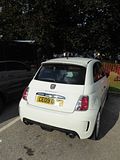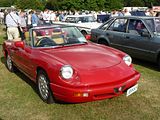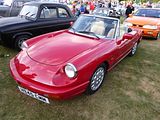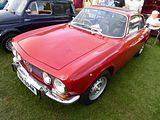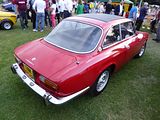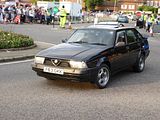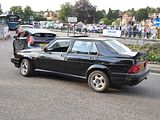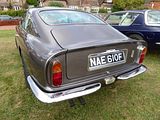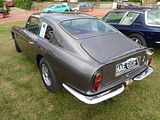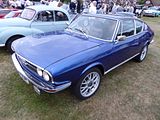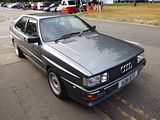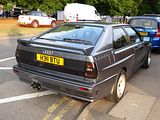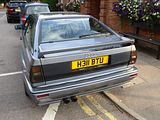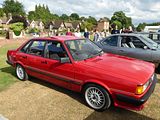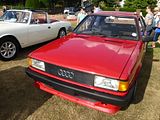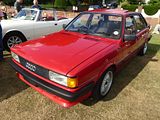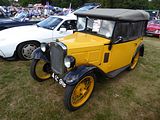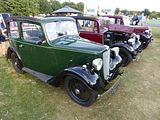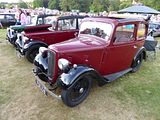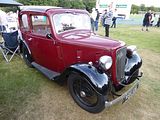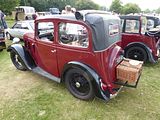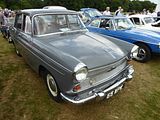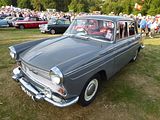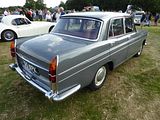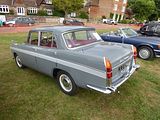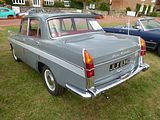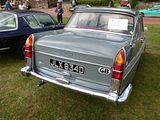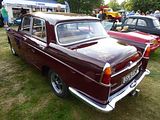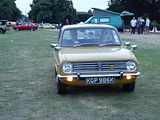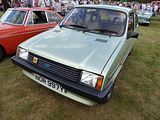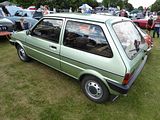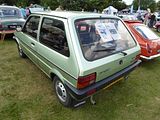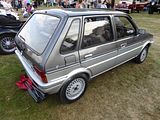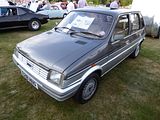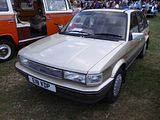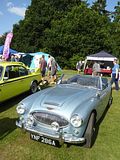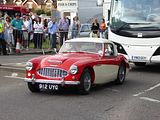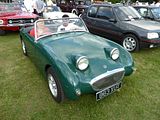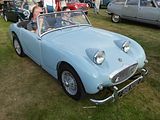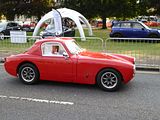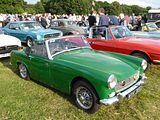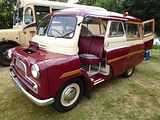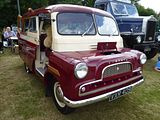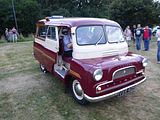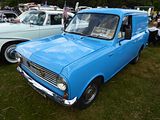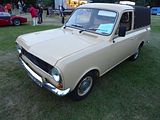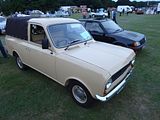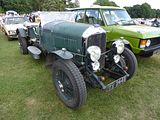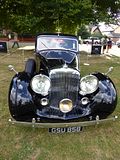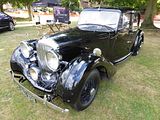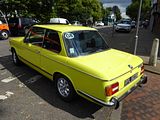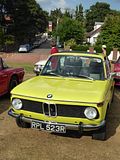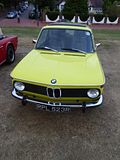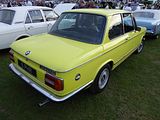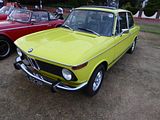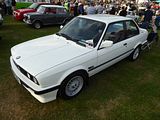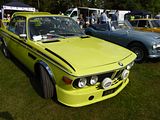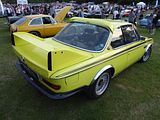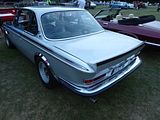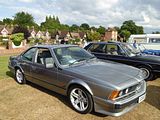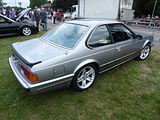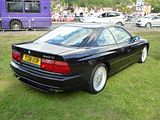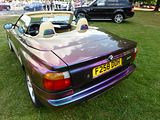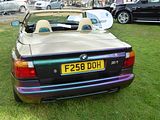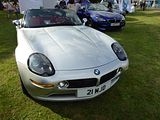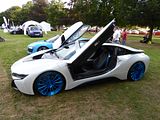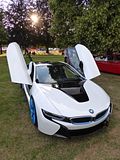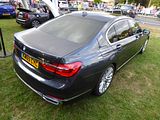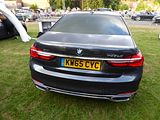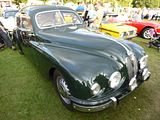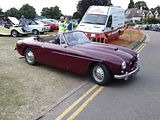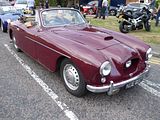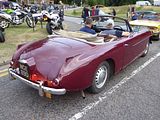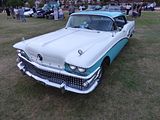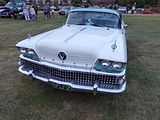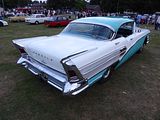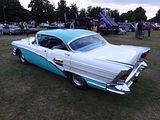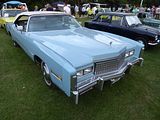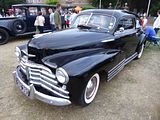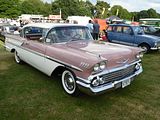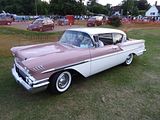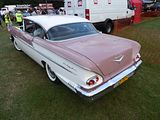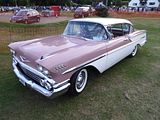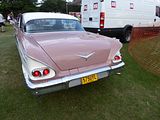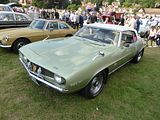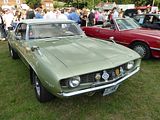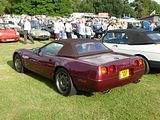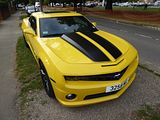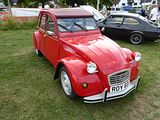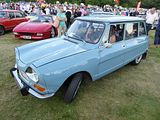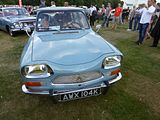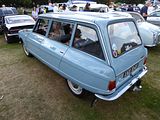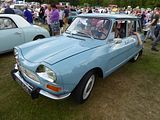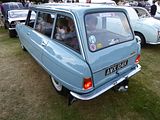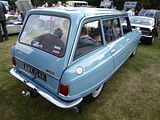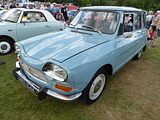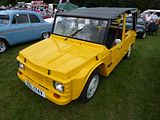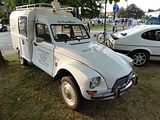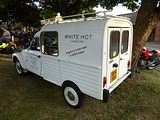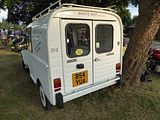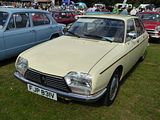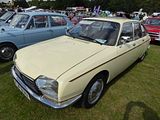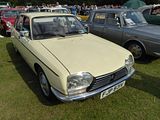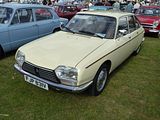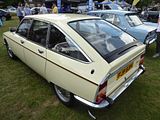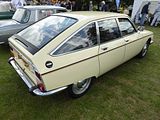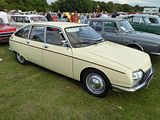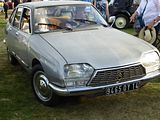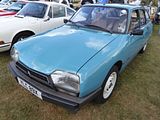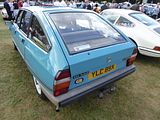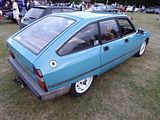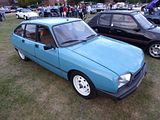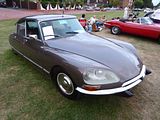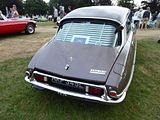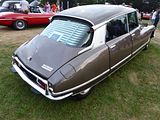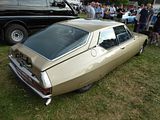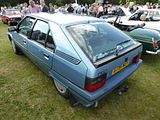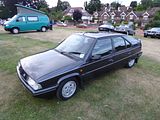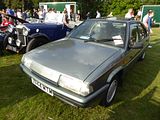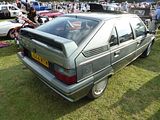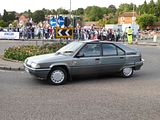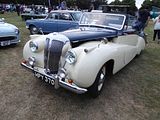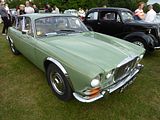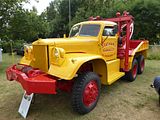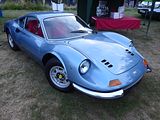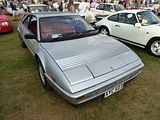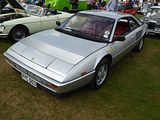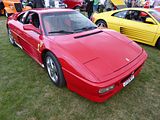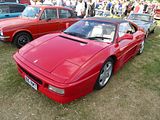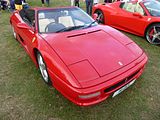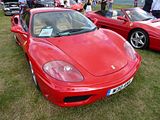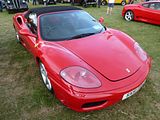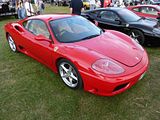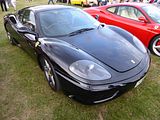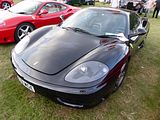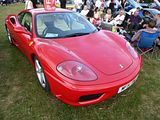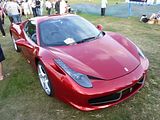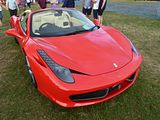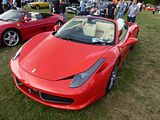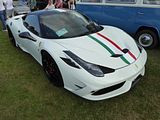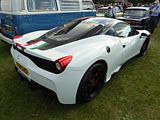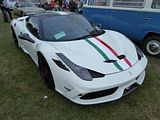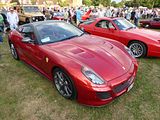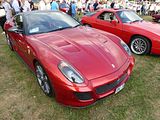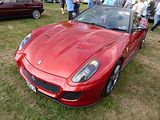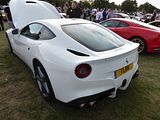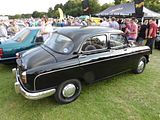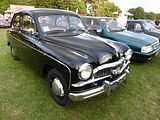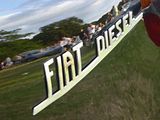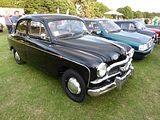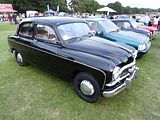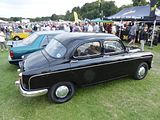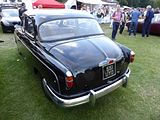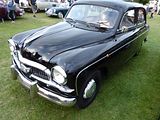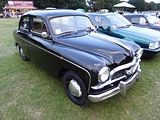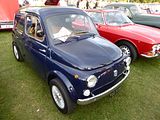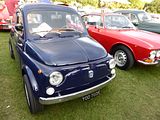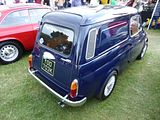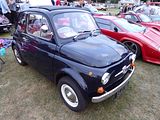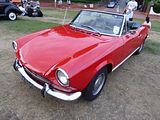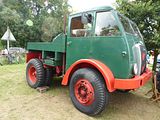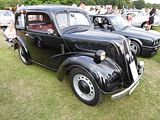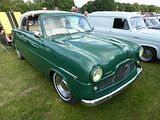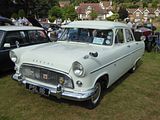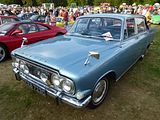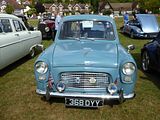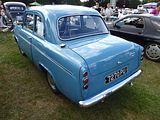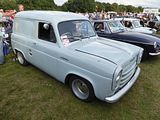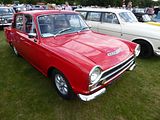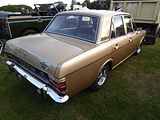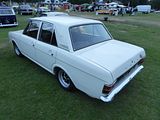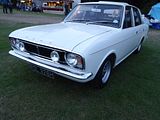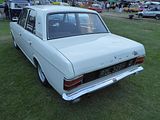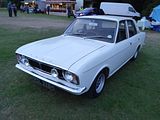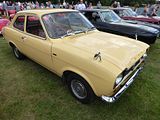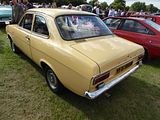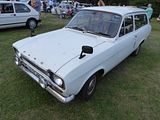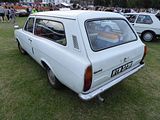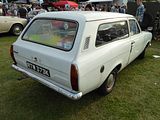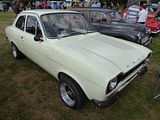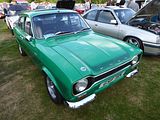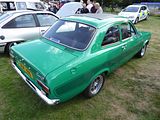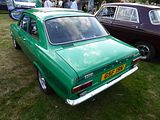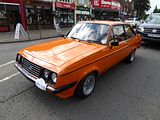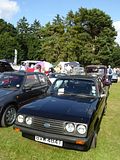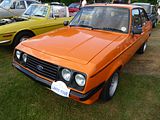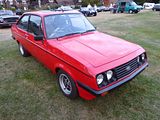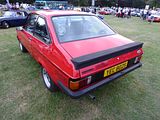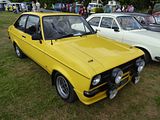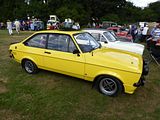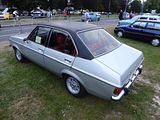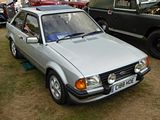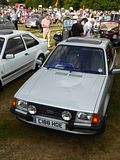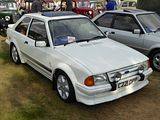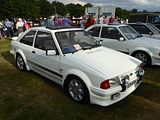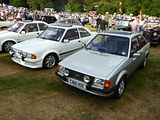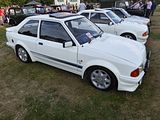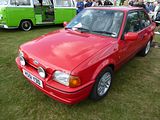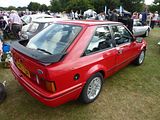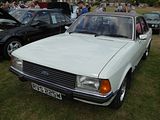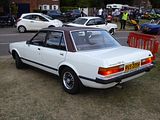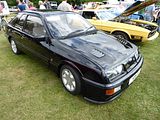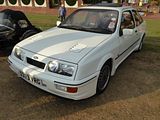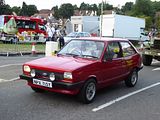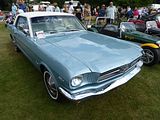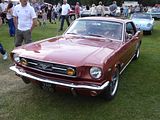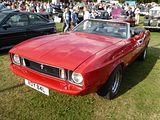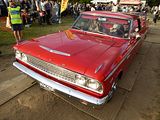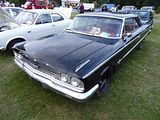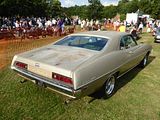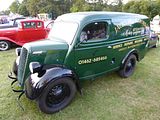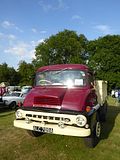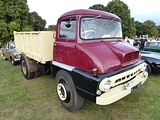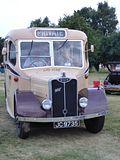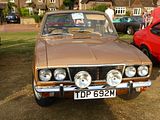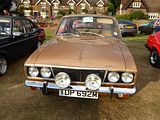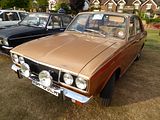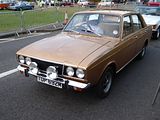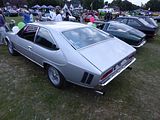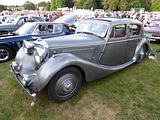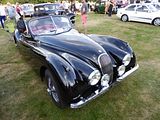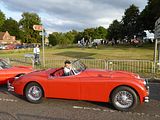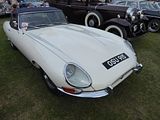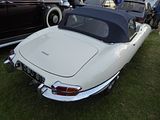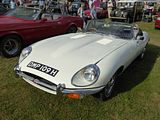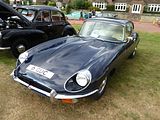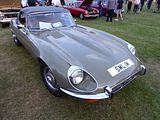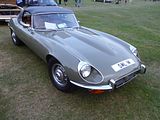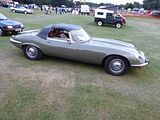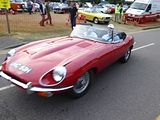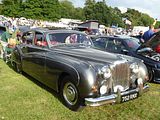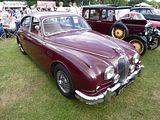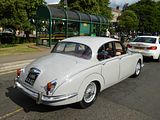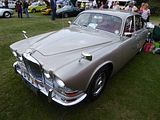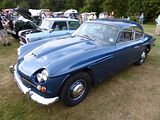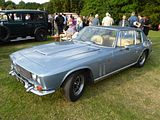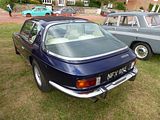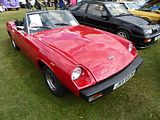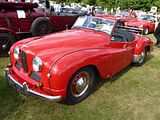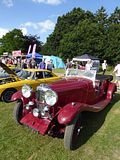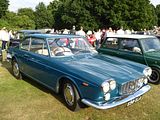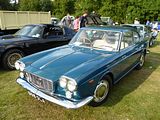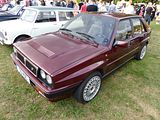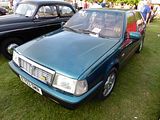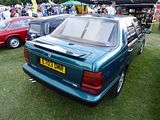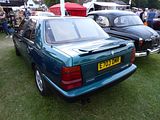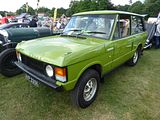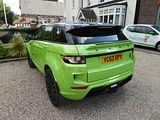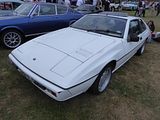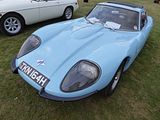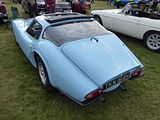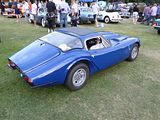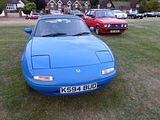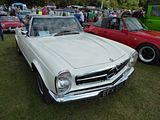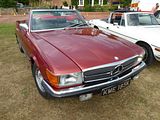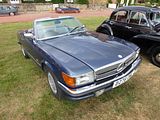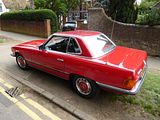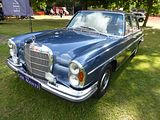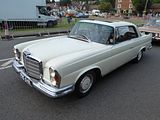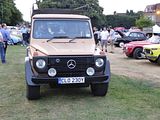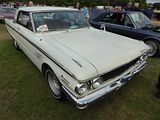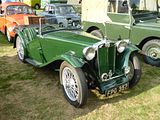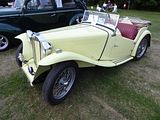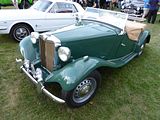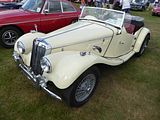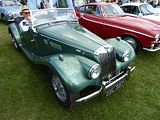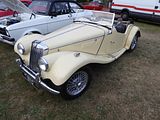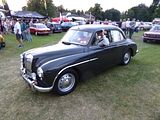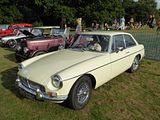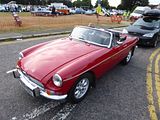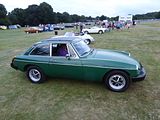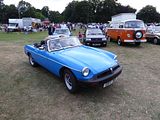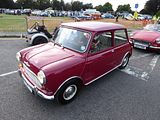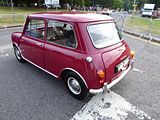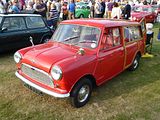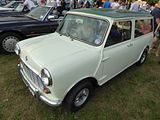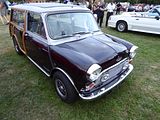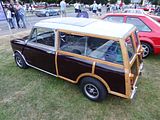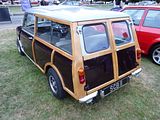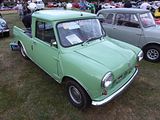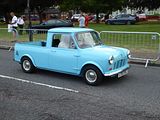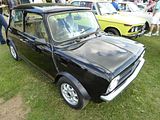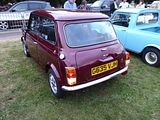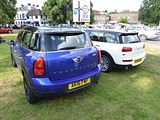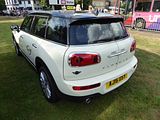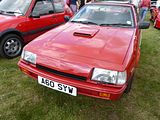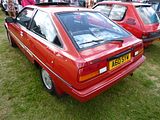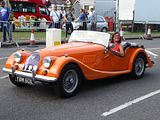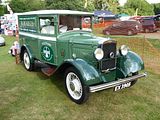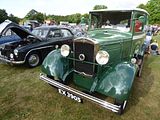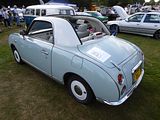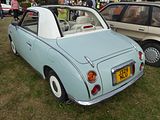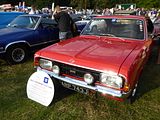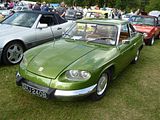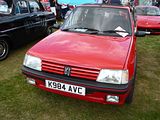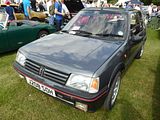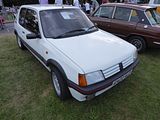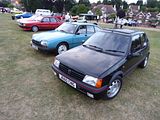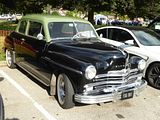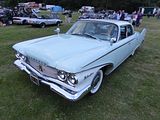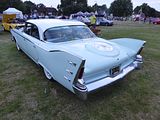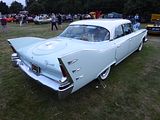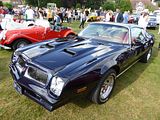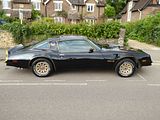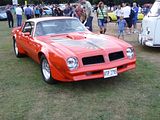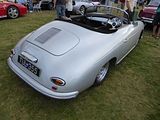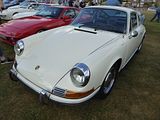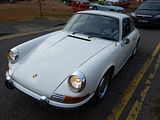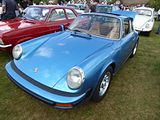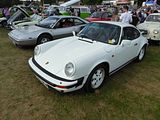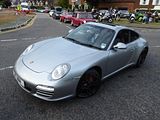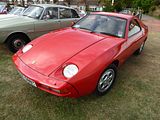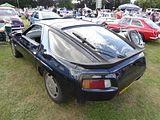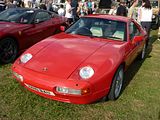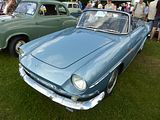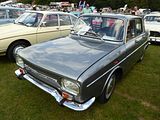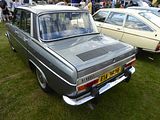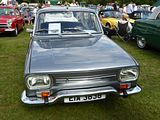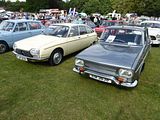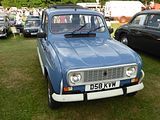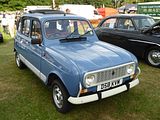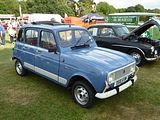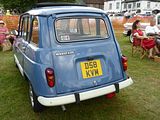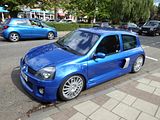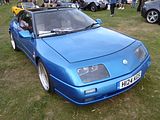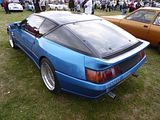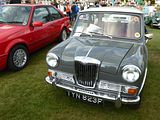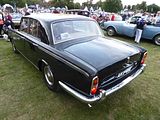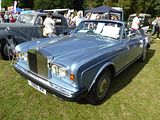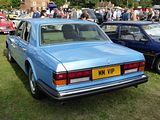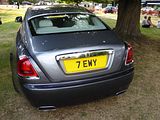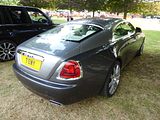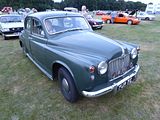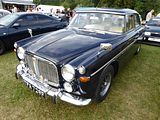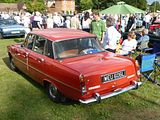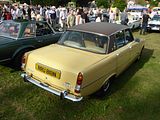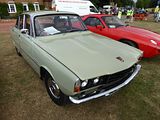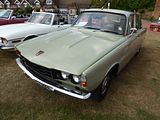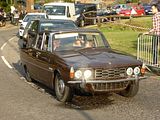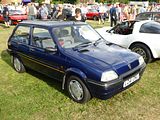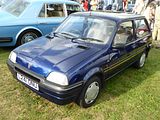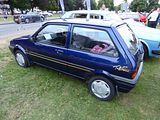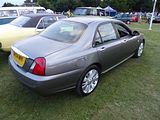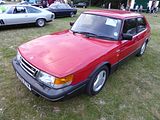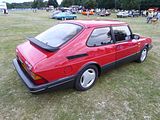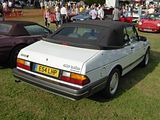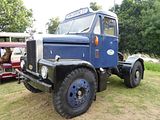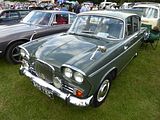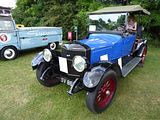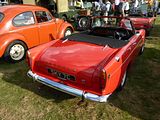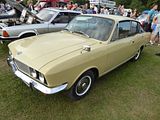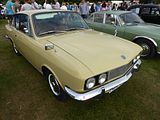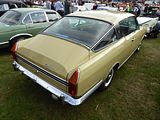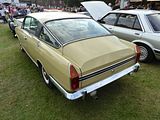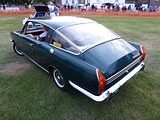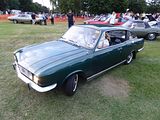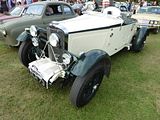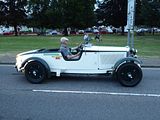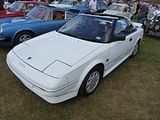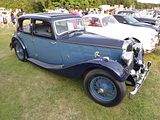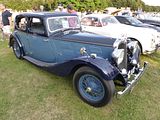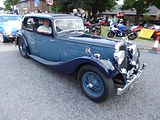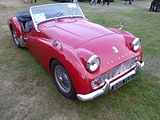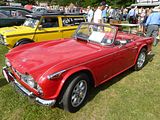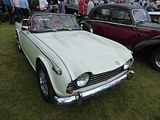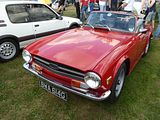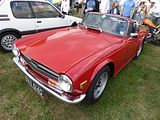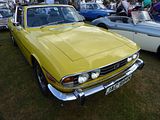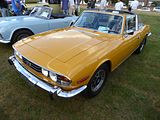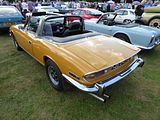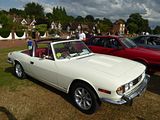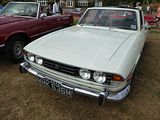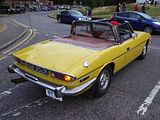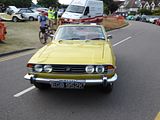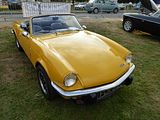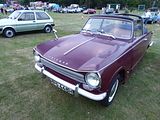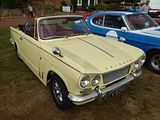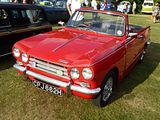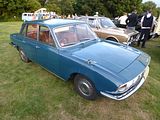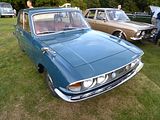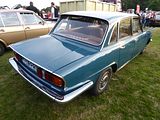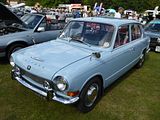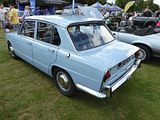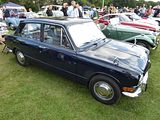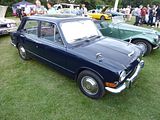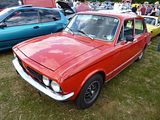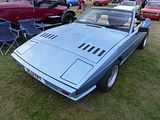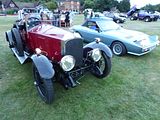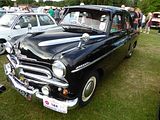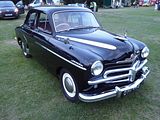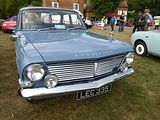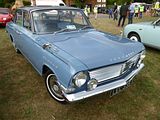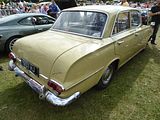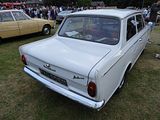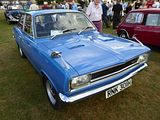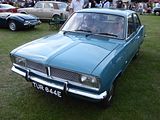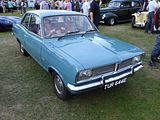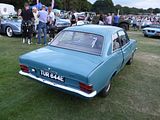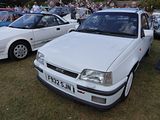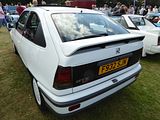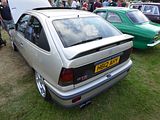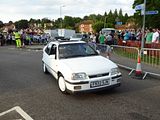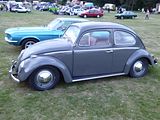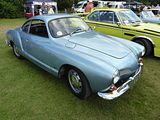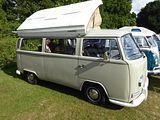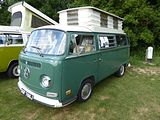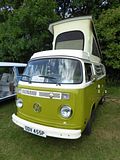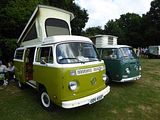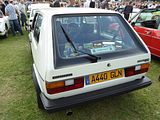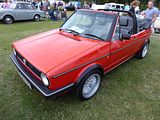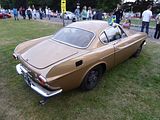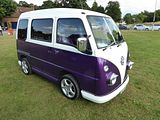Harpenden is one of those pleasant sort of towns that England does rather well. Freed of most of the traffic that would have had to crawl right through the middle of the town, once the nearby M1 was built, it is now a pleasant place, with just enough shops on the main road, and a station conveniently located in the town centre, with plentiful departures to London, where doubtless many of the town’s inhabitants work. You may well not even have heard of it, unless you are familiar with the Bedfordshire and Hertfordshire area of the country. Or unless you are a car enthusiast, as once a year, the large grassy expanse to the south of the shops, known as the Common, hosts a remarkable event. Called “Classics on the Common”, it is organised by the local Rotary Club, who encourage people to take advantage of the long evenings of daylight that bless the country in July, by bringing their old cars for others to enjoy. The event has grown over the years, and nowadays, it is vast., almost bigger than the area can cope with. Entrance to the display area is limited to cars that are more than 20 years old (though the off exception somehow seems to sneak in!), and even then, the vast common area is packed with cars before most people have finished work. Everyone else has to park off-site, and in my experience, the public car parks get rammed from quite early on, too. I’ve been to the event a few times, and have learned that it really does pay to arrive as early as possible, simply so as not to spend half the evening queuing and trying to park up. That also maximises the time available to enjoy the vast number of very varied cars on show. Although the event is only a few weeks after the very nearby “Classics in the Walled Garden”, which means that you do get some of the same cars attending both events, it never ceases to amaze me just how much variety is available and comes along to this event, with plenty that was not at the event in the previous year or two, either. Despite my best efforts, I was not able to capture anything like all the cars on show – the site is too vast, and cars come and go from early evening onwards – but even so, there are over 500 photos here, for everyone to enjoy.
ABARTH
Given the 20 year rule, it will be some time before and of the relaunched Abarth-branded cars will be eligible for display on the Common, but this was one of a number of photo-worthy cars that I came across on the streets right opposite. This is an early 500, presumably, given the badging, with the optional Essesse kit fitted.
AC
Genuine AC Cobra are rare beasts, as not that many were produced, but for the last as long as anyone can remember, there have all manner of replica and officially sanctioned continuation type cars produced, so there are pretty decent numbers of cars around that bear the legendary shape of this raw sports car. This is definitely not an original, but is still nice and with an amazing noise when the engine is fired up.
ALFA ROMEO
There were surprisingly few Alfa models here, considering the popularity of the marque among enthusiasts. Not surprisingly, of the small number of models that were, the long running 105 Series Spider was represented by models from either end of the production run, one of the “boat tailed” 1750 cars and a late model S4 Spider. The original 1966 Spider shape was the result of a number of Pininfarina design studies, concept cars showing traits incorporated in the final production design. The first one was the Alfa Romeo Superflow, a concept car built upon the chassis of a retired 6C 3000 CM racing car and first show at the 1956 Turin Motor Show. Despite being an aerodynamic coupé with prominent fins on the rear, and a futuristic all-plexiglas greenhouse and front wings, the Superflow already shown the overall body shape of the future Spider and the scallops on the sides. In the following years the Superflow was updated three times into three more different concept cars, namely a Superflow II coupé, then an open-top spider and finally another Superflow IV coupé. The most significant in the Spider’s design history was the second, the open-top Alfa Romeo Spider Super Sport, shown at the 1959 Geneva Motor Show. It did without the rear fins of the Sperflow and Superflow II, showing for the first time the rounded cuttlebone-shaped tail and tail light configuration of the Spider. Last of the Spider’s forerunner was the Alfa Romeo Giulietta SS Spider Aerodinamica, which premiered at the 1961 Turin Motor Show, and was based on the Giulietta Sprint Speciale. Very close to the shape of the production car, its main design differences were at the front, due to hideaway headlamps. Despite the almost final design being ready in 1961, the continuing success of existing models and the economic challenges facing Italy at the time meant that the first pre-launch production Spiders began to emerge from the Pininfarina production line only at the end of 1965. The Spider was launched at the 36th Geneva Motor Show in March 1966, together with the Giulia Sprint GT Veloce at an event organised in Gardone Riviera. To choose a name for the spider Alfa Romeo announced a write-in competition, offering an example of the new car as a prize. Over 100,000 ballots were sent in, the great majority from Italy; the winner was Guidobaldo Trionfi, a man from Brescia, who proposed the name Duetto (duet). However the Duetto name could not be officially adopted due to trademark issues, and the car was named simply Alfa Romeo Spider 1600. The Spider’s 1,570 cc twin cam engine had dual Weber two-barrel side-draft carburettors, and produced 108 hp. Sparsely fitted inside but including five speed manual transmission and disc brakes, the price on launch in Italy was 2,195,000 lire. In the United States the car sold for $3,950 (compared to $3,991 for a Lotus Elan and $2,607 for an MGB). In the United Kingdom the car’s price was close to a Jaguar E-Type. In January 1968 Alfa Romeo introduced to the press in Vietri sul Mare (Salerno) its 1750 line of cars, which included the new 1750 Berlina saloon, the Giulia Sprint-based 1750 GT Veloce coupé, and the Duetto-based 1750 Spider Veloce, which replaced the original Spider 1600. All were powered by the same engine, a new 1,779 cc, 116 hp version of the Alfa Romeo twin cam engine. Top speed rose to 118 mph.The car did not bear any Spider badging, just a “1750” script below the rear Alfa Romeo badge. During the production run, the front repeater lights were moved ahead of the wheel arches. While in Europe the 1750 was fitted with two twin horizontal carburettors, starting with model year 1969 models for the North American market had SPICA (Società Pompe Iniezione Cassani & Affini, a subsidiary of Alfa Romeo) mechanical fuel injection. According to Alfa Romeo engine output and performance were unchanged from the carburetted version.[19] Modifications were also made to the suspension, brakes, electrics, wheels and tyres, though the car looked effectively the same. Visible differences were limited to the rear-view mirror repositioned to the door, and badging on the tail, which read “Alfa Romeo” and “iniezione” (injection). A new lower priced spider, the Spider 1300 Junior, was introduced in June 1968 alongside the GTA 1300 Junior competition coupé. Its 1,290 cc twin cam engine was the same used on the GT 1300 Junior coupé, and produced 88 hp Top speed was 170 km/h (106 mph).From a mechanical standpoint the Junior differed from the 1750 only in engine displacement and output, while inside it lacked some features of the pricier model: namely opening quarter lights, centre console, and the three-spoke wood rimmed steering wheel, replaced by a two-spoke plastic rimmed one. From outside the Junior version could be recognised by its black-coloured lower front bumper and absence of plastic headlamp fairings. Due to the shape of its long, round tail, the Series 1 Spider is sometimes known by the nickname of “Osso di seppia” (Italian for cuttlebone) or “boat tail” to differentiate it from the “Kamm tail” Series 2. A 1966 Alfa Romeo Spider 1600 is famously featured in the 1967 hit film The Graduate, starring Dustin Hoffman, Katharine Ross and Anne Bancroft. This appearance gave worldwide celebrity to the Spider. The car depicted on screen had its engine note accurately recorded, and electrical foibles (the non-functional fuel gauge) reproduced. On the strength of the Spider’s appeal, Alfa Romeo continued sales of the Spider into the 1990s, and a special edition named the Alfa Graduate was available in the United States in the 1980s. The entire set of scenes featuring the Spider in the Graduate were replicated in satire by Mike Myers in his comedy, Wayne’s World 2. The Spider here cuts out Simon & Garfunkel’s “Mrs. Robinson” when passing under a bridge (implying music being played on a radio), but still has a non-functional fuel gauge—causing it to ultimately grind to halt (fortunately at the correct church). 6,324 of 1600 ‘Duetto’ were made and 2,680 of the 1300 Junior.
The S4, the final evolution of the 105 Series Spider came in 1990. Mechanically, the biggest different was the use of Bosch Motronic electronic fuel injection with an electric fan. Externally, the Spider lost its front under-bumper spoiler and the rather ungainly rear boot spoiler of the S3, and picked up 164-style rear lights stretching across the width of the car as well as plastic bumpers the same colour as the car. This also marked the first generation of the car with automatic transmission, as well as on-board diagnostics capabilities. The car had remained in production largely thanks to continued demand in North America, though this market had to wait until 1991 for the changes to appear on their cars. European markets were offered a car with a 1600cc engine and carburettors as well as the 2 litre injected unit. Production finally ended in 1993, with an all new model, the 916 Series Spider appearing a year later. The S4 car was not officially sold in the UK, but plenty have found their way to our shores since then.
Also from the 105 Series was this 2000GTV. There is a lengthy and complex history to this range, which started in 1963, a year after the launch of the Giulia Berlina. The first car was called the Alfa Romeo Giulia Sprint GT. It was revealed at a press event held at the then newly opened Arese plant on 9 September 1963, and displayed later the same month at the Frankfurt Motor Show. In its original form the Bertone body is known as scalino (step) or “step front”, because of the leading edge of the engine compartment lid which sat 1/4 an inch above the nose of the car. The Giulia Sprint GT can be distinguished from the later models by a number of features including: Exterior badging: Alfa Romeo logo on the front grille, a chrome script reading “Giulia Sprint GT” on the boot lid, and rectangular “Disegno di Bertone” badges aft of the front wheel arches; flat, chrome grille in plain, wide rectangular mesh without additional chrome bars; single-piece chrome bumpers; no overriders. Inside the cabin the padded vinyl dashboard was characterised by a concave horizontal fascia, finished in grey anti-glare crackle-effect paint. Four round instruments were inset in the fascia in front of the driver. The steering wheel was non-dished, with three aluminium spokes, a thin bakelite rim and a centre horn button. Vinyl-covered seats with cloth centres and a fully carpeted floor were standard, while leather upholstery was an extra-cost option. After initially marketing it as a four-seater, Alfa Romeo soon changed its definition of the car to a more realistic 2+2. The Giulia Sprint GT was fitted with the 1,570 cc version of Alfa Romeo’s all-aluminium twin cam inline four, which had first debuted on the 1962 Giulia Berlina. Breathing through two twin-choke Weber 40 DCOE 4 carburettors, on the Sprint GT this engine produced 105 hp at 6,000 rpm. Like all subsequent models, the Sprint GT was equipped with an all-synchromesh 5-speed manual transmission. The braking system comprised four Dunlop disc brakes and a vacuum servo. The rear brakes featured an unusual arrangement with the slave cylinders mounted on the axle tubes, operating the calipers by a system of levers and cranks. According to Alfa Romeo the car could reach a top speed of “over 180 km/h (112 mph)”. In total 21,902 Giulia Sprint GT were produced from 1963 to 1965, when the model was superseded by the Giulia Sprint GT Veloce. Of these 2,274 were right hand drive: 1,354 cars fully finished in Arese, and 920 shipped in complete knock-down kit form for foreign assembly. For 1966, the Giulia Sprint GT was replaced by the Alfa Romeo Giulia Sprint GT Veloce, which was very similar but featuring a number of improvements: a revised engine—slightly more powerful and with more torque—better interior fittings and changes to the exterior trim. Alongside the brand new 1750 Spider Veloce which shared its updated engine the Sprint GT Veloce was introduced at the 36th Geneva Motor Show in March 1966, and then tested by the international specialist press in Gardone on the Garda Lake. Production had began in 1965 and ended in 1968. The Giulia Sprint GT Veloce can be most easily distinguished from other models by the following features: badging as per Giulia Sprint GT, with the addition of round enamel badges on the C-pillar—a green Quadrifoglio (four-leaf clover) on an ivory background—and a chrome “Veloce” script on the tail panel; black mesh grille with three horizontal chrome bars; the grille heart has 7 bars instead of 6; stainless steel bumpers, as opposed to the chromed mild steel bumpers on the Giulia Sprint GT. The bumpers are the same shape, but are made in two pieces (front) and three pieces (rear) with small covers hiding the joining rivets. Inside the main changes from the Giulia Sprint GT were imitation wood dashboard fascia instead of the previous anti-glare grey finish, front seats revised to a mild “bucket” design, and a dished three aluminium spoke steering wheel, with a black rim and horn buttons through the spokes. The Veloce’s type 00536 engine, identical to the Spider 1600 Duetto’s, featured modifications compared to the Giulia Sprint GT’s type 00502—such as larger diameter exhaust valves. As a result it produced 108 hp at 6,000 rpm, an increase of 3 hp over the previous model, and significantly more torque. According to the manufacturer top speed now exceeded 185 km/h (115 mph). Early Giulia Sprint GT Veloces featured the same Dunlop disc brake system as the Giulia Sprint GT, while later cars substituted ATE disc brakes as pioneered on the GT 1300 Junior in 1966. The ATE brakes featured an handbrake system entirely separate from the pedal brakes, using drum brakes incorporated in the rear disc castings. Though the Sprint GT Veloce’s replacement—the 1750 GT Veloce—was introduced in 1967, production continued throughout the year and thirty final cars were completed in 1968. By then total Giulia Sprint GT Veloce production amounted to 14,240 examples. 1,407 of these were right hand drive cars, and 332 right hand drive complete knock-down kits. The Alfa Romeo 1750 GT Veloce (also known as 1750 GTV) appeared in 1967 along with the 1750 Berlina sedan and 1750 Spider. The same type of engine was used to power all three versions; this rationalisation was a first for Alfa Romeo. The 1750 GTV replaced the Giulia Sprint GT Veloce and introduced many updates and modifications. Most significantly, the engine capacity was increased to 1779 cc. Peak power increased to 120 hp at 5500 rpm. The stroke was lengthened from 82 to 88.5 mm over the 1600 engine, and a reduced rev limit from 7000 rpm to 6000 rpm. Maximum torque was increased to 137 lb·ft at 3000 rpm. A higher ratio final drive was fitted (10/41 instead of 9/41) but the same gearbox ratios were retained. The result was that, on paper, the car had only slightly improved performance compared to the Giulia Sprint GT Veloce, but on the road it was much more flexible to drive and it was easier to maintain higher average speeds for fast touring. For the United States market, the 1779 cc engine was fitted with a fuel injection system made by Alfa Romeo subsidiary SPICA, to meet emission control laws that were coming into effect at the time. Fuel injection was also featured on Canadian market cars after 1971. Carburettors were retained for other markets. The chassis was also significantly modified. Tyre size went to 165/14 from 155/15 and wheel size to 5 1/2J x 14 instead of 5J x 15, giving a wider section and slightly smaller rolling diameter. The suspension geometry was also revised, and an anti-roll bar was fitted to the rear suspension. ATE disc brakes were fitted from the outset, but with bigger front discs and calipers than the ones fitted to GT 1300 Juniors and late Giulia Sprint GT Veloces. The changes resulted in significant improvements to the handling and braking, which once again made it easier for the driver to maintain high average speeds for fast touring. The 1750 GTV also departed significantly from the earlier cars externally. New nose styling eliminated the “stepped” bonnet of the Giulia Sprint GT, GTC, GTA and early GT 1300 Juniors and incorporated four headlamps. For the 1971 model year, United States market 1750 GTV’s also featured larger rear light clusters (there were no 1970 model year Alfas on the US market). Besides the chrome “1750” badge on the bootlid, there was also a round Alfa Romeo badge. Similar Quadrofoglio badges to those on the Giulia Sprint GT Veloce were fitted on C pillars, but the Quadrofoglio was coloured gold instead of green. The car also adopted the higher rear wheelarches first seen on the GT 1300 Junior. The interior was also much modified over that of earlier cars. There was a new dashboard with large speedometer and tachometer instruments in twin binnacles closer to the driver’s line of sight. The instruments were mounted at a more conventional angle, avoiding the reflections caused by the upward angled flat dash of earlier cars. Conversely, auxiliary instruments were moved to angled bezels in the centre console, further from the driver’s line of sight than before. The new seats introduced adjustable headrests which merged with the top of the seat when fully down. The window winder levers, the door release levers and the quarterlight vent knobs were also restyled. The remote release for the boot lid, located on the inside of the door opening on the B-post just under the door lock striker, was moved from the right hand side of the car to the left hand side. The location of this item was always independent of whether the car was left hand drive or right hand drive. Early (Series 1) 1750 GTV’s featured the same bumpers as the Giulia Sprint GT Veloce, with the front bumper modified to mount the indicator / sidelight units on the top of its corners, or under the bumper on US market cars. The Series 2 1750 GTV of 1970 introduced other mechanical changes, including a dual circuit braking system (split front and rear, with separate servos). The brake and clutch pedals on left hand drive cars were also of an improved pendant design, instead of the earlier floor-hinged type. On right hand drive cars the floor-hinged pedals were retained, as there was no space for the pedal box behind the carburettors. Externally, the series 2 1750 GTV is identified by new, slimmer bumpers with front and rear overriders. The combined front indicator and sidelight units were now mounted to the front panel instead of the front bumper, except again on the 1971-72 US/Canadian market cars. The interior was slightly modified, with the seats retaining the same basic outline but following a simpler design. 44,269 1750 GTVs were made before their replacement came along. That car was the 2000GTV. Introduced in 1971, together with the 2000 Berlina sedan and 2000 Spider, the 2 litre cars were replacements for the 1750 range. The engine displacement was increased to 1962 cc. Oil and radiator capacities remained unchanged. The North American market cars had fuel injection, but everyone else retained carburettors. Officially, both versions generated the same power, 130 hp at 5500 rpm. The interior trim was changed, with the most notable differences being the introduction of a separate instrument cluster, instead of the gauges installed in the dash panel in earlier cars. Externally the 2000 GTV is most easily distinguished by its grille with horizontal chrome bars, featuring protruding blocks forming the familiar Alfa heart in outline, smaller hubcaps with exposed wheel nuts, optional aluminium alloy wheels of the same size as the standard 5. 1/2J × 14 steel items, styled to the “turbina” design first seen on the alloy wheels of the Alfa Romeo Montreal, and the larger rear light clusters first fitted to United States market 1750 GTV’s were standard for all markets. From 1974 on, the 105 Series coupé models were rationalised and these external features became common to post-1974 GT 1300 Junior and GT 1600 Junior models, with only few distinguishing features marking the difference between models. 37,459 2000 GTVs were made before production ended and these days they are very sought after with prices having sky-rocketed in recent years.
There was also an example of the last Alfa model to be developed before the company was bought by Fiat, the 75, which was introduced in May 1985, to replace the 116 Series Giulietta with which it shared many components. It was named to celebrate Alfa’s 75th year of production. The body, designed by head of Alfa Romeo Centro Stile Ermanno Cressoni, was styled in a striking wedge shape, tapering at the front with square headlights and a matching grille. The 75 was only ever sold as a four door saloon, though at the 1986 Turin Auto Salon, a prototype 75 estate was to be seen, an attractive forerunner of the later 156 Sportwagon. This version was, however, never listed for sale, being cancelled after Fiat took control of Alfa Romeo. The car, dubbed the 75 Turbo Wagon, was made by Italian coachbuilder Rayton Fissore using a 75 Turbo as the basis. Two estate versions were to be found at the later 1987 Geneva Motor Show; one was this Turbo Wagon and the other was a 2.0 litre version named the Sportwagon. The 75 featured some unusual technical features, most notably the fact that it was almost perfectly balanced from front to rear. This was achieved by using transaxle schema — mounting the standard five-speed gearbox in the rear connected to the rear differential (rear-wheel drive). The front suspension was a torsion bar and shock absorber combination and the rear an expensive de Dion tube assembled with shock absorbers; these designs were intended to optimize the car’s handling; moreover the rear brake discs were fitted at the centre of the rear axle, near the gearbox-differential group. The engine crankshaft was bolted directly to the two-segment driveshaft which ran the length of the underside from the engine block to the gearbox, and rotated at the speed of the engine. The shaft segments were joined with elastomeric ‘doughnuts’ to prevent vibration and engine/gearbox damage. The 2.0 litre Twin Spark and the 3.0 Litre V6 were equipped with a limited slip differential. The 75 featured a then-advanced dashboard-mounted diagnostic computer, called Alfa Romeo Control, capable of monitoring the engine systems and alerting the drivers of potential faults. The 75 engine range at launch featured four-cylinder 1.6, 1.8 and 2.0 litre petrol carburettor engines, a 2.0 litre intercooled turbodiesel made by VM Motori, and a 2.5 litre fuel injected V6. In 1986, the 75 Turbo was introduced, which featured a fuel-injected 1779 cc twin-cam engine using Garrett T3 turbocharger, intercooler and oil cooler. In 1987, a 3.0 litre V6 was added to the range and the 2.0 lire Alfa Romeo Twin Cam engine was redesigned to have now two spark plugs per cylinder, the engine was named as Twin Spark. With fuel injection and variable valve timing this engine produced 146 hp). This was the first production engine to use variable valve timing. In North America, where the car was known as the Milano, only the 2.5 and 3.0 V6s were available, from 1987 to 1989. The North American 2.5-litres were fundamentally different from their European counterparts. Due to federal regulations, some modifications were required. Most noticeable from the outside were the ‘America’ bumpers, with the typical rubber accordions in them. Furthermore, these bumpers had thick (and heavy) shock-absorbing material inside them and in addition, they were mounted to the vehicle on shock absorbers. To accommodate these shock absorbers, the ‘America’-bodies were slightly different from the European ones. The North American cars also had different equipment levels (depending on the version: Milano Silver, Milano Gold or Milano Platinum). L/h and r/h electrically adjustable outside mirrors, electrically reclining seats and cruise control were usually optional in Europe. The car was also available with a 3-speed ZF automatic gearbox option for the 2.5 V6. Other, more common options such as electrically operated rear windows and an A/C system were standard in the USA. The USA-cars also had different upholstery styles and of course different dashboard panels also indicating speed in mph, oil pressure in psi and coolant temperature in degrees F, and as a final touch the AR control was different, including a seat belt warning light. The European-spec 2.5 V6 (2.5 6V Iniezione or 2.5QV) was officially sold only between 1985 and 1987, although some of them were not registered until 1989. Relatively few of them were sold (about 2800 units), especially when the 155 PS (114 kW; 153 hp) 1.8 Turbo was launched, which in some countries was cheaper in taxes because of its lower displacement. To create a bigger space between the V6 and the inline fours, the 2.5 was bored out to 2959 cc’s to deliver 188 PS and this new engine was introduced as the 3.0 America in 1987. As its type designation suggests, the 3.0 only came in the US-specification, with the impact-bumpers and in-boot fuel tank. However, the European ‘America’s’ were not equipped with side-markers or the door, bonnet and boot lid fortifications. Depending on the country of delivery, the 3.0 America could be equipped with a catalytic converter. In 1988 engines were updated again, the 1.8 litre carburettor version was replaced with fuel injected 1.8 i.e. and new bigger diesel engine was added to the range. In the end of 1989 the 1.6 litre carburettor version was updated to have fuel injection and 1990 the 1.8 Turbo and 3.0i V6 got some more power and updated suspension. The 3.0 V6 was now equipped with a Motronic system instead of an L-Jetronic. The 1.8 Turbo was now also available in ‘America’-spec, but strangely enough not available for the USA market. The 3.0 V6 did make it to the United States, and was sold as Milano Verde. The UK never particularly warmed to the 75 when it was new, but its reputation has got ever stronger as the car ages. Many UK cars were snapped up by the owners of driving schools at racing circuits, thanks to its handling characteristics, but there are also some nice road cars left.
ASTON MARTIN
Sole Aston that I captured was this rather lovely DB6, the final model of the trio which started out with the DB4 of 1958. The DB6 was launched in 1965 as a replacement for the DB5 which had run since 1963. The wheelbase was now 4″ longer than before, resulting in an extensive restyle with a more raked windscreen, raised roofline and reshaped rear quarter windows. Opening front quarter lights made a reappearance, but the major change was at the rear where a Kamm tail with spoiler improved the aerodynamics, greatly enhancing stability at high speeds. “The tail lip halves the aerodynamic lift around maximum speed and brings in its train greater headroom and more luggage space”, declared Motor magazine, concluding that the DB6 was one of the finest sports cars it had tested. Famed employee, Tadek Marek, designed the six cylinder engine, which had been enlarged to 3,995cc for the preceding DB5 and remained unchanged. Power output on triple SU carburettors was 282bhp, rising to 325bhp in Vantage specification. Premiered at the 1965 London Motor Show, the DB6 Volante marked the first occasion the evocative ‘Volante’ name had been applied to a soft-top Aston Martin. After 37 Volante convertibles had been completed on the DB5 short wheelbase chassis, the model adopted the longer DB6 chassis in October 1966. A mere 140 DB6 based Volantes were manufactured, and of these only 29 were specified with the more powerful Vantage engine.
AUDI
I’ve seen this 100 Coupe S at a couple of events before, and I remember that fact as the car is sufficiently rare now that you just don’t see them very often at all. Launched in the autumn of 1970, so more than a year after the saloon models, the Coupe bore quite a strong resemblance to the Aston Martin DBS, though it was not styled by the same person. The Coupe S had a bored out 1.9 litre version of the 4 cylinder unit that powered the 2 and 4 door saloons, and it generated 115 bhp, giving the Coupe S quite brisk performance. Like all Audi models of the era, it was front wheel drive. It was considerably more costly than cars like the Ford Capri, so in the UK at least, sales were never that significant, so I was a little surprised to learn that nearly 31,000 of them were made over a 7 year period, though this is a tiny proportion compared to the 800,000 saloons models that were produced.
There was a gap of a few years before there was a Coupe model back in Audi’s range, but when it came. it made quite some impact. The car was the Quattro, and it is still viewed as a legend today. The idea for a high-performance four-wheel-drive car was proposed by Audi’s chassis engineer, Jörg Bensinger, in 1977, when he found that the Volkswagen Iltis could outperform any other vehicle in snow, no matter how powerful. Bensinger’s idea was to start developing an Audi 80 variant in co-operation with Walter Treser, Director of Pre-Development.. Following an unveiling on 1st March 1980, Audi released the original Quattro to European customers in late 1980, with the car featuring Audi’s quattro permanent four-wheel drive system (hence its name), and the first to mate four-wheel drive with a turbocharged engine. The original engine was the 2,144 cc in-line-5-cylinder 10 valve SOHC, with a turbocharger and intercooler. It produced 197 bhp propelling the Quattro from 0 to 100 km/h in 7.1 seconds, and reaching a top speed of over 220 km/h (137 mph). The engine was eventually modified to a 2,226 cc inline-5 10 valve, still producing 197 bhp, but with peak torque lower in the rev-range. In 1989, it was then changed to a 2,226 cc inline-5 20v DOHC setup producing 217 bhp, now with a top speed of 230 km/h (143 mph) Audi Quattros are referred to among owners and enthusiasts by their engine codes, to differentiate between the earlier and later versions: the earliest 2144 cc 10v being the “WR” engine, the 2226 cc 10v being the “MB” engine, and the later 20v being the “RR” engine. Hence, Quattro models may be referred to as either the WR Quattro, MB Quattro, and RR or “20v” Quattro, respectively. Quattro car production was 11,452 vehicles over the period 1980–1991,and through this 11 year production span, despite some touch-ups, there were no major changes in the visual design of the vehicle. For the 1983 model year, the dash was switched from an analogue instrument cluster, to a green digital LCD electronic instrument cluster. This was later changed in 1988 to an orange LCD electronic instrument cluster. The interior was redesigned in 1984, and featured a whole new dash layout, new steering wheel design, and new centre console design, the switches around the instrument panel were also redesigned at this time. In 1985 the dash changed slightly with harder foam and lost a diagonal stripe, the dash switches were varied slightly and the diff lock pull knob gave way to a two-position turning knob with volt and oil temp digital readouts. External styling received very little modification during its production run. Originally, the car had a flat fronted grille featuring four separate headlamp lenses, one for each of the low and high beam units. This was altered for the 1983 model year, and replaced with combined units featuring a single lens, but housing twin reflectors. This was changed again, for the 1985 model year, in what has become known as the ‘facelift model’ and included such alterations as a new sloping front grille, headlights, and trim and badging changes. Max speed was 124 mph. The RR 20v Quattro also featured a new three spoke steering wheel design, leather covering for door arm rests, gloveboxes, centre console and door pockets. There was also a full length leather-wrapped centre console running all the way to the rear seats. The 20v was also the first Ur-Q to have “quattro” script interior with partial leather seats. The floor on the drivers side had a bulge due to dual catalytic exhaust setup. The different models may be distinguished by the emblems on their boot lids: the WR had a vinyl ‘quattro’ decal or a brushed aluminium effect plastic emblem, the MB had chrome plated ‘audi’, ‘audi rings’ and ‘quattro’ emblems, whilst the RR had only chrome plated ‘audi rings’. The rear suspension was altered early on with geometry changes and removal of the rear anti-roll bar to reduce a tendency for lift-off oversteer. For the 1984 facelift, the wheel size went from 6×15-inch with 205/60-15 tyres to 8×15-inch wheels with 215/50-15 tyres. At the same time the suspension was lowered 20 mm with slightly stiffer springs for improved handling. For 1987, the Torsen centre differential was used for the first time, replacing the manual centre differential lock. The last original Audi Quattro was produced on 17 May 1991, more than two years after the first models of the new Audi Coupe range (based on the 1986 Audi 80) had been produced.
Many of the components in the Quattro were shared with this car, a second generation Audi 80. This had been launched in September 1978, as a four door saloon, like its predecessor, and available with a small number of different engines and trims. Deiveries of the fuel injected GLE and two door bodied cars began early in 1979. The body of the B2 Audi 80 was designed by Giorgetto Giugiaro. No Estate or Avant variant was available, as the Volkswagen Passat filled that role, as the B2 was intended to move the 80 upmarket from the mid-sized family segment to a compact executive model pitched to rival the BMW 3-Series. The corresponding B2 version of the Passat appeared two years later, and although the two cars shared the same platform and running gear as before, the Passat had a much stronger visual identity distinct from its Audi 80 sister in comparison with the B1. The 80 first became available with four-wheel drive in 1983. The model was essentially an Ur-Quattro without the turbocharger and with saloon bodywork. The four-wheel drive 80, however, weighed more than a front-wheel drive Audi 100 CD with the same 2144 cc 136 PS engine, and with its worse aerodynamics it was slower than the larger, better equipped, and lower-priced 100. The 80 quattro received twin headlamps, a front spoiler with integrated foglights, and a body-coloured rubber spoiler on the rear. There was also a “quattro” script on the bootlid and a twin exhaust. The luggage compartment was marginally smaller. The 80 quattro was a bargain compared to the Ur-Quattro, but less so in comparison with the two-wheel drive 80 GTE or the 100 CD, although they did not offer the impressive road holding that the quattros do.In 1983, the 80 Sport was introduced in the UK, based on the GTE. It came with quattro-style Ronal alloys, rubber rear spoiler, deep chin spoiler, striped charcoal Recaro interior, and optional body graphics including full-length “Audi Sport” stripes, and it was one of those which was to be seen here. In mid-1984, Audi gave the B2 a subtle facelift with tail lights resembling the ones of the Typ 44 Audi 100, and different front and rear bumpers and headlights and an updated interior, and introduced the 90 nameplate for the 5 cylinder cars, pushing them still further up-market. The 1.6- and 1.8-litre 4 cylinder engines were replaced by newer iterations of the same, enabling the fitment of catalytic converters. The saloons were offered until late 1986 in Europe, and the B2-based Audi Coupé lasted through to 1988 before being changed.
AUSTIN
Oldest Austin here was a Seven, Herbert Austin’s masterpiece that was launched in 1922 and which literally put Britain on wheels. The car was in production right up until 1939, undergoing significant change in the process. The oldest model here, a closed saloon dated from the 20s.
Joining it were a trio of 1930s Austin Seven Pearl models, all parked up together. The middle one, dating from 1935 belongs to Nigel Slatford, who tracked it down 14 years ago. About a week later, he called Franco Ricaldone, owner of the one to the left of it, to say that he’d found another one, and how nice his was. Franco duly went to Stoke to fetch it. Completing the set was the ’37 model, on the right, that Jim Perkins bought as a project and painstakingly restored from the ground up. All three owners are members of the Beds & Herts Vintage & Classic Car Club.
Following the A50 and A55 Cambridge cars of the mid 1950s was another car called A55 Cambridge, but whereas the first had been unique to Austin in its design, the A55 Cambridge Series 2 was one of the range of cars produced by BMC which came to be known as the “Farina” saloons. The concept goes back to the the mid 1950s, by which time the BMC organisation was well established, and it dominated the UK market with a 39% share. Plans were made for a complete new range of cars that would encompass all the marques: Austin, Morris, MG, Riley and Wolseley. Italian stylist Pininfarina was commissioned to design them. The first model to appear was the A40, launched early in 1958. Whilst that car was only ever sold with Austin badges, the next of Pininfarina’s designs to appear would go on to be sold with each of the 5 marque’s badges attached. These upper-medium sized family cars were released over a period of months, starting in late 1958 with the Wolseley 15/60. This was followed by the A55 Cambridge Mark II, the Morris Oxford Series V, the MG Magnette Series III and the Riley 4/68. The same basic body style was applied to all, with just trim differences, and in the case of the MG and Riley, more powerful engines thanks to a twin carburettor set up under the bonnet, introducing the world to the concept of “badge engineering”. Whilst the styling was something of an amalgam of Italian glamour and a touch of Americana, with prominent tail fins, under the skin the cars were very conventional. Whilst some may have been disappointed that BMC had not been more adventurous, this was an era when home car maintenance was an established part of the suburban landscape, so simplicity was not completely unwelcome. The familiar 1.5-litre B-Series engine, four-speed manual and straightforward rear-wheel drive gave it solid appeal to many middle-class buyers, especially those horrified by the black magic of the newly launched front-drive Mini. All 5 cars were four-door saloons, with estate versions of the Austin and Morris being added to the range a few months later. A facelift was applied to them all in late 1961, when the tail fins were toned down and an enlarged 1622cc B Series engine found its way under the bonnet, with more power, new names came in for the Wolseley which became the 16/60 and the Austin which adopted the A60 Cambridge name. It was the A60 Cambridge Saloon which was represented here.
Also styled by Pininfarina were the large BMC cars, sold with fewer of the Group’s badges on them. As well as a top spec Vanden Plas model, there was only a Wolseley, the 6/99 and later 6/110 and the Austin Westminster. First seen in 1959, the Westminster was also known as the A99 and it had the 2912 cc C-Series straight-6 engine with twin SU carburettors from the Austin-Healey 3000 under the bonnet. This engine produced 103 hp in Westminster tune. A three-speed all-synchromesh manual gearbox with a Borg-Warner overdrive unit was fitted as standard, or a Borg-Warner automatic transmission as an option. Power-assisted Lockheed brakes with 10.75 in (273 mm) discs on the front wheels were also new. It was updated in 1961, resulting in the A110 Westminster. This version had an extended (by 2 in) wheelbase, which allowed more space in the rear compartment as well as improving the roadholding, a floor-mounted gear lever. 13 in wheels were substituted in 1964’s Mark II models. Wolseley produced a 6/110 version, and there was a Vanden Plas Princess Mark II with the C-Series engine, now uprated to 120 hp. The same basic body was also used for a Rolls Royce-engined Vanden Plas Princess 4 Litre R, and the body even formed part of a prototype Bentley. The Westminster range was finally replaced by the Austin 3-Litre in 1968. 26,105 A110s were built. The car seen here is an A110 Westminster Mark II.
A rare sight these days, this was nice example of the Maxi, seen in 1750 guise in the period colour of Harvest Gold. Developed in the mid 60s, the ADO15 was intended to plug the gap between the ADO17 Austin/Morris 1800 cars and the volume selling 1100/1300 cars, providing BL with a much needed competitor for the Mark 2 Cortina, which, along with the Escort had helped to grow Ford’s market share in the UK, mostly at BL’s expense. Long in gestation, as was not uncommon at the time, the new car eventually made its debut as the Maxi on 1st May 1969. Promoted as the “5 of everything” car, it had 5 doors, 5 gears (both unusual in the market in those days) as well as 5 seats. It also featured a brand new engine, the 1500cc E Series, which was not really up to the task and it was saddled with what by common consent was one of the most recalcitrant gearchanges ever inflicted on a production car, with a lever operated by rods which had to be carefully lined up to persuade the next gear to engage. That aside, the car had huge potential and a vast amount of space in a footprint that measures less than 14 feet in length. A revised version was launched in the autumn of 1970, with a cable operated gearchange and the option of a more powerful and torquey 1750cc engine. Sadly, apart from adding the twin carburettor HLS version to the range in 1972, that was about all that BL did to the design in the next 10 years. Talk about starving a model of its full potential. The last few cars were branded Series 2 and had new bumpers and interior trim, but that was about it. The format was right, as evidenced by the fact that all major manufacturers moved to something similar in the 1970s, but the execution lacked the final polish and sales were limited in the UK and negligible anywhere else. What a wasted opportunity!
“A British car to beat the world”. So read the billboards when the Austin Metro was revealed in October 1980. We had waited a long time for this car. There were many false starts, with thoughts first turning to how to replace the Mini going back to the late 1960s, but for various reasons, every effort had been cancelled. Fortunately, that extended to the ADO88 prototype which got to quite an advanced state of development in 1978, but which received less than favourable feedback at customer clinics. A hasty redesign was conducted. Despite carrying over the A Series engines, albeit in modified A+ guise, as BL had nothing else suitable and no money to develop an alternative, and that meant the 4 speed in-sump gearbox came with it, the little Metro was an immediate hit. It looked good, with pert, modern styling, and was practical with a large hatchback, and some innovative ideas on how to maximise the use of space. This was a roomy car that Britain could indeed be proud of. That a young lady who came to prominence in the months following launch, the future Princess Diana, could be seen driving around in one probably helped still further. Five models were available at launch: 1.0, 1.0L, the economy-oriented 1.0 HLE, 1.3S and 1.3 HLS, and the cars were available in a wide range of bright and attractive colours, including a greater percentage of metallic paints than were typically offered to buyers of cars in this class. My parents bought a 1.0L in the summer of 1983, as a replacement for our Mini, and the car was a massive improvement in just about every respect. Unlike previous BL cars, this model was not dogged with build quality and reliability issues, though, sadly it did have the same propensity to rust as they had done, but it took several years before that would become obvious. Before that happened, the range was expanded with the introduction of cheaper a model using AP’s clever 4 speed Automatic gearbox, cheaper City and City X models, a top spec Vanden Plas and then the sporting MG version. Survival rate of the Metro is not high, so it was nice to see a couple of the cars here, an HLE and a later Vanden Plas model.
It was March 1983 when LM10, the new mid-sized Austin-Rover Group car was finally revealed. It was named Maestro. Design work on this one had started back in the mid 70s, even before the Metro, but the decision had been taken to prioritise the smaller car, with the result that by the time the Maestro appeared, it already looked a bit old-fashioned. There was no doubting its roominess, though, which was achieved partly because this was an attribute that BL always focused on, and also because it was a physically larger car than many of its rivals, straddling the C-segment cars like the Golf and Escort and the larger D-Segment machines such as the Sierra and Cavalier. Delayed it may have been, but the new engine for the more potent models was still not ready, so the first 1600cc cars came with the R Series unit, a hasty update on the E Series, which lasted only a year or so. 1300cc models still had the A+ unit, and still had the four speed gearbox, or the 3+E in the case of the 1.3 HLE economy model, which was disappointing as five speed units were at least an option on all the car’s rivals. The British press gave it a cautious welcome, but you could tell that they were a little disappointed. No amount of promoting the talking dashboard, a new technology gimmick was going to get over that, sadly. Nor was the fact that there was a lively MG version which hit the streets a few months later. Installation of the new S series engines in 1984, the announcement of the 2 litre MG version (which was widely praised as being a very good car) and upgraded trim over the years did little to change the car’s image and reputation, and although sales were steady, they never got close to the volumes an over-optimistic maker had forecast at launch. Nonetheless the car achieved a decent number of sales in the UK (it never really did that well anywhere else), with over 600,000 finding buyers, offering honest motoring from what was a relatively simple package. The cars changed little throughout their product life, and no amount of jazzy two tone paint finishes were ever going to make the car particularly stylish and trendy, but the adoption of the better quality Montego dashboard eliminated most of the rattles and from late 1988, the interior trim was quite plush, certainly a cut above rival Ford and Vauxhall products. The car seen here was a top spec Vanden Plas model.
AUSTIN-HEALEY
The “Big Healey” is one of the most popular British classics, so it was no surprise to find several examples here. Donald Healey had been producing a range of expensive sports cars from the 1940s, cars such as the Silverstone, the Abbott and the Farnham. For the 1952 London Motor Show, he produced a new design, which was called the Healey Hundred, based on Austin A90 mechanicals, which he intended to produce in-house at his small car company in Warwick. It was one of the stars of the 1952 Show, and it so impressed Leonard Lord, the Managing Director of Austin, who was looking for a replacement to the unsuccessful A90. that Lord struck a deal with Healey on the spot, to build it in quantity. Bodies made by Jensen Motors would be given Austin mechanical components at Austin’s Longbridge factory. The car was renamed the Austin-Healey 100, in reference to the fact that the car had a top speed of 100 mph. Production got under way in 1953, with Austin-Healey 100s being finished at Austin’s Longbridge plant alongside the A90 and based on fully trimmed and painted body/chassis units produced by Jensen in West Bromwich—in an arrangement the two companies previously had explored with the Austin A40 Sports. By early 1956, production was running at 200 cars a month, 150 of which were being sold in California. Between 1953 and 1956, 14,634 Austin-Healey 100s were produced, the vast majority of them, as was the case for most cars in this post war era, going for export. The car was replaced by an updated model in 1956, called the 100-6. It had a longer wheelbase, redesigned bodywork with an oval shaped grille, a fixed windscreen and two occasional seats added (which in 1958 became an option with the introduction of the two-seat BN6 produced in parallel with the 2+2 BN4), and the engine was replaced by one based on the six-cylinder BMC C-Series engine. In 1959, the engine capacity was increased from 2.6 to 2.9 litres and the car renamed the Austin-Healey 3000. Both 2-seat and 2+2 variants were offered. It continued in this form until production ceased in late 1967. The Big Healey, as the car became known after the 1958 launch of the much smaller Austin-Healey Sprite, is a popular classic now. You come across the 3000 models more frequently than the 100s, as they accounted for more than 60% of all Big Healey production.
There were no fewer than three examples of the diminutive “Frog Eyed” Sprite here. The Sprite was announced to the press in Monte Carlo by the British Motor Corporation on 20 May 1958, just before that year’s Monaco Grand Prix. It was intended to be a low-cost model that “a chap could keep in his bike shed”, yet be the successor to the sporting versions of the pre-war Austin Seven. The Sprite was designed by the Donald Healey Motor Company, with production being undertaken at the MG factory at Abingdon. It first went on sale at a price of £669, using a tuned version of the Austin A-Series engine and as many other components from existing cars as possible to keep costs down. It was produced for a little over 3 years before being replaced by a Mark 2 version, which was then joined by a badge-engineered MG version, the Midget, reviving a model name used by MG from the late 1920s through to the mid 1950s. Enthusiasts often refer to Sprites and the later Midgets collectively as “Spridgets.” The first Sprite quickly became affectionately known as the “frogeye” in the UK and the “bugeye” in the US, because its headlights were prominently mounted on top of the bonnet, inboard of the front wings. The car’s designers had intended that the headlights could be retracted, with the lenses facing skyward when not in use; a similar arrangement was used many years later on the Porsche 928. But cost cutting by BMC led to the flip-up mechanism being deleted, therefore the headlights were simply fixed in a permanently upright position, giving the car its most distinctive feature. The body was styled by Gerry Coker, with subsequent alterations by Les Ireland following Coker’s emigration to the US in 1957. The car’s distinctive frontal styling bore a strong resemblance to the defunct American 1951 Crosley Super Sport. The problem of providing a rigid structure to an open-topped sports car was resolved by Barry Bilbie, Healey’s chassis designer, who adapted the idea provided by the Jaguar D-type, with rear suspension forces routed through the bodyshell’s floor pan. The Sprite’s chassis design was the world’s first volume-production sports car to use unitary construction, where the sheet metal body panels (apart from the bonnet) take many of the structural stresses. The original metal gauge (thickness of steel) of the rear structure specified by Bilbie was reduced by the Austin Design Office during prototype build, however during testing at MIRA (Motor Industry Research Association) distortion and deformation of the rear structure occurred and the original specification was reinstated. The two front chassis legs projecting forward from the passenger compartment mean the shell is not a full monocoque. The front sheet-metal assembly, including the bonnet (hood) and wings, was a one-piece unit, hinged from the back, that swung up to allow access to the engine compartment. The 43 bhp, 948 cc OHV engine (coded 9CC) was derived from the Austin A35 and Morris Minor 1000 models, also BMC products, but upgraded with twin 11⁄8 inch SU carburettors which gave it 43 hp at 5200 rpm and 52 lb/ft at 3300 rpm. When tested by “The Motor” magazine in 1958. It had a top speed of 82.9 mph and could accelerate from 0-60 mph in 20.5 seconds. Fuel consumption of 43 mpg was recorded. The rack and pinion steering was derived from the Morris Minor 1000 and the front suspension from the Austin A35. The front suspension was a coil spring and wishbone arrangement, with the arm of the Armstrong lever shock absorber serving as the top suspension link. The rear axle was both located and sprung by quarter-elliptic leaf springs, again with lever-arm shock absorbers and top links. There were no exterior door handles; the driver and passenger were required to reach inside to open the door. There was also no boot lid, owing to the need to retain as much structural integrity as possible, and access to the spare wheel and luggage compartment was achieved by tilting the seat-backs forward and reaching under the rear deck, a process likened to potholing by many owners, but which resulted in a large space available to store soft baggage. The BMC Competition Department entered Austin Healey Sprites in major international races and rallies, their first major success coming when John Sprinzel and Willy Cave won their class on the 1958 Alpine Rally. Private competitors also competed with much success in Sprites. Because of its affordability and practicality, the Austin Healey Sprite was developed into a formidable competition car, assuming many variants by John Sprinzel, Speedwell and WSM. The Sebring Sprite became the most iconic of the racing breed of Austin Healey Sprites. Many owners use their Austin Healey Sprites in competition today, fifty years after its introduction. 48,987 “frogeye” Sprites were made and the car remains popular to this day.
There was also a Sprite Mark III here. The Mark II to Mark IV were all very similar and represented the evolution of the model throughout the 1960s, The Mark II was announced at the end of May 1961. It used the same 948 cc engine with larger twin 1 1⁄4 inch SU carburettors, increasing power to 46.5 bhp. A close-ratio gearbox was fitted. The bodywork was completely revamped, with the headlights migrating to a more conventional position in the wings, either side of a full-width grille. At the rear, styling borrowed from the soon-to-be-announced MGB gave a similarly more modern look, with the added advantages of an opening boot lid and conventional rear bumper bar. The result was a much less eccentric-looking sports car, though at the expense of some 100 lbs extra weight. It followed the MG version of the car which was introduced a couple of weeks earlier as ‘the new Midget,’ reviving a model name which had been a great success for the MG Car Company in the 1930s. The Midget was to prove more popular with the public than the Sprite and by 1972 had completely supplanted it within the BMC range. In October 1962, both Sprites and Midgets were given a long-stroke 1098 cc engine. A strengthened gearbox with Porsche (baulk-ring) synchromesh was introduced to cope with the extra power – 56 bhp. Front disc brakes were also introduced at the same time and wire wheels became an option. 31,665 Mark II Sprites were made. The Mark III Sprite was also marketed as the Mark II MG Midget – differences between the two were again restricted to minor trim detailing. Although still 1098 cc, the engine had a stronger block casting, and the size of the crankshaft main bearings was increased to two inches. A new (slightly) curved-glass windscreen was introduced with hinged quarterlights and wind-up side windows. Exterior door handles were provided for the first time, with separate door locks. Though the car could now be secured, with a soft-top roof the added protection was limited. The rear suspension was modified from quarter-elliptic to semi-elliptic leaf springs, which gave a more comfortable ride for a near-negligible weight penalty as well as providing additional axle location, the upper links fitted to the quarter-elliptic models being deleted. Though scarcely sybaritic, these changes helped the Sprite and Midget compete with the recently released Triumph Spitfire. 25,905 Mark III Sprites were made. The next upgrade was presented at the London Motor Show in October 1966. Besides receiving the larger 1275 cc engine (which disappointed enthusiasts by being in a lower state of tune than that of the Mini-Cooper ‘S’), the Mark IV and its cousin the Mark III MG Midget had several changes which were more than cosmetic. Most notable is the change from a removable convertible top, which had to be stowed in the boot, to a permanently affixed, folding top of greatly improved design, which was much easier to use. Separate brake and clutch master cylinders were fitted, as car manufacturers’ thoughts began to turn to making their products safer. For the 1970 model year cast-alloy wheels were fitted and the grille was changed to resemble that fitted to the MG Midget. 22,790 Mark IV Sprites were made. The Healey connection was discontinued in 1971, so the final 1,022 Sprites built were simply Austin Sprites.
BEDFORD
This CA Romany Dormobile was really rather splendid. The CA was a distinctive pug-nosed light commercial vehicle produced between 1952 and 1969, manufactured in short-wheelbase and long-wheelbase forms, each form available in either a 10–12 cwt or a 15 cwt version. Generally it was supplied as a light delivery van with sliding doors, but it was also available as a chassis with cowl upon which specialist bodywork could be added. The Bedford Dormobile was a Campervan conversion based on the Bedford CA van. In its day, the vehicle was ubiquitous; the Ford Transit of its time. These vehicles are now rare.
The Bedford HA was a car derived van introduced in 1963 by Bedford, based on the Vauxhall Viva (HA) family car. It was also known as the Bedford Beagle in estate form and Bedford Roma in small campervan form. The Beagle was an officially sanctioned conversion based on the 8 cwt van, carried out by Martin Walter Ltd. of Folkestone, Kent, who also produced the larger Velox and Cresta Estate conversions for Vauxhall. The Bedford HA was extremely popular with utility companies in the United Kingdom, particularly the Post Office, British Rail, electricity boards, British Telecom, and British Gas. Many other firms such as British European Airways, DER rental, and Meals on Wheels services had large fleets as well, and it is alleged that it was the inspiration for Postman Pat’s original van. It was originally available in 6 cwt and heavier duty 8 cwt models (payloads of 670 or 900 lb. Gross vehicle weights were 2,400 and 2,615 lb respectively. The 8 cwt had a heavier rear axle, bigger tyres, and a sixth leaf in the rear springs, and it was generally better equipped, offering a number of chromed trim parts (bumpers, mirrors, etcetera) and slightly plusher interior fittings. Indeed, by 1971 the 6 cwt had been downgraded further yet, and now only came with a driver’s seat as standard, though a fold-down rear seat was available as an option. The early 1057 cc version had a lower (7.3 rather than the usual 8.5 to 1) compression ratio than the Viva saloon, producing 47.8 hp at 5200 rpm. In 1967 this was upgraded, receiving the engine of the then new HB Viva. This 1159 cc engine was essentially the same as the earlier powerplant; although net power was down to a claimed 32.2 hp at 4600 rpm. It ran on the lowest rated fuel and was fitted with a 17 mm carburettor for even better fuel economy. Later models were powered by the 1256 cc engine, which offered 48 hp at 5400 rpm, with a small increase from 1977. As for all three generations of HAs, the compression ratio remained 7.3 to 1. For the lighter duty HA 110 there was also an ‘Economy’ version, with a CD carburettor (constant depression), a redesigned manifold, and a different camshaft. This version offered up to 30% lower fuel consumption, although power did drop to 24.4 bhp at 3800 rpm. The HA soldiered on in production for twenty years, until 1983, where it was supplanted by the short lived Vauxhall Chevette based Bedford Chevanne which was in turn replaced by the Bedford Astravan / Bedford Astramax. Despite the fact that the Vauxhall Viva upon which it was based had gone through two further model generations, the bodywork of the HA van stayed the same until its eventual discontinuation in 1983 but it did receive most of the mechanical updates from the HB and HC model Vivas. As well as the Van, there was a very rare Pickup model on show here.
BENTLEY
All the Bentleys which I saw were pre-war models. A couple of them were the thunderous 3 litre cars from the glory days of the late 1920s when Bentley was at its height. These were joined by two examples of what are referred to as the “Derby” cars. These were produced after the acquisition of Bentley by Rolls-Royce, in 1934, at which point the focus of the brand shifted to the production of large and elegant tourers. They are referred to as the “Derby” cars, as that is where they were built. Featuring 3.5 and 4.5 litre engines, they were supplied as a chassis for the customer then to choose a body style. Many were bodied by Vanden Plas, but there is considerable variety in the cars that were produced. Of 2500 such cars made before the War, about 1500 still survive and many of them are very elegant indeed.
BMW
Oldest BMWs here were a couple of the 02 series. The 1600-2, as the first “02 Series” BMW was designated, was an entry-level BMW, and was smaller, less expensive, and less well-appointed than the New Class Sedan on which it was based. BMW’s design director Wilhelm Hofmeister assigned the two-door project to staff designers Georg Bertram and Manfred Rennen. The 9.1 in shorter length and wheelbase and lighter weight of the two-door sedan made it more suitable than the original New Class sedan for sporting applications. As a result, the two door sedan became the basis of the sporting 02 Series. The 1600-2 (the “-2” meaning “2-door”) made its debut at the Geneva Show in March 1966 and was sold until 1975, with the designation being simplified to “1602” in 1971. The 1.6 litre M10 engine produced 84 hp at 5,700 rpm and 96 lb·ft. A high performance version, the 1600 TI, was introduced in September 1967. With a compression ratio of 9.5:1 and the dual Solex PHH side-draft carburettor system from the 1800 TI, the 1600 TI produced 110 hp at 6,000 rpm. Also introduced in September 1967 was a limited-production cabriolet, which would be produced by Baur from 1967 through 1971. A hatchback 1600 Touring model was introduced in 1971 but was discontinued in 1972. It was what came next which was more significant. Helmut Werner Bönsch, BMW’s director of product planning, and Alex von Falkenhausen, designer of the M10 engine, each had a two litre engine installed in a 1600-2 for their respective personal use. When they realised they had both made the same modification to their own cars, they prepared a joint proposal to BMW’s board to manufacture a two litre version of the 1600-2. At the same time, American importer Max Hoffman was asking BMW for a sporting version of the 02 series that could be sold in the United States. As per the larger coupe and 4-door saloon models, the 2.0 engine was sold in two states of tune: the base single-carburettor 2002 producing 101 hp and the dual-carburettor high compression 2002 ti producing 119 hp.In 1971, the Baur cabriolet was switched from the 1.6 litre engine to the 2.0 litre engine to become the 2002 cabriolet, the Touring hatchback version of the 02 Series became available with all engine sizes available in the 02 Series at the time and the 2002 tii was introduced as the replacement for the 2002 ti. The 2002 tii used the fuel-injected 130 hp engine from the 2000 tii, which resulted in a top speed of 185 km/h (115 mph). A 2002 tii Touring model was available throughout the run of the tii engine and the Touring body, both of which ended production in 1974. The 2002 Turbo was launched at the 1973 Frankfurt Motor Show. This was BMW’s first turbocharged production car and the first turbocharged car since General Motors’ brief offerings in the early 1960s. It produced 170 hp. The 2002 Turbo used the 2002 tii engine with a KKK turbocharger and a compression ratio of 6.9:1 in order to prevent engine knocking. Kugelfischer mechanical fuel injection was used, with a sliding throttle plate instead of the usual throttle butterfly. The 2002 Turbo was introduced just before the 1973 oil crisis, therefore only 1,672 were built. The 1802 was introduced in 1971 and was available with either the original 2-door sedan body or the 3-door Touring hatchback introduced that year. Production of the Touring model continued until 1974, with the 1802 sedan ending production the following year. The 1502, an economy model with an engine displacement of 1573 cc was introduced in 1975. This engine had a lower compression ratio of 8.0:1, therefore standard-octane petrol could be used. While the rest of the 02 Series was replaced in 1975 by the E21 3 Series, the 1502 was continued until 1977. Seen here were a 2002 and a late model 2002tii.
Replacement for the 02 series was the 3 Series, which debuted in 1975, in its initial E21 guise. This in turn was replaced by the E30 at the end of 1982. This was the model which really propelled BMW into the big time, with the car becoming very popular in those Yuppie years of the mid 1980s. The range expanded from the initial choice of a single 2 door bodystyle and four engines to one including a four door saloon, the Touring estate and the convertible. More engine choices arrived over the next few years. Seen here is a 318iS.
Several generations of BMW’s larger Coupe models were present, with the oldest being the E9 generation cars, with the much vaunted 3.0CSL and less rarified 3.0 CSi both on show. The E9 cars were two-door coupés built for BMW by Karmann from 1968 to 1975 and were developed from the New Class-based BMW 2000 CS coupé. The first of the E9 coupés, the 2800 CS, replaced the 2000 C and 2000 CS in 1968. The wheelbase and length were increased to allow the engine bay to be long enough to accommodate the new straight-six engine code-named M30, and the front of the car was restyled to resemble the E3 saloon. The rear axle, however, remained the same as that used in the lesser “Neue Klasse” models and the rear brakes were initially drums – meaning that the 2800 saloon was a better performing car, as it was also lighter. The CS’ advantages were thus strictly optical to begin with The 2800 CS used the 2,788 cc version of the engine used in the E3 2800 ssaloon. The engine produced 170 hp.The 2800CS was replaced by the 3.0 CS and 3.0 CSi in 1971. The engine had been bored out to give a displacement of 2,986 cc, and was offered with a 9.0:1 compression ratio, twin carburettors, and 180 hp in the 3.0 CS or a 9.5:1 compression ratio, Bosch D-Jetronic fuel injection, and 200 hp in the 3.0 CSi. There was a 4 speed manual and an automatic transmission variant. Introduced in May 1972, the 3.0 CSL was a homologation special built to make the car eligible for racing in the European Touring Car Championship. 1,265 were built. The “L” in the designation meant leicht (light), unlike in other BMW designations, where it meant lang (long). The lightness was achieved by using thinner steel to build the unit body, deleting the trim and soundproofing, using aluminium alloy doors, bonnet, and boot lid, and using Perspex side windows. The five hundred 3.0 CSLs exported to the United Kingdom were not quite as light as the others, as the importer had insisted on retaining the soundproofing, electric windows, and stock E9 bumpers on these cars. Initially using the same engine as the 3.0 CS, the 3.0 CSL was given a very small increase in displacement to 3,003 cc by increasing the engine bore by one quarter of a millimetre. This was done in August 1972 to allow the CSL to be raced in the “over three litre” racing category, allowing for some increase in displacement in the racing cars. In 1973,the engine in the 3.0 CSL was given another, more substantial increase in displacement to 3,153 cc by increasing the stroke to 84 mm. This final version of the 3.0 CSL was homologated in July 1973 along with an aerodynamic package including a large air dam, short fins running along the front fenders, a spoiler above and behind the trailing edge of the roof, and a tall rear wing. The rear wings were not installed at the factory, but were left in the boot for installation after purchase. This was done because the wings were illegal for use on German roads. The full aero package earned the racing CSLs the nickname “Batmobile”. In 1973, Toine Hezemans won the European Touring Car Championship in a 3.0 CSL and co-drove a 3.0 CSL with Dieter Quester to a class victory at Le Mans. Hezemans and Quester had driven to second place at the 1973 German Touring Car Grand Prix at Nürburgring, being beaten only by Chris Amon and Hans-Joachim Stuck in another 3.0 CSL 3.0 CSLs would win the European Touring Car Championship again in every year from 1975 to 1979. The 3.0 CSL was raced in the IMSA GT Championship in 1975, with Sam Posey, Brian Redman, and Ronnie Peterson winning races during the season. The first two BMW Art Cars were 3.0 CSLs; the first was painted by Alexander Calder and the second by Frank Stella.
The first car to bear the 6 Series nomenclature was the E24, which was launched in 1976, as a replacement for the E9 model 3.0 CS and CSL coupés first produced in 1965. The 3.0 CS was almost changed by adding a few centimeters in height to make it easier for customers to get into the car. However, Bob Lutz rebelled against the decision and rough drafted an alternative version that soon became the 6 series. Production started in March 1976 with two models: the 630 CS and 633 CSi. Originally the bodies were manufactured by Karmann, but production was later taken in-house to BMW. In July 1978 a more powerful variant, the 635 CSi, was introduced that featured as standard a special close-ratio 5-speed gearbox and a single piece black rear spoiler. The bigger bore and shorter stroke facilitated max 218 hp at 5200rpm and a better torque curve. For the first year, the 635 CSi was offered in three colours (Polaris, Henna Red, Graphite), and could also be spotted by the front air dam that did not have attached fog lights. These simple cosmetic changes reportedly worked to reduce uplift on the car at high speeds by almost 15% over the non-spoiler body shape. This early model shared suspension components with the inaugural BMW 5-series, the E12. In 1979 the carburettor 630 CS was replaced with the 628 CSi with its fuel injected 2.8 litre engine taken from the BMW 528i. In 1980 the 635 CSi gained the central locking system that is also controlled from the boot. Also, the E24 body style converted from L-jetronic injection to a Bosch Motronic DME. In 1982 (Europe) and 1983 (US), the E24 changed slightly in appearance, with an improved interior and slightly modified exterior. At the same time, the 635 CSi received a new engine, a slightly smaller-bored and longer-stroked 3430 cc six to replace the former 3453 cc engine and became available with a wide-ratio 5-speed manual or an automatic. This slight change was in fact a major change as pre-1982 cars were based on the E12 5-series chassis; after mid-1982, E24s shared the improved E28 5-series chassis. The only parts that remained the same were some of the exterior body panels. E24s produced after June 1987 came with new, ellipsoid headlamps which projects beam more directly onto road surface (newly introduced E32 7-series also sporting them). The sleeker European bumpers were also discontinued. Previous cars had either a European-standard bumper or a larger, reinforced bumper to meet the US standard requiring bumpers to withstand impact at 5 mph (8 km/h) without damage to safety-related components. 1989 was the last year for the E24 with production stopping in April. The E24 was supplanted by the considerably heavier, more complex, and more exclusive 8 Series. BMW Motorsport introduced the M 635 CSi in Europe at the Frankfurt Motor Show in 1983. It is essentially an E24 powered by the powerplant of the BMW M1 – the M88 with 286 PS). Most of the cars were equipped with special metric 415 mm diameter wheels requiring Michelin TRX tyres. A catalysed, lower compression ratio version of the car with the S38 engine (260 PS ) was introduced in the U.S. in 1987. All M6 cars came standard with a 25% rear limited slip differential. U.S. models included additional comforts that were usually optional on models sold in Europe such as Nappa leather power seats and a dedicated rear A/C unit with a centre beverage chiller. 4,088 M 635 CSi cars were built between 1983 and 1988 with 1,767 U.S. M6 built.
There was also an examples of the successor here, the E31 8 Series, a car which found less favour than everyone expected when it was new. While it did supplant the original E24 based 6 Series in 1991, a common misconception is that the 8 Series was developed as a successor. It was actually an entirely new class aimed at a different market, however, with a substantially higher price and better performance than the 6 series. Design of the 8 Series began in 1984, with the final design phase and production development starting in 1986. The 8 Series debuted at the Frankfurt Motor Show (IAA) in early September 1989. The 8 Series was designed to move beyond the market of the original 6 Series. The 8 Series had substantially improved performance, however, as well as a far higher purchase price. Over 1.5 billion Deutsche Mark was spent on total development. BMW used CAD tools, still unusual at the time, to design the car’s all-new body. Combined with wind tunnel testing, the resulting car had a drag coefficient of 0.29, a major improvement from the previous BMW M6/635CSi’s 0.39. The 8 Series supercar offered the first V-12 engine mated to a 6-speed manual gearbox on a road car. It was the first car to feature CAN bus—a form of multiplex wiring for cars that is now an industry standard. It was also one of the first vehicles to be fitted with an electronic drive-by-wire throttle. The 8 Series was one of BMW’s first cars, together with the Z1, to use a multi-link rear axle. While CAD modeling allowed the car’s unibody to be 8 lb (3 kg) lighter than that of its predecessor, the car was significantly heavier when completed due to the large engine and added luxury items—a source of criticism from those who wanted BMW to concentrate on the driving experience. Some of the car’s weight may have been due to its pillarless “hardtop” body style, which lacked a “B” post. Sales of the 8 Series were affected by the global recession of the early 1990s, the Persian Gulf War, and energy price spikes. As a result, plans for the M8 supercar were dropped in 1991. A cheaper 8 cylinder 840CI joined the range in 1993 in an effort to boost sales, and to an extent it, did but this was still not enough and BMW pulled the 8 Series from the North American market in 1997, having sold only 7,232 cars over seven years. BMW continued production for Europe until 1999. The ultimate worldwide production total was 31,062.
Next up was a Z1. the very striking sports car that was produced only for a short period between 1989 and 1991. The first example of the Z1 was released by BMW to the press in 1986 and later officially presented at the 1987 Frankfurt Motor Show. Initial demand was so fierce that BMW had 5,000 orders before production began. The Z1 was designed over a three-year period by an in-house division of BMW Forschung und Technik GmbH. The development of the Z1 is attributed to Ulrich Bez and his team at BMW Technik GmbH. The BMW Z1 was used to develop and debut several technologies. Z1 designer Harm Lagaay mentioned that Z1 production helped generate patents for BMW’s high-intensity discharge lamp, integrated roll-bar, door mechanism, and underbody tray. Both the engine and the five-speed manual transmission were sourced from the E30 325i. The 2.5 litre 12-valve SOHC straight-six engine sits tilted 20 degrees to the right to accommodate the low bonnet line. The engine produces 168 hp at 5,800 rpm and 164 lb·ft of torque in its original form. The rear suspension, called the Z Axle, was specially designed for the Z1 and this was one of the first BMWs to feature a multi-link design. In the 1990s, the Z Axle would be used on a variety of BMW Group vehicles, including the E36, 3 series, and the R40 Rover 75.The chassis was specially designed for the Z1 and featured a number of innovative features: removable body panels, continuously zinc welded seams, a composite undertray, and the unusual dropped doors. Parts of the car (including the engine, gearbox, and front suspension) were borrowed from the BMW E30 325i and 325Ix, but most of the Z1’s components are unique to the model, and that had the consequence of making it expensive. The body was made from plastic and could be removed completely from the chassis. The side panels and doors are made of General Electric’s XENOY thermoplastic. The hood, trunk, and roof cover are GRP components made by Seger + Hoffman AG. The car is painted in a special flexible lacquer finish developed jointly by AKZO Coatings and BMW Technik GmbH. During the Z1s launch, BMW suggested that owners purchase an additional set of body panels and change the colour of the car from time to time. The car could actually be driven with all of the panels completely removed, similar to the Pontiac Fiero. BMW noted that the body could be completely replaced in 40 minutes, although Z1 owners have reported that this may be optimistic. The entire vehicle was designed with aerodynamics in mind. Specifically, the entire undertray is completely flat and the exhaust and rear valance were designed as integral aerodynamic components to decrease turbulence and rear lift. The front end reportedly induces a high-pressure zone just forward of the front wheels to increase front-wheel traction.The Z1 has a drag coefficient of 0.36 Cd with the top up or 0.43 Cd with it down. The doors retract vertically down into the car’s body instead of swinging outward or upward. The Kaiser Darrin was the first car to have retractable doors; they slid forward into the front wings. The inspiration for these doors came from more traditional roadsters which often feature removable metal or cloth doors. Because removable doors did not fit within BMW’s design goals, the retractable doors were installed instead. The body with its high sills, offers crash protection independent of the doors, the vehicle may be legally and safely driven with the doors up or down, although this is not legal in the U.S. The windows may be operated independently of the doors, although they do retract automatically if the door is lowered. Both the window and door are driven by electric motors through toothed rubber belts and may be moved manually in an emergency. It took a while to get the Z1 into production, by which time demand had dropped considerably, perhaps due to reduced demand from speculators. In the end, BMW only produced 8,000 Z1 models. 6,443 of these were sold in BMW’s native German market. The country to receive the second-greatest number of Z1s, Italy, received less than 7% of the total sold domestically. BMW was reportedly unable to build more than 10 to 20 Z1 vehicles each day. None were initially sold in North America, although examples have been independently imported since the car’s launch. More than half of all Z1 vehicles (specifically, 4,091) were produced for the 1990 model year. Seventy-eight Z1 vehicles were reportedly used as test mules, although most were later sold without a warranty and, presumably, at a lower price. The Z1 was available in six exterior colours and four interior colours. Most (6,177) were red, black, or green with a dark grey interior. Light yellow exterior (fun-gelb in German, with 33 examples made and cars with a red interior (38 examples made) are the rarest Z1 colours. The colours swimming pool blue and oh-so-orange were reserved for the car’s designers, Bez and Lagaay. Reportedly, some 1,101 Z1 vehicles were delivered without a factory radio installed. In these vehicles, BMWS AG installed an aftermarket Sony radio in its place. None of the Z1 vehicles were sold with air conditioning. The vehicle’s dashboard is very small and there was no room for both heat and cooling units. Some Z1 vehicles were converted using BMW E30 parts to have air conditioning, but reportedly the heater elements had to be removed. Although prices did drop from the new car cost of around £40,000, these have never been cheap cars to buy, and these days values are increasing again.
I was pleased to see this nice example of the Z8 here. Originally presented as a concept, the Z07, a styling exercise intended to evoke and celebrate the 1956-’59 BMW 507 and to celebrate the millennium change, the car was a sensation at the ’97 Tokyo Auto Show and its overwhelming popularity spurred BMW’s decision to produce a limited production model. Fortunately, the Z07 had been designed with production in mind. As a result, practical and regulatory considerations necessitated very few changes for the production model. Nevertheless, the windscreen of the Z8 was extended upward, and a larger front airdam was fitted. Both changes were implemented to provide aerodynamic stability and a reasonably placid cockpit environment. The four-spoke steering wheel of the concept car was replaced by a three spoke design. The hardtop was changed from a double-bubble form with a tapering faring to a single dome with a truncated convex backside. The concept’s exotic driver’s side helmet fairing was eliminated to allow easy operation of the power soft top. Despite these changes, the Z8 remained extremely faithful to the concept car. The side-mounted indicators were integrated into the side vents in a fashion that rendered them invisible until activated. The vintage simplicity of the interior was preserved by hiding the modern equipment under retracting panels. Complex compound curves were preserved through the use of an expensive MIG-welded aluminium space frame. The Z8 even retained the concept’s five-spoke wheel design, albeit without the race-style centre lug nut. The Z8’s spaceframe was produced in the Dingolfing Plant and the car hand-finished in Munich. It had an all-aluminium chassis and body and used a 4941 cc 32-valve V8, that developed 400 hp and 370 lb·ft torque. This engine, known internally as the S62, was built by the BMW Motorsport subsidiary and was shared with the E39 M5. The engine was located behind the front axle in order to provide the car with 50/50 weight distribution. The factory claimed a 0–100 km/h (0–62 mph) time of 4.7 seconds; Although it could outperform a Ferrari 360 Modena in several respects, as with most BMW products, its top speed was electronically limited to 155 mph (250 km/h). The Z8 used neon exterior lighting, the tail lights and indicators are powered by neon tubes that offer quicker activation than standard lightbulbs and expected to last for the life of the vehicle. The Z8’s head and tail lights were done by Vipin Madhani. Every Z8 was shipped with a colour-matching metal hardtop. Unlike many accessory hardtops, which are provided for practical rather than stylistic considerations, the Z8 hardtop was designed from the outset to complement the lines of the roadster. In order to promote the Z8 to collectors and reinforce media speculation about the Z8’s “instant classic” potential, BMW promised that a 50-year stockpile of spare parts would be maintained in order to support the Z8 fleet. Due to the limited volume of Z8 production, all elements of the car were constructed or finished by hand, thereby compounding the importance of ongoing manufacturer support for the type. The price point and production process allowed BMW to offer custom options to interested buyers. A significant number of Z8s with non-standard paint and interior treatments were produced over the course of the four-year production run by BMW Individual. 5,703 Z8s were built.
Also parked up in the dealer display across the road from the Common were a couple of high end BMWs. Very different in concept, these are not that far apart in price. They were the i8 and the latest 740Ld xDrive luxury saloon.
BRISTOL
This 403 is an example of the second body design produced by Bristol Cars. First seen on the 401 model, which replaced the first ever Bristol model, the 400, a program of updates saw the car morph into the 403 (the 402 having been an open topped version of the 401) and this car was then produced between 1953 and 1955, the third of the eventual five series of Bristols powered by the BMW-derived pushrod straight-six engine. It replaced both the Bristol 401 and 402 in 1953 and whilst it retained much the same styling as the 401, the new 403 featured many mechanical improvements compared to its predecessor. The 1971 cc six-cylinder engine was modified through the use of bigger valves and larger main bearings with a diameter of 54 mm as against 51 mm on the 400 and 401, which increased the power output to 100 hp as against 85 hp in the 401. The acceleration was markedly improved: the 403 could reach 60 mph in 13.4 seconds as against 16.4 seconds for the 401. The 403 had a top speed of 104 mph. To cope with this increased power, an anti-roll bar was fitted on the front suspension and improved drum brakes known as “Alfins” (Aluminium finned) were fitted. Early models had them on all wheels, but Bristol thought the car was over-braked and they were thus restricted to the front wheels on later 403s. The 403 was the last Bristol to feature a BMW-style radiator grille. It is also noteworthy for having two extra headlamps at the side, almost pre-dating the adoption of the four-headlamp layout in larger cars (Bristol themselves adopted it with the 411 in the late 1960s).
Replacement came in the form of the 404 and 405 ranges. The Bristol 404 came first, manufactured from 1953 to 1958, and the 405 from 1955 to 1958. The 404 was a two-seat coupé and the 405 was available as a four-seat, four-door saloon and as a four-seat, two-door drophead coupé, as seen here. Unlike previous or later Bristol models, there is considerable confusion in nomenclature when it comes to the Bristol 404 and 405. The 404 had a very short-wheelbase (8 feet) as against 9 feet 6 inches for the 405. The 405 itself was seen in two versions. The more common (265 of 308 built) is a four-door saloon built on the standard chassis of the previous Bristols, whilst the 405 drophead coupé or 405D (43 built) had a coupé body by Abbotts of Farnham and most built had a highly tuned (through advanced valve timing) version of the 2 litre six-cylinder engine called the 100C which developed 125 bhp as against the 105 bhp of the standard 100B 405 engine. All engines for the 404 and 405 had higher compression ratios than previous Bristols — 8.5:1 as against 7.5:1. Compared to the 403, the 404 and 405 had an improved gearbox with much shorter gear lever which improved what was already by the standards of the day a very slick gearchange. The 405, though not the 404, had overdrive as standard apart from the earliest models, and front disc brakes became an option apart from the earliest models, and were fitted to almost all 405 drophead coupés. A few late 405s were fitted with the torquier 2.2 litre engine introduced in the later 406.
BUICK
This magnificent Buick Model 47 Master Six Sedan belongs to Anthony Fisher. It was imported new into the UK in 1929 by the now-defunct West End dealer Lendrum & Hartnum for diplomat and writer Nahum Sokolow. It sits on hickory artillery wheels with detachable rims.
Special was the name that Buick used for the entry level model in their range. First applied in 1936, it was in continuous use until 1958, the date of this car. During the 1950s, US manufacturer made extensive changes to their models on an annual basis, with sufficient styling changes to make the cars look like they were completely new even when they did carry over plenty from the previous year. The 1958 models were the last of a line started in the middle of the decade, before GM replaced all their cars for 1959 with the largest fins ever (yet?) seen. Although much under the skin was shared with GM’s other brands, the Buick models always looked completely different from the more humble Chevrolet. the three venti ports had become a styling feature with the 1949 Roadmaster and they remained on the cars throughout the decade. Innovations for 1958 were the use of four headlights and there was even more chrome. The model was replaced by the leSabre in 1959.
CADILLAC
This 76 Eldorado Convertible dates from the era when the “Land Yacht” was at its apogee. This body style was produced from 1971 through to 1976. With 64.3 inches front shoulder room (62.1 inches on Cadillac) and 63.4 inches rear shoulder room (64.0 inches on Cadillac) the new for 1971 full-sized GM cars set a record for interior width that would not be matched by any car until the full-size GM rear-wheel-drive models of the early to mid-1990s. The styling of the new Cadillacs bore a strong resemblance to the models they replaced, but there were differences. Pairs of individually housed squarish headlamps were set wider apart. The V-shaped grille had an eggcrate style insert and was protected by massive vertical guards framing a rectangular license plate indentation. A wide bonnet with full-length windsplints, a prominent centre crease and hidden windshield wipers was seen. A Cadillac crest decorated the nose and new indicator lamps appeared atop each front fender. A horizontal beltline moulding ran from behind the front wheel housing, almost to the rear stopping where an elliptical bulge in the body came to a point and where thin rectangular side markers were placed above and below the chrome strip. The rear wheel openings were again housed in fender skirts. Tail lamps were of the same type as before but were no longer divided by a chrome bar. Long horizontal back-up lamps were set in the bumper, on either side of a deeply recessed license plate housing. De Villes were set apart visually by thin bright metal rocker panel steps and signature script on the front fenders bearing the series name. The bottoms of the rear fenders were decorated with a bright metal beauty panel that was wider than the rocker panel strips and blended into the moulding running along the bottom of the fender skirt. The standard engine remained the 472, still rated at 375 SAE gross hp and 365 lb/ft of torque. Detailed styling changes were made every year throughout the 5 year production run, with energy absorbing bumpers appearing in 1973, a year in which sales set a new record at 216,243. 1974 saw the introduction of the optional “Air Cushion Restraint System”. Known today as airbags, this option provided protection for front seat occupants in the case of a frontal collision. One bag was located in the steering wheel, the other in the dashboard in front of the front seat passenger. The glove box was replaced with a lockable storage compartment under the dashboard. The option was unpopular and was discontinued after the 1976 model year.
CHEVROLET
The Chevrolet Deluxe was a trim line of Chevrolet automobiles, marketed from 1941 to 1952, and was the volume sales leader for the marque during the 1940s. The line included, at first a 4-door sedan, but grew to include a fastback 2-door “aerosedan” and other body styles. The original series ran from 1941 to 1948, after which a new body style was introduced for 1949, running through 1952. This is an early 40s car.
For 1958, Chevrolet redesigned their range, creating cars which were longer, lower, and heavier than their 1957 predecessors, and the first ever production Chevrolet big block V8, the 348 cu in (5,700 cc), was now an option. The Bel Air gained a halo vehicle in 1958, the Impala, available only as a hardtop coupe and convertible in its introductory year. Impala styling followed the basic lines of the other Chevrolet models but received special styling cues including a different roof line, a vent above the rear window, unique side trim, and triple tail lights housed in slightly broader alcoves. For the budget conscious, the Biscayne, (formerly the 210) and the Delray (formerly the 150) completed this model year’s family-oriented and utility offerings. Chevrolet’s design for the year fared better than its other GM offerings, and lacked the overabundance of chrome found on Pontiacs, Oldsmobiles, Buicks and Cadillacs. Complementing Chevrolet’s front design was a broad grille and quad headlights that helped simulate a ‘Baby Cadillac’; the tail received a fan-shaped alcove on both side panels, which housed dual tail lights. Despite being a recession year, consumers made Chevrolet the No. 1 make of automobile (beating Ford, which held the title in 1957) and the Bel Air was at the core of Chevrolet’s popularity. With its wide variety of body styles and models, Bel Airs could be optioned with almost every conceivable luxury within the Chevrolet line. The Nomad station wagon name also reappeared in 1958 when the vehicle bowed as the premium four-door Chevrolet station wagon, lacking the unique styling of the 1955-57 Nomads. Most Chevrolet station wagon models had two tail lights (one on each side of the body) housed in abbreviated alcoves, which were made smaller to accommodate the rear gate. A new dash was used. The style only ran for a single year before being replaced by new designs for 1959.
Chevrolet retired some of those model names from 1959, with Impala becoming the key in the range going forward. This was the era of frequent model changes, so the 1959 cars only lived for two years before a third generation Impala was released, for 1962. This basic design lasted four years, with plenty of visual changes made annually. Based on the GM B platform, the new body styling was more trim and boxy than the 1958–1960 models. Sport Coupe models featured a “bubbleback” roof line style for 1961, and a unique model, the 2-door pillared sedan, was available for 1961 only. It was rarely ordered and a scarce collectible today. The rare Super Sport (SS) option debuted for 1961. This was also the last year the top station wagon model would have the Nomad name. The 1962 model featured new “C” pillar styling for all models except the 4-door hardtop. Sport Coupe models now featured the “convertible roof” styling, shared with other GM “B” full-size hardtop coupes. This style proved extremely popular, and contributed to the desirability of the 1962–1964 Impalas as collectibles. The 1963 Impala featured rectilinear styling with an engine-turned aluminium rear taillight panel surrounded by a chrome border on SS models. Engine choice was similar to 1962, with the small-block 283-and-327-cubic-inch (4.6 and 5.4 litre) V8s most popular. The Sport Sedan featured a new, creased roof line. A new “coved” instrument panel with simple indicator lights for hot and cold engine conditions. An optional factory tachometer was built into the dashboard, just above the steering wheel; it was rarely ordered. For 1964, the Impala was restyled to a more rounded, softer look. The signature taillight assembly had an “upside-down U” shaped aluminium trim strip above the taillights, but the individual lights were surrounded by a body-colored panel. The 409-cubic-inch (6.7 L) returned as the big-block option, as well as the 2X4 carburetor setup for the 425 horsepower motors. SS models continued to feature the engine-turned aluminium trim. Rooflines were carried over from 1963 unchanged. Back-up lights were standard. It was a 1964 Impala Convertible that was seen here.
There were a couple of examples of the first generation Camaro here, a 383 and a less potent 307 Convertible. The Camaro was GM’s very definite response to the huge success of Ford’s Mustang, which had been codenamed Panther. Although there had been rumours that GM was doing something, this was an era when even the journalists were surprised. and on June 21, 1966, around 200 automotive journalists of them were when they received a telegram from General Motors stating, “…please save noon of June 28 for important SEPAW meeting. Hope you can be on hand to help scratch a cat. Details will follow…(signed) John L. Cutter – Chevrolet public relations – SEPAW secretary.” The following day, the same journalists received another General Motors telegram stating, “Society for the Eradication of Panthers from the Automotive World will hold first and last meeting on June 28…(signed) John L. Cutter – Chevrolet public relations SEPAW secretary.” These telegrams were something of a puzzle at the time. On June 28, 1966, General Motors held a live press conference in Detroit’s Statler-Hilton Hotel. It was to be the first time in history that 14 cities were connected in real time for a press conference via telephone lines. Chevrolet general manager Pete Estes started the news conference stating that all attendees of the conference were charter members of the Society for the Elimination of Panthers from the Automotive World and that this would be the first and last meeting of SEPAW. Estes then announced a new car line, project designation XP-836, with a name that Chevrolet chose in keeping with other car names beginning with the letter C such as the Corvair, Chevelle, Chevy II, and Corvette. He claimed the name, suggests the comradeship of good friends as a personal car should be to its owner and that to us, the name means just what we think the car will do… go. The Camaro name was then unveiled. Automotive press asked Chevrolet product managers, what is a Camaro? and were told it was a small, vicious animal that eats Mustangs. According to the book “The Complete Book of Camaro: Every Model Since 1967”, the name Camaro was conceived by Chevrolet merchandising manager Bob Lund and General Motors vice president Ed Rollett, while they were reading the book Heath’s French and English Dictionary by James Boïelle and by de V. Payen-Payne printed in 1936. Lund and Rollett found the word “camaro” in the French-English dictionary to mean friend, pal, or comrade. The article further repeated Estes’s statement of what the word camaro was meant to imply, that the car’s name “suggests the comradeship of good friends, as a personal car should be to its owner”. In fact, the actual French word that has that meaning is “camarade”, from which the English word “comrade” is derived, and not “camaro”. “Camaro” is not a recognised word in the French language. Be that as it may, the Camaro was first shown at a press preview in Detroit, Michigan, on September 12, 1966, and then later in Los Angeles, California, on September 19, 1966. Public introduction of the new model was on September 26, 1966. The Camaro officially went on sale in dealerships on September 29, 1966, for the 1967 model year It was an instant success. The first generation model ran for three years before an all new second generation car premiered (late) for the 1970 model year.
There were also a couple of the larger and more potent Corvette model present, a late 70s C3 and a C4 Convertible from the late 1980s.
Final Chevrolet – parked up across the road from the main event – was this example of the recently superceded Camaro SS.
CITROEN
There were lots of nice classic Citroen models here, reminding everyone of some of the wonderful and slightly unconventional products that the first used to produce in its glory days. Best known of these, perhaps is the 2CV.
Also here were a couple of the larger Ami models, an Ami 8 and a Break. The Ami had its formal French launch on 25 April 1961, four months ahead of the August introduction of the widely anticipated Renault 4. Both the Renault 4 and the Citroën Ami responded to a perceived market need for a vehicle slightly larger and less rustic than the 2CV. The Ami was a rebodied 2CV with certain mechanical upgrades, notably including a larger engine than the 1950s 2CV, to compensate for the added weight. At launch all the cars were powered by an air cooled 602 cc two-cylinder flat engine which would also be offered at extra cost in the 2CV from 1970. The platform chassis and suspension weres similar to the 2CV, being independent all round using leading and trailing arms and coil springs interconnected front to rear. The car went on sale in France in April 1961, though Citroën implemented some simple upgrades in time for the Paris Motor Show only six months later. The most visible change involved the replacement of the fixed windows on the rear doors with two-part horizontal sliding windows, similar to those already fitted on the front doors. Sales initially were not as good as those of the older 2CV; the Ami’s first full year of production was 1962, during which only 85,358 of the cars were sold, while the thirteen-year-old 2CV managed 144,759 sales during the same period. Although the Ami had a modern body, it shared the aggressively minimalist underpinnings of the older car, and this made it hard to justify a starting price for the Ami which, at the end of 1961, was 35% higher.The 1961 Ami 6 is distinguished by an unusual reverse-raked notchback rear window, similar in style to the 1959 Ford Anglia 105E. The later Ami 8 saloon, launched in 1969, had a fastback rear window. It was redesigned by the French car design and bodywork company, Heuliez. Most notable changes were the front part and bonnet and the sloping, rather than inverted, rear window on the saloon. The estate version of the Ami 8 had a similar general appearance to that of the Ami 6 although the later car’s taillights were integrated into the rear wings. The Ami Super was a flat-4 variant powered by the engine of the GS and produced between 1973 and 1976. At the launch of the GS, its original flat four-cylinder air-cooled 1015 cc 55 bhp DIN engine was considered to be underpowered. With surplus engines available, Citroën decided to fit the engine into the Ami 8 in January 1973. The car, which became the Ami Super, then easily reached 140 km/h. From the outside, it had a new front grille with six additional vents underneath. On the sides of the front wing there was a badge marked 1015 in reference to the new engine. The body is the same as the Ami 8 apart from changes to inner front wings, bonnet, front panel and bumper mountings. The chassis was also modified from the standard Ami 8 with alterations made to accommodate the 1015 cc engine. Other changes included thicker wire in the suspension springs, to give a tauter ride and front anti-roll bars. Rear anti-roll bars were fitted from 1974 onwards until the end of Ami Super Production in 1976. The Ami Super and Ami 8 Break (Estate) were fitted with 135 15 ZX Michelin tyres as standard while the Ami 8 Berline retained the Michelin 125 15 X although 135 15’s could be ordered as an option. Also on the Ami Super headlamps with built in Quartz iodine fog lights were offered as an option, other options included heated rear screens. Inside, the gear change is floor mounted, in place of the dashboard mounted gear lever of the Ami 6 and 8 and to accommodate this the hand brake of the Super curves up instead of down. The speedometer was also specific to the Ami Super differing slightly to allow higher speed numbers to be shown. The Ami Super was offered in the same three trim levels as the Ami 8, Luxe, Confort and Club on Saloon and Luxe and Confort on Break (estate) versions. These trim differences were fairly minor with Luxe models having bench front and rear seats and vinyl floor matting. Confort trim offered reclining front seats in place of the front bench. The Club models can be considered the Pallas of the Ami range featured sound proofing pads on the floor and bulkhead, carpet including boot lining, stainless steel trim on the window frames and side rubbing strips on the doors and rear wings. Club trim was only available up to the end of the 1973 model year, after that point Ami 8 and Ami super were only available in Luxe and Confort specification. From 1974 Ami Super models were revamped to feature a double line graphic along the exterior of the body sides, either in black or silver depending on body colour, with slotted wheels and double line detailing on the hubcaps. The rear window also featured a graphic in white proclaiming “Ami Super 1015cm³” As the Ami Super looked very much like an Ami 8, and could surprise many by demonstrating its dramatic performance advantage compared to the Ami 8 (55 hp compared to 32 hp). Quoted by Autocar magazine in the UK as a “Q car par excellence” sadly in France its 5CV tax rating made little sense in a small car and as a result sales were low compared to the Ami 8. In the UK however where no such tax penalties existed the Ami Super attracted healthy sales although is now a rare sight due to poor corrosion resistance, a feature suffered by many vehicles of this era. Ami Super production reached close to 42,000 in sedan and station wagon by February 1976. The Ami 8 continued until early 1979 and reached in the region of 722,000. Not that many have survived, as the car has far fewer fans than the smaller 2CV, so it was nice to see this pair.
There was also an example of the uber-cool Méhari here, one on the Citroen stand and one elsewhere. Much like the way the 1959 Mini became the 1964 Mini Moke, this small Citroen was based on an existing model, in this case, the 2CV/Dyane. 144,953 Méharis were built between the car’s French launch in May 1968 and 1988 when production ceased. A méhari is a type of fast-running dromedary camel, which can be used for racing or transport. A méhariste was a French Armée d’Afrique and Army of the Levant cavalryman that used these camels. The Méhari was based on the Citroën Dyane 6, and had a body made of ABS plastic with a soft-top. It also employed the 602 cc flat twin engine shared with the 2CV6 and Citroën Ami and because the standard Méhari weighed just 535 kg (1,179 lb), performance was respectable though very far from brisk. The vehicle also had the interconnected fully independent long-travel 2CV suspension used by all of the Citroën ‘A-Series’ vehicles. The colour was integrated into the ABS plastic material in production, and as a utilitarian vehicle, the options chart was quite limited. Only the Vert Montana remained in the catalogue for all the 18 years of production. Except for Azur blue, the official names of colours all refer to desert regions. Ultraviolet rays from the Sun impact the colourfastness of ABS plastic, so unrestored cars have a faded appearance. New bodies for restorations are only supplied in white colour, and now require painting on top of a specialist primer. A four-wheel drive version of the Méhari was produced from 1980 to 1983 and had excellent off-road qualities, due to the lightness of the vehicle. Unlike the earlier four wheel drive 2CV Sahara, which had two engines, this car only had one. Only 1300 were produced and so these cars are now both rare and highly sought after. The Méhari was sold in the United States in 1969 and 1970, where the vehicle was classified as a truck. As trucks had far more lenient National Highway Traffic Safety Administration safety standards than passenger cars in the US, the Méhari did not have seat belts. The Mehari did have limited sales success. Budget Rent-A-Car bought a number of them and offered them as rentals in Hawaii. Hearst Castle, in San Simeon, California, used them as groundskeeper cars. The cars had some differences from those sold elsewhere, with an altered front panel with larger 7″ sealed-beam headlamps being the most obvious.
Final version of these small air-cooled Citroens was a rather splendid Acadiane Van. This was derived from the Dyane and only available in left-hand drive, produced from 1977 to 1987. Production totalled 253,393 before being replaced by the Visa-based C15. Why Acadiane? Well, as Citroën had already used the prefix AK for its light commercials, so it was an obvious pun to name the AK Dyane “Acadiane”. There was no connection beyond the pun with the French-speaking region of Louisiana that is home to Cajun (Acadiane) cooking. The Acadiane differed from the Dyane on which it was based in having heavier-duty suspension, a slightly altered chassis and a rear-brake limiter whose action was dependent on the load. The Acadiane was also fitted with wind-down windows in the driver’s and passenger’s doors. The Dyane car had horizontally-sliding windows. The payload was approximately 500 kg (1,100 lb), but handling was impaired when fully loaded. The Acadiane was available in commercial (two-seater) form or as a “Mixte”, with sliding rear windows and a removable rear bench seat. Citroën and many other manufacturers continue to this day (Berlingo et al.) with the option of rear seats in a vehicle clearly designed as a commercial. The Mixte version also had a passenger sun visor, missing in the more basic commercial version. In line with many Citroën light commercials, the roof of the rear bodywork was corrugated to add extra rigidity at little cost. The Acadiane cruised on the flat comfortably and economically at 55 mph. Top gear in the four-speed box was usually referred to as overdrive. This had been so since the earliest days of the 2CV. In most circumstances it was best used as such. Progress could be maintained in top, but further acceleration was unlikely. As the motor thrived on revs, third made a perfectly good gear to get up to 80 km/h.
There were a couple of GS models here. One of them was on French plates, and the later car was a 1977 Pallas, with the optional C-matic semi-automatic transmission. It turned out that this car, as well as the Ami 8 Break seen above were brought to the event by Rob Moss, who runs Chevronics. The GS Pallas, he bought a couple of years ago, as a one-owner car, but he found that it had front and rear accident damage so had to go right through it to get it to the condition you see now.
It was nice to see this car, the GSA Special belonging to Classic and Sports Car’s David Evans, as recent articles have described how he has had a lot of work done to tidy the car up, with new body panels and a respray having been undertaken. The result is that the car looks really smart now. Just after I spotted the car, I found David himself, so was able to tell how nice the car was – something I know he appreciated.
2015 marked the 60th anniversary of the first appearance of the legendary DS, and there were lots of events to celebrate this fact, and which reminded us just how many of these cars have indeed survived. It is hard to imagine now just what a shock this futuristic design must have been when people first saw it at the 1955 Paris Motor Show, as it still appears quite modern looking even now. The first cars, whilst boasting the innovation of the suspension system which gave the car its magic carpet like ride, were not blessed with a new engine, as it was not ready, so they were not quite as modern to drive as people may have hoped, but even so, Citroen could not build them fast enough to meet the initial demand. Now, 40 years after production ceased, they are much in demand, and prices for nicely restored examples are high and rising. There was a nice DS23EFi, the top model in the range, which came with a fuel injected 2.3 litre engine, five speed gearbox as well as those iconic swivelling headlights which turned with the steering wheel.
Also rather splendid is the SM, an example of which was here. This glamorous Sports/GT Coupe still wows people over 45 years since its debut. The Citroën SM was first shown at the 1970 Geneva Motor Show, but work on the car had started way back in 1961, with ‘Project S’, which was envisaged to be a a sports variant of the revolutionary Citroen DS. For the next few years, many running concept vehicles were developed, and these became increasingly complex and upmarket from the DS. In 1968, Citroën purchased Maserati, with the intention of harnessing Maserati’s high-performance engine technology to produce a true Gran Turismo car, which would combine Citroen’s advanced suspension with a V6 Maserati engine. The car was a sensation when revealed, with its distinctive styling, an amazingly low drag coefficient of just 0.26, and as well as the advanced features from the DS such as lights that swivelled with the steering and the advanced hydropneumatic self-levelling suspension there were numerous technical innovations such as variable assistance for the power steering, rain sensitive wipers and the option of lightweight wheels of composite alloys. It was a further six months before customers could get behind the wheel, with the SM finally going on sale in France in September of that year. The origin of the model name ‘SM’ is not clear. The ‘S’ may derive from the Project ‘S’ designation, and the ‘M’ may refers to Maserati, hence SM is often assumed to stand for ‘Sports Maserati’. Another common hypothesis is that SM stood for Série Maserati and others have suggested it is short for ‘Sa Majesté’ (Her Majesty in French), which would aligns with the explanation that the DS model was so called as a contraction of the French word ‘Déesse’ (The Goddess). Regardless of the origins of the name, it attracted lots of attention, and came third in the 1971 Car of the Year competition (behind Citroen’s own revolutionary GS model). For a couple of years, sales were reasonable, but they fell off dramatically in 1973, not just because of the Oil Crisis that struck late that year, but largely because the SM’s technical complexity came with a price tag of some terrible reliability problems, something which owners of rival cars simply did not experience. To compound the owner’s misery, they needed to find and pay for Citroen specialists who understood the hydraulics and a Maserati specialist for the engine. Both categories were kept busy. Citroen declared bankruptcy in 1974 and the company was purchased in May 1975. Thanks to changes in US legislation, sales in that market, which had hitherto been the SM’s largest had ceased, and so with global sales of under 300 SMs in 1974, having divested itself of Maserati, new owner Peugeot took the obvious decision to cease production of the SM almost immediately. During the SM’s 5 year product life, a total of 12,920 cars were produced. With the exception of a handful of conversions for the Australian market, all SMs were made in left hand drive, which is perhaps one reason why UK sales amounted to just 325 cars from that total. Although this is often labelled as one of the 4 “nightmare cars of the apocalypse” (along with the Triumph Stag and Alfa Montreal), the reality is that the surviving cars have largely been “fixed” and they are now not the fearsome ownership proposition that many still assume.
Most recent Citroens here were a couple of examples of the BX. Despite the fact that 2,315,739 BXs were built during its 12-year production run, and the car sold well in the UK, these are getting increasingly scarce, so it was nice to see them. This lovely 19TGD, nicknamed Myrtille (French for blueberry), was bought for just £250 in August 2014. It needed only an engine core plug plus the replacement of some poorly repaired accident damage to transform the appearance. The Olympic Blue colour was offered only for a year, 1989-’90. Joining it was a Meteor. The rather angular hatchback was designed by Marcello Gandini of Bertone, based on his unused design for the British 1977 Reliant FW11 concept and his 1979 Volvo Tundra concept car. It was the second car to benefit from the merger of Peugeot and Citroën in 1976, the first being the Citroën Visa launched in 1978. The BX shared its platform with the more conventional 405 that appeared in 1987, except the rear suspension which is from a Peugeot 305 Break. Among the features that set the car apart from the competition was the traditional Citroën hydropneumatic self-levelling suspension, extensive use of plastic body panels (bonnet, tailgate, bumpers), and front and rear disc brakes. The BX dispensed with the air cooled, flat four engine which powered the GS, and replaced it with the new PSA group XY, TU and XU series of petrol engines in 1360 cc, 1580 cc and, from 1984, 1905 cc displacements. In some countries, a weaker, 80 PS version of the 1580cc engine was badged as the BX15E instead of BX16. A 1124 cc engine, in the 11TE, very unusual in a car of this size, was also available in countries where car tax was a direct function of engine capacity, such as Ireland, Italy, Portugal and Greece. The 11TE model was seen by foreign motoring press as slow and uncomfortable. It was fitted to the cars made from 1988 to 1993 and produced 55 hp. The 1.1 and 1.4 models used the PSA X engine (known widely as the “Douvrin” or “Suitcase Engine”), the product of an earlier Peugeot/Renault joint venture, and already fitted in the Peugeot 104 and Renault 14. The 1.6 version was the first car to use the all-new short-stroke XU-series engine. It was produced in a new engine plant at Trémery built specifically for this purpose, and was later introduced in a larger 1.9-litre version and saw long service in a variety of Peugeots and Citroëns. The XUD diesel engine version was launched in November 1983. The diesel and turbo diesel models were to become the most successful variants, they were especially popular as estates and became the best selling diesel car in Britain in the late 1980s. Despite being launched on the continent in the autumn of 1982, it wasn’t launched onto the British market until August 1983, initially only with 1.4 and 1.6 petrol engines, although further engine options and the estate model would arrive later, and it would go onto become one of the most popular foreign-built cars here during the second half of the 1980s. A year after the launch of the hatchback model, an estate version was made available. In 1984 power steering became optional, welcome particularly in the diesel models. In the late 1980s, a four-wheel drive system and turbodiesel engines were introduced. In 1986 the MK2 BX was launched. The interior and dashboard was redesigned to be more conventional-looking than the original, which used Citroën’s idiosyncratic “satellite” switchgear, and “bathroom scale” speedometer. These were replaced with more conventional stalks for light and wipers and analogue instruments. The earlier GT (and Sport) models already had a “normal” speedometer and tachometer. The exterior was also slightly updated, with new more rounded bumpers, flared wheelarches to accept wider tyres, new and improved mirrors and the front indicators replaced with larger clear ones which fitted flush with the headlights. The elderly Douvrin engine was replaced by the newer TU-series engine on the 1.4 litre models, although it continued to be installed in the tiny BX11 until 1992. 1988 saw the launch of the BX Turbo Diesel, which was praised by the motoring press. The BX diesel was already a strong seller, but the Turbo model brought new levels of refinement and performance to the diesel market, which brought an end to the common notion that diesel cars were slow and noisy. Diesel Car magazine said of the BX “We can think of no other car currently on sale in the UK that comes anywhere near approaching the BX Turbo’s combination of performance, accommodation and economy”.In 1989, the BX range had further minor revisions and specification improvements made to it, including smoked rear lamp units, new wheeltrims and interior fabrics. Winning many Towcar of the Year awards, the BX was renowned as a tow car (as was its larger sister, the CX), especially the diesel models, due to their power and economy combined with the self levelling suspension. The biggest problem of the BX was its variable build quality, compared to its competition. In 1983, one quarter of the production needed “touchups” before they could be shipped, though later models were more solid. The last BX was sold around 1994, by which time its successors had already been launched. It had been partially replaced by the smaller ZX in early 1991, but its key replacement was the slightly larger Xantia that went on sale at the beginning of 1993. The BX was launched onto the right-hand drive UK market in August 1983, initially only with 1.4 and 1.6 petrol engines, although by 1986 it had been joined by more engine options as well as a five-door estate model. The BX enjoyed a four-year run as the UK’s best selling diesel engine car from 1987, and was consistently among the most popular imported cars.
DAIMLER
Oldest Daimler here was this 1952 DS18 Convertible. The Daimler Eighteen or Daimler DB18 was produced from 1939 to 1953, a 2½-litre version of the preceding 2.2-litre New Fifteen introduced in 1937. Using the engine developed for the Daimler Scout Car, it was offered to customers from 1939 as a six-cylinder chassis on which Daimler and various British coach builders offered a range of bodies including drop-head coupes. The model was introduced immediately before the start of the World War II, during which the company was compelled to concentrated on the manufacture of military vehicles. Therefore, most DB18s were produced after 1945. To contemporaries the model was generally known as the Daimler 2½-litre until Daimler adopted the North American habit of giving their cars names (although not on any badgework), and a slightly updated version of the car was introduced in October 1948 at the London Motor Show, “principally for export” and branded as the Daimler Consort. The updates included the integration of the firewall into the body rather than it being part of the chassis, a move from rod operated mechanical brakes to a Girling-Bendix hydraulic front and rod operated rear system, incorporating the head lights into the front guards, and providing a badge plate behind the front bumper with a more curved radiator grille. The car used a 2,522 cc in-line six-cylinder, pushrod ohv engine fed by a single SU carburettor. Throughout its life, 70 bhp was claimed, though a change in the gearing in 1950 was marked by an increase in maximum speed from 76 mph to 82 mph for the saloon, while the acceleration time from 0 – 50 mph improved from 17.9 to 16.9 seconds. By the standards of the time the car was brisker than it looked. The car was supplied with the Daimler Fluid Flywheel coupled to a 4-speed Wilson Pre-selector gearbox. The independent front suspension used coil springs, while the back axle was suspended using a traditional semi-elliptical set-up. The chassis was “underslung” at the rear with the main chassis members passing below the rear axle. In mid-1950 the restricted ground clearance was improved by the adoption of a conventional hypoid bevel drive to the rear axle replacing the traditional Daimler underslung worm drive which had hampered sales outside Britain. Although offered originally as a chassis only model, post-war the most common version was a four-door saloon which Daimler themselves produced. The interior was fitted out with traditional “good taste” using mat leather and polished wood fillets. By the early 1950s, this coachwork was beginning to look unfashionably upright and “severe yet dignified”. In 1939, Winston Churchill commissioned Carlton Carriage Co to build a drophead coupe on a DB18 chassis, chassis No.49531. Never used until post-World War II, he used it during election campaigns in the later 1940s. Approximately 1,000 DB18s and 25 DB18 Special Sports were produced to 1940. In addition 3,355 DB18s, 608 DB18 Sports Specials and 4,250 DB18 Consorts were built in the post-war years.
This is a Conquest Century dating from 1954. The Conquest was launched within four months of Bernard Docker taking over operational control of Daimler in 1953. Designed to spice up the product range and bring Daimler to a wider audience, it was a roaring success. Based on the old Leda/14hp four-cylinder engine, the new six-pot 2,433cc engine developed some 80bhp. The bodywork was a conglomeration of the outgoing models made entirely of steel and weighed in at around 1,300kg, no featherweight but still less than a new Golf GTi today! Driveability was a strong point, its pre-selector gearbox complementing its engine well and the double-wishbone front suspension with telescopic dampers and an anti-roll bar verged towards the sporty. Lashings of leather and wood with restrained styling kept the traditionalist happy too. Priced at £1,066 (hence the Conquest name) some 5,000 were to be produced before the Suez Crisis and petrol rationing rapidly drew sales to a halt. From 1954 onwards the company introduced the Conquest Century, a 100bhp model which was good for 90mph. An alloy head, twin SUs, raised compression ratio and a high-lift cam were fitted which proved very popular, the majority of Conquests produced being sold with this specification. This well presented car was originally registered in Montgomeryshire in 1954 and when purchased in the ‘90s, its then new owner undertook a full engine rebuild, including a crankshaft regrind, rebore and unleaded head conversion. Refitted to the car in 1999, it has covered under 2,000 miles since. The car was sold on in 2015.
The SP250 “Dart” was quite unlike any previous Daimler model, the marque having a history of producing a series of luxurious saloon and open topped models. But by the mid 1950s, the once proud Coventry marque was in trouble, with a range of cars which were expensive and just not selling. New models were seen as a potential way of changing things around, so shortly after being appointed Managing Director of BSA’s Automotive Division in 1956, Edward Turner was asked to design a saloon car powered by a new V8 engine. The engine drawings were finalised by March 1958 but the saloon prototype, project number DN250, was not available for examination by the committee formed in 1958 to report on the feasibility of the V8 cars. The committee’s evaluation centred on the prototypes being tested at the time, which were for the SP250 sports car project. according to the feasibility study conducted by the committee, the SP250 would generate a profit of more than £700,000 based on a projection of 1,500 cars being sold in the first year of production and 3,000 cars per year for the second and third years of production. Two-thirds of the sales of the car were expected to be in the United States. The study also determined that the body should be made from fibreglass, with shorter time to the beginning of production, tooling costs of £16,000 as opposed to £120,000 for steel bodies, and lower cost to change the styling. That meant that the car was able to be launched at the 1959 New York Show, christened the Daimler Dart. Chrysler, whose Dodge division owned the trademark for the “Dart” model name, ordered Daimler to change the name under threat of legal action. With little time to come up with a new name, Daimler used the project number, SP250, as the model number. The car certainly looked quite unlike previous Daimlers, but whether that was a good thing is less clear as the SP250 won “The Ugliest Car” via vote at that 1959 show. That was not the only problem with the car, either. The original version, later called the A-spec, could reach a speed of 120 mph, but the chassis, a “14-gauge ladder frame with cruciform bracing” based on the Triumph TR3, flexed so much that doors occasionally came open, marring its reputation. The car featured the smaller of the two hemi-head V8 engines which Edward Turner had designed. 2547cc in capacity, it was a V8, iron block, OHV unit, with a single central camshaft operated valves through short pushrods with double heavy-duty valve springs, aluminium alloy hemispherical cylinder heads, and twin SU carburettors which meant it put out 140 bhp.The manual gearbox, the first of the type used by Daimler since they started using the pre-selector type across their range in the 1930s,, was reverse-engineered from the Standard gearbox used in the Triumph TR3A. Early examples of the car were not particularly reliable. Sales were slow, initially, and Daimler’s problems were compounded when, not long after they had been acquired by Jaguar, an in-house rival in the form of the E Type arrived on the scene. New bosses at Jaguar did not kill off the SP250, though, but they were immediately concerned about the chassis flex. They brought out the B-spec. version with extra outriggers on the chassis and a strengthening hoop between the A-posts. There were also other detail improvements, including an adjustable steering column. Bumpers had originally been an optional extra. With the basic specification not including full bumpers, the A-spec. cars have two short, chromium-plated ‘whiskers’ on the body on either side of the front grille and two short, vertical bumpers, or “overriders” at the rear, which were not included if the rear bumper was optioned. B-spec. and the later C-spec. cars do not have the ‘whiskers’ that A-spec. have and some do not have the optional front bumper, so there is very little front protection for these cars. A planned Coupe version of the car, the DP250 never got beyond the prototype phase, and Ogle Design’s proposal for a Coupe version was not taken up, the styling for that concept ending up forming the Reliant Scimitar GT. The SP250 ended production in 1964. Just 2,654 SP250s were produced in five years of production, far short of the projection of 3,000 per year by the second year of production. Jaguar did built a prototype replacement under project number SP252 with a neater body style but decided not to proceed with production, as they figured that the cost to build the SP252 would have been greater than that of Jaguar’s popular and more expensive E-Type, thereby creating internal competition from a product with no practical profit margin and with uncertain market acceptance. These days, surviving SP250s are viewed rather more positively than they were when new, and a certain Quentin Willson, who has owned one for many years, is particularly positive about the car’s merits.
By the time that this Sovereign was launched, in 1969, Daimler cars were, with the exception of the DS420 Limousine, little more than Jaguars with a different grille and slightly altered trim. That does not mean that they were bad cars. Far from it, of course, as the XJ6 on which this model was based, was one of the very best luxury saloon cars available at the time. Even today this Series 2 model exudes elegance and class in a way that many of today’s high end models simply do not do.
DIAMOND T
The Diamond T Motor Car Company was founded in Chicago in 1905 by C. A. Tilt. Reportedly, the company name was created when Tilt’s shoe-making father fashioned a logo featuring a big “T” (for Tilt, of course) framed by a diamond, which signified high quality. From its beginnings manufacturing touring cars, the company later became known for its trucks. By 1967, as a subsidiary of White Motor Company, it was merged with Reo Motor Company to become Diamond Reo Trucks, Inc.
FERRARI
There is always a good showing of Ferrari at this event, with clear evidence of co-ordination through the local area Ferrari Owners Club, as the cars tend (mostly) to be parked together in a large group, and they always seem to attract a good crowd around them for most of the duration of the event. That was certainly the case in 2016, once again. Oldest of the cars present was a 246GT Dino. The Ferrari Dino was created to honour Alfredo ‘Dino’ Ferrari, Enzo Ferrari’s only legitimate son, who sadly died of muscular dystrophy in 1956. Unlike any previous road-going Ferrari, the Dino utilised a V6 engine, the Tipo 156, which Alfredo himself had helped develop and strongly advocated during his working life. Following continued motor racing success and in order to homologate Ferrari’s 1966 Formula Two campaign, a new line of mid-engined production V6 coupés with Fiat running gear went on sale in 1967 in two litre 206 GT form. However, in 1969 a larger 2.4 litre Dino was introduced, named the 246 GT or GTS in the case of the Spider. Only 3,913 definitive Dinos were built before the introduction of the completely restyled V8 engined 308 in 1973. The voluptuous bodywork of the 246, which many regard as the prettiest ever to grace a road-going Ferrari, was designed by Pininfarina and built by Scaglietti. It clothed a tubular chassis which carried wishbone independent suspension at each corner. The compact four-cam, 190bhp engine was mounted transversely above the five-speed gearbox and just ahead of the rear axle, allowing for both a comfortable cockpit and some usable boot space.
Produced alongside the 308/328 GTB and GTS models was the Mondial, and there was one of these on show. Produced by Ferrari from 1980 through 1993, it replaced the 208/308 GT4. The “Mondial” name came from Ferrari’s history — the 500 Mondial race car of the early 1950s. Despite its predecessor being Bertone styled, the Mondial saw Ferrari return to Pininfarina for styling. Sold as a mid-sized coupe and, eventually a cabriolet, it was conceived as a ‘usable’ model, offering the practicality of four seats and the performance of a Ferrari. The car had a slightly higher roofline than its stablemates, with a single long door either side, offering easy access and good interior space, reasonable rear legroom while all-round visibility was excellent. The cabriolets also hold the distinction of being the only production automobile in history that has four seats, is rear mid-engined, and is a full convertible. The car body was not built as a monocoque in the same way as a conventional car. The steel outer body produced by the famous Italian coachbuilder Carrozzeria Scaglietti, in nearby Modena, was built over a lightweight steel box-section space frame. The engine cover and rear luggage compartment lids are in light alloy. The seats and interior were trimmed in Connolly hide, contrasting with the body colour. Most cars were painted rosso red, but some were black or silver, and a few were dark blue. The Mondial was the first Ferrari car where the entire engine/gearbox/rear suspension assembly is on a detachable steel subframe. This design made engine removal for a major rebuild or cylinder head removal much easier than it was on previous models. Unusually, the handbrake is situated between the driver’s seat and the inner sill. Once the handbrake is set it drops down so as, not to impede egress and ingress. Instead of the conventional “H” shift pattern, the gearbox has 1st gear situated in a “dog leg” to the left and back, behind reverse. This pattern, otherwise known as a “reverse h-gate”, allows quicker gear shifts between 2nd and 3rd gear, and also between 4th and 5th. The Mondial underwent many updates throughout production. There were four distinct iterations (8, QV, 3.2, and t), with the latter 3 having two variations each. (coupe and cabriolet). The first car was introduced as the Mondial 8 at the 1980 Geneva Auto Salon. It was the first Ferrari to depart from the company’s simple 3-digit naming scheme, and some reviews found it relatively mild, compared to other Ferraris, regarding performance, drawing criticism from some in the motoring press. It used a mid/rear-mounted Bosch K-Jetronic fuel injection V8, shared with the 308 GTBi/GTSi, mounted transversely. The engine used in the 1973 Dino 308 GT4. The K-Jetronic system is mechanical, with a high-pressure pump which streams fuel continuously to the injectors; it does not have a computer, just a few relays to handle the cold start sequence etc. The chassis was also based on the 308 GT4, but with a 100mm (3.9 inch) longer wheelbase at 2,650 mm (104.3 in). The suspension was the classic layout of unequal-length double wishbones and Koni dampers all around. Today, the Mondial 8 is considered one of the marque’s most “practical” vehicles, due to its 214 hp, proven drivetrain, four seats, and relatively low cost of maintenance (major services can be performed without removing the entire engine/transmission subframe). 703 examples were made. The first Mondial engine, although a DOHC design, used just two valves per cylinder. The 1982 Quattrovalvole or QV introduced a new four-valve head; the combustion chamber design purportedly based on the early eighties Formula 1 engine. Again, the engine was shared with the contemporary 308 GTB/GTS QV, and produced a much more respectable 240 hp. Appearance was largely as per the Mondial 8, although with red engine heads and prominent “quattrovalvole” script at the rear. 1,145 coupés built between 1982 and 1985. A new Cabriolet body style added for 1983. Body styling remained the same as the coupé variant, with the roof maintaining the ‘buttress’ design of the roof, though the Cabriolet required the rear seats to be mounted closer together laterally. The introduction of the Cabriolet saw the popularity of the Mondial rise, particularly in the American market, where the convertible body style was highly desirable. The Cabriolet has the added distinction of being the only four-seat, mid-rear engine, convertible automobile ever manufactured in regular production. 629 units were produced between 1983 and 1985, making this the rarest version of the Mondial. Like the Ferrari 328, the Mondial’s engine grew in both bore and stroke to 3,185 cc in 1985. Output was now 270 PS. The Mondial 3.2 was first presented at the 1985 Frankfurt Auto Show in September that year. Available in both Coupé and Cabriolet forms, styling refreshed with restyled and body-coloured bumpers, similar to the 328 with more integrated indicators and driving lamps, and new alloy wheels with a more rounded face. The 3.2 also boasted a major interior update, with a more ergonomic layout and a more rounded instrument binnacle. Later cars, from 1987 onwards, also sported ABS brakes. Fuel injection remained the primarily mechanical Bosch K-Jetronic (CIS) with an O2 sensor in the exhaust providing feedback to a simple computer for mixture trimming via a pulse modulated frequency valve that regulated control fuel pressure. The ignition system was Marelli Microplex, with electronic advance control and one distributor per bank of the V8. The 1988 Mondial 3.2 would be the final model year that retained the relatively low maintenance costs of the 308/328 drivetrain, allowing major service items like timing belt and clutch replacement performed with the engine/transmission package still in the car. The final Mondial evolution was 1989’s Mondial t, which was a substantially changed model. It was visually different from preceding Mondial models, the most recognizable being the redesign of the air intakes to a smaller rectangular shape. Additionally, the door-handles were of a visually different design, as were the front and rear bumpers which became body coloured. New front and rear wings cover wider tracks and are re-profiled to a fuller shape compared to previous models, which feature a rolled lip. The ‘t’ called attention to the car’s new engine/transmission layout: the previously-transverse engine mounted longitudinally while the gearbox remained transverse, thus forming a ‘t’. By adopting this layout, a longer engine could be mounted lower in the chassis, improving handling dramatically. The ‘t’ configuration was used by Ferrari’s Formula One cars of the 1980s, and would be the standard for the marque’s future mid-engined V8 cars, beginning with the 348, introduced later in the year. The transverse manual gearbox fitted with a Limited Slip Differential with a twin-plate clutch design with bevel gears driving the wheels. Later in production, a Semi-automatic transmission termed “Valeo” was available as an option; while shifting was using a traditional gear lever, the clutch was actuated automatically without a clutch pedal. The engine was up to 3405 cc and 300 hp, controlled by Bosch Motronic DME 2.5 (later DME 2.7) electronic engine management that integrated EFI and ignition control into a single computer unit. Two of these used in the car: one for each bank of the engine. Engine lubrication upgraded to a dry-sump system. The Mondial’s chassis would underpin a new generation of 2-seat Ferraris, right up to the 360, but the 2+2 Mondial would end production just four and a half years later in 1993. However, the “t” layout of the engine and transaxle, adapted from Ferrari’s Formula One cars, continues to be used in mid-engined V8 model Ferraris to date, albeit with a more sophisticated chassis. The new layout saw the engine and transmission mounted on a removable subframe; the assembly removed from the underside of the vehicle for maintenance. This process is necessary for timing belt replacement, making this a costly procedure for the owner who does not have a lift. On the other hand, the clutch was now located at the very rear of the drive train. This arrangement makes clutch replacement and service a simple, inexpensive, and readily owner-do-able proposition. The “t” was home to other Ferrari firsts: It used power assisted steering for the first time and had a 3-position electronically controlled suspension for a variable tradeoff between ride quality and road holding. It also had standard ABS. Total production of the t Coupe was 858 (45 Right Hand Drive), and the t Cabriolet of 1,017 (51 Right Hand Drive, meaning that around 6000 Mondial cars were produced over those 13 years, making it one of the most commercially significant Ferraris to date.
With styling that had a close link to the Testarossa, the next V8 Ferrari to be launched, in 1989, was the 348, as a replacement for the 328 GTB/GTS models. At launch, the 348 series were not that enthusiastically received by the press who found much to complain about. The 348’s styling differed from previous models with straked side air intakes and rectangular taillights resembling the Testarossa. Launched in two models, a coupe badged 348 tb (Trasversale Berlinetta) and targa roofed 348 ts (Targa), these were soon joined by a fully open car, the 348 Spider. All featured a normally aspirated 3.4-litre version of the quad-cam, four-valve-per-cylinder V8 engine. As with its predecessors, the model number was derived from this configuration, with the first two digits being the displacement and the third being the number of cylinders. The engine, which produced 300 hp was mounted longitudinally and coupled to a transverse manual gearbox, like the Mondial t with which the 348 shared many components. This was a significant change for Ferrari, with most previous small Ferraris using a transverse engine with longitudinal transmission. The “T” in the model name 348 tb and ts refers to the transverse position of the gearbox. The 348 was fitted with dual-computer engine management using twin Bosch Motronic ECUs, double-redundant anti-lock brakes, and self-diagnosing air conditioning and heating systems. Late versions (1993 and beyond) have Japanese-made starter motors and Nippondenso power generators to improve reliability, as well as the battery located within the front left fender for better weight distribution. Similar to the Testarossa but departing from the BB 512 and 308/328, the oil and coolant radiators were relocated from the nose to the sides, widening the waist of the car substantially, but making the cabin much easier to cool since hoses routing warm water no longer ran underneath the cabin as in the older front-radiator cars. This also had the side effect of making the doors very wide. The 348 was equipped with a dry-sump oil system to prevent oil starvation at high speeds and during hard cornering. The oil level can only be accurately checked on the dipstick when the motor is running due to this setup. The 348 was fitted with adjustable ride-height suspension and a removable rear sub-frame to speed up the removal of the engine for maintenance. Despite trenchant criticism of the car, especially its handling, 2,895 examples of the 348 tb and 4,230 of the 348 ts were produced. There were both 348 tb and ts models here.
Stung by the criticism of the 348, Ferrari undertook a comprehensive revision, creating the F355 model which they launched in May 1994. An evolution of the Ferrari 348, just about everything was changed, and improved. Design emphasis for the F355 was placed on significantly improved performance, but driveability across a wider range of speeds and in different environments such as low-speed city traffic was also addressed, as the Honda NS-X had proved that you could make a supercar that could be lived with every day. Apart from the displacement increase from 3.4 to 3.5 litres, the major difference between the V8 engine in the 348 and F355 was the introduction of a 5-valve cylinder head. This new head design allowed for better intake permeability and resulted in an engine that was considerably more powerful, producing 375 hp. The longitudinal 90° V8 engine was bored 2mm over the 348’s engine, resulting in the small increase in displacement. The F355 had a Motronic system controlling the electronic fuel injection and ignition systems, with a single spark plug per cylinder, resulting in an unusual 5 valves per cylinder configuration. This was reflected in the name, which did not follow the formula from the previous decades of engine capacity in litres followed by number of cylinders such as the 246 = 2.4 litres and 6 cylinders and the 308 of 3.0 litres and 8 cylinders. For the F355, Ferrari used engine capacity followed by the number of valves per cylinder (355 = 3.5 litres engine capacity and 5 valves per cylinder) to bring the performance advances introduced by a 5 valve per cylinder configuration into the forefront. 5. The frame was a steel monocoque with tubular steel rear sub-frame with front and rear suspensions using independent, unequal-length wishbones, coil springs over gas-filled telescopic shock absorbers with electronic control servos and anti-roll bars. The car allows selection between two damper settings, “Comfort” and “Sport”. Ferrari fitted all road-going F355 models with Pirelli tires, size 225/40ZR 18 in front and 265/40 ZR 18 in the rear. Although the F355 was equipped with power-assisted steering (intended to improve low-speed driveability relative to the outgoing 348), this could optionally be replaced with a manual steering rack setup by special order. Aerodynamic designs for the car included over 1,300 hours of wind tunnel analysis. The car incorporates a Nolder profile on the upper portion of the tail, and a fairing on the underbody that generates downforce when the car is at speed. These changes not only made the car faster but also much better to drive,m restoring Ferrari to the top of the tree among its rivals. At launch, two models were available: the coupe Berlinetta and the targa topped GTS, which was identical to the Berlinetta apart from the fact that the removable “targa-style” hard top roof could be stored behind the seats. The F355 would prove to be last in the series of mid-engined Ferraris with the Flying Buttress rear window, a lineage going back to the 1965 Dino 206 GT, unveiled at the Paris Auto Show. The Spider (convertible) version came later in the year. In 1997 the Formula One style paddle gear shift electrohydraulic manual transmission was introduced with the Ferrari 355 F1 adding £6,000 to the dealer asking price. This system promised faster gearchanges and allowed the driver to keep both hands on the steering wheel, It proved to be very popular and was the beginning of the end for the manual-transmission Ferrari. Ferrari produced 4,871 road-going Berlinetta models, of which 3,829 were 6-speed and 1,042 were F1 transmissions. The Spider proved to be the second-most popular F355 model, with a total production of 3,717 units, of which 2,664 were produced with the 6-speed transmission and another 1,053 produced with the F1 transmission. A total of 2,577 GTS models were produced, with 2,048 delivered with the 6-speed transmission and another 529 with the F1 transmission. This was the last GTS targa style model produced by Ferrari. This made a total production run of 11,273 units making the F355 the most-produced Ferrari at the time, though this sales record would be surpassed by the next generation 360 and later, the F430.
It was with the 360 Modena that sales of Ferrari models really took off, with unprecedented volumes of the car being sold. The 360 Modena was launched in 1999, named after the town of Modena, the birthplace of Enzo Ferrari. A major innovation in this all new model came from Ferrari’s partnership with Alcoa which resulted in an entirely new all-aluminium space-frame chassis that was 40% stiffer than the F355 which had utilised steel. The design was 28% lighter despite a 10% increase in overall dimensions. Along with a lightweight frame the new Pininfarina body styling deviated from traditions of the previous decade’s sharp angles and flip-up headlights. The new V8 engine, common to all versions, was of 3.6 litre capacity with a flat plane crankshaft, titanium connecting rods and generates 400 bhp Despite what looks like on paper modest gains in reality the power to weight ratio was significantly improved on over the F355, this was due to the combination of both a lighter car and more power. The 0 to 100 km/h acceleration performance improved from 4.6 to 4.3 seconds. The first model to be rolled out was the 360 Modena, available as a manual, or an F1 electrohydraulic manual. Next up was an open car. The 360 was designed with a Spider variant in mind; since removing the roof of a coupe reduces the torsional rigidity, the 360 was built for strength in other areas. Ferrari designers strengthened the sills, stiffened the front of the floorpan and redesigned the windscreen frame. The rear bulkhead had to be stiffened to cut out engine noise from the cabin. The convertible’s necessary dynamic rigidity is provided by additional side reinforcements and a cross brace in front of the engine. Passenger safety is ensured by a strengthened windscreen frame and roll bars. The 360 Spider displays a curvilinear waistline. The fairings imply the start of a roof, and stable roll bars are embedded in these elevations. Due to use of light aluminium construction throughout, the Spider weighs in only 60 kg heavier than the coupé. As with the Modena version, its 3.6 litre V8 with 400 bhp is on display under a glass cover. The engine — confined in space by the convertible’s top’s storage area — acquires additional air supply through especially large side grills. The intake manifolds were moved toward the centre of the engine between the air supply conduits in the Spider engine compartment, as opposed to lying apart as with the Modena. In terms of performance, the 0-60 mph time was slightly slower at 4.4 seconds due to the slight weight increase, and the top speed was reduced from 189 to 180 mph. Despite the car’s mid-mounted V8 engine, the electrically operated top is able to stow into the compartment when not in use. The convertible top was available in black, blue, grey and beige. The transformation from a closed top to an open-air convertible is a two-stage folding-action that has been dubbed “a stunning 20 second mechanical symphony”. The interior of the Spider is identical to that of the coupé. There were several examples here, with body styles represented.
An all new design, the 458 Italia was first officially unveiled at the 2009 Frankfurt Motor Show. Once more, Ferrari advised that the model incorporated technologies developed from the company’s experience in Formula 1. The body computer system was developed by Magneti Marelli Automotive Lighting. The 458 came with a 4,499 cc V8 engine of the “Ferrari/Maserati” F136 engine family, producing 570 PS ( 562 hp) at 9,000 rpm and 540 N·m (398 lb/ft) at 6,000 rpm with 80% torque available at 3,250 rpm. The engine featured direct fuel injection, a first for Ferrari mid-engine setups in its road cars. The only transmission available was a dual-clutch 7-speed Getrag gearbox, in a different state of tune shared with the Mercedes-Benz SLS AMG. There was no traditional manual option, making this the fourth road-car after the Enzo, Challenge Stradale and 430 Scuderia not to be offered with Ferrari’s classic gated manual. The car’s suspension featured double wishbones at the front and a multi-link setup at the rear, coupled with E-Diff and F1-Trac traction control systems, designed to improve the car’s cornering and longitudinal acceleration by 32% when compared with its predecessors.The brakes included a prefill function whereby the pistons in the calipers move the pads into contact with the discs on lift off to minimise delay in the brakes being applied. This combined with the ABS and standard Carbon Ceramic brakes caused a reduction in stopping distance from 100–0 km/h to 32.5 metres. Ferrari’s official 0–100 km/h (62 mph) acceleration time was quoted as 2.9–3.0 seconds with a top speed of 340 km/h (210 mph). In keeping with Ferrari tradition the body was designed by Pininfarina under the leadership of Donato Coco, the Ferrari design director. The interior design of Ferrari 458 Italia was designed by Bertrand Rapatel, a French automobile designer. The car’s exterior styling and features were designed for aerodynamic efficiency, producing a downforce of 140 kg (309 lb) at 200 km/h. In particular, the front grille features deformable winglets that lower at high speeds, in order to offer reduced drag. The car’s interior was designed using input from former Ferrari Formula 1 driver Michael Schumacher; in a layout common to racing cars, the new steering wheel incorporates many controls normally located on the dashboard or on stalks, such as turning signals or high beams. At launch the car was widely praised as being pretty much near perfect in every regard. It did lack a fresh air version, though, but that was addressed with the launch of the 458 Spider at the 2011 Frankfurt Motor Show. This convertible variant of the 458 Italia featured an aluminium retractable hardtop which, according to Ferrari, weighs 25 kilograms (55 lb) less than a soft roof such as the one found on the Ferrari F430 Spider, and can be opened in 14 seconds The engine cover was redesigned to accommodate the retractable roof system. It had the same 0–100 km/h time as the hard-top but a lower top speed of 199 mph. It quickly became the better seller of the two versions.
Also here was a 458 Speciale, the latest of a long line of specially engineered cars added to complement the “regular” V8 models that started with the 100 units of the 348 Speciale produced in 1992, and followed up by the 360 Challenge Stradale, the 430 Scuderia and the 16M. In essence they are all about adding power and shedding weight. In simplistic terms, the road to the Speciale can be summed up in four words: more power, less weight. There are other, more detailed changes, too, obviously, but those are the cornerstones around which everything else is shaped. The normally aspirated, flat-plane crank V8 retains its 4497cc swept capacity but receives new cam geometry with higher valve lift, shorter inlet manifolds and different pistons providing a higher compression ratio. Internal friction is reduced, through the use of uprated materials and the upshot is 597bhp (up from 562bhp) generated at the engine’s 9000rpm limit. Torque is the same, at 398lb ft, still delivered at 6000rpm. The engine is mated to a seven-speed, dual-clutch gearbox whose upshifts, we were told at the launch of such gearboxes, are all but instant. That’s still true, but Ferrari has improved the response time to a pull on the lever and made the engine rev-match more quickly on downshifts to reduce the time that those take. The engine’s changes shave 8kg from the car’s overall weight – the exhaust is all aluminium and the intake is carbonfibre. Those 8kg form part of a claimed 90kg total saving at 1395kg now, versus 1485kg for a 458 Italia. Of this 90kg, 12kg is contributed by lighter, forged wheels, 13kg comes from bodywork and window changes (lighter glass all round and Lexan for the engine cover), and 20kg comes from the cabin. There are two flaps on the Speciale’s front valance, one either side of the prancing horse badge in its centre. Below 106mph these flaps remain closed, which diverts air towards the radiators. Above that speed, the radiators get quite enough cool air, thanks very much, so the flaps open, which reduces drag. Then, above 137mph, they move again, lowering to shift downforce to the rear of the car, in turn adjusting the balance 20 per cent rearward in order to promote high-speed cornering stability. At the rear, meanwhile, there is a new diffuser (the exhausts have been rerouted to make the most of its central section). Movable flaps in the diffuser adjust, but this time they are dependent not only on speed but also on steering angle and throttle or brake position. When lowered, the flaps stall the path of air into the diffuser and improve the Cd by 0.03. When raised, the diffuser adds downforce as it should. Bodywork changes, though, also bring some aerodynamic improvements, you’ll not be surprised to hear, with lessons applied from the LaFerrari and FXX programmes. In the front valance and under the rear diffuser, there are flaps that open at speed to reduce drag and improve downforce. Finally, there are new Michelin Pilot Sport Cup 2 tyres in a unique compound – rather a sticky one, we suspect – plus new calibration for the adaptive dampers. The carbon-ceramic brake discs also use a new compound. 499 of them were built and they sold out very quickly.
The Ferrari 599 GTB (internal code F141) became the brand’s two-seat flagship, replacing the 575M Maranello. Styled by Pininfarina under the direction of Ferrari’s Frank Stephenson, the 599 GTB debuted at the Geneva Motor Show in February 2006. It is named for its total engine displacement (5999 cc), Gran Turismo Berlinetta nature, and the Fiorano Circuit test track used by Ferrari. The Tipo F140 C 5999 cc V12 engine produced a maximum 620 PS (612 hp), making it the most powerful series production Ferrari road car of the time. At the time of its introduction, this was one of the few engines whose output exceeded 100 hp per litre of displacement without any sort of forced-induction mechanism such as supercharging or turbocharging. Its 608 N·m (448 ft·lbf) of torque was also a record for Ferrari’s GT cars. Most of the modifications to the engine were done to allow it to fit in the Fiorano’s engine bay (the original Enzo version could be taller as it would not block forward vision due to its mid-mounted position). A traditional 6-speed manual transmission as well as Ferrari’s 6-speed called “F1 SuperFast” was offered. The Fiorano also saw the debut of Ferrari’s new traction control system, F1-Trac. The vast majority of the 599 GTB’s were equipped with the semi-automatic gearbox, with just 30 examples produced with a manual gearbox of which 20 were destined for the United States and 10 remained in Europe. The car changed little during its 6 year production, though the range did gain additional versions, with the HGTE model being the first, with a number of chassis and suspension changes aimed at making the car even sharper to drive, and then the more potent 599GTO came in 2010. With 670 bhp, this was the fastest road-going Ferrari ever made. Just 599 were made, one of which was on show here. The model was superceded by the F12 Berlinetta in 2012, and there was one of those here as well.
Final Ferrari was an F12 Berlinetta, the current top of the “regular” production car range.
FIAT
By any standards, this Fiat 1400 from the mid 1950s would be a rare car, but when I spotted the Diesel badge on the back, then it suddenly became a whole lot rarer. The Fiat 1400 was introduced at the 1950 Geneva Motor Show. It was the first unibody Fiat automobile and had a 1.4 litre engine which generated a heady 44 bhp, giving it a maximum speed of 75 mph. In 1953 the Fiat 1400 also became the SEAT 1400, the first model produced by SEAT, and the first passenger car produced by Crvena Zastava in FNRY, the Zastava 1400 BJ. Equipped with a 2.0 litre Steyr engine, it was produced as “Steyr 2000” by Steyr-Daimler-Puch AG in Austria from 1953. The Fiat 1900, introduced in 1952, was an upmarket model that used the same body as the 1400, but came with a 1.9 litre engine and more standard features. The petrol-engined Fiat 1900 A, introduced in 1954, offered a claimed 70 bhp. It also featured a hydraulically operated clutch and, unusually for that time, a five speed column shifted manual transmission, as well as a radio and a rudimentary “trip computer” that showed the average speed. In 1953 the introduction of a diesel version with a 1900 cc engine marked another Fiat first, although the diesel version was known as the 1400 Diesel. The Motor magazine tested one in 1954 and recorded a top speed of 63.8 mph (102.7 km/h), acceleration from 0-60 mph (97 km/h) in 45.2 seconds and a fuel consumption of 33.9 mpg. The car was not at the time available on the UK market but a price in Italy of 1,545,000 Lire was quoted which they worked out as equivalent to £909. About 179.000 1400s and 19.000 1900s were built.
Rather better known were the duo of 500-based models, a 500 F and an Autobianchi-badged Van, Dante Giacosa’s much loved tiny city car. Known as project 110, the brief for the Nuova 500 was to create a micro-car that would not only carry on the tradition of the earlier Topolino, but which would also take sales away from the ever popular Lambretta and Vespa scooters of the day. It clearly needed to be smaller than the 600 which had been released with a conventional 4 cylinder engine. Not an easy task, but development started in 1953 and by August 1954, two designs were ready to be shown to Fiat management. They selected one, and serious development began. At first the car was referred to as the 400, as it was going to have a 400cc engine, but it was soon realised that this was just too small, so a larger 500cc air-cooled engine was developed. It was signed off in January 1956, with production starting in March 1957 in advance of a June launch. Fiat’s marketing department got busy, with hundreds of the new car taking to the streets of Turin, each with a pretty girl standing through the open sunroof that was a feature of all the early cars. The press loved it. 50 units were shipped to Britain, where the car made its debut at Brands Hatch, and again the reception was enthusiastic. But the orders just did not come in. Fiat went for a hasty rethink, relaunching the car at the Turin Show later that year. power was increased from 13 to 15 bhp, and the poverty spec was lessened a little, with headlight bezels, brightwork on the side and chrrome hubcaps, a Nuova500 badge on the engine cover, winding side windows (the launch cars just had opening quarterlights) and the option of a heater fan. It was enough to get sales moving. The original car was still offered, at a lower price, called the Economy. In the first year of production, 28,452 Fiat 500s were made. Over the next 19 years, the car changed little in overall appearance, but there were a number of updates with more power and equipment added. A 500 Sport was launched in August 1958, with a more powerful version of the 499cc engine. It lost the soft top, having a ridged steel roof, to increase strength of the body. It was only available in grey with a red side flash. The first major changes came in 1960 with the 500D. This looks very similar to the Nuova, but with two key differences. One is the engine size: the D features an uprated 499 cc engine producing 17 bhp as standard, an engine which would be used right through until the end of the L in 1973; and the other is the roof: the standard D roof does not fold back as far as the roof on the Nuova, though it was also available as the “Transformable” with the same roof as the Nuova. The D still featured “suicide doors”. There were larger rear light clusters, more space in the front boot thanks to a redesign of the fuel tank and new indicators under the headlights. A year later, Fiat added a light on the rear-view mirrors and a windscreen washer, but the car still lacked a fuel gauge. Sales increased from 20,900 in 1960 to 87.000 in 1961, 132,000 in 1962 and by 1964, the last year of production, they hit 194,000 units. The D was replaced in 1965 by the 500F, which finally moved the door hinges from back to the front, owing to changes in Italian safety laws. There was a deeper windscreen and thinner door pillars, which increased the height of the car by 10mm, improving visibility for the driver. The 500F ran through to 1975, from 1968 alongside the more luxurious 500L which was added to the range in 1968. The L is easy to tell apart, with its bumper overriders. The final updates created the 500R, which incorporated many changes from the 126 under the skin of the classic shape, and in this form production continued alongside the newer 126 until 1976.
The first 124 Spider made its debut at the Turin Show in 1966, and continued in production until the mid 1980s, bearing its designer, Pininfarina’s badges in later years when it remained popular in the American market. Early cars had 1400 and 1600cc engines, and these were gradually enlarged first 1800cc and then 2 litre, with fuel injection being added for more power and emissions compliance during the 1970s. Fiat spotted the potential of the car for more than just boulevard cruising, though, so in November 1972 they announced the Fiat Abarth 124 Rally, an overtly sporting version. Its main purpose was to receive FIA homologation in the special grand touring cars (Group 4) racing class, and replace the 1.6-litre Fiat Sport Spider rally car which had been campaigned. At the time, the 124 had already won the 1972 European Rally Championship at the hands of Raffaele Pinto and Gino Macaluso. The 124 Rally was added to the Sport Spider range, which included the 1600 and 1800 models; the first 500 examples produced were earmarked for the domestic Italian market. Amongst the most notable modifications over the standard spider there were independent rear suspension, engine upgrades, lightweight body panels, and a fixed hard top. In place of the usual rear solid axle, there was a Chapman-type McPherson strut independent suspension, supplemented by a longitudinal torque arm. At the front a radius rod on each side was added to the standard double wishbones. The Abarth-tuned type 132 AC 4.000 1.8-litre, twin-cam engine was brought from the standard 118 to 128 PS DIN by replacing the standard twin-choke carburettor with double vertical twin-choke Weber 44 IDF ones, and by fitting an Abarth exhaust with a dual exit exhaust The 9.8:1 compression ratio was left unchanged. The transmission was the all-synchronised 5-speed optional on the other Sport Spider models, and brakes were discs on all four corners. Despite the 20 kg (44 lb) 4-point roll bar fitted, kerb weight was 938 kg (2,068 lb), roughly 25 kg (55 lb) less than the regular 1.8-litre Sport Spider. The bonnet, boot lid and the fixed hard top were fibreglass, painted matt black, the rear window was perspex and the doors aluminium. Front and rear bumpers were deleted and replaced by simple rubber bumperettes. A single matte black wing mirror was fitted. Matte black wheel arch extensions housed 185/70 VR 13 Pirelli CN 36 tyres on 5.5 J × 13″ 4-spoke alloy wheels. Inside, the centre console, rear occasional seats, and glovebox lid were eliminated; while new features were anodised aluminium dashboard trim, a small three-spoke leather-covered Abarth steering wheel, and Recaro corduroy-and-leather bucket seats as an extra-cost option. The car carried Fiat badging front and rear, Abarth badges and “Fiat Abarth” scripts on the front wings, and Abarth wheel centre caps. Only three paint colours were available: Corsa red, white, and light blue.
FODEN
Another unusual classic commercial vehicle was Linda Greensmith’s fabulous 1941 Foden STG5. This model was around in the ’30s, and were then ordered by the Ministry in batches of six or 10 to help with the war effort. When Linda’s partner, Doug, saw this one, it was a case of ” we had to have it!” The Gardner-powered STG5 was designed as a timber tractor but they were also used for general heavy haulage.
FORD
Reflecting the long-running popularity of the Blue Oval, even though this event was taking place on rival Vauxhall’s home turf, there were lots of classic Ford models on show, from both sides of the Atlantic. Ford really started to grow market share in the UK when they extended their range downwards with models aimed at the family motorist, designed in the UK for UK tastes. Sometimes called the Eight, the Model Y was the first Ford designed in Europe. It was powered by a 933 cc, 8 hp Ford sidevalve engine, and was available in two and four-door versions. The suspension was by the traditional Ford transverse leaf springs front and rear and the engine drove the rear wheels through a three-speed gearbox which, right from the start, featured synchromesh between the top two ratios. The maximum speed was just under 60 mph and fuel consumption was 32 mpg. Even by the standards of the time, the car, like its major competitor the Austin 7, was found noteworthy for its almost unbelievable lack of brakes. In June 1935 a reduced specification two-door model was the only closed-body car ever to sell in Britain for just £100, a price it held until July 1937. It was replaced by the 7Y in 1938, which following a minor facelift became the Anglia. Production resumed after the war, along with a four door version, the Prefect. When these models were replaced by a much more modern design in 1953, the design lived on in the E103 Popular. It was powered by a Ford Sidevalve 1172 cc, 30 bhp four-cylinder engine, and was very basic. It had a single vacuum-powered wiper, no heater, vinyl trim, and very little chrome; even the bumpers were painted, and the bakelite dash of the Anglia was replaced by a flat steel panel. The Popular 103E differed visually from the Anglia E494E in having smaller headlights and a lack of trim on the side of the bonnet. Early 103Es had the three spoke banjo type Anglia/Prefect steering wheel as stocks of these were used up, but most have a two spoke wheel similar to the 100E wheel but in brown. Early Populars also had the single centrally mounted tail/stop-lamp of the Anglia, but this changed to a two tail/stop lamp set up with the lamps mounted on the mudguards and a separate number plate lamp. This car proved successful because, while on paper it was a sensible alternative to a clean, late-model used car, in practice there were no clean late-model used cars available in postwar Britain owing to the six-year halt in production caused by the Second World War. This problem was compounded by stringent export quotas that made obtaining a new car in the late 1940s and into the early 1950s difficult, and covenants forbidding new-car buyers from selling for up to three years after delivery. Unless the purchaser could pay the extra £100 or so for an Anglia 100E, Austin A30 or Morris Minor, the choice was the Popular or a pre-war car. 155,340 Populars were produced. Seen here were was one of those E103 Popular models.
Oldest of the larger Fords on show was this Mark 1 Zephyr convertible. The Mark I Ford Consul and Zephyr models were first displayed at the Earls Court Motor Show in 1950. They were the first British cars to use in mass production the MacPherson Strut independent front suspension which is widely used today. Production began with the Consul on 1 January 1951. The first of the Zephyr range was a lengthened version of the four-cylinder 1,508 cc Consul, with a 2,262 cc six-cylinder engine producing 68 bhp Like the Consul, the Zephyr came with a three-speed gear box, controlled by a column-mounted lever. The front suspension design, based on that first seen in the Ford Vedette, employed what would later come to be known as MacPherson struts while a more conventional configuration for the rear suspension used a live axle with half-elliptic springs. The car could reach just over 80 mph and 23 mpg. The Ford Zephyr Six was available with 4-door saloon, estate and two-door convertible bodies. The convertible version was made by Carbodies and had a power-operated hood; the estate car was by Abbotts of Farnham and was sold as the Farnham.
Ford replaced their large cars in 1956, with new models using the same names as their predecessors, Consul, Zephyr and Zodiac. The styling was all new and with a decidedly American theme to it. As before, the Consul had a 4 cylinder engine, now of 1700cc capacity and the Zephyr and Zodiac had in-line 6 cylinder units These were enlarged to 2,553 cc with power output correspondingly raised to 86 bhp The wheelbase was increased by 3 inches to 107 inches and the width increased to 69 inches. The weight distribution and turning circle were also improved. Top speed increased to 88 mph and the fuel consumption was also improved at 28 mpg. Following a styling revision in 1959, the models are now referred to as “Highline” or “Lowline”, depending on the year of manufacture — the difference being 1.75 in being cut from the height of the roof panel. The “Highline” variant, the earlier car, featured a hemispherical instrument cluster, whereas the “Lowline” had a more rectangular panel. A two-door convertible version was offered with power-operated hood. Because of the structural weaknesses inherent in the construction of convertibles, few convertibles are known to survive, and these are particularly highly prized these days. Seen here was a Consul saloon.
In early 1962 Ford replaced the existing Consul/Zephyr/ Zodiac range with a dramatically restyled model although the new cars did share some of the mechanical components, as well as the basic chassis design, with the Mark II models. At the bottom of the range, the Consul name disappeared, to be replaced by Zephyr 4. Once again, the range was topped by the Zodiac, which was an upmarket version of the Zephyr 6, but differed considerably from that model with its limousine-type rear doors, sharper roofline with a much narrower C-pillar, a revised rear end, a unique grille with four headlights instead of two, exclusive bumper bars, plusher seating, and up-market upholstery, dashboard and interior fittings. A choice of individual or bench front seat was available trimmed in leather or cloth. The front doors and bonnet panels were shared with the Zephyr 6. The Executive version had extra luxury fittings again. The 2553 cc single-carburettor six-cylinder engine was improved internally to increase the power output to 109 bhp and a new four-speed all synchromesh transmission with column change was fitted. The brakes, servo assisted, use discs at the front and drum at the rear. On test with The Motor magazine in 1962, the Zodiac Mark 3 had a top speed of 100.7 mph and could accelerate from 0-60 mph in 13.4 seconds and it delivered a touring fuel consumption of 22.6 mpg. The test car cost £1070 including taxes on the UK market. Mark 3 models were produced for 4 years before being replaced by the Mark IV in January 1966. Seen here was a top of the range Zodiac.
Ford had a habit of keeping a model in production alongside its replacement, so when the 105E Anglia was launched in the autumn of 1959, once again the previous bodyshape stayed in the range, in 4 door guise as the 107E Prefect and in stripped out bottom of the range entry level new car motoring, the 100E Popular, as seen here. In 1960, the manufacturer’s recommended retail price of £494 was equivalent to 26 weeks’ worth of the average UK wage. The £100 charged in 1935 for the Model Y and the £1,299 charged for the Ford Escort Popular in 1975 both also amounted to 26 weeks’ worth of average wage for the years in question. In the 1950s, however, the country had been undergoing a period of above average austerity: in 1953 the car’s £390 sticker price represented 40 weeks’ worth of the average UK wage. The Popular 100E was powered by a strengthened 1172 cc sidevalve engine producing 36 bhp which gave it a top speed of 69.9 mph, acceleration from 0–50 mph in 19.6 seconds and a fuel consumption of 33.2 mpg. The brakes were now hydraulic with 8 in drums all round. The new Popular offered 1,000 mile service intervals, like its predecessor, but it only had 13 grease points as against its predecessor’s 23, and 28 for the pre-war cars. The basic model stripped out many fittings from the Anglia but there was a large list of extras available and also a De Luxe version which supplied many as standard. 126,115 Popular 100Es were built. In later years, these cars became popular as hot rods since the late 1950s when people started drag racing them due to their lightweight construction. This practice started in the United States but became the definitive British hot rod, which it still is today.
The Ford Thames 300E was a car derived van, produced 1954 to 1961. The Thames (or Thames Trader) name was given to all available sizes of commercial vehicle produced by Ford in Britain during the 1950s and until the arrival in 1965 of the UK built Ford Transit. The 300E was introduced in July 1954, based on the Ford Anglia / Prefect 100E saloon range. It shared its bodyshell and 1172 cc sidevalve four-cylinder engine with the Ford Squire estate car versions of the line. Oddly, the bodyshell was optimised for use as a panel van rather than an estate with its two, short passenger doors and shorter overall length than the saloons. Initially produced only as a single model with 5 long cwt carrying capacity, the range was later expanded with the introduction of Standard and Deluxe 7 long cwt variants. All three offered the same 66-cubic-foot load volume. Production totalled 196,885 examples comprising 139,267 5 cwt, 10,056 Standard 7 cwt and 47,562 Deluxe 7 cwt units. 300E production ended in April 1961 and the van’s replacement, the Anglia 105E based Thames 307E, was introduced in June of the same year.
Ford’s Cortina made a strong start right from the first models in 1962 and during its 20 year life, it rose to become Britain’s best seller, claiming more than 10% market share, a figure which is inconceivable these days for a single model. Fondness for the car which inspired the name “Cortina-man” remains high even though it is over 30 years since the last one was made. There were four distinct bodystyles offered during the 20 years and 3 of them were in evidence here. Start point was the Mark 1, of course, and there was a nice 1500GT example here. Using the project name of “Archbishop”, management at Ford of Britain in Dagenham created a family-sized car which they could sell in large numbers. The chief designer was Roy Brown Jr., the designer of the Edsel, who had been banished to Dagenham following the failure of that car. The car was designed to be economical, cheap to run and easy and inexpensive to produce in Britain. The front-wheel drive configuration used by Ford of Germany for the new Ford Taunus P4, a similarly sized model, was rejected in favour of traditional rear-wheel drive layout. Aimed at buyers of the Morris Oxford Farina and Vauxhall Victor, the car was launched as the Consul Cortina was launched on 20 September 1962. with a 1,198 cc three-bearing engine, which was an enlarged version of the 997 cc engine then fitted in the Ford Anglia. A few months later, in January 1963, the Cortina Super was announced with a five-bearing 1,498 cc engine. Versions of the larger engine found their way into subsequent variations, including the Cortina GT which appeared in spring 1963 with lowered suspension and engine tuned to give a claimed output of 78 bhp ahead of the 60 bhp claimed for the Cortina 1500 Super. The engines used across the Mark I range were of identical design, differing only in capacity and setup. The formula used was a four-cylinder pushrod design that came to be known as the “pre-crossflow” version as both inlet and exhaust ports were located on the same side of the head. The most powerful version of this engine (used in the GT Cortina) was 1,498 cc and produced 78 bhp. This engine contained a different camshaft profile, a different cast of head featuring larger ports, tubular exhaust headers and a Weber double barrel carburettor. Advertising of the revised version, which appeared at the London Motor Show in October 1964, and which dropped the Consul name from its official designation, made much of the newly introduced “Aeroflow” through-flow ventilation, evidenced by the extractor vents on the rear pillars. A subsequent test on a warm day involving the four different Cortina models manufactured between 1964 and 1979 determined that the air delivery from the simple eyeball outlets on the 1964 Mark I Cortina was actually greater than that on the Mark II, the Mark III or the Mark IV. The dashboard, instruments and controls were revised, for the second time, having already been reworked in October 1963 when round instruments replaced the strip speedometer with which the car had been launched: twelve years later, however, the painted steel dashboard, its “knobs scattered all over the place and its heater controls stuck underneath as a very obvious afterthought” on the 1964 Mark I Cortina was felt to have aged much less well than the car’s ventilation system. It was also in 1964 that front disc brakes became standard across the range. The Mark 1 Cortina was available as a two-door and four-door saloon, as well as in five-door estate (from March 1963) forms. Standard, Deluxe, Super, and GT trims were offered but not across all body styles. Early Standard models featured a simple body coloured front grille, earning it the nickname ‘Ironbar’. Since this version cost almost the same as the better equipped Deluxe it sold poorly and is very rare today. Options included heater and bench seat with column gearchange. Super versions of the estates offered the option of simulated wood side and tailgate trim. In an early example of product placement many examples of the brand new Cortina featured as “Glamcabs” in the comedy film Carry On Cabby.
The second incarnation of the Cortina was designed by Roy Haynes, and launched on 18 October 1966, four years after the original Cortina. Although the launch was accompanied by the slogan “New Cortina is more Cortina”, the car, at 168 in long, was fractionally shorter than before. Its 2 1⁄2 inches of extra width and curved side panels provided more interior space. Again, two-door and four-door saloons were offered with base, Deluxe, Super, GT and, later, 1600E trims available, but again, not across all body styles and engine options. A few months after the introduction of the saloon versions, a four-door estate was launched, released on the UK market on 15 February 1967: much was made at the time of its class topping load capacity. Other improvements included a smaller turning circle, softer suspension, self-adjusting brakes and clutch together with the availability on the smaller-engined models, for the UK and some other markets, of a new five bearing 1,300 cc engine. A stripped-out 1,200 cc version running the engine of the Ford Anglia Super was also available for certain markets where the 1,300 cc engine attracted a higher rate of tax. The 1,500 cc engines were at first carried over, but were discontinued in July 1967 as a new engine was on its way. A month later, in August, the 1,300 received a new crossflow cylinder head design, making it more efficient, while a crossflow 1,600 replaced the 1,500. The new models carried additional “1300” or “1600” designations at the rear. The Cortina Lotus continued with its own unique engine, although for this generation it was built in-house by Ford themselves. The Cortina was Britain’s most popular new car in 1967, achieving the goal that Ford had been trying to achieve since it set out to create the original Cortina back in 1962. Period reviews were favourable concerning both the styling and performance. For 1969, the Mark II range was given subtle revisions, with separate “FORD” block letters mounted on the bonnet and boot lids, a blacked out grille and chrome strips on top and below the taillights running the full width of the tail panel marking them out. There were none of the standard cars here, but there was an example of the 1600E, a car which illustrates just how shrewd Ford’s marketing department were in the 1960s. Although Ford was known for producing mass-market cars, with the 1600E, they were able to take a mass-produced car and make it into a statement of individuality. These days we take it for granted that every middle-of-the-road family car will have a sporty and a luxurious but affordable sibling, but back in the mid 60s, this was not the case. If you wanted something special, you had to go to a different model, or even a different marque. And that was costly. Too costly for most people, So BMW 1600s, Alfa Romeo Giulias and Lancia Fulvias were out of reach and remained a rare sight on our roads. But Ford’s marketing department figured that there was a gap here in the market that they could fill, and in the autumn of 1967, they launched their offering. Noting that there were plenty of people who were trying to make their cars that bit special by adding extra dials to the dashboard, and bolting on an after-market exhaust, Ford decided to do the job properly, They took the best-selling, most mass-produced car in the world and made it a statement of individuality. The really clever bit, of course, was that the ‘executive’ Cortina wasn’t just a Halford’s special. No, the new 1600E was the best handling Cortina going, thanks to a trick suspension and warmed over engine. It was the missing link between the inappropriately badged De Luxe and the awe-inspiring, marriage-destroying Mk II Lotus Cortina. It was, in short, genius. No-one saw the 1600E coming when the Mk II Cortina was unveiled in October 1966 – not even Ford. For once, the boys at Dagenham had taken their eye off the ball and were losing crucial company car sales. They were being lost to Rover and Triumph’s ‘executive’ 2000 models, launched in the autumn of 1963, so now well established in the market, and seen as highly desirable products which were a cut above a Cortina. Ford first reaction had been with the 2.6-litre Zodiac Executive and they followed through with the Corsair 2000E. The idea was simple: take one established model and give it a vinyl roof, a wooden dash and plusher seats, and decorate with the letter ‘E’ on the end of its badge – plus a few hundred quid extra on the sticker price. But someone somewhere got a bit carried away and modified the sluggish gearbox – with its horribly low second gear – by fitting sportier, closer ratios. It was nothing that modifiers hadn’t been doing already, but it finally meant that Ford had built the Corsair everyone wanted. Its success was instant and is the sole reason for the 1600E Cortina. The very first prototype 3036E (as it was known to the design department), was developed in spring 1967 and used Cortina GT mechanicals, Lotus Cortina suspension and wheels – but the switch to those distinctive Rostyles was the moment it came to life. Best of all, Ford could move quickly on its new E model – all of the parts were in common use and were proven performers. The Ford Cortina 1600E has been called many things, mainly a four-door GT with Lotus Cortina suspension in a party frock – but that’s a bit wide of the mark. Based on a Cortina GT, it benefitted from the re-designed Kent engine that now boasted a crossflow cylinder head, increased capacity and a longer stroke. The hike from 78bhp to 88bhp meant that the new 1600E was a near-100mph car. Underneath the four-door saloon bodyshell was a mix of Cortina GT and Lotus Cortina. The back axle and engine were pure 1600GT (literally in the case of the rocker cover, which still carried the 1600GT legend) coupled to the uprated ’box from the 2000E. The new model sat on the shorter front struts, lowered rear leaf spring suspension and stiffer spring and damper settings from the Mk II Lotus Cortina. The official Ford parts book listed several different sets of springs and dampers in the time that the 1600E was in production – some of which were Lotus Cortina, and some of which were not. Most examples these days seem to use the Lotus settings for maximum squat and better handling. The cars were easy to identify out on the road, with the black, Lotus Cortina-type grille, extra Wipac driving lamps and automatic reversing lamps. Inside, the instrument layout changed little from the GT – but the matching speedo and rev counter dials were now tucked away behind the new steering wheel (complete with light alloy spokes, circular holes to reduce weight and a padded faux-leather rim). All of this wouldn’t have been worth a penny if Ford had got the price wrong. But, seriously, when does Ford ever make that mistake? Sure enough, the 1600E was right on the money at £982 – more expensive than the £890 1600GT and cheaper than the £1098 Lotus Cortina. On the road, it was a lot livelier than other Mk II Cortinas, with the 1.6-litre crossflow happily pulling right through the rev range thanks to its longer stroke. And, thanks to the sportier gearbox, you can really make the most of it. But it was the cornering that really delighted with this car – confidence-inspiring, with the quick steering offering you plenty of feedback. Several road tests complained about the 1600E’s harsh ride, but few owners seemed to care. Unlike so many fancy models that start brightly and fade away, the 1600E was a match winner, with production figures growing steadily year on year. In fact, the two highest months of production were June and July 1970 – shortly before the entire Mk II range was replaced by the coke-bottle styled Mk III of Life on Mars fame. All in all, 58,582 1600Es were made from a total Mk II Cortina run of 1,159,389. Ford, believing the E phenomenon had passed, never replaced it, leaving enthusiasts to make do with a new 2.0-litre Pinto engined car available in sporty(ish) GT and luxury GXL trim. Eventually, there was a poor-handling 2000E, but by then the moment really had gone… and the 1600E’s place in Ford folklore was assured.
Somewhat ironically, there are fewer Cortina models surviving. the more modern they are, so it was good to see an example of the Cortina 80 1.6GL here. Internally, the programme was code named Teresa, although externally it was marketed as “Cortina 80”, but the Mark V tag was given to it immediately on release on 24 August 1979 by the press, insiders and the general public. Largely an update to the Mark IV, it was really a step between a facelift and a rebody. The Mark V differentiated itself from the Mark IV by having revised headlights with larger indicators incorporated (which were now visible on the side too), a wider slatted grille said to be more aerodynamically efficient, a flattened roof, larger glass area, slimmer C-pillars with revised vent covers, larger slatted tail lights (on saloon models) and upgraded trim. Improvements were also made to the engine range, with slight improvements to both fuel economy and power output compared to the Mark IV. The 2.3 litre V6 engine was given electronic ignition and a slight boost in power output to 116 bhp, compared to the 108 bhp of the Mark IV. Ford also claimed improved corrosion protection on Mark V models; as a result, more Mark Vs have survived; however, corrosion was still quite a problem. The estate models combined the Mark IV’s bodyshell (which was initially from the 1970 Ford Taunus) with Mark V front body pressings. A pick-up (“bakkie”) version was also built in South Africa. These later received a longer bed and were then marketed as the P100. Variants included the Base, L, GL, and Ghia (all available in saloon and estate forms), together with Base and L spec 2-door sedan versions (this bodystyle was available up to Ghia V6 level on overseas markets). The replacement for the previous Mark IV S models was an S pack of optional extras which was available as an upgrade on most Mark V models from L trim level upwards. For the final model year of 1982 this consisted of front and rear bumper overriders, sports driving lamps, an S badge on the boot, tachometer, 4 spoke steering wheel, revised suspension settings, front gas shock absorbers,’Sports’ gear lever knob, sports road wheels, 185/70 SR x 13 tyres and Fishnet Recaro sports seats (optional). Various “special editions” were announced, including the Calypso and Carousel. The final production model was the Crusader special edition which was available as a 1.3 litre, 1.6 litre, and 2.0 litre saloons or 1.6 litre and 2.0 litre estates. The Crusader was a final run-out model in 1982, along with the newly introduced Sierra. It was the best-specified Cortina produced to date and 30,000 were sold, which also made it Ford’s best-selling special edition model. Another special edition model was the Cortina Huntsman, of which 150 were produced. By this time, the Cortina was starting to feel the competition from a rejuvenated Vauxhall, which with the 1981 release Cavalier J-Car, was starting to make inroads on the Cortina’s traditional fleet market, largely helped by the front wheel drive benefits of weight. Up to and including 1981, the Cortina was the best selling car in Britain. Even during its final production year, 1982, the Cortina was Britain’s second best selling car and most popular large family car. On the continent, the Taunus version was competing with more modern and practical designs like the Talbot Alpine, Volkswagen Passat, and Opel Ascona. The very last Cortina – a silver Crusader – rolled off the Dagenham production line on 22 July 1982 on the launch of the Sierra, though there were still a few leaving the forecourt as late as 1987, with one final unregistered Cortina GL leaving a Derbyshire dealership in 2005. The last Cortina built remains in the Ford Heritage Centre in Dagenham, Essex, not far from the factory where it was assembled.
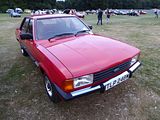
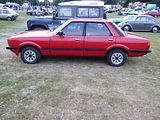
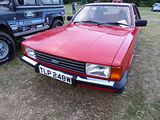

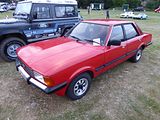

The Mark I Ford Escort was introduced in the UK at the end of 1967, making its show debut at Brussels Motor Show in January 1968, replacing the successful, long-running Anglia. The car was presented in continental Europe as a product of Ford’s European operation. Escort production commenced at the Halewood plant in England during the closing months of 1967, and for left hand drive markets during September 1968 at the Ford plant in Genk.Initially the continental Escorts differed slightly from the UK built ones under the skin. The front suspension and steering gear were differently configured and the brakes were fitted with dual hydraulic circuits; also the wheels fitted on the Genk-built Escorts had wider rims. At the beginning of 1970, continental European production transferred to a new plant on the edge of Saarlouis, West Germany. The Escort was a commercial success in several parts of western Europe, but nowhere more than in the UK, where the national best seller of the 1960s, BMC’s Austin/Morris 1100 was beginning to show its age while Ford’s own Cortina had grown, both in dimensions and in price, beyond the market niche at which it had originally been pitched. In June 1974, six years into the car’s UK introduction, Ford announced the completion of the two millionth Ford Escort, a milestone hitherto unmatched by any Ford model outside the US. It was also stated that 60% of the two million Escorts had been built in Britain. In West Germany cars were built at a slower rate of around 150,000 cars per year, slumping to 78,604 in 1974 which was the last year for the Escort Mark I. Many of the German built Escorts were exported, notably to Benelux and Italy; from the West German domestic market perspective the car was cramped and uncomfortable when compared with the well-established and comparably priced Opel Kadett, and it was technically primitive when set against the successful imported Fiat 128 and Renault 12. Subsequent generations of the Escort made up some of the ground foregone by the original model, but in Europe’s largest auto-market the Escort sales volumes always came in well behind those of the General Motors Kadett and its Astra successor. The Escort had conventional rear-wheel drive and a four-speed manual gearbox, or three-speed automatic transmission. The suspension consisted of MacPherson strut front suspension and a simple live axle mounted on leaf springs. The Escort was the first small Ford to use rack-and-pinion steering. The Mark I featured contemporary styling cues in tune with its time: a subtle Detroit-inspired “Coke bottle” waistline and the “dogbone” shaped front grille – arguably the car’s main stylistic feature. Similar Coke bottle styling featured in the larger Cortina Mark III (also built in West Germany as the Taunus) launched in 1970. Initially, the Escort was sold as a two-door saloon (with circular front headlights and rubber flooring on the “De Luxe” model). The “Super” model featured rectangular headlights, carpets, a cigar lighter and a water temperature gauge. A two-door estate was introduced at the end of March 1968 which, with the back seat folded down, provided a 40% increase in maximum load space over the old Anglia 105E estate, according to the manufacturer. The estate featured the same engine options as the saloon, but it also included a larger, 7 1⁄2-inch-diameter clutch, stiffer rear springs and in most configurations slightly larger brake drums or discs than the saloon. A panel van appeared in April 1968 and the 4-door saloon (a bodystyle the Anglia was never available in for UK market) in 1969. Underneath the bonnet was the Kent Crossflow engine in 1.1 and 1.3 litre versions. A 940 cc engine was also available in some export markets such as Italy and France. This tiny engine remained popular in Italy, where it was carried over for the Escort Mark II, but in France it was discontinued during 1972. There was a 1300GT performance version, with a tuned 1.3 L Crossflow (OHV) engine with a Weber carburettor and uprated suspension. This version featured additional instrumentation with a tachometer, battery charge indicator, and oil pressure gauge. The same tuned 1.3 L engine was also used in a variation sold as the Escort Sport, that used the flared front wings from the AVO range of cars, but featured trim from the more basic models. Later, an “executive” version of the Escort was produced known as the “1300E”. This featured the same 13″ road wheels and flared wings of the Sport, but was trimmed in an upmarket, for that time, fashion with wood trim on the dashboard and door cappings. A higher performance version for rallies and racing was available, the Escort Twin Cam, built for Group 2 international rallying. It had an engine with a Lotus-made eight-valve twin camshaft head fitted to the 1.5 L non-crossflow block, which had a bigger bore than usual to give a capacity of 1,557 cc. This engine had originally been developed for the Lotus Elan. Production of the Twin Cam, which was originally produced at Halewood, was phased out as the Cosworth-engined RS1600 (RS denoting Rallye Sport) production began. The most famous edition of the Twin Cam was raced on behalf of Ford by Alan Mann Racing in the British Saloon Car Championship in 1968 and 1969, sporting a full Formula 2 Ford FVC 16-valve engine producing over 200 hp. The Escort, driven by Australian driver Frank Gardner went on to comfortably win the 1968 championship. The Mark I Escorts became successful as a rally car, and they eventually went on to become one of the most successful rally cars of all time. The Ford works team was practically unbeatable in the late 1960s / early 1970s, and arguably the Escort’s greatest victory was in the 1970 London to Mexico World Cup Rally, co-driven by Finnish legend Hannu Mikkola and Swedish co-driver Gunnar Palm. This gave rise to the Escort Mexico (1598cc “crossflow”-engined) special edition road versions in honour of the rally car. Introduced in November 1970, 10,352 Mexico Mark I’s were built. In addition to the Mexico, the RS1600 was developed with 1,601 cc Cosworth BDA which used a Crossflow block with a 16-valve Cosworth cylinder head, named for “Belt Drive A Series”. Both the Mexico and RS1600 were built at Ford’s Advanced Vehicle Operations (AVO) facility located at the Aveley Plant in South Essex. As well as higher performance engines and sports suspension, these models featured strengthened bodyshells utilising seam welding in places of spot welding, making them more suitable for competition. After updating the factory team cars with a larger 1701 cc Cosworth BDB engine in 1972 and then with fuel injected BDC, Ford also produced an RS2000 model as an alternative to the somewhat temperamental RS1600, featuring a 2.0 litre Pinto (OHC) engine. This also clocked up some rally and racing victories; and pre-empted the hot hatch market as a desirable but affordable performance road car. Like the Mexico and RS1600, this car was produced at the Aveley plant. Seen here were an 1100L Saloon, a rare 1300L, Estate and an RS2000.
The squarer-styled Mark II version appeared in January 1975. The first production models had rolled off the production lines on 2 December 1974. Unlike the first Escort (which was developed by Ford of Britain), the second generation was developed jointly between the UK and Ford of Germany. Codenamed “Brenda” during its development, it used the same mechanical components as the Mark I. The 940 cc engine was still offered in Italy where the smaller engine attracted tax advantages, but in the other larger European markets in Europe it was unavailable. The estate and van versions used the same panelwork as the Mark I, but with the Mark II front end and interior. The car used a revised underbody, which had been introduced as a running change during the last six months production of the Mark I. Rear suspension still sat on leaf springs though some contemporaries such as the Hillman Avenger had moved on to coil springs. The car came in for criticism for its lack of oddments space, with a glove compartment only available on higher end models, and its stalk-mounted horn. The “L” and “GL” models (2-door, 4-door, estate) were in the mainstream private sector, the “Sport”, “RS Mexico”, and “RS2000” in the performance market, the “Ghia” (2-door, 4-door) for a hitherto untapped small car luxury market, and “base / Popular” models for the bottom end. Panel-van versions catered to the commercial sector. The 1598 cc engine in the 1975 1.6 Ghia produced 84 hp with 92 ft·lbft torque and weighed 955 kg (2105 lb). A cosmetic update was given in 1978 with L models gaining the square headlights (previously exclusive to the GL and Ghia variants) and there was an upgrade in interior and exterior specification for some models. Underneath a wider front track was given. In 1979 and 1980 three special edition Escorts were launched: the Linnet, Harrier and Goldcrest. Production ended in Britain in August 1980, other countries following soon after. Spotted here were no fewer than three RS2000 models, a Mexico and a 1600 Ghia.
All the Mark 3 Escorts here were sporting versions, which is not unusual, as most of the “cooking” versions have simply disappeared. There were examples of both the initial style and the post 1986 facelift. A sporting model was announced with the 1.1, 1.,3 and 1,6 litre cars in October 1980. This was the XR3, and it came initially with a carb fed 1.6 litre engine generating 105 bhp and had a four speed gearbox. For 1983, it was upgraded to 115bhp thanks to the use of fuel injection and a five speed transmission had been standardised. Both variants proved very popular, getting a significant percentage of Escort sales and also as a slightly more affordable alternative to a Golf GTi. For those for whom the performance was not quite enough, Ford had an answer, withe the RS Turbo. This 132 PS car was shown in October 1984, as a top of the range car, offering more power than the big-selling XR3i and the limited production RS1600i. Going on sale in the spring of 1985, it proved to be somewhat of a disappointment, with the chassis coming in for severe criticism. The RS Turbo Series 1 was only marketed in a few European nations as production was limited to 5,000 examples, all in white. They were well equipped, with the alloy wheels from the limited production RS 1600i, Recaro seats, and a limited slip differential. One car only was finished in black; it was built especially for Lady Diana. Ford facelifted the entire Escort range in January 1986, and a few months later, a revised Series 2 RS Turbo emerged, which adopted the styling changes of the less potent models, and the new dashboard, as well as undergoing a mechanical revision and the addition of more equipment including anti-lock brakes. The Series 2 cars were available in a wider range of colours.
This is a Mark 2 Granada 2.3GL, The square and straight-lined Granada Mark II was released in August 1977 and was produced until April 1985 following a mild facelift and attention to drivetrain noise, vibration, and harshness in 1982. It was a development of the previous car, the main differences being the use of the “Cologne” V6 engine in 2.0, 2.3, and 2.8 ltire forms replacing the older “Essex” unit (which had never been offered in the Cologne-built Granadas), and the introduction of features such as air conditioning and, for the top-priced 2.8-litre versions, fuel-injection. In mainland Europe, a 1.7 litre V4 was originally available. By the time of its introduction, UK Granada production had been quietly abandoned “for some time”; UK market Granada IIs were imported from Germany. A relatively small number of vehicles were also produced with an Indenor four-cylinder diesel engine in 1.9-, 2.1- and 2.5-litre capacities. Most of these went to taxi operators, and few survive. The smallest 1.9 was quite underpowered and was soon replaced by the somewhat more powerful 2.1, which was presented as the “Granada GLD” in March 1979 at Geneva. By 1982, this was replaced by the more capable 2.5.Fuel-injected 2.8 models were originally offered with an ‘S’ pack or GL trip. In 1979, both versions were replaced by the 2.8i GLS. Today early injection models are particularly rare. The UK only received four door saloons and a commodious estate, but there was a two door saloon as well, offered to those markets who still wanted such a configuration. Although most surviving Granada Mark IIs feature the body-coloured post-facelift (1981) grille, the earlier cars came with a simple black grille regardless of body colour. This is one of those rare earlier cars.
This looks very much like a Sierra XR4i with Cosworth bonnet louvres. The XR4i was the top of the range of the cars that took over from the Cortina in October 1982, but which never captured the same level of enthusiasm, so there are far fewer survivors than there are of the car’s predecessor. The XR4i had a 2.8 litre V6 engine and was only sold with a three door body with the unusual double rear wing.
The Sierra RS Cosworth model. a very sporting version of Ford’s upper-medium sized family car, was built by Ford Europe from 1986 to 1992, the result of a Ford Motorsport project with the purpose of producing an outright winner for Group A racing in Europe. The project was defined in the spring of 1983 by Stuart Turner, then recently appointed head of Ford Motorsport in Europe, who had realised right away that Ford was no longer competitive in this area. Turner got in touch with Walter Hayes, at the time the vice-president of public relations at Ford, to get support for the project. Hayes had earlier been the driving force behind the development of the Ford GT40 that won Le Mans in 1966, and the Cosworth DFV engine that brought Ford 154 victories and 12 world championships in Formula One during the 1960s and 1970s. Hayes found the project very appealing and promised his full support. Turner then invited Ken Kohrs, vice-president of development, to visit Ford’s longtime partner, the automotive company Cosworth, where they were presented a project developed on Cosworth’s own initiative, the YAA engine. This was a twin cam, 16-valve engine based on Ford’s own T88 engine block, better known as the Pinto. This prototype proved an almost ideal basis for the engine Turner needed to power his Group A winner. Therefore, an official request for a turbocharged version (designated Cosworth YBB) capable of 180 HP on the street and 300 HP in race trim, was placed. Cosworth answered positively, but they put up two conditions: the engine would produce not less than 204 HP in the street version, and Ford had to accept no fewer than 15,000 engines. Turner’s project would only need about 5,000 engines, but Ford nevertheless accepted the conditions. The extra 10,000 engines would later become one of the reasons Ford also chose to develop a four door, second generation Sierra RS Cosworth. To find a suitable gearbox proved more challenging. The Borg-Warner T5, also used in the Ford Mustang, was chosen, but the higher revving nature of the Sierra caused some problems. Eventually Borg-Warner had to set up a dedicated production line for the gearboxes to be used in the Sierra RS Cosworth. Many of the suspension differences between the standard Sierra and the Cosworth attributed their development to what was learned from racing the turbocharged Jack Roush IMSA Merkur XR4Ti in America and Andy Rouse’s successful campaign of the 1985 British Saloon Car Championship. Much of Ford’s external documentation for customer race preparation indicated “developed for the XR4Ti” when describing parts that were Sierra Cosworth specific. Roush’s suspension and aerodynamics engineering for the IMSA cars was excellent feedback for Ford. Some production parts from the XR4Ti made their way into the Cosworth such as the speedometer with integral boost gauge and the motorsport 909 chassis stiffening plates. In April 1983, Turner’s team decided on the recently launched Sierra as a basis for their project. The Sierra filled the requirements for rear wheel drive and decent aerodynamic drag. A racing version could also help to improve the unfortunate, and somewhat undeserved, reputation that Sierra had earned since the introduction in 1982. Lothar Pinske, responsible for the car’s bodywork, demanded carte blanche when it came to appearance in order to make the car stable at high speed. Experience had shown that the Sierra hatchback body generated significant aerodynamic lift even at relatively moderate speed. After extensive wind tunnel testing and test runs at the Nardò circuit in Italy, a prototype was presented to the project management. This was based on an XR4i body with provisional body modifications in fibreglass and aluminium. The car’s appearance raised little enthusiasm. The large rear wing caused particular reluctance. Pinske insisted however that the modifications were necessary to make the project successful. The rear wing was essential to retain ground contact at 300 km/h, the opening between the headlights was needed to feed air to the intercooler and the wheel arch extensions had to be there to house wheels 10” wide on the racing version. Eventually, the Ford designers agreed to try to make a production version based on the prototype. In 1984, Walter Hayes paid visits to many European Ford dealers in order to survey the sales potential for the Sierra RS Cosworth. A requirement for participation in Group A was that 5,000 cars were built and sold. The feedback was not encouraging. The dealers estimated they could sell approximately 1,500 cars. Hayes did not give up, however, and continued his passionate internal marketing of the project. As prototypes started to emerge, dealers were invited to test drive sessions, and this increased the enthusiasm for the new car. In addition, Ford took some radical measures to reduce the price on the car. As an example, the car was only offered in three exterior colours (black, white and moonstone blue) and one interior colour (grey). There were also just two equipment options: with or without central locking and electric window lifts. The Sierra RS Cosworth was first presented to the public at the Geneva Motor Show in March 1985, with plans to release it for sale in September and closing production of the 5,000 cars in the summer of 1986. In practice, it was launched in July 1986. 5545 were manufactured in total of which 500 were sent to Tickford for conversion to the Sierra three-door RS500 Cosworth. The vehicles were manufactured in right hand drive only, and were made in Ford’s Genk factory in Belgium. Exactly 500 RS500s were produced, all of them RHD for sale in the UK only – the biggest market for this kind of Ford car. It was originally intended that all 500 would be black, but in practice 56 white and 52 moonstone blue cars were produced.To broaden the sales appeal, the second generation model was based on the 4 door Sierra Sapphire body. It was launched in 1988, and was assembled in Genk, Belgium, with the UK-built Ford-Cosworth YBB engine. Cylinder heads on this car were early spec 2wd heads and also the “later” 2wd head which had some improvements which made their way to the 4X4 head. Suspension was essentially the same with some minor changes in geometry to suit a less aggressive driving style and favour ride over handling. Spindles, wheel offset and other changes were responsible for this effect. Approximately 13,140 examples were produced during 1988-1989 and were the most numerous and lightest of all Sierra Cosworth models. Specifically the LHD models which saved weight with a lesser trim level such as manual rear windows and no air conditioning. In the UK, the RHD 1988-1989 Sierra Sapphire RS Cosworth is badged as such with a small “Sapphire” badge on the rear door window trims. All 1988-1989 LHD models are badged and registered as a Sierra RS Cosworth with no Sapphire nomenclature at all. “Sapphire” being viewed as a Ghia trim level that saw power rear windows, air conditioning and other minor options. Enthusiasts of the marque are mindful of this and will describe the LHD cars by their body shell configuration, 3 door or 4 door. As the Sapphire Cosworth was based on a different shell to the original three-door Cosworth, along with its more discreet rear wing, recorded a drag co-efficient of 0.33, it registered slightly better performance figures, with a top speed of 150 mph and 0-60 of 6.1 seconds, compared to the original Cosworth. In January 1990, the third generation Sierra RS Cosworth was launched, this time with four wheel drive. As early as 1987, Mike Moreton and Ford Motorsport had been talking about a four wheel drive Sierra RS Cosworth that could make Ford competitive in the World Rally Championship. The Ferguson MT75 gearbox that was considered an essential part of the project wasn’t available until late 1989 however. Ford Motorsport’s desire for a 3-door “Motorsport Special” equivalent to the original Sierra RS Cosworth was not embraced. The more discreet 4-door version was considered to have a better market potential. It was therefore decided that the new car should be a natural development of the second generation, to be launched in conjunction with the face lift scheduled for the entire Sierra line in 1990. The waiting time gave Ford Motorsport a good opportunity to conduct extensive testing and demand improvements. One example was the return of the bonnet louvres. According to Ford’s own publicity material, 80% of the engine parts were also modified. The improved engine was designated YBJ for cars without a catalyst and YBG for cars with a catalyst. The latter had the red valve cover replaced by a green one, to emphasise the environmental friendliness. Four wheel drive and an increasing amount of equipment had raised the weight by 100 kg, and the power was therefore increased to just about compensate for this. The Sierra RS Cosworth 4×4 received, if possible, an even more flattering response than its predecessors and production continued until the end of 1992, when the Sierra was replaced by the Mondeo. The replacement for the Sierra RS Cosworth was not a Mondeo however, but the Escort RS Cosworth. This was to some extent a Sierra RS Cosworth clad in an “Escort-like” body. The car went on sale in May 1992, more than a year after the first pre-production examples were shown to the public, and was homologated for Group A rally in December, just as the Sierra RS Cosworth was retired. It continued in production until 1996. The Sierra and Sapphire Cosworths were undoubted performance bargains when new, but they also gained a reputation both for suffering a lot of accidents in the hands of the unskilled and also for being among the most frequently stole cars of their generation. These days, though, there are some lovely and treasured examples around and indeed you are far more likely to see a Cosworth version of the Sierra than one of the volume selling models.
2016 marks the 40th anniversary of the Fiesta. Britain’s best seller for many years now, several million have been on our roads, but the early ones are largely all but gone. There was one here. Originally developed under the project name “Bobcat” (not to be confused with the subsequent rebadged Mercury variant of the Ford Pinto) and approved for development by Henry Ford II in September 1972, just after the launch of two comparable cars – the Fiat 127 and Renault 5, the Fiesta was an all new car in the supermini segment, and was at the time the smallest car ever made by Ford. Development targets indicated a production cost US$100 less than the current Escort. The car was to have a wheelbase longer than that of the Fiat 127, but with overall length shorter than that of Ford’s Escort. The final proposal was developed by Tom Tjaarda at Ghia. The project was approved for production in late 1973, with Ford’s engineering centres in Cologne and Dunton (Essex) collaborating. Ford estimated that 500,000 Fiestas a year would be produced, and built an all-new factory near Valencia, Spain; a trans-axle factory near Bordeaux, France; factory extensions for the assembly plants in Dagenham, UK. Final assembly also took place in Valencia. The name Fiesta belonged to General Motors, used as a trim level on Oldsmobile estate models, when the car was designed but it was freely given for Ford to use on their new B-class car. After years of speculation by the motoring press about Ford’s new car, it was subject to a succession of carefully crafted press leaks from the end of 1975. A Fiesta was on display at the Le Mans 24 Hour Race in June 1976, and the car went on sale in France and Germany in September 1976; to the frustration of UK dealerships, right hand drive versions only began to appear in January 1977. Its initial competitors in Europe, apart from the Fiat 127 and Renault 5, included the Volkswagen Polo and Vauxhall Chevette. Chrysler UK were also about to launch the Sunbeam by this stage, and British Leyland was working on a new supermini which was eventually launched as the Austin Metro in 1980. The Fiesta was initially available in Europe with the Valencia 957 cc with high compression and low compression options, and 1,117 cc engines in Base, Popular, L, GL (1978 onward), Ghia and S trim, as well as a van. A sporting derivative, the 1.3 Supersport was offered for the 1980 model year, using the 1.3 litre Kent Crossflow engine, effectively to test the market for the similar XR2 introduced a year later, which featured a 1.6 litre version of the same engine.
US Fords were well represented, too, with the oldest being this Model T Runabout.
In the 1950s, Ford had a much simpler model line than they did even 10 years later. For 1952, the range was refreshed, although remaining similar to the all-new 1949 Fords. This time, curved one-piece windshield glass joined a new “Mileage Maker” straight-6 engine with 101 hp. The 226 CID (3.7 litre) L-head straight-6 was replaced by an overhead valve 215 CID (3.5 litre) Mileage Maker with 101 hp, while the old 239 CID (3.9 litre) Flathead V8 remained with 110 hp. The model lines were again reshuffled, with the base model now called “Mainline” and mid-level called “Customline”. The top “Crestline” included the “Sunliner” convertible, and the “Victoria” hardtop, a tradition going back to 1932 with the Ford Victoria 2-door coupe. The station wagon continued with the “Country Squire”. Inside was a “flight-style” control panel and new pedals suspended from below the dashboard. A voltmeter, gas gauge, temp. gauge, and oil pressure were standard. The clock and radio were in the centre of the dash. The grille sported a single centre “bullet” surrounded by a chrome ring as well as “jet intake” corner markers. New trunk hinges were used that would not crush the contents of the trunk. The brake and clutch pedal were now suspended. Wheelbase was 115 in. 1953, the year of the Club Coupe seen here, was Ford’s 50th anniversary. The big news for 1953 was the availability of power-assisted brakes and steering, which had previously been limited to the Mercury and Lincoln lines. The centre grille bullet lost its ring and was now flanked by vertical black stripes, while the corner markers were plain rectangular lights rather than the circular “intakes”. All 1953 Fords featured commemorative steering wheels marking the company’s 50th anniversary. Mechanical changes included two-inch wider tread, and a k-bar frame with five cross-members. William Clay Ford paced the Indianapolis 500 in a Sunliner convertible with a dummy Continental tire kit (Coronado kit). This was also the last year for real wood trim on the Country Squire wagon. Toward the end of the year, Ford added “Master-Guide” power steering as an option on cars with V8s. Full instrumentation was still used. An unusual service provided by Ford was that the radio preset buttons would already be set to local stations by the dealer. The heater was $74.
Not surprisingly, there were plenty of Mustang models here, with three early cars, and a 1970 Coupe and 1971 Convertible showing how the car grew with every model year update.
This 1963 Fairlane 500 was purchased by its current owner, Dennis Voller, a couple of years ago. He was looking for a Mustang, but saw this and decided it would be far rarer than a Mustang, so he would prefer it.
Joining it was a 1963 Galaxie Hardtop. Galaxie was the name that Ford used for their full-sized models from 1959. An all-new design appeared in 1960 and would run for 4 years, with the usual annual changes made, so an expert can tell the age of the car from looking at it. The styling was much squarer than that of the 1959 model, and by 1961, the tailfins had completely gone. From 1961, the 500 and 500XL models were added to the top of the range. and by 1962, the Fairlane and Custom trims were removed from the range, the former of these giving rise a different and smaller model. There was minor freshening of the model for 1963, but this was the year when the four-door hardtop 500/XL bodystyle was added. A lower, fastback roofline was added mid-year to improve looks and make the big cars more competitive on the NASCAR tracks with the added downforce. This 1963½ model, the industry’s first official “½ year” model, was called the “sports hardtop” or “fastback” (it shared this feature with the for 1963½ Falcon). Galaxie buyers showed their preference as the new sports hardtop models handily outsold the “boxtop” square-roof models. The sports hardtop was available in both Galaxie 500, and Galaxie 500/XL trim. Mercury also received the new roofline (under the Marauder badge) in Monterey, Montclair, and Park Lane models. There was a choice of several different engines. At the beginning of the 1963 model run, the 292 Y-block V8 was replaced as the base V8 engine with the Fairlane’s new small block 260. The 260 proved under-powered for the heavy full size Ford and was replaced midyear (coincident with the introduction of the 63 and 1/2 models) with the 289 V8. Five different transmissions were offered for 1963. A 3-speed manual column shift was standard on all models except the 406 V8, which required the heavier duty Borg-Warner 4-speed manual. A three speed manual with overdrive was optional, but rarely ordered. The two-speed Ford-O-Matic was common with the 6-cylinder and small block V-8s, while the majority of big blocks (352 and 390) were ordered with the 3-speed Cruise-O-Matic automatic transmission. The availability of several different rear end ratios, along with 5 transmissions, and 8 different engines, led to a huge number of different driveline combinations for 1963. The most produced combination for the Galaxie and Galaxie 500 was the 352 V8, with Cruise-O-Matic and the 3.0 rear end ratio.
Last of the US Fords was this 1970 Torino 500 Coupe. Before 1970, Torino had been used as a trim version of the intermediate-sized Fairlane, whereas for the redesigned 1970 model it became the primary with the Fairlane was a sub-series. Ford moved away from emulating the boxy lines of the full-size Fords to a completely new body for the 1970 Torino/Fairlane line influenced by coke bottle styling. Just as tailfins were influenced by jet aircraft of the 1950s, stylists such as Ford stylist Bill Shenk who designed the 1970 Ford Torino were inspired by supersonic aircraft with narrow waists and bulging forward and rear fuselages needed to reach supersonic speeds. The model line-up for 1970 initially featured 13 models. The base model was the “Fairlane 500”, which was available in a 2-door hardtop, 4-door sedan, and 4-door wagon. Next was the mid-level “Torino”, which was available as a 2-door and 4-door hardtop, and a 4-door sedan and station wagon. The 4-door pillarless hardtop was a new body style for the 1970 model year (Chevrolet introduced this body style for its intermediate Chevelle starting in 1966). The “Torino Brougham” was the top trim level, and was available as a 2-door and 4-door hardtop, and a 4-door station wagon. The sporty “Torino GT” was available as a 2-door SportsRoof and convertible. Finally, the top performance model, the “Torino Cobra” was available as a 2-door SportsRoof only. To add to this extensive line-up, the Falcon name was adopted mid-year for a new entry-level intermediate. The Ford Falcon compact model continued for the first half of the 1970 model year, but was discontinued as it could not meet new federal standards that came into effect on January 1, 1970. At this time, the name was applied to the base trim level in the intermediate line. The 1970 1⁄2 Falcon was available as a 2-door and 4-door sedan, and 4-door station wagon. This was the lowest priced intermediate, and had even less standard features than the Fairlane 500. The Falcon was the only intermediate that featured a rubber floor instead of carpet, and was the only series that featured a pillared 2-door sedan. Also introduced mid-year was a Torino 2-door Sportsroof model, which was marketed as a low price alternative to the GT. With the above mid-year additions, the Ford intermediate line-up consisted of 17 separate models. The engine line-up received major changes, and only the 250 CID I-6, 302-2V and the 351W-2V were carried over from 1969. Most models continued to feature the 250 CID I-6 as the standard engine. Optional engines included the 302-2V (standard on GT and Brougham models), 351W-2V, the new 351 Cleveland available with a 2- or 4-barrel carburettor, and the new 429-4V 385 Series V8 (standard on the Cobra models). Interiors on the Torino were all new for 1970. The dashboard featured a linear style speedometer centered on the driver, and a new “ribbon” style tachometer was an option for V8 models. A temperature gauge was the only available gauge; oil pressure and electrics were monitored with warning lights only. High back bucket seats were available for all 2-door models, as was an optional console; the GT model no longer had the former as standard features. All 2-door hardtop, SportsRoof and convertible models featured “DirectAire” ventilation systems as a standard feature, which eliminated the need for side vent windows. The 2-door sedan, 4-doors and station wagons still had vent windows, and the “DirectAire” system was an option for these models. The ignition switch was moved from the instrument panel to the steering column, in compliance with Federal regulations. The steering wheel and column-mounted shifter now locked when the key was removed. Overall, 1970 was a successful year for Torino. It was a well received car by the automotive press and was selected as the Motor Trend Car of the Year for 1970. Ford produced 230,411 Torinos for 1970, along with 110,029 Fairlanes and 67,053 Falcons, for a total production of 407,493 units.
Oldest of the commercial Fords on display was this Fordson E83 Van. Also sold later under the Thames brand, this was a 10 cwt (half ton) light commercial vehicle that was built at the Ford Dagenham assembly plant (home of Fordson tractors) between 1938 and 1957. The van was sold in Australia as the Ten-Ten, and the E83W was available in various forms around much of the world as Britain strove to export after World War II. In some countries, the ‘cowl and chassis’ only was imported and local bodies built. The E83W was aimed at the small haulage, trade and merchant market, sectors in which it sold well. A ‘Utilicon’ estate wagon conversion was available in the UK. During and after World War II, many specialist variations such as mobile canteens, ice cream vans and even fire pumps were built on the E83W chassis. The E83W was powered by the 1172 cc Ford 10 hp side-valve engine, with a 3-speed gearbox, and was heavily geared down in the rear axle. This made the Fordson much slower than the saloons, with an effective top speed of not much over 40 mph. Apart from the 10 hp engine, the E83W shares few parts with the other small Fords, which does make the spares a little harder to get hold of. The front and rear axles are much heavier than the saloon and 5cwt van components, and share some parts such as bearings and other internals with the contemporary Ford V8 models (Models 62 and E71A Pilot). The head lamps were shared with the E27N tractor, for which they were an optional extra only.
The Thames Trader, a range of trucks manufactured by Ford UK between 1957 and 1965, had a most distinctive cab design, which set it apart from other British commercial vehicles. This was a forward-control (or semi-forward control) design and the Thames Trader model covered a much wider weight range than the existing normal control ET Thames model or the earlier forward control 7V model. Both these earlier models had been based on Ford of America designs, the new Thames Trader was the first heavy commercial to be designed by Ford of Britain, (although if you look at the headlight surrounds of the American Ford C series truck of the mid 1950s there is a definite family resemblance). The Thames Trader model range covered weights from 2 to 7 tons, powered by either petrol or diesel engines in four- or six-cylinder guises. The lower-weight vehicles were available with 118- and 138-inch wheelbases, the heavy weight vehicle with 138-, 152- and 160-inch wheelbases; there was also a 108-inch tipper wheelbase. In addition there was a low-frame chassis model – typically used for furniture van bodywork. A Mk 2 version was introduced in mid-1962. Externally it is very easy to differentiate between Mk1 and Mk2 versions; the Mk1 has the words THAMES TRADER in red on a chrome strip along the bottom of the bonnet opening and the white painted grill between the headlights has a vertical divider with a red circular badge with 4 stars, whereas the Mk2 has just the word THAMES under the bonnet, and TRADER in white letters spaced out between the headlights replacing the divider and badge. The Mk2 Diesel engined variants had either a 4D or 6D chrome badge on each front wing, on the Mk1 it was a squarish chrome badge with either a red painted 4, 6, 4D or 6D to indicate the engine configuration. The lower edge of the badge had a horizontal chrome strip running the length of the lower part of the wing. After the discontinuation of the Thames brand in 1965 the NC was re-designated as the K Series.
GUY
This 1949 Guy Wolf has a body by coachbuilders Barnard. For many years the vehicle had a long active life in Llandudno, operating tours around the Marine Drive, Great Orme and surrounding countryside. It is believed that this vehicle was loaned to Colwyn Bay Council in 1969. It was eventually sold into private hands as recently as 1975, staying in Llandudno for several more years before moving south to the English Midlands. For the last 12 years the bus has been owned by David Castleman, who presents it in the livery of Thompson Tours of Stoke-on-Trent.
HILLMAN
Once a common sight on our roads, this is a Hillman Hunter GLS from 1972. The Hunter is perhaps the best known of what was codenamed, Arrow, a range of cars that Rootes Group produced from 1966 to 1979. It is amongst the last Rootes designs, developed with no influence from future owner Chrysler. A substantial number of separate marque and model names applied to this single car platform. Some were given different model names to justify trim differences (Hillman GT, Hillman Estate Car) and to make things more complicated, from time to time all models were sold in some European markets under the Sunbeam marque (Sunbeam Sceptre for instance), and at other times used UK marque/model names. To add complication, Singer Gazelle/Vogue models were also sold in the UK for one season badged as Sunbeams after the Singer brand was withdrawn. The Arrow range was conceived in 1962. Following the Hillman Imp, consideration was given to developing a larger rear-engined car, but this concept was dismissed, and the engineering settled on for the new car was more conventional and closer to the layout of the existing Audax series (which included the previous Hillman Minx). With cash-strapped Rootes struggling amid continuing engine cooling problems with the Imp, which often resulted in warped cylinder heads, the cautious Arrow broke little new engineering ground. New parts were largely based on tried and tested Rootes components, using a new but strong 5-bearing version of the well-proven 1725 cc overhead valve petrol engine as a starting point which varied in output from 66 bhp to 88 bhp. The engine was inclined by a modest 15 degrees, to allow for a lower bonnet line and to enable packaging of the carburettors. This engine was further uprated by specialists Holbay, employing two Weber 40DCOE carburettors to produce 107 bhp for the Sunbeam Rapier H120 and Hillman Hunter GLS. A smaller 1500 cc engine was the standard for manual versions of the Hillman Minx and the Singer Gazelle, and the Hillman Hunter DeLuxe model which succeeded the Minx. Automatic models were all powered by the 1725 cc engine. Particular attention was paid to weight and cost to bring the vehicle in line with its natural competitors, including the Mark 2 Ford Cortina. For the first time in a Rootes car MacPherson strut suspension featured at the front, with a conventional live axle mounted on leaf springs at the rear. Other firsts for Rootes in the new car were curved side glass and flow-through ventilation. Manual transmissions were available in four-speed form with an optional Laycock de Normanville overdrive, or Borg-Warner automatic transmission, again as an option. Initially, the Borg Warner Type 35 3-speed automatic was offered, then the Type 45 four-speed automatic became available in 1973. The handbrake was situated between the driver’s seat and door (i.e. on the driver’s right-hand side for a right-hand drive car) rather than between the front seats. This followed the practice in the ‘Audax’ cars. The first Arrow model to be launched, the Hillman Hunter, was presented as a replacement for the Hillman Super Minx. The Hunter was lighter than its predecessor and the wheel-base of the new car was actually 2½ inches shorter than that of the old, but the length of the passenger cabin was nonetheless increased by moving the engine and the toe-board forwards. For the first two years there were few changes. However, in May 1968 power assisted brakes were made available as a factory fitted option. Hitherto this possibility had been offered only as a kit for retro-fitting: it was stated that the factory fitted servo-assistance, at a domestic market price slightly below £13, would be cheaper for customers. A mild facelift in 1970 gave new grilles to the various Hunter trim levels, and some derivatives gained a (then) more fashionable dashboard, exchanging wood for plastic, but the car remained fundamentally the same throughout its life. A more detailed facelift for 1972 brought a new all-plastic dashboard with deeply hooded round dials (earlier versions had either a strip speedometer or round dials in a flat dashboard for more expensive models like the Vogue), new steering wheel, plastic instead of metal air cleaner, reshaped squarer headlamps in a new grille and some engine tuning changes. For 1975, bumpers were enlarged and the tail lights were enclosed in a full-width anodised aluminium trim piece. Following the 1967 acquisition of Rootes by Chrysler, the Arrow derivatives were rationalised until only the Hillman Hunter version was left by 1976. From September 1977 it was re-badged as a Chrysler, which it was to be for the remaining 2 years of its life. Hunter production was switched in 1969 to Rootes’ troubled Imp plant in Linwood, from its original home of Ryton. Sales were lower after 1975 following the launch of the Chrysler Alpine, a similar sized car but with front-wheel drive and a hatchback bodystyle, at a time when rear-wheel drive saloons still dominated in this sector. Following the Hillman Avenger’s move to Linwood in 1976, the very last European Hunters were assembled in the Santry plant, Shanowen Road, Ireland from “complete knock down” (CKD) kits until production ended in 1979 – but no evidence exists to suggest that the Talbot badge was applied to any production Hunter following Chrysler Europe’s 1978 takeover by Peugeot, and the application of that badge to other Chrysler models sold on or after 1 August 1979. The final Chrysler Hunter was built in September 1979 in Porirua, New Zealand, and was donated to the Southward Museum. In 2000 the Museum sold the car to a private collector.
ISO
It is not uncommon to find that if there is a Grifo present, there are two others close by, but that did not seem to be the case here, with just one of these rare cars attending. This is perhaps the best known of the small number of different models produced by ISO in the 1960s and early 70s. The prototype ‘Grifo A3/L’ was revealed at the Turin show in 1963 to overwhelming approval. First production Iso Grifo’s followed and all used reassembled and blueprinted Chevrolet Corvette 5.4 litre engines until a 7.0 litre option was introduced in 1968. The larger engined cars were distinguished by some detail modifications, such as a “subtle” bonnet scoop, necessary to accommodate the taller engine and a black band across the rear roof pillar. 322 Series I Grifos were produced before the design received a facelift in 1972 after which time a further 78 Series II Grifo’s were built. In total 90 Grifos were specified in seven-litre form, with only four being built in right-hand drive. The 7 litre cars had a 454 cubic inch Chevrolet V8 engine, and following a rebuild, this car recorded dynamometer results of 490bhp at 5,500rpm. The engine is mated to a modern Tremec TKO600 five-speed gearbox capable of handling this mighty power house.
Renzo Rivolta died in 1966, and his son, Piero, took over as managing director. Under Piero’s leadership, Iso built the limousine Fidia, “the fastest four seats on wheels” with body by Ghia, the Grifo 7 litre and the 2 + 2 fastback Coupé Lele, which consituted the second Iso to be seen here. The Lele was launched in 1969. It had a body designed by Bertone and was intended as the successor to the IR 300. At the start of 1973 the Rivolta family ceded the business to an Italian American financier named Ivo Pera who promised to bring American management know-how to the firm. The business was again renamed to Iso Motors, just before fading rapidly into obscurity, going bankrupt in 1974, only 1700 Iso Gran Turismos having been built in those ten years. That meant that the Lele was the last new design offered. Styled by Bertone, there was little wrong with the looks of the car, but build quality was patchy and the large V8 engine was thirsty so when the fuel crisis of 1974 made such cars a liability, sales reduced to next to none, and this proved the deathknell for the marque.
JAGUAR
Oldest Jaguar model type here was an SS100. The first of William Lyons’ open two-seater sports cars came in March 1935 with the SS 90, so called because of its claimed 90 mph top speed. This car used the 2½-litre side-valve, six-cylinder engine in a short-chassis “cut and shut” SS 1 brought down to an SS 2’s wheelbase. Just 23 were made. It was the precursor to one of the finest pre-war sports car ever made, the SS100. That car benefitted from some significant engine development work that was led by Harry Westlake, who was asked to redesign the 2½-litre 70 bhp side-valve engine to achieve 90 bhp. His answer was an overhead-valve design that produced 102 bhp and it was this engine that launched the new SS Jaguar sports and saloon cars in 1936. Shown first in the SS Jaguar 2½-litre saloon, the new car caused a sensation when it was launched at a trade luncheon for dealers and press at London’s Mayfair Hotel on 21 September 1935. The show car was in fact a prototype. Luncheon guests were asked to write down the UK price for which they thought the car would be sold and the average of their answers was £765. Even in that deflationary period, the actual price at just £395 would have been a pleasant surprise for many customers, something which characterised Jaguars for many decades to come. Whilst the new Jaguar saloon could now compete with the brand new MG SA, it was the next application of the engine that stunned everyone even more, with the launch of the legendary SS100. Named because it was a genuine 100 mph car, this open topped sports car looked as good as it was to drive. Only 198 of the 2½-litre and 116 of the 3½-litre models were made and survivors are highly prized and priced on the rare occasions when they come on the market. Such is their desirability that a number of replica models have been made over the years, with those made by Suffolk Engineering being perhaps the best known, and which are indeed hard to tell apart from an original 1930s car at a glance. Indeed, this car shows as being based on a 1970 chassis, so it is not a genuine 1930s original.
The SS100 may have grabbed all the column inches, but it was the saloon cars of the period that kept Jaguar in business and there was a nice example of one of those here. These were produced in the late 1930s and again once production resumed after the war until 1949. Sometimes referred to as the Jaguar Mark IV. the cars were marketed as the Jaguar 1½ litre, Jaguar 2½ litre and Jaguar 3½ litre with the Mark IV name later applied in retrospect to separate this model from the succeeding Mark V range. All these cars were built on a separate chassis frame with suspension by semi-elliptic leaf springs on rigid axles front and rear. Biggest seller, with 10,980 made, was the smallest model of the range, the 1½ litre, which originally featured a 1608 cc side valve Standard engine but from 1938 this was replaced by a 1776 cc overhead-valve unit still from Standard who also supplied the four-speed manual transmission. Pre-war the car was available as a saloon or drophead coupé but post war only the closed model was made. Up to 1938 body construction on all the models was by the traditional steel on wood method but in that year it changed to all steel. Performance was not a strong point but 70 mph was possible: the car featured the same cabin dimensions and well-appointed interior as its longer-engined brothers. Despite its lack of out-and-out performance, a report of the time, comparing the 4-cylinder 1½-litre with its 6-cylinder siblings, opined that the smallest-engined version of the car was “as is often the case … the sweetest running car” with a “big car cruising gait in the sixties”. For the 2½ Litre, the engine was also sourced from Standard but had the cylinder head reworked by SS to give 105 bhp. Unlike the 1½ Litre there were some drophead models made post-war. The chassis was originally of 119 in but grew by an inch in 1938, the extra length over the 1½ Litre was used for the six-cylinder engine as the passenger accommodation was the same size. Nearly 7000 of these were sold. The 3½ Litre, introduced in 1938, was essentially the same body and chassis as the 2½ Litre but the larger 125 bhp engine gave better performance but at the expense of economy. Seen here were a 1½ Litre and a 2½ Litre, both of them pre-war cars.
Jaguar stunned the world with the XK120 that was the star of the Earls Court Motor Show in 1948. Seen in open two seater form, the car was a test-bed and show car for the new Jaguar XK engine. The display car was the first prototype, chassis number 670001. It looked almost identical to the production cars except that the straight outer pillars of its windscreen would be curved on the production version. The roadster caused a sensation, which persuaded Jaguar founder and design boss William Lyons to put it into production. Beginning in 1948, the first 242 cars wore wood-framed open 2-seater bodies with aluminium panels. Production switched to the 112 lb heavier all-steel in early 1950. The “120” in the name referred to the aluminium car’s 120 mph top speed, which was faster with the windscreen removed. This made it the world’s fastest production car at the time of its launch. Indeed, on 30 May 1949, on the empty Ostend-Jabbeke motorway in Belgium, a prototype XK120 timed by the officials of the Royal Automobile Club of Belgium achieved an average of runs in opposing directions of 132.6 mph with the windscreen replaced by just one small aeroscreen and a catalogued alternative top gear ratio, and 135 mph with a passenger-side tonneau cover in place. In 1950 and 1951, at a banked oval track in France, XK120 roadsters averaged over 100 mph for 24 hours and over 130 mph for an hour, and in 1952 a fixed-head coupé took numerous world records for speed and distance when it averaged 100 mph for a week. Roadsters were also successful in racing and rallying. The first production roadster, chassis number 670003, was delivered to Clark Gable in 1949. The XK120 was ultimately available in two open versions, first as an open 2-seater described in the US market as the roadster (and designated OTS, for open two-seater, in America), and from 1953 as a drophead coupé (DHC); as well as a closed, or fixed head coupé (FHC) from 1951. A smaller-engined version with 2-litres and 4 cylinders, intended for the UK market, was cancelled prior to production. It was replaced by the XK140 in late 1954. The car seen here was a gorgeous open two seater
Although bearing a family resemblance to the earlier XK120 and XK140, the XK150, launched in the spring of 1957, was radically revised. A one-piece windscreen replaced the split screen, and the wing line no longer dropped so deeply at the doors. The widened bonnet opened down to the wings, and on the Roadster the windscreen frame was moved back 4 inches to make the bonnet longer. The XK140’s walnut dashboard was replaced by one trimmed in leather. On the early Drophead Coupés, the aluminium centre dash panel, which was discontinued after June 1958, had an X pattern engraving similar to the early 3.8 E-Type. Thinner doors gave more interior space. On the front parking lights, which were located atop the wings, a little red light reminded the driver the lights were on. Suspension and chassis were very similar to the XK140, and steering was by rack and pinion; power steering was not offered. The standard engine, the similar to the XK140, but with an new “B” type cylinder head, was the 3.4 litre DOHC Jaguar straight-6 rated at 180 SAE bhp at 5750 rpm but most cars were fitted with the SE engine whose modified cylinder head (B type) and larger exhaust valves boosted the power to 210 SAE bhp at 5500 rpm. Twin 1.75-inch (44 mm) SU HD6 carburettors were fitted. While the first XK150s were slower than their predecessors, the deficit was corrected in the spring of 1958 with a 3.4-litre “S” engine whose three 2-inch SU HD8 carburettors and straight-port cylinder head increased power to a claimed 250 SAE bhp. For 1960, the 3.4 litre engine was bored to 3.8 litres, rating this option at 220 hp in standard tune or 265 hp in “S” form. A 3.8 litre 150S could top 135 mph and go from 0–60 mph in around 7.0 seconds. Fuel economy was 18mpg. Four-wheel Dunlop 12 in disc brakes appeared for the first time although it was theoretically possible to order a car with drums. When leaving the factory the car originally fitted either 6.00 × 16 inch Dunlop Road Speed tyres as standard, or you could specify 185VR16 Pirelli Cinturato CA67 as a radial option on either 16 × 5K½ solid wheels (basic models) or 16 × 5K wire wheels. Production ended in October 1960, and totalled 2265 Roadsters, 4445 Fixed Head Coupés and 2672 Drophead Coupés.
Replacement for the XK models came in 1961 with the E Type, and it stunned the world at its premier at the 1961 Geneva Show. Considered by many to be Sir William Lyons’ greatest achievement, not only did the car have stop-you-in-your-tracks gorgeous styling, but it had explosive performance (even if the 150 mph that was achieved in The Autocar’s Road Test is now known to have been with a little “help”), but it was the price that amazed people more than anything else. Whilst out of reach for most people, who could barely afford any new car, it was massively cheaper than contemporary Aston Martins and Ferraris, its market rivals. It was not perfect, though, and over the coming years, Jaguar made constant improvements. A 2+2 model joined the initial range of Roadster and Coupe, and more powerful and larger engines came when the 3.8 litre was enlarged to 4.2 litres, before more significant styling changes came with the 1967 Series 2 and the 1971 Series 3, where new front end treatments and lights were a consequence of legislative demands of the E Type’s most important market, America. There were examples of all three Series here, a mix of Roadster and Coupe models.
Jaguar launched the Mark IX in 1959, as a replacement for the previous Mark VIII. The early versions were identical in exterior appearance to the Mark VIII except for the addition of a chrome “Mk IX” badge to the boot lid. Later versions had a larger tail-lamp assembly with the addition of an amber section for traffic indication, visually similar to the tail-lights of the smaller Mark 2 Jaguar sedan. By the time the Mark IX reached the market, it was quite an old design, as it was based on the Mark VII which had been first seen in 1950. The Mark VII chassis came from the even earlier Jaguar Mark V but whilst the wheelbase remained the same at 10 feet, the new model’s body looked more streamlined, with integrated headlights and mudguards, a two-piece windscreen, and longer rear overhang. As on the Mark V, the rear wheels were partially covered by removable spats. Whereas the Mark V had a prewar engine originally developed by the Standard Motor Company, the Mark VII was powered by the newly developed XK engine, which had first been seen in the 1948 XK120, with the 3442 cc straight-six providing 160 bhp, the same as in the XK120. Published performance figures for the Mark VII were based on the standard 8:1 compression ratio, but as this was unsuitable for the UK market’s low-octane Pool petrol, an engine with a lower compression ratio of 7:1 engine was optional. British motoring magazines tested the car’s performance with the higher compression ratio, using the Ostend to Brussels autoroute in Belgium, where 80 octane fuel was available. In 1952, The Motor recorded a top speed of 101 mph, 0–60 mph in 13.7 seconds and returned 17.6 miles per imperial gallon. These were impressive figures for the time, and were one reason why the car was popular in motorsport as well as on the road. When the car was being developed Jaguar thought it would find most of its customers overseas, mainly because UK car tax at that time penalised buyers of larger-engined cars. However it went into production just as Britain’s postwar economic austerity began to ease, and in 1951 the car’s enthusiastic reception in both the British and American markets prompted Jaguar to relocate production to larger premises, at the Browns Lane plant, which had been built for wartime production as a shadow factory and was now available for immediate use. By the time the Mark VII was upgraded to M specification in 1954, 20,908 had been produced. Launched at the London Motor Show in October 1954, the Mark VII M continued with the same capacity and 8:1 compression ratio, uprated to 190 bhp. A four-speed manual gearbox was standard, while the Borg Warner automatic, introduced in 1953 and hitherto available only on exported Mark VIIs, now became optional for British buyers. Distinguishing the Mark VII M from its predecessor, circular grilles over the horns were installed below the headlights in place of the former integrated auxiliary lamps, which were moved slightly further apart and mounted on the bumper. Both bumpers now wrapped further around the sides of the car. In 1956, with the advent of the Suez Crisis Britain anticipated fuel rationing, and bubble cars appeared on the streets. Jaguar switched focus to their smaller saloons (the Mark I 2.4 had been introduced in 1955), and neither the Mark VII M nor any of its increasingly powerful but fuel-thirsty successors would match the production volumes of the original Jaguar Mark VII. Nevertheless, before it was superseded by the Mark VIII, the Mark VII M achieved 10,061 sales during its two-year production run. The Mark VII was succeeded by the Mark VIII i 1956, and although this looked very similar, there were plenty of detailed differences, The interior fittings were more luxurious than those of the Mark VII. Distinguishing visually between the models is facilitated by changes to the front grille, the driving or fog lamps being moved from the front panel to the horizontal panel between bumper and front panel, larger rear lamps and most obviously a curved chrome trim strip below the waistline which allowed the factory to offer a variety of two-tone paint schemes. In addition the new car had rear spats that were cut back to display more of the rear wheels and featured a one-piece slightly curved windscreen, where the Mark VII had incorporated a two-piece front screen of flat glass. Just 6227 examples were made before the introduction of the Mark IX. The new car had a larger 3.8 litre 190 bhp version of the XK engine Standard transmission was a four-speed manual system: options included overdrive, but most cars were built with a Borg Warner three-speed automatic box. The Mark IX was the first production Jaguar to offer four-wheel servo-assisted Dunlop disc brakes and recirculating ball power steering, which were now standard equipment. The brake system included a vacuum reserve tank to preserve braking in the event that the engine stalled. On models with automatic transmission, the brakes were equipped with an electromagnetic valve that maintained brake pressure at rest when the brake pedal was released to prevent the car from rolling back on an incline, hence its name “Hill Holder”. The Hill Holder was often troublesome (failing to release the brakes when the accelerator was depressed) and was disconnected on most cars without ill effect. The power steering was driven by a Hobourn-Eaton pump, operating at 600-650 psi. It was attached to the back of the generator and allowed the steering to be geared up to 3.5 turns lock-to-lock as against the 4.5 turns for the Mark VII and VIII models. The sunshine roof became a standard fitting for the UK market. The interior was in the same luxurious mode with extensive use of leather, walnut wood trim and deep pile carpet. A range of single and duo-tone paint schemes was offered. 10,009 examples of the Mark IX were made before its replacement in 1961 by the lower and more contemporary-styled Mark X.
One of the most loved Jaguars of all time, both when it was new, and still now, is the Mark 2 saloon. Many will tell you that it is not the 3 Series BMW that “invented” the “compact sports saloon” car class, but this model, which dates back to 1959. A thorough revision of the small Jaguar saloon that had joined the range in 1955, the Mark 2 was notable in that it was the first car to use the Arabic numeral in its name, as opposed to the Roman numerals of the larger Jaguar models. At launch, the earlier model which had hitherto been known by its engine size was christened the Mark 1. Although clearly based on that car, the updated car looked significantly different, with an increase of 18% in cabin glass area greatly improving visibility. The car was re-engineered above the waistline. Slender front pillars allowed a wider windscreen and the rear window almost wrapped around to the enlarged side windows now with the familiar Jaguar D-shape above the back door and fully chromed frames for all the side windows. The radiator grille was amended and larger side, tail and fog lamps repositioned. Inside a new heating system was fitted and ducted to the rear compartment (although still notoriously ineffective). There was an improved instrument layout that became standard for all Jaguar cars until the XJ Series II of 1973. As well as the familiar 2.4 and 3.4 litre engines, what made this car particularly special was that it was also offered with the potent 220 bhp 3.8 litre unit that was fitted to the XK150 and which would later see service in the E Type. This gave the car a 0 – 60 time of around 8.5 seconds and a top speed of 125 mph. No wonder that the Mark 2 became popular as a get-away car for the criminal fraternity, and to keep up with and catch them, many police forces bought the car as well. With revised suspension and standard four wheel disc brakes, the car was effective on the track, taking plenty of class wins when new, and it is still popular in historic racing circles today. The quickest and most successful private entries came from John Coombs, a man with significant race experience who operated a large Jaguar dealership in Guildford. Coombs would undertake modifications to meet the demands of his customers, so not all the cars that he worked on are the same. Jaguar replaced the Mark 2 with simplified and slightly more cheaply finished 240 and 340 models, as an interim measure until an all-new model was ready to take over from them. The 3.8 litre disappeared from the range at this time, but in the 7 years it had been in production, it had been the best seller of the range, with around 30,000 cars produced, as compared to 28,666 of the 3.4 litre and 25,741 of the 2.4 litre model. Seen here were of the 3.8 model and the later 340.
By the mid 60s, the Jaguar range was quite complicated, with several different models, all looking quite similar, and owing their origins to the Mark 2 of 1959. The situation was not eased with the launch of the 420 at the October 1966 London Motor Show. This was produced for two years, and was the ultimate expression of a series of “compact sporting saloons” which included the Mark 2 (which morphed into the 240 and 340) and the S Type, all of which shared the same wheelbase. Developed from the Jaguar S-Type, the 420 cost around £200 more than that model and effectively ended buyer interest in it, although the S-Type continued to be sold alongside the 420/Sovereign until both were supplanted by the Jaguar XJ6 late in 1968. 10,236 of the 420 were sold over that two year period.
JENSEN
The Jensen C-V8, a four-seater GT, was launched in October 1962, It had fibreglass bodywork with aluminium door skins, as did the preceding 541 series. All C-V8s used big-block engines sourced from Chrysler; first the 361 and then, from 1964, the 330 bhp 383 in³. Most of the cars had three-speed Chrysler Torqueflite automatic transmission, but seven Mk2 C-V8s were produced with the 6-litre engine and four-speed manual gearbox , followed by two manual Mk3s. While the great majority of C-V8s were made in right-hand drive, ten were made in left-hand drive. The car was one of the fastest production four-seaters of its era. The Mk II, capable of 136 mph, ran a quarter mile in 14.6 seconds, and accelerated from 0–60 mph in 6.7 seconds. The upgraded Mk II, introduced in October 1963, had Selectaride rear dampers and minor styling changes. Changes on the Mk III, the final version of the series which was introduced in June 1965, included a minor reduction in overall length, deeper windscreen, equal size headlamps without chrome bezels, improved interior ventilation, wood-veneer dashboard, the addition of overriders to the bumpers, and a dual-circuit braking system. The factory made two convertibles: a cabriolet, and a Sedanca that opened only above the front seats. The front of the C-V8 was styled with covered headlamps, similar to those on the Ferrari 275 GTB and Jaguar 3.8 E-type as a key element of the design. But because of concerns that they might reduce the effectiveness of the headlamps, the covers were deleted for the production cars. As a consequence the C-V8’s front-end appearance was compromised and proved controversial for decades. Owners are now starting to return their cars to the original streamlined styling intended by the car’s designer Eric Neale. The model was discontinued in 1966 after a total production run of 500. The fibreglass body, and the fact that the twin-tube frame was set in from the perimeter of the car, have contributed to the model’s comparatively high survival rate.
An enduring classic that has far more appeal now than when it was new (not an uncommon story) is the Jensen Interceptor, launched as a replacement for the rather gawky looking CV8 of the early 1960s. After a false start when a car with the same name was shown in 1965, which received a massive “thumbs down”, Jensen went to Italy to find a new stylist for another attempt. They ended up with Carozzeria Touring, who produced a stunning looking grand tourer which, although sharing some styling cues with other models that they had designed, had a style all of its own, and they then approached another, Vignale, to build the bodies before they would be shipped back to West Bromwich for final assembly. As with the CV8, motive power came from a large Chrysler V8 engine, which gave the car effortless performance, and a somewhat prodigious thirst. The original specification included electric windows, reclining front seats, a wood rimmed steering wheel, radio with twin speakers, reversing lights and an electric clock. Power steering was included as standard from September 1968. The Mark II was announced in October 1969, with slightly revised styling around the headlamps, front grille and bumper and revised rear lights. The interior was substantially revised in order to meet US regulations, and air conditioning was an option. The Mark III, introduced in 1971, revised the front grille, headlamp finishers and bumper treatment again. It had GKN alloy wheels and air conditioning as standard, and revised seats. It was divided into G-, H-, and J-series depending on the production year. The 6.3 litre engine was superseded by the 7.2 litre in 1971. A Convertible version was premiered in 1974,. but just 267 were built, and then in 1975 a Coupe model was shown, effectively a fixed roof version of the Convertible, just 60 of which were made as by this time, the company had fallen on hard times due to the then world-wide recession, and massive and costly reliability problems with its Jensen-Healey sports car. It was placed into receivership and the receivers allowed production to be wrapped up using the available cache of parts. Production of the Interceptor ended in 1976. Enthusiasm for the car remained, though, so in the late 1980s, a group of investors stepped in and re-launched production of the Interceptor, as the Series 4, back as a low-volume hand built and bespoke affair, marketed in a similar way to Bristol, with a price (£70,000 and more) to match. Though the body remained essentially the same as the last of the main production run of series 3; the engine was a much smaller Chrysler supplied 5.9 litre unit which used more modern controls to reduce emissions comparatively and still produce about 230 hp. In addition, the interior was slightly re-designed with the addition of modern “sports” front seats as opposed to the armchair style of the earlier models, as well as a revised dashboard and electronics. The then owner sold up in 1990 to an engineering company believed to be in a stronger position to manufacture the car which lasted until 1993 with approximately 36 cars built, and while work commenced on development of a Series 5 Interceptor, once again receivers were called in and the company was liquidated. Even that was not quite the end of the story, as the Jensen specialist based at Cropredy Bridge has made a business out of rebuilding original Interceptors using modern components, with a General Motors supplied 6.2 litre LS3 engine and transmission from a Chevrolet Corvette. In May 2010, Jensen International Automotive was set up, with the financial backing and know-how of Carphone Warehouse founder and chairman Charles Dunstone who joined its board of directors. A small number of Jensen Interceptor Ss, which had started production under a previous company, are being completed by Jensen International Automotive (JIA), in parallel with JIA’s own production of the new Jensen Interceptor R; deliveries of the latter started at the beginning of 2011.
There was also an example of the smaller Jensen-Healey here. With the demise of the Austin-Healey 3000, Donald Healey opened discussions with Jensen Motors, who had built the bodies for Healey’s Austin-Healey cars. The largest Austin Healey Car Dealer in the US, Kjell Qvale was also keen to find a replacement to the Austin-Healey 3000 then became a major shareholder of Jensen, making Donald Healey the chairman. The Jensen-Healey was designed in a joint venture by Donald Healey, his son Geoffrey, and Jensen Motors. Hugo Poole did the styling of the body, the front and back of which were later modified by William Towns to take advantage of the low profile engine and to allow cars for the U.S. market to be fitted with bumpers to meet increasing US regulations. The unitary body understructure was designed by Barry Bilbie, who had been responsible for the Austin-Healey 100, 100-6 and 3000 as well as the Sprite. It was designed to be cheap to repair, with bolt-on panels, to reduce insurance premiums. Launched in 1972 as a fast luxurious and competent convertible sports car, it was positioned in the market between the Triumph TR6 and the Jaguar E-Type. The 50/50 weight balance due to the all alloy Lotus engine led to universal praise as having excellent handling. It all looked very promising, but it was the engine which was the car’s undoing. Various engines had been tried out in the prototype stage including Vauxhall, Ford and BMW units. The Vauxhall 2.3 litre engine met United States emission requirements but did not meet the power target of 130 hp. A German Ford V6 was considered but industrial action crippled supply. BMW could not supply an engine in the volumes needed. Colin Chapman of Lotus offered, and Jensen accepted his company’s new 1973 cc Lotus 907 engine, a two-litre, dual overhead cam, 16 valve all-alloy powerplant. This multi-valve engine is the first to be mass-produced on an assembly line. This setup put out approximately 144 bhp, topping out at 119 mph and accelerating from zero to 60 mph in 8.1 seconds. The problem was that it was a brand new engine, and Lotus were effectively using Jensen-Healey to complete the development. There were numerous issues early on, which meant that warranty claims rocketed and then sales stalled, so whilst this soon became the best selling Jensen of all time, it also helped seal the fate of the company. In total 10,503 (10 prototypes, 3,347 Mk.1 and 7,146 Mk.2) were produced by Jensen Motors Ltd. A related fastback, the Jensen GT, was introduced in 1975. Values are surprisingly low these days, which is a shame, as the problems are long since ironed out, and the resulting car looks good and goes well.
JOWETT
Around 900 of these Jupiter sports cars were built between 1950 and 1954, before the Bradford-based concern ceased car production altogether. The Jupiter was launched at the London Motor Show in October 1949 and had its first continental launch at the Geneva Motor Show in early 1950. Following the launch in 1947 of the all new Jowett Javelin and its successes in competition, Jowett decided to use its power train in a sports car for export in the hope of increasing their inadequate steel allocation. Jowett joined forces with ERA and they persuaded Eberan von Eberhorst, formerly with Auto Union, to come to England. He joined ERA in Dunstable and, amongst other projected development and chassis work, designed and developed what became the Jupiter’s tubular steel chassis. The suspension used soft torsion bars and anti-roll bars front and rear with independent suspension at the front. The engine was mounted very far forward ahead of the front axle line with the radiator low behind it over the gearbox. Adjustment of the anti-roll bars easily influenced oversteer and understeer to provide fine suspension tuning. On this torsionally stiff frame Reg Korner of Jowett put a steel framed aluminium drophead coupé body with a bench seat for three people. Eberan’s chassis had been designed for a closed coupé and it proved to require strengthening. The anti-roll bars were abandoned. There was no external access to the boot and the bonnet was rear hinged and opened complete with the wings. These cars were only for export, it was hoped coachbuilders would supply the local market. An initial 75 chassis were supplied to external coachbuilders such as Stabilimenti Farina, Ghia Suisse, Abbott of Farnham and others in Britain. The high cost of these, mostly handsome, bodies for what was only a 1500 c.c. car obliged Jowett to build their own complete cars. The Jowett factory made 731 Mk1 and 94 Mk1a cars. The Mk 1a came out in late 1952 with a little more power (63 bhp) and an opening lid to a boot of larger capacity. The flat four overhead valve engine of 1486 cc was more highly tuned than in the Javelin and had its compression ratio raised from 7.2:1 to 8.0:1 developing 60 bhp at 4500 rpm giving the car a maximum speed of 85 mph. and a 0 – 60 time of 11.7 seconds. Two Zenith carburettors were fitted. A four speed gearbox with column change was used. The Jupiter achieved competition success with a record-breaking class win at the 1950 Le Mans 24 Hour race, a class one-two in the 1951 Monte Carlo International Rally, an outright win in the 1951 Lisbon International Rally, and a class one-two in a gruelling four-hour sports car race on the public road circuit at Dundrod in Northern Ireland in September 1951. This was a resurrection of the famous Ulster Tourist Trophy races of 1928-1936 previously run on the 13.7-mile Ards circuit. Le Mans was again class-won in 1951 and 1952, and lesser events were taken in 1952 but by 1953 newer faster cars were proving a match for the Jupiter which was after all a well-appointed touring car first and foremost.
LAGONDA
This is a Lagonda Rapier, a small car produced by Lagonda from 1934 to 1935, with a few more were subsequently produced by the independent Rapier Car Company. At the heart of the car was an all new 1104 cc twin overhead camshaft four-cylinder engine. The design of this was done by a consultant Thomas Ashcroft (known as Tim) with the brief of producing “Britain’s finest 1100 cc engine”. The engine was originally intended to be cast in light alloy but to save cost it was eventually made in cast iron using the original patterns making it rather heavy. It did, however, produce 50 bhp at 5400 rpm, a very good output for the time. Production of the engine was sub-contracted to Coventry Climax. The chassis was designed by Charles King and consisted of steel sections bolted together. The engine was connected to a four-speed preselector gearbox with right-hand change lever and the Girling system rod operated brakes had large 13 in drums. Half-elliptic springs provided the suspension controlled by friction dampers. Although the original car as shown at the 1933 London Motor Show had a wheelbase of 90.75 in (2,305 mm), in order to cater for a wider range of bodies, production cars from 1934 had this extended by 8 in (203 mm) to 98.75 in (2,508 mm). The factory supplied the running chassis for £270 to customers who could then select their own coachwork. Most cars had bodies by E. D. Abbott Ltd of Farnham, Surrey. A complete car with Abbott four-seat tourer body sold for £368. Other suppliers of coachwork included John Charles, Maltby and E J Newns who made around 12, subsequently known as Eagles. The engine was just too large for use in the popular 1100 cc class so a few cars were made with 1084 cc engines. In 1935 the Lagonda company failed and was bought by Alan Good who reformed it as LG Motors (Staines) Ltd. As part of the general upheaval the rights to make the Rapier were sold to a new company Rapier Cars Ltd of Hammersmith Road, London, a premises previously used by Lagonda as their London service centre. The intention was now to sell the car complete with body and a design was produced by Ranalah. A four-seat tourer was priced at £375. Production continued until 1938 but only 46 cars were made.
LANCIA
Oldest Lancia here was a Flavia 1800 Coupe, a rare car indeed these days. Named after the Via Flavia, the Roman road leading from Trieste (Tergeste) to Dalmatia, the Flavia was launched at the 1960 Turin Motor Show, and was initially available only as a four-door saloon, featuring a 1.5 litre aluminium boxer engine, Dunlop disc brakes on all four wheels, front-wheel drive and front suspension by unequal-length wishbones. This model was soon joined by a two-door coupé, designed by Pininfarina on a shortened platform. Vignale built 1,601 two-door convertibles, while Zagato designed an outlandish-looking light weight two-door sport version. The sport version has twin carburettors for extra power (just over 100 hp); however, this version of the engine was notoriously difficult to keep in tune. Even the single-carburettor engine suffered from the problem of timing chain stretch. Sprockets with vernier adjusters were fitted to allow for chain wear, and the cam timing was supposed to be checked every 6000 miles. Early cars also suffered from corrosion of the cylinder heads caused by using copper gaskets on aluminium heads; nevertheless, the car was quite lively for its day, considering the cubic capacity. Later development of the engine included an enlargement to 1.8 litres, a mechanical injection version using the Kugelfischer system, and a five-speed manual gearbox. Towards the end of the 1960s, when Fiat took control of the company, the Vignale and Zagato versions were discontinued. The coupé and saloon versions received new bodywork, first presented in March 1969 at the Geneva Motor Show. The engine increased to 2.0 litres, available with carburettor or injection, and four- or five-speed gearbox. The 2.0 litre models were only made with revised Pininfarina Coupe and revised Berlina bodies. The model was updated further in 1971, becoming the 2000 in which guise it was produced for a further 4 years.
Although their sales only amounted to a small fraction of the total number of first generation Delta cars produced, it is the Integrale models which are best known these days, and the ones you most often see. It may be over 20 years since the last one was produced, but everyone, even youngsters, knows what they are, and just about everyone lusts after them, declaring them as a clear candidate for their Dream Garage. I know that I would certainly have one in mine! The Integrale evolved over several years, starting off as the HF Turbo 4WD that was launched in April 1986, to homologate a new rally car for Lancia who needed something to fill the void left by the cancellation of Group B from the end of 1986. The Delta HF 4X4 had a four-wheel drive system with an in-built torque-splitting action. Three differentials were used. Drive to the front wheels was linked through a free-floating differential; drive to the rear wheels was transmitted via a 56/44 front/rear torque-splitting Ferguson viscous-coupling-controlled epicyclic central differential. At the rear wheels wa a Torsen (torque sensing) rear differential. It divided the torque between the wheels according to the available grip, with a maximum lockup of 70%. The basic suspension layout of the Delta 4WD remained the same as in the rest of the two-wheel drive Delta range: MacPherson strut–type independent suspension with dual-rate dampers and helicoidal springs, with the struts and springs set slightly off-centre. The suspension mounting provided more isolation by incorporating flexible rubber links. Progressive rebound bumpers were adopted, while the damper rates, front and rear toe-in and the relative angle between springs and dampers were all altered. The steering was power-assisted rack and pinion. The car looked little different from the front wheel drive models. In September 1987, Lancia showed a more sophisticated version of the car, the Lancia Delta HF Integrale 8V. This version incorporated some of the features of the Delta HF 4WD into a road car. The engine was an 8-valve 2 litre fuel injected 4-cylinder, with balancing shafts. The HF version featured new valves, valve seats and water pump, larger water and oil radiators, more powerful cooling fan and bigger air cleaner. A larger capacity Garrett T3 turbocharger with improved air flow and bigger inter-cooler, revised settings for the electronic injection/ignition control unit and a knock sensor, boosting power output to 185 bhp at 5300 rpm and maximum torque of 224 lb/ft at 3500 rpm. The HF Integrale had permanent 4-wheel drive, a front transversely mounted engine and five-speed gearbox. An epicyclic centre differential normally split the torque 56 per cent to the front axle, 44 per cent to the rear. A Ferguson viscous coupling balanced the torque split between front and rear axles depending on road conditions and tyre grip. The Torsen rear differential further divided the torque delivered to each rear wheel according to grip available. A shorter final drive ratio (3.111 instead of 2.944 on the HF 4WD) matched the larger 6.5×15 wheels to give 24 mph/1000 rpm in fifth gear. Braking and suspension were uprated to 284 mm ventilated front discs, a larger brake master cylinder and servo, as well as revised front springs, dampers, and front struts. Next update was to change the engine from 8 valves to 16. The 16v Integrale was introduced at the 1989 Geneva Motorshow, and made a winning debut on the 1989 San Remo Rally. It featured a raised centre of the bonnet to accommodate the new 16 valve engine, as well as wider wheels and tyres and new identity badges front and rear. The torque split was changed to 47% front and 53% rear. The turbocharged 2-litre Lancia 16v engine now produced 200 bhp at 5500 rpm, for a maximum speed of 137 mph and 0–100 km/h in 5.5 seconds. Changes included larger injectors, a more responsive Garrett T3 turbocharger, a more efficient intercooler, and the ability to run on unleaded fuel without modification. The first Evoluzione cars were built at the end of 1991 and through 1992. These were to be the final homologation cars for the Lancia Rally Team; the Catalytic Evoluzione II was never rallied by the factory. The Evoluzione I had a wider track front and rear than earlier Deltas. The bodyside arches were extended and became more rounded. The wings were now made in a single pressing. The front strut top mounts were also raised, which necessitated a front strut brace. The new Integrale retained the four wheel drive layout. The engine was modified to produce 210 bhp at 5750 rpm. External changes included: new grilles in the front bumper to improve the air intake for engine compartment cooling; a redesigned bonnet with new lateral air slats to further assist underbonnet ventilation; an adjustable roof spoiler above the tailgate; new five-bolt wheels with the same design of the rally cars; and a new single exhaust pipe. Interior trim was now grey Alcantara on the Recaro seats, as fitted to the earlier 16V cars; leather and air conditioning were offered as options, as well as a leather-covered Momo steering wheel. Presented in June 1993, the second Evolution version of the Delta HF Integrale featured an updated version of the 2-litre 16-valve turbo engine to produce more power, as well as a three-way catalyst and Lambda probe. A Marelli integrated engine control system with an 8 MHz clock frequency which incorporates: timed sequential multipoint injection; self-adapting injection times; automatic idling control; engine protection strategies depending on the temperature of intaken air; Mapped ignition with two double outlet coils; Three-way catalyst and pre-catalyst with lambda probe (oxygen sensor) on the turbine outlet link; anti-evaporation system with air line for canister flushing optimised for the turbo engine; new Garrett turbocharger: water-cooled with boost-drive management i.e. boost controlled by feedback from the central control unit on the basis of revs/throttle angle; Knock control by engine block sensor and new signal handling software for spark park advance, fuel quantity injected, and turbocharging. The engine now developed 215 PS as against 210 PS on the earlier uncatalysed version and marginally more torque. The 1993 Integrale received a cosmetic and functional facelift that included. new 16″ light alloy rims with 205/45 ZR 16 tyres; body colour roof moulding to underline the connection between the roof and the Solar control windows; aluminium fuel cap and air-intake grilles on the front mudguards; red-painted cylinder head; new leather-covered three-spoke MOMO steering wheel; standard Recaro seats upholstered in beige Alcantara with diagonal stitching. In its latter years the Delta HF gave birth to a number of limited and numbered editions, differing mainly in colour, trim and equipment; some were put on general sale, while others were reserved to specific markets, clubs or selected customers.
First shown at the Turin Auto Show in 1986, the Thema 8.32 (“8” standing for the number of cylinders and “32” for the number of valves) was assembled at Lancia’s S. Paolo plant in Turin. It used a 2927 cc, Tipo F105L, Ferrari V8. This engine was based on the unit used in the Ferrari 308 and in the Ferrari Mondial Quattrovalvole, and some of the componentry was assembled by Ducati from castings made at Maranello. The engine differed from other Ferrari V8s of the time in that it was equipped with a cross-plane type crankshaft rather than the usual flat-plane crankshaft, smaller valves and different firing order. All this to make the engine characteristics more suitable in a four-door luxury saloon. Both Series 1 and 2 cars in non catalysed form produced 215|PS and were capable of 0–100 km/h in 6.8 seconds and 240 km/h whilst catalysed versions were slightly detuned to 205PS which gave 0–100 km/h in 7.2 seconds and 235|km/h. The car offered stunning performance and excellent refinement, including a luxurious hand made wood-and- optional leather interior by Poltrona Frau complete with similar luxury equipment as LX versions of the Thema. Unfortunately, a price tag of £40,000 (or more) in Britain, and the fact that only left hand drive versions were produced, limited its appeal with only 9 being officially sold there, however as of 2016 only 8 examples of this model are licensed to be on the road with a further 20 declared as off the road ‘SORN’. It is likely that a large number of these cars have been imported and re-registered in the UK. This version of the Thema also sold in limited numbers in Italy with 2370 Series 1 built between 1986 and 1988 and 1601 Series 2 built between 1989 and 1992. Thema was the first car to feature electronically raised rear spoiler, that in closed position would fit flush with the boot lid. One Thema 8.32 was converted to Right hand Drive by TAK Motor Co. in South Africa in 1985 for the MD of TAK.
LAND ROVER
Interest in older Land Rover models continues to grow and there were two examples here of early models from the back catalogue, a Series 1 Land Rover and an early Range Rover.
Out on the street, I came across this Kahn modified Evoque. Hmm!
LOTUS
There were surprisingly few Lotus cars present, with this Plus 2 130 being the oldest of the ones I saw. Introduced in 1967, the Elan +2, or Plus 2 as it is sometimes known, had a longer wheelbase and two rear seats and so was intended for those Lotus customers who needed space to carry (small) people in the back, without sacrificing the same basic principles which made the Elan so appealing. A fast and agile sport coupe, a number of different engines were fitted over the years, with the later models having 130 bhp and a 5 speed gearbox at their disposal, which gave a top speed of 120 mph and 0–60 acceleration of 7.9 seconds and 0-100 mph 21.8 seconds. 5,200 Elans +2 were made, with production ceasing in 1975. Fewer than 1,200 of these cars remain on the roads today. Their relative rarity, beautiful lines, impressive performance and practicality are the main factors for the rising interest on these cars among collectors.
The other Lotus I spotted was an Excel. Known internally as the Type 89, the Excel, built from 1982 to 1992, was a development of the earlier Lotus Eclat, which itself was based on the Type 75 Elite. Although a promising design, the Elite and Eclat had suffered from numerous quality control issues which were difficult for owners to accept given the price of the cars. The Excel was a concerted effort to address these, and it stood every chance of so doing, as it took advantage of the relationship with Toyota. This had started when Toyota engaged Lotus to assist with engineering work on the Supra. During this period, Toyota then became a major shareholder in Lotus. Part of the deal between the two included the use of many Toyota mechanical components in Lotus’ cars. The original Excel (aka the Eclat Excel) used the W58 manual transmission, driveshafts, rear differential, 14×7 in alloy wheels, and door handles from the Supra Mk II, which was made from 1982 to 1986. The engine was the familiar all-aluminium, DOHC 2.2 litre Lotus 912 Slant Four which was also used in the Lotus Esprit S3. During its lifetime, the Excel received two major upgrades. With the introduction of the Excel SE which had a 180 bhp engine vs the standard 160 bhp car in October 1985, the bumpers, wing and interior was changed, including a new dashboard. In October 1986 the Excel SA with automatic gearbox was introduced. Further facelifts in 1989 saw Citroën-derived mirrors, as featured on the Esprit, and 15 inch OZ alloy wheels to a similar pattern as the Esprit’s. According to Lotus records, only 1 Excel was manufactured to USA specification. The lack of release in the USA was due to the high emission regulations (which would hinder the car’s performance), and poor sales of the car in Europe.
MARCOS
Designed by brothers Dennis and Peter Adams, this well-known car caused something of a sensation when it was shown at the 1964 Racing Car Show. Known as the Marcos 1800, it had a glassfibre body, with a wooden chassis and was offered for sale fully built or in kit form. This was to be the design that would become familiar to sports car enthusiasts for more than 30 years, even though the original plywood chassis would later be replaced by a steel chassis and the futuristic scalloped dashboard also vanished after a few years. The plywood chassis was glued together from 386 separate pieces and was not only light and strong, but also required a minimum up front investment to construct. The extremely low Marcos required a nearly supine driving position and fixed seats, mounted lower than the floor of the car. In return, the entire pedal set could be moved fore and aft with a knob on the dashboard. If this proved not to be enough Marcos also offered optional booster pillows. This setup, with the fixed seats, remained until the end of Marcos production in late 2007. The original Marcos 1800 had a two-spoke steering wheel and a novel dash with a prominent centre console, a rather expensive design which did not survive onto the Ford-engined cars. The entire nose portion, of a long and tapered design, was hinged at the front and was held down by latches behind the front wheelwells. It used the cast-iron four-cylinder 96 hp Volvo 1778 cc B18 unit with overdrive gearbox from the Volvo P1800S enough for a 116 mph top speed and a 0-60 mph time of 8.2 seconds. Successful in competition, the rather expensive 1800 sold very slowly, and after the first 33 cars the de Dion rear suspension was replaced by a live Ford axle. The price was dropped from ₤1500 to ₤1340, but it was not enough to make the car profitable. Cars were stockpiling in 1966, and after 106 (or 99) had been built, the 1800 was replaced by the Ford-engined 1500. Normally fitted with a four-speed manual transmission a five-speed one was also available, allowing for a higher top speed. According to some sources, a few of the last cars built had the 2 litre Volvo B20 engine fitted, as did some of the racing cars. The 1800 is the only Marcos that is eligible for historic racing and as such is considerably more valuable today than later models. In 1966 the GT was changed to a pushrod inline-four Ford Kent engine of 1500 cc, in order to lower costs as the 1800 had been rather too expensive to market. The complex dash was also replaced with a flat polished wood unit, which was soon downgraded further yet to a mass-produced “wood-effect” one. Power and performance were both down on the 1800, but sales increased considerably. To hide the fact that a common Ford engine was used, Marsh replaced the rocker covers with Marcos ones and switched from Weber to Stromberg carburettors. An overbored Lawrencetune 1650 cc version was made available in 1967 (32 built) to ameliorate the power shortage, for the Marcos 1650 GT. The 1650 also had bigger disc brakes and a standard Webasto sunroof, but proved somewhat less than reliable It and the 1500 were both replaced by Ford’s new Crossflow four not much later, in late 1967. The 1600 proved to be the most popular model yet, with 192 cars built until early 1969. Weight was 740 kg (1,631 lb) and disc brakes up front were standard, although power assist was an optional extra. Production ended in October 1969 as the new steel chassis was not well suited for the crossflow engine. A new model, the 2 litre, appeared at the January 1969 London Show with the engine changed to the Ford Essex V4 engine from the Ford Corsair – while a V6 engine had already appeared at the top of the lineup in 1968. Also in 1969, the plywood chassis was gradually replaced by a square section steel one, which shortened production time and saved on cost. These steel framed cars required a lower sill panel and have reshaped rear bumpers, as well as some subtle interior differences. The wooden chassis had also begun to meet a certain amount of resistance from buyers. There seem to have been no V4-engined wooden cars made, although there is a few months overlap between the introduction dates. The V4 received most of the same standard and optional equipment (except the overdrive) and the same central bonnet bulge as did the V6 models; very few of the Marcos 2 litres still have their V4 engines, as a V6 swap is a rather quick job and makes for a much faster car than the original’s 85 hp. It was not exactly a success story, 78 2 litres were most likely built, although numbers as low as 40 have also been mentioned. New at the October 1968 London Show was the more powerful Marcos 3 litre. Fitted with the double-carb Ford Essex V6 engine and transmission from the Ford Zodiac, production beginning in January 1969. Max power was 140 bhp and aside from the badging, this car is most easily recognised by the large, central bonnet bulge necessary to clear the larger engine. The 3 litre had a four-speed manual with a Laycock-de-Normanville Overdrive for the third and fourth gears fitted. In December 1969 a twin-carburetted 3-litre Volvo B30 straight-six became available (initially only for the US), and in 1971 eleven or twelve cars were fitted with the 150 bhp Triumph 2.5-litre straight-six. These were called the Marcos 2½ litre. As the bonnet was a close fit over the various larger engines, this resulted in a corresponding variation in the bonnet design as regards changes designed to clear engine air intakes, often the only external sign of the type of engine fitted. All inline-sixes required a rather angular bulge right of centre on the bonnet to clear the carburettors. Around this time, some V6 cars begun sporting single rectangular headlights (not on US-market cars), borrowed from the Vauxhall Viva HB. Later in 1969 the six-cylinder cars, as with their four-cylinder counterparts, received the new steel chassis. Either 100 or 119 of the wood-chassied V6 cars were built. The Ford V6 version achieved over 120 mph on test and the Volvo-engined model was not far behind it, but the heavy cast-iron engines increased nose-heaviness in comparison to the four-cylinder variants. With US sales going strong, Marcos production was up to three per week and they had to invest in a bigger space in 1969. Cars for the North Americas market had Volvo’s inline-six cylinder, 3 litre engines with a standard Borg-Warner Type 35 automatic transmissions. They sat on tubular steel space frames, have a higher ride height, and no headlight covers – all of this was in order to get US road certification. Air conditioning was also listed as an option by New York-based importers Marcos International Inc. Delays and problems with the federalised cars were beginning to mount. In 1970, 27 exported cars were impounded by US Customs for supposedly not meeting federal law, causing Marcos to withdraw entirely from the US market. Together with the development costs of the Mantis and the introduction of VAT on kit cars on the horizon, Marcos had to close its doors for what turned out to be the first time. About sixty US market cars were built, some of which were brought back after the US market dried up in 1970 and converted to RHD for sale in the home market. Production of the Volvo 3 litre continued for the rest of the world, with these cars fitted with a four-speed manual transmission. Either 80 or 172 of the Volvo I6-engined Marcos were built until early 1972, with the final one destined to become the last Marcos built for the next ten years. After Marcos had run out of money the company was sold to Hebron & Medlock Bath Engineering in mid-1971. They themselves had to call in the receivers only six months later. The Rob Walker Garage Group bought the factory only to sell off everything, including some finished cars such as all six Mark 2 1600s built. Jem Marsh bought up spares and other parts at the liquidation sale and proceeded to run a company servicing existing Marcos, until he resumed production of Marcos kits in 1981. The original GT continued to be built until 1989 or 1990, being developed into its altered Mantula form. This was further developed into more powerful and aggressively-styled designs, culminating in the 1994 LM600 (which competed in the 1995 Le Mans 24-hour race).
MAZDA
Only the first generation of the four types of MX5 exceeds the 20 year threshold, so for now (but not much longer), it is only the NA series model of what is now the world best-ever selling sports car that could be found on show.
MERCEDES-BENZ
Three consecutive generations of SL Mercedes were here. Form your own conclusions as to which you think is the most desirable! Oldest of them was a 230SL Pagoda, the Paul Bracq designed car which was produced from 1963 to 1971. The next model, the R107, ran for twice as long, 1971 to 1989 and changed visually very little during that time, though mechanically, it received updates, more so in the second half of its life than the first, with the latest engines being popped under the bonnet, resulting in new numbers appearing in front of the SL letters, The duo of cars here were both 6 cylinder cars, but the V8s were popular as well. Final SL was an R129, the much more modern looking car that was produced from 1989 until 2001.
There were a couple of cars from the 60s which many think of as early S Class cars, though Mercedes did not adopt this nomenclature until the W116 model of 1972, these being a W111 280 SE Coupe 3.5 and a W108 280SE Saloon. The Mercedes range of the 1960s was quite complex, with body styles and mechanical updates proceeding at a different rate, and even by referring to the cars by their internal development codes (the “W” number), they are still quite hard to define unambiguously. The Coupe was the first to appear, a replacement for the two-door W120 “Ponton” models, and work on it began in 1957. Since most of the chassis and drivetrain were to be unified with the sedan, the scope was focused on the exterior styling. Some of the mockups and prototypes show that Mercedes-Benz attempted to give the two-door car a front styling almost identical to what would be realised in the Pagoda (W113), but ultimately favoured the work of engineer Paul Bracq. The rear featured small tailfins, subtle compared to the fintails’ and evocative of the later squarish styling of the W108/W109. Production began in late 1960, with the coupe making its debut at the 75th anniversary of the opening of Mercedes-Benz Museum in Stuttgart in February of the next year. The convertible followed at the Frankfurt Auto Show a few months later. Almost identical to the coupe, its soft-top roof folded into a recess behind the rear seat and was covered by a tightly fitting leather “boot” in the same colour as the seats. Unlike the previous generation of two-door ponton series, the 220SE designation was used for both the coupe and convertible; both received the same version of the 2195 cc M127 engine. Options included a sliding sunroof for the coupe, automatic transmission, power steering, and individual rear seats. In March 1962, Mercedes-Benz released the exclusive two-door M189-powered 300SE. Like the 300 sedan, it was based on the W111 chasis but shared both Daimler’s top-range 2996 cm3 fuel-injected engine and the unique W112 chassis designation, efforts on Mercedes’ part to distance it from the maker’s modest W110 and W111 lineups and link it to the prestigious W188 300S two-door luxury sports tourer. It was distinguished by a chrome strip, and featured air suspension and a higher level of interior trim and finish. In summer of 1965, Mercedes-Benz launched replacements for both W111 and W112 sedans, the W108 and W109 respectively. With the tailfin fashion well eroded by the mid 1960s, the new design was based on the restrained W111 coupe, widened and squared off. Work on a future new chassis that would fully replace the Ponton-derived W111/W112 and W108/W109 was well under way. With a concept car of the first S-Class shown in 1967, Daimler declined to develop a two-door W108/W109 vehicle, instead continuing production of the aging W111/W112 with modest changes. The 220SE was superseded in early autumn 1965 by the 250SE, which featured the new 2496 cm3 M129 engine. Producing 150 hp. it gave the vehicle a significant improvement in top speed, to 120 mph. Visibly the only changes affected the new 14-inch rims, which came with new hub cabs and beauty rings accommodating the larger disk brakes and new rear axle from the W108 family. In November 1967 the 250 SE was superseded by the 280 SE. It was powered by the new 2778 cc M130 engine, which produced 160 hp. The top speed was hardly affected, but acceleration improved to 10.5 seconds. Inside the car received a wood veneer option on the dashboard and other minor changes, including door lock buttons and different heater levers. The hubcaps were changed yet again to a new one piece wheelcover, and the exterior mirror was changed. Despite its smaller engine, the 280 SE could outperform the early 1950s M189 powered 300 SE, resulting in the more expensive model’s retirement. The coupe and cabriolet retained their shared model model designation until replaced by a new-generation chassis in 1968. A final model was added in August 1969, the 280 SE 3.5. The car was fitted with the brand-new M116 3499 cc V8. It produced 200 hp, and had a top speed of 130 mph and a 0-100 km/h at 9.5 seconds. To accommodate the large engine, the car’s front grille was widened; front and rear bumpers were also modified with the addition of rubber strips. The rear lenses changed to a flatter cleaner design. This change was carried across the standard 280 SE. As the top of its range, the 280 SE 3.5 is seen as an ideological successor to the W112 300 SE, though it lacked the W112’s air suspension. The last 280 SE was produced in January 1971, with the 280 SE 3.5 ending in July. The total production over the decade was: 220 SEb – 16,902, 250 SE – 6,213, 280 SE – 5,187, and 280 SE 3.5 – 4,502 units. Not including 3,127 W112 300 SE models, the grand total of 2-door W111 models was 32,804 of which 7,456 were convertibles. These days the cars are much sought after and prices, especially for the convertible, are high and still rising.
These days, the long-lived G Wagen is a high end fashion accessory, seen as often in AMG G63 guise as the less powerful non-AMG versions, but its roots were far more utilitarian than that, as this early 240GD reminds us.
MERCURY
This is a Meteor Coupe, a name which Mercury used for a short period in the early 1960s. For 1961, the name was applied to low-end full-sized vehicles; for 1962 and 1963, the name was applied to Mercury’s mid-sized sedans, in a marketing attempt to appeal to the excitement surrounding the Space Race, before being discontinued. Introduced while Mercury as a marque was in flux, and never a solid marketplace performer in consumer sales, the Meteor remains more a side note than a well known Mercury product. The model seen here is a second generation car, an S33 Coupe from 1962. For 1962, Mercury marketing decided that the Monterey nameplate had better consumer recognition than the Meteor moniker as far as full-sized vehicles were concerned (despite the fact that the Meteor outsold the Monterey), and instead assigned the Meteor name to a new line of mid-sized cars based on the Ford Fairlane which, in turn, was based on a long-wheelbase version of the Ford Falcon chassis. This smaller, mid-sized Meteor filled the product gap between the full-sized Monterey and the compact, Ford Falcon-based Mercury Comet. Riding the Fairlane’s 116.5 inch wheelbase, the 1962 Meteors wore unique rear quarter panels that mimicked the Monterey’s jet-pod tail lights. The base Meteor and better-trimmed Meteor Custom were available as two- and four-door sedans. The Meteor S-33 was a specially appointed two-door sedan featuring premium exterior trim and interior amenities including bucket seats, and a centre console. Its styling and features were similar to the Fairlane 500 sports coupe. For 1963, Meteors received a trim update and the addition of two body styles, a four-door station wagon and a two-door hardtop coupe. The four-door station wagon was added to both the Meteor and Meteor Custom series. In the Meteor Custom series the station wagon was referred to as the Mercury Country Cruise and featured simulated wood-grain trim on the exterior. The hardtop coupe was added to the Meteor Custom and Meteor S-33 series. The hardtop coupe replaced the two-door sedan in the Meteor S-33 series, as had the Fairlane sports coupe. The base Meteor engine was a 170 cubic inch, inline six-cylinder engine with a one-barrel carburettor 101 hp. Optional engines included a 221 cubic inch V-8 with a two-barrel carburettor that generated 145 hp and a 260 cubic inch V-8 with a two-barrel carburettor that generated 164 hp. A three-speed manual transmission was standard. Overdrive and Merc-O-Matic automatic transmissions were options. A four-speed manual transmission became an option for 1963. Sales of the mid-sized Mercury Meteor were less than expected and the model was discontinued at the end of the 1963 model year.
MG
MG replaced the P Series sports cars of the mid 1930s with the visually similar T Series cars. TA and TB models were produced before the war and the updated TC model came out in 1945. That car proved particularly popular with Americans who took the majority of production. It was replaced in 1950 by the TD, which combined the TC’s drivetrain, a modified hypoid-geared rear axle, the MG Y-type chassis, a familiar T-type style body and independent suspension using coil springs from the MG Y-type saloon. A 1950 road-test report described as “most striking” the resulting “transformation … in the comfort of riding”. Also lifted from the company’s successful 1¼-litre YA saloon for the TD was the (still highly geared) rack and pinion steering. In addition the TD featured smaller 15-inch disc type road wheels, a left-hand drive option and standard equipment bumpers and over-riders. The car was also 5 inches wider with a track of 50 inches. For the driver the “all-weather protection” was good by the standards of the time. For night driving, instrument illumination was “effective but not dazzling, by a pale green lighting effect”. There was still no fuel gauge, but the 12 gallon tank capacity gave a range between refuelling stops of about 300 miles and a green light on the facia flashed a “warning” when the fuel level was down to about 2½ gallons. In 1950 the TD MkII Competition Model was introduced, produced alongside the standard car, with a more highly tuned engine using an 8.1:1 compression ratio giving 57 bhp at 5,500 rpm. The higher compression ratio engine was offered with export markets in mind, and would not have been suitable for the UK, where thanks to the continued operation of wartime fuel restrictions, buyers were still limited to 72 octane “Pool petrol”. The TD MkII also featured twin fuel pumps, additional Andrex dampers, and a higher ratio rear-axle. Nearly 30,000 TDs had been produced, including about 1700 Mk II models, when the series ended in 1953 with all but 1656 exported, 23,488 of them to the US alone. Seen here were both TC and TD models.
Final version of the popular T Series sports car was the TF, launched on the 15 October 1953. Although it looked quite a bit different, this was really just a facelifted TD, fitted with the TD Mark II engine, headlights faired into the wings, a sloping radiator grille concealing a separate radiator, and a new pressurised cooling system along with a simulated external radiator cap. This XPAG engine’s compression ratio had been increased to 8.1:1 and extra-large valves with stronger valve springs and larger carburettors increased output to 57.5 bhp at 5,500 rpm. In mid-1954 the engine capacity was increased by 17 per cent to 1466 cc and designated XPEG. The bore was increased to 72 mm and compression raised to 8.3:1 giving 63 bhp t 5,000 rpm and a 17 per cent increase in torque. The car was now designated TF1500, and externally distinguished by a cream background enamel nameplate on both sides of the bonnet, placed just to the rear of the forward bonnet-release buttons. Production ended at chassis number TF10100 on 4 April 1955 after 9,602 TFs had been manufactured, including two prototypes and 3,400 TF1500s. The TF was superceded by the MGA. A number of replica models have been built in more recent years, with the Naylor of the mid 1980s being perhaps the best known. The pair of TFs here represented the two different models, the 1250 and 1500.
For those who needed more than 2 seats, MG had the answer with their sports saloon of the day, called the Magnette. Successor to the Y Series was the Magnette ZA, announced on 15 October 1953 and debuted at the 1953 London Motor Show. Deliveries started in March 1954. Production continued until 1956, when 18,076 had been built. It was the first monocoque car to bear the MG badge. The Magnette was designed by Gerald Palmer, designer of the Jowett Javelin. It was the first appearance of the new four cylinder 1489 cc B-Series engine with twin 1¼ inch SU carburettors delivering 60 bhp driving the rear wheels through BMC’s new four speed manual gearbox with synchromesh on the top three ratios. Suspension was independent at the front using coil springs and had a live axle with half elliptic leaf springs at the rear. The steering was by rack and pinion. Hydraulically operated Lockheed 10 in (254 mm) drum brakes were fitted to front and rear wheels. When leaving the factory the Magnette ZA originally fitted the recently developed belted textile-braced, radial-ply Pirelli Cinturato 165HR14 tyres (CA67). The car had leather trimmed individual front seats and rear bench seat. The dashboard and door cappings were in polished wood. Although the heater was standard, the radio was still an optional extra. Standard body colours were black, maroon, green, and grey. The ZA was replaced by the Magnette ZB that was on announced 12 October 1956. Power was increased to 64 hp by fitting 1½ inch carburettors, increasing the compression ratio from 7.5 to 8.3, and modifying the manifold. The extra power increased the top speed to 86 mph and reduced the 0-60 mph time to 18.5 seconds. A semi-automatic transmission, marketed as Manumatic was fitted as an option on 496 1957 Magnettes. A Varitone model featured larger rear window and optional two tone paintwork, using a standard Pressed Steel body shell, the rear window opening enlarged in the Morris Motors body shop, Cowley, before painting 18,524 ZBs were built. The car seen here is one of the earlier ZA models.
As one of Britain’s most popular classic cars, it was no surprise to find several examples of the MGB here, with cars from throughout the model’s long life, both in Roadster and MGB GT guise, as well as one of the short-lived V8 engined cars. Launched in October 1962, this car was produced for the next 18 years and it went on to become Britain’s best selling sports car. When first announced, the MGB was an innovative, modern design, with a monocoque structure instead of the traditional body-on-frame construction used on both the MGA and MG T-types and the MGB’s rival, the Triumph TR series, though components such as the brakes and suspension were developments of the earlier 1955 MGA and the B-Series engine had its origins back in 1947. The lightweight design reduced manufacturing costs while adding to overall vehicle strength, and with a 95hp 3-bearing 1798cc engine under the bonnet, performance was quite respectable with a 0–60 mph time of just over 11 seconds. The car was rather more civilised than its predecessor, with wind-up windows now fitted as standard, and a comfortable driver’s compartment offered plenty of legroom. The roadster was the first of the MGB range to be produced. The body was a pure two-seater but a small rear seat was a rare option at one point. By making better use of space the MGB was able to offer more passenger and luggage accommodation than the earlier MGA while being 3 inches shorter overall. The suspension was also softer, giving a smoother ride, and the larger engine gave a slightly higher top speed. The four-speed gearbox was an uprated version of the one used in the MGA with an optional (electrically activated) overdrive transmission. A five-bearing engine was introduced in 1964 and a number of other modifications crept into the specification. In late 1967, sufficient changes were introduced for the factory to define a Mark II model. Alterations included synchromesh on all 4 gears with revised ratios, an optional Borg-Warner automatic gearbox, a new rear axle, and an alternator in place of the dynamo with a change to a negative earth system. To accommodate the new gearboxes there were significant changes to the sheet metal in the floorpan, and a new flat-topped transmission tunnel. US market cars got a new safety padded dashboard, but the steel item continued for the rest of the world. Rostyle wheels were introduced to replace the previous pressed steel versions in 1969 and reclining seats were standardised. 1970 also saw a new front grille, recessed, in black aluminium. The more traditional-looking polished grille returned in 1973 with a black “honeycomb” insert. Further changes in 1972 were to the interior with a new fascia. To meet impact regulations, in late 1974, the chrome bumpers were replaced with new, steel-reinforced black rubber bumpers, the one at the front incorporating the grille area as well, giving a major restyling to the B’s nose, and a matching rear bumper completed the change. New US headlight height regulations also meant that the headlamps were now too low. Rather than redesign the front of the car, British Leyland raised the car’s suspension by 1-inch. This, in combination with the new, far heavier bumpers resulted in significantly poorer handling. For the 1975 model year only, the front anti-roll bar was deleted as a cost-saving measure (though still available as an option). The damage done by the British Leyland response to US legislation was partially alleviated by revisions to the suspension geometry in 1977, when a rear anti-roll bar was made standard equipment on all models. US emissions regulations also reduced horsepower. In March 1979 British Leyland started the production of black painted limited edition MGB roadsters for the US market, meant for a total of 500 examples. Due to a high demand of the limited edition model, production ended with 6682 examples. The United Kingdom received bronze painted roadsters and a silver GT model limited editions. The production run of homemarket limited edition MGBs was split between 421 roadsters and 579 GTs. Meanwhile, the fixed-roof MGB GT had been introduced in October 1965, and production continued until 1980, although export to the US ceased in 1974. The MGB GT sported a ground-breaking greenhouse designed by Pininfarina and launched the sporty “hatchback” style. By combining the sloping rear window with the rear deck lid, the B GT offered the utility of a station wagon while retaining the style and shape of a coupe. This new configuration was a 2+2 design with a right-angled rear bench seat and far more luggage space than in the roadster. Relatively few components differed, although the MGB GT did receive different suspension springs and anti-roll bars and a different windscreen which was more easily and inexpensively serviceable. Although acceleration of the GT was slightly slower than that of the roadster, owing to its increased weight, top speed improved by 5 mph to 105 mph because of better aerodynamics. 523,826 examples of the MGB of all model types were built, and although many of these were initially sold new in North America, a lot have been repatriated here. There were several Roadsters and MGB GT models here.
Sitting alongside the MGB in the MG range was the smaller Midget, and there were a couple of these cars here, a Series 3 model and one of the last of the line finished symbollically in black. The 1961 Midget resurrected the name that was used by MG for their smallest car, the M Type, in the late 20s, was the Midget announced in 1961, and was essentially a slightly more expensive badge-engineered version of the MkII Austin-Healey Sprite. The original ‘Frogeye’ Sprite had been introduced specifically to fill the gap in the market left by the end of production of the MG T-type Midget as its replacement, the MGA had been a significantly larger and more expensive car with greater performance. Many existing MG enthusiast and buyers turned to the Sprite to provide a modern low-cost sports car and so a badge-engineered MG version reusing the Midget name made sense. The new Midget differed from the Sprite only in its grille design, badging, colour options and having both leather seats and more external chrome trim as standard to justify its higher purchase price. Mechanically the car was identical to its Austin-Healey counterpart, retaining the rear suspension using quarter-elliptic leaf springs and trailing arms from the ‘Frogeye’. The engine was initially a 948 cc A-Series with twin SU carburettors producing 46 hp at 5500 rpm and 53 lb/ft at 3000 rpm. Brakes were 7″ drums all round. A hard top, heater, radio and luggage rack were available as factory-fitted extras. In October 1962 the engine was increased to 1098 cc, raising the output to 56 hp at 5500 rpm and 62 lb/ft at 3250 rpm, and disc brakes replaced the drums at the front. Wire spoked wheels became available. The doors had no external handles or locks and the windows were sliding Perspex side-screens. A heater was still an optional extra. The car sold well, with 16,080 of the small-engined version and 9601 of the 1098 being made before the arrival in 1964 of the Mark II. Externally the main changes were to the doors, which gained wind-up windows, swivelling quarter lights, external handles and separate locks. The windscreen also gained a slight curvature and was retained in a more substantial frame. The hood, though modified, continued to have a removable frame that had to be erected before the cover was put on. The rear springs were replaced by more conventional semi-elliptic types which gave a better ride. The engine block was strengthened and larger main bearings were fitted, increasing the power to 59 hp at 5750 rpm and torque to 65 lbf·ft at 3500 rpm. A total of 26,601 were made. 1967 saw the arrival of the Mark III. The engine now grew to 1275 cc using the development seen on the Mini-Cooper ‘S’. Enthusiasts were disappointed that this was a detuned version of the 76-bhp Cooper ‘S’ engine, giving only 65 hp at 6000 rpm and 72 lbf·ft at 3000 rpm. A reduced compression ratio of 8.8:1 was used instead of the 9.75:1 employed on the Cooper S engine. The Midget used the 12G940 cylinder head casting that was common to other BMC 1300 cars, whereas the Cooper ‘S’ had a special head with not only larger inlet, but also larger exhaust valves; however, these exhaust valves caused many ‘S’ heads to fail through cracking between the valve seats. The detuned engine was used for reasons of model range placement – with the Cooper ‘S’ spec engine, the Midget would have been faster than the more expensive MGB. The hydraulic system gained a separate master cylinder for the clutch. The hood was now permanently attached to the car, with an improved mechanism making it much easier to use. Minor facelift changes were made to the body trim in late 1969 with the sills painted black, a revised recessed black grille, and squared off taillights as on the MGB. The 13″ “Rostyle” wheels were standardised, but wire-spoked ones remained an option. The square-shaped rear wheel arches became rounded in January 1972 and later that year a Triumph steering rack was fitted, giving a gearing that was somewhat lower than earlier Midgets. A second exhaust silencer was also added in 1972. Alternators were fitted instead of dynamos from 1973 onwards. Many consider the round-arch Midgets with chrome bumpers produced for model years 1972 and 1974 to be the most desirable. These round-arch cars started leaving the Abingdon factory in late 1971. Between 1966 and the 1969 face lift, 22,415 were made, and a further 77,831 up to 1974.
MINI
There were plenty of classic Issigonis styled Mini models here. There is lots of interest in the earliest cars, with collectors being prepared to pay staggering sums of money for them, with values now often outpacing those of the Cooper S. The model seen here was not one of those highly prized 1959 cars, but it was still from early in the model’s long life. It was joined by a Cooper S and a couple of examples of the versatile estate version, the Mini Traveller seen both with and without the wood panelling that in the case of the Mini (unlike the larger Morris Minor) was purely decorative as opposed to structural.
Making another appearance, having been seen at this event a year previously, was this Radford converted Cooper S Estate. It did not take long after the 1959 launch of the Mini for it to become popular not just as a small and relatively cheap car, but as something of a fashion statement, and a number of firms made good business in customising the Mini, with special paintwork and more luxurious trim. Radford was among them, and indeed made their name so doing, even though they were in fact were long-established retailers of Rolls-Royce and Bentley cars. The founder, G H Radford, had developed a bespoke coach building business in the late 1940s named Harold Radford (Coachbuilders) Limited, and he began by making bodies for new Bentleys with amendments to suit the rural lifestyle of the landed gentry. The trend for luxuriously-specified Minis was arguably started by the actor and comedian Peter Sellers, when he persuaded HR Owen to convert his new 1963 Mini Cooper into something more opulent and exclusive. Their answer was to commission Hooper to undertake the work. The bill came to £2,600 (against £679 for a standard Cooper at the time). As word of the Sellers Mini spread, a healthy demand for similarly-specified examples grew. However, Hooper were not interested in repeating the exercise and it fell to Harold Radford Ltd to seize the opportunity. In April 1963, they announced a range of three off-the-shelf conversions, devised by Graham Arnold (better known as sales director of Lotus Cars) under the name ‘Mini De Ville’, which aimed to capture the spirit of the Sellers car while being considerably more affordable. The top of the range “Grande Luxe” had the fullest specification and was based on a Mini Cooper, the mid range “Bel Air” had a slightly reduced specification, and lastly the ‘De Luxe’ which had limousine comfort still retaining the Minis outward features. The Grande Luxe was fitted with every imaginable extra and re-trimmed to the very highest standards, although many of the extras fitted were after market accessories or items that were standard fittings on other makes of cars. For instance, the chrome body strips and the cowled head lamp rims were both Riley items – Elf and 1.5, the parking lights by Marchal were fitted to a Citroen and the full length Webasto sun roof was used on Rolls Royce and Rovers. Among the changes made to create a Radford Mini de Ville were a special colour scheme and trim, magnesium alloy wheels, sliding sun roof, radiator grille with two more recessed lights, special sound insulation and electric windows (this was when normal Mini windows in the doors slid one half over the other). Further options included leather upholstery and deep lambswool carpets, tachometer, ammeter, oil gauge, clock, headlamp flasher (vital) and water temperature gauge, and the really affluent could go still further by adding a laminated wood steering wheel, automatic red caution lights on open doors, a reading light, cigar lighter, twin-speaker radio and an air blower to demist the rear window. Very quickly, the Grande Luxe Mini de Ville by Radford took over as the “must have” fashion statement of the moment, and when one of these cars was spotted driving around, as the Times’ motoring correspondent observed in a review of the car in May 1963, it was likely to arouse as much attention as a Ferrari. With the Cooper S engine fitted, the cars could achieve up to 110mph. and the interior did feel more like a small Rolls Royce rather than the utilitarian affair that Issigonis had designed. No wonder, then, in the Swinging Sixties, that the cars became popular among Captains of Industry who had them painted to match their Rolls and gave them to their wives. They also found favour among Pop Stars and West End playboys who loved them as a status symbol. An updated Mark 2 model was announced in October 1964, with a few detailed changes, and then in October 1965, Radford announced the GT. only one model was available now but a host of optional extras meant you could make your car totally individual. The outside appearance remained much the same as pervious models, but the car now had double coach-lines and an opening one piece rear door could be added to give an estate car feature. The rear doors on the first cars were constructed using an original Mini steel rear panel with the boot lid welded in it upside down. Another optional striking feature were the fitting of VW Beetle rear lamp units set in re-moulded fibre glass rear corner panels. The interior was completely revised, too. There was a high profile launch of the car from Peter Sellers, who had ordered one for his wife, Britt Eklund. From September 1967 the Mini de Ville was made by the newly formed company of ‘Harold Radford Coachbuilders (1967) Ltd’ who introduced a MK lll version Mini de Villle. The new version was much the same only with the bigger front seats and the GT type facia, the window switches were now positioned in a small console fitted between the front seats. On the hatchback the rear door was made from fibre glass and not so deep, the opening had a step and reinforcement plates added were the parcel shelf had been.. After the company was re-named in July 1968 it moved premises, with all Mini de Villes now being made under the name ‘Radford, Freestone & Webb’. Two Mini de Villes were made in mid 1970 one using a MK ll Mini Cooper ‘S’ the other using the Leyland Mini MK lll model. Both cars were similar and based on the previous de Ville with the following additions Mini Clubman rear bumpers front and back, twin headlamp units from a Facel Vega and steel flared wheel arches covered the 6in J.A.Pearce Magna alloy wheels. The only badges on the car now were a large gold ‘R’ on the bonnet and steering wheel and the oblong Mini de Ville boot badge. The final Radford Mini conversions were done in 1971 and the company was wound up in 1975. You don’t see them very often these days, and Estate models are especially rare.
Without doubt, the rarest version of the classic Issigonis-designed Mini these days is the Pickup, as seen here. Introduced in 1961, at the same time as the Van, whose longer platform this version shared, there was an open-top rear cargo area and a drop down tailgate. The factory specified the weight of the Pick-up as less than 1,500 lb (680 kg) with a full 6 gallon tank of fuel. As with the Van, the Pick-up had stamped metal slots for airflow into the engine compartment. The Pickup was basic, although the factory brochure described a “fully equipped Mini Pick-up is also available which includes a recirculatory heater.” Passenger-side sun visor, seat belts, laminated windscreen, tilt tubes and cover were also available at extra cost. Equipment levels improved gradually over time. Like the van, the Pick-up was renamed as the Mini 95 in 1978. Production ceased in 1983 by which time 58,179 Mini Pick-up models had been built, barely 10% of the number of Vans made.
There was also a 1275GT here. Often incorrectly described as the “Mini Clubman 1275 GT”, the official name was always just the “Mini 1275 GT”, and it was a separate, distinct model from the Clubman although it shared the same frontal treatment as the Mini Clubman, and was launched at the same time, in the autumn of 1969. It had the 1275cc A Series unit and a 4 speed gearbox, as well as larger wheels. It was deleted in the autumn of 1980. Although moderately popular when new, it is now seen as something of a poor substitute for the Cooper models, and the survival rate is pretty low, so you don’t see them that often.
Following the success of the Limited Edition that was produced to make the Mini’s 20th anniversary, every 5 years another special car was produced. This is the one that marked the 30th anniversary in 1989. It was based on the Mini Mayfair, and had that car’s 998 cc. It featured Chrome bumpers and grille, coachlines and 1959-1989 crests on the outside and the interior was trimmed in Half leather/lightning cloth with red piping. There were Minilite-style wheels, a security coded stereo, and you got a leather-bound copy of Rob Golding’s book, “Mini”. 3,000 were made, all for the UK, of which 2,000 were in this deep Cherry Red and 1,000 were Black; 2,800 were manual and 200 had an automatic gearbox. .600 were made with an optional sun roof.
Before you protest that the latest Clubman and the about to replaced Countryman models don’t exactly qualify for the “over 25 year old” rule, I should point out that these cars were in a dealer display across the road from the main event.
MITSUBISHI
I recall seeing this Colt Cordia Turbo at this event last year, but I have not seen another Cordia since. And nor am I likely to, as I gather that this is the only one left in the UK. The Cordia is one of those models which is largely forgotten these days. Launched in 1982, along with the Tredia saloon model, it fitted between the existing Galant and Lancer models in Mitsubishi’s range. Cordia and Tredia were front-wheel drive models, similar in design to the contemporary Mirage, although larger. They incorporated a MacPherson strut/beam axle suspension, front disc brakes, manual or electrically controlled automatic transmission, and a choice of three engines: a 1.4 litre rated at 68 hp, a 74 hp a 1.6 litre, and a 112 hp turbocharged 1.6 litre. They were notable for having the dual range gearbox which had first been seen on the smaller Colt (Mirage) hatchback, an innovative concept which had been forced on its maker when the gearbox designed for rear wheel drive cars was adapted for transverse installation. It was replaced by a conventional five speed transmission when the engine was upgraded to a 1.8 lire unit. Sales in Europe were not good, and the Tredia did not last long, but the Cordia remained available for several years. The owner of this car, Mick Findley. has known it since it was new, as it was originally owner by his boss. About 14 years ago the original owner had a stroke, so it was left in his underground garage until about three years ago. All that was needed to get it on the road was four tyres, and Mick had a stainless-steel exhaust fitted and some bits of bodywork tidied up.
MORGAN
Two rather different Morgans were on show: the familiar Plus 8 sports car and an example of the 3 wheeler.
MORRIS
Morris made a series of Commercial vehicles from 1923 onwards. This one dates from around 1930.
NISSAN
Celebrating its 25th anniversary this year is the Nissan Figaro, a well-known retro-styled fixed-profile convertible manufactured for just one year, 1991, and originally marketed solely in Japan at their Nissan Cherry Stores. The Figaro was introduced at the 1989 Tokyo Motor Show under the slogan “Back to the Future”. The name references the title character in the play The Marriage of Figaro by Pierre Beaumarchais. Based on the Nissan Micra, the Figaro was built at Aichi Machine Industry, a special projects group which Nissan would later call “Pike Factory,” which also produced three other niche automobiles: the Be-1, Pao and S-Cargo. As a fixed-profile convertible, the upper side elements of the Figaro’s bodywork remain fixed, while its fabric soft top retracts to provide a less fully open experience than a typical convertible. The fixed-profile concept is seen on other convertibles, including the Citroën 2CV and the 1957 Fiat 500. The Figaro was marketed in four colours representing the four seasons: Topaz Mist (Autumn), Emerald Green (Spring), Pale Aqua (Summer) and Lapis Grey (Winter). Few, reportedly 2,000, were marketed in Topaz Mist. The Figaro was equipped with leather seats, air conditioning, CD player and a fixed-profile slide-back open roof. 8000 were originally available with an additional 12,000 added to production numbers to meet demand. Prospective purchasers entered a lottery to purchase a Figaro. Limited edition cars came with passenger side baskets and cup holders. A surprising number of them have been imported to the UK in recent years.
OPEL
This is a first generation Commodore GS/E Coupe. The Commodore A was manufactured from 1967 to 1971, based on the Rekord C. After having offered a Rekord-6 powered by a 2.6 litre 6-cylinder engine since March 1964, in February 1967 Opel launched the Commodore as a faster up-market version of the Rekord. The Commodore was initially available with the familiar 2.2-litre six or a larger 2.5 litre engine developing 115 PS with a single carburettor. Body styles comprised a two-door or four-door saloon and a two-door hardtop/fastback coupé. In September 1967 the sporty Commodore GS offering 130 hp from a twin carburettor 2.5 litre six was introduced. For 1969, the carryover 2.2-litre six was dropped and the optional 2-speed Powerglide automatic was abandoned in favour of Opel’s new 3-speed automatic transmission. From September 1969, the base 2.5 litre engine was pumped up to 120 PS; at the same time, both remaining engines received hydraulic valves for smoother running, a new exhaust system and six camshaft bearings. The handbrake lever was moved from its position under the dash to a location between the front seats and the fuel tank was enlarged from 55 to 70 litres. An even more sporty model than the GS, the Commodore GS/E, debuted in March 1970. It had a 2.5 litre engine equipped with Bosch D-jetronic fuel injection system developing 150 PS, which gave the car a top speed of 197 km/h (123 mph). The Commodore GS/E also had a career in motorsports, with a car prepared by Steinmetz. In April 1970 a Commodore with a detuned carburettor 2.8 litre six giving 145 PS followed, called the GS 2800. 156,330 Commodore As were built, including 2,574 GS and GS/E variants. Making this car even more unusual is the fact that it was built from a complete knock-down kit at the firm’s Bienne factory in Switzerland. All sorts of Opels were assembled at the plant from 1934 to ’73, and carry a ‘Suisse Bienne’ VIN plate.
PANHARD
This rather attractive car, a Panhard 24CT, would turn out to be the last model from this French marque before Citroen, who had bought the company in 1955, would decide to kill the brand off. The Panhard 24 was launched in 1964 and was produced for three years. It was powered by a front-mounted air-cooled two-cylinder boxer motor: the basic design of this unconventional engine dated back to the 1940s. In 1965 a lengthened Panhard 24 was launched and promoted as a two-door four- or five-seat saloon. Plans for a four-door version which might have enabled the car more effectively to replace the commercially successful Panhard PL 17 saloon were never implemented, however. The car received a memorable press launch on 23 June 1963. A two tone Panhard 24 CT coloured in plum and grey was presented (although two tone paint work would not be a regular feature of the production versions). Journalists were shown the car in a large garden near Montlhéry, with a back drop of antique statues and rose bushes, complemented by imaginative lighting effects. Two versions were offered from 1964, the 24 C and the 24 CT. They were promoted respectively as a four-seater and as a 2+2, but they shared a wheelbase of 2,290 mm (90.2 in) and the same interior dimensions. The C had a relatively basic interior and an advertised engine output of 42 bhp (DIN) equating to 50 bhp (SAE): relatively few were sold and this version was dropped after a year. The CT was more luxuriously equipped and boasted an engine output of 50 bhp (DIN) equating to 60 bhp (SAE). The CT would prove more popular: but overall sales volumes were from the start lower than Panhard had anticipated for the car, which may have contributed to arguments against progressing development of the four-door version that had been envisaged. In 1965, the 2,550 mm (100.4 in) wheelbase versions became available, offering space for four or five, but still only with two doors. These were designated the Panhard 24 B and the Panhard 24 BT. Equipment levels and engine options were as for the shorter C and CT versions. In 1966, possibly in a belated bid for the mass market, a stripped down basic version, the Panhard 24 BA was offered. In contrast to the 24s offered for sale thus far, this one had a very basic interior. Even the lidded glove box was replaced by an open shelf. Only 161 24 BAs were produced, although enthusiasts have suggested that they nevertheless compromised the upmarket image of the more expensive versions. Although the Panhard 24 had a new modern body, the engine was an old friend. The two-cylinder air-cooled boxer motor of 848 cc, harked back to the 850 cc engine that had first appeared in the Panhard Dyna X in 1952 (itself an enlarged version of Panhard’s 610 cc boxer motor first seen in 1947). By 1954 when they appeared in the then newly announced Dyna Z these engines had been developed to the point where they produced a claimed output of 42 bhp or 50 bhp, according to version, and it was with these two output levels that the engine soldiered on in both the PL 17 and, subsequently, in the 24. The engines were compact and efficient, but they had originally been developed for aluminium bodied cars: by the 1960s it was no longer economically practical to construct cars in this price bracket out of aluminium, and while the Panhard 24 was not a heavy car, it was heavier than earlier Panhard saloons. At the same time, the competition had not been standing still. The claimed maximum speed ranged from 135 km/h (84 mph) for the long-wheelbase 42 bhp Panhard 24 to 150 for the short-wheelbase 50 bhp version. A slightly faster Tiger 10 S-engined version was reportedly capable of 160 km/h (100 mph). The 24’s performance was adequate, but probably fell short of the expectations triggered by the car’s sporty profile. And power delivery from an air-cooled flat two-cylinder engine did not sound as effortless as from the four-cylinder water-cooled power units on which the European auto industry by this time was increasingly standardising for the middle market. It has also been suggested that engine reliability suffered because many of the younger generation of car mechanics were not fully familiar with all the eccentricities of the Panhard power plants. Also familiar from a succession of post war Panhard saloons was the four-speed all-synchromesh gear box and the front-wheel-drive configuration. The wheels were independently suspended with telescopic shock absorbers and a torsion bar for the rear axle. The drum brakes with which the early 24s were delivered drew criticism for inadequate stopping power and excessive vibration: after 1965 the 24BT and 24CT received front disc brakes which addressed the problem. The interior was very well-appointed for this size of car, reflecting a determination not to let the car compete on price in the volume end of the small car market (already by now contested by the Citroën Ami). The Panhard 24 was one of the first cars to offer optional seat belts. The front seat backs were adjustable for rake and the seats were also – unusually at this time – adjustable for height. The passenger’s sun visor included a vanity mirror with its own light and the steering wheel was adjustable. The car also boasted an unusually elaborate heater. During 1964 and 1965 Panhard produced approximately 10,000 24s per year: 1966 saw that rate approximately halved. Still desperately short of production capacity, Citroën faced a choice between developing the Panhard 24 and perpetuating the Panhard brand, or using the capacity of the Ivry plant to increase further the output of the popular 2 CV vans. The vans won, and production of the Panhard 24 officially ended on 20 July 1967 after 28,651 had been built.
PEUGEOT
The only Peugeots I came across here were a pair of the much loved 205 GTi model. Peugeot launched their new “supermini”, the 205 in January 1983, just one day after Fiat had presented the Uno, one of the car’s principal rivals. It was an immediate hit, with smart styling and a range of engines which combined with sharp handling made it good to drive. Mindful of the success of the Golf GTi, in the class above, and how a small car with good handling could take more power, as the Mini Cooper had proved, Peugeot came up with the GTi in early 1984. The first models had a 1.6 litre XU5J engine, producing 105 PS, which was uprated in 1987 with a cylinder head with larger valves thus becoming XU5JA, which took the power output up to 115 bhp. Visually the car retained the good looks of the 3 door version of the regular models, but it featured plastic wheel arch extensions and trim, beefier front and rear bumper valances and judicious use of red badging and trim. The shell also underwent some minor changes, including larger wheel arches (to suit the larger wheels , and the suspension was redesigned and sat lower on the GTI with stiffer springs, different wishbones and a drop-linked anti-roll bar. Red was a dominant colour inside. The car was an instant hit. At the end of 1986, Peugeot followed up with a more potent model, the 1.9 GTi, whose XU9JA engine produced 128 PS. Internally the engine of this car and the 1.6 model are very similar, the main differences on 1.9 litre versions being the longer stroke, oil cooler, and some parts of the fuel injection system. The shorter stroke 1.6 litre engine is famed for being revvy and eager, while the 1.9 litre feels lazier and torquier. Outside the engine bay the main differences between the 1.6 GTi and the 1.9 GTi are half-leather seats on the 1.9 GTi vs. cloth seats and disc brakes all-round (1.9 GTi) vs. discs at the front and drum brakes at the back; as well as the 14-inch Speedline SL201 wheels on the 1.6 GTi vs. 15 inch Speedline SL299 alloys on the 1.9 GTi. The 205 is still often treated as a benchmark in group car tests of the newest GTI models or equivalent. Peugeot itself has never truly recreated this success in future GTI models, although they came very close with the highly regarded GTI-6 variant of the Peugeot 306.
PLYMOUTH
Older of the two Plymouths I found here was a Special DeLuxe from the late 1940s. The Plymouth Deluxe was new for 1946, and was offered in two series, the P15S Deluxe and P15C Special Deluxe. Deluxe body styles included a four-door sedan, two-door sedan, club coupe, and business coupe. Special Deluxes added a convertible coupe and wood-body station wagon to the line-up. Waiting lists were common at dealerships. Those wanting a new car placed their name, and often a cash deposit, with the dealer. Customers hoped that as new cars became available, they would move up the list until it was their turn to take delivery. Car buyers with their name on every dealer’s list in town were not uncommon; reports of money paid under the table were common, as were scalpers who would put their new car on the market at a price considerably higher than they had paid for it. The first post-war Plymouth, a P15S Deluxe, came off the line October 22, 1945. Special Deluxes would follow four days later. Bodies for the P15 Plymouths were virtually unchanged from 1942, with only minor trim differences. “Engineering magic greets you right from the start. You don’t grope for a starter button or pedal. You don’t pull on a choke. You simply turn the ignition key- and the engine starts.”Plymouth literature claimed fifty improvements over the prewar cars; many were of little significance but were changes nonetheless. Mechanically there were few changes. The 217 ci engine stayed the same and was still rated at 95 hp, attained at 3600 rpm instead of 3400 rpm. An economy engine package using a smaller intake manifold and carburettor with 1 inch bore returned to the option list. Aluminium pistons replaced the cast iron ones that had been mandated during the war. Like many vendors, Carter couldn’t supply enough of their model D6G 1 carburettors to meet Plymouth’s production demands; Stromberg, which normally supplied Ford, provided its model 3-84 carburettor. Replacing the disposable oil filter was a new cleanable canister that contained a replacement cartridge. “Outside and in, it’s a completely new Plymouth. Compare it feature for feature. Sit in it. Ride in it. Drive it. Then you’ll surely agree”. The model ran through to 1950.
Second Plymouth here was a late 50s Belvedere. This generation was first seen for the 1957 model year, and there were high hopes for the Chrysler Corporation, and for the Plymouth line. Plymouth’s design was so revolutionary that Chrysler used the slogan “Suddenly, it’s 1960!” to promote the new car. Standard on all body styles except the convertible was the “Powerflow 6” L-head engine. The convertible was only V8 powered and V8s were available in other Belvederes with an optional “Fury” 301 cu in (4.9 litre) version as well as a “High-Performance PowerPAC” at extra cost. A manual transmission was standard with the push-button two-speed PowerFlite optional and the push-button three-speed TorqueFlite automatic also optional on V8 cars. The Belvedere would once again return as a top level trim for 1958 for the last time. Styling was a continuation from the 1957 models. A big block “B” engine of 350 in3 V8 with dual four-barrel carburettors dubbed “Golden Commando” was optional on all models. For 1959, the Fury became the top range with a full array of sedans and coupes, and the Belvedere became the middle range. The Savoy became the least expensive model, and the Plaza was discontinued. The convertible was only available in the Belvedere model between 1956 and 1958. The 1958 Belvedere two-door hardtop gained notoriety from the Stephen King movie Christine (1983). Christine was billed as a ’58 Fury, but lacked the “buckskin beige” paint and gold trim that was standard on all Furys that year; instead it sported Belvedere trim (without Belvedere nameplates) and was painted “toreador red” with an “iceberg white” top.
PONTIAC
There were a couple of versions of the Firebird TransAm dating from around 1978.
PORSCHE
Oldest “Porsche” here was this “356 Speedster” replica. The 356 was created by Ferdinand “Ferry” Porsche (son of Dr. Ing. Ferdinand Porsche, founder of the German company), who founded the Austrian company with his sister, Louise. Like its cousin, the Volkswagen Beetle (which Ferdinand Porsche Senior had designed), the 356 was a four-cylinder, air-cooled, rear-engine, rear-wheel-drive car utilising unitised pan and body construction. The chassis was a completely new design as was the 356’s body which was designed by Porsche employee Erwin Komenda, while certain mechanical components including the engine case and some suspension components were based on and initially sourced from Volkswagen. Ferry Porsche described the thinking behind the development of the 356 in an interview with the editor of Panorama, the PCA magazine, in September 1972. “….I had always driven very speedy cars. I had an Alfa Romeo, also a BMW and others. ….By the end of the war I had a Volkswagen Cabriolet with a supercharged engine and that was the basic idea. I saw that if you had enough power in a small car it is nicer to drive than if you have a big car which is also overpowered. And it is more fun. On this basic idea we started the first Porsche prototype. To make the car lighter, to have an engine with more horsepower…that was the first two seater that we built in Carinthia (Gmünd)”. The first 356 was road certified in Austria on June 8, 1948, and was entered in a race in Innsbruck where it won its class. Porsche re-engineered and refined the car with a focus on performance. Fewer and fewer parts were shared between Volkswagen and Porsche as the ’50’s progressed. The early 356 automobile bodies produced at Gmünd were handcrafted in aluminium, but when production moved to Zuffenhausen, Germany in 1950, models produced there were steel-bodied. Looking back, the aluminium bodied cars from that very small company are what we now would refer to as prototypes. Porsche contracted with Reutter to build the steel bodies and eventually bought the Reutter company in 1963. The Reutter company retained the seat manufacturing part of the business and changed its name to Recaro. Little noticed at its inception, mostly by a small number of auto racing enthusiasts, the first 356s sold primarily in Austria and Germany. It took Porsche two years, starting with the first prototype in 1948, to manufacture the first 50 automobiles. By the early 1950s the 356 had gained some renown among enthusiasts on both sides of the Atlantic for its aerodynamics, handling, and excellent build quality. The class win at Le Mans in 1951 was clearly a factor. It was always common for owners to race the car as well as drive them on the streets. They introduced the four-cam racing “Carrera” engine, a totally new design and unique to Porsche sports cars, in late 1954. Increasing success with its racing and road cars brought Porsche orders for over 10,000 units in 1964, and by the time 356 production ended in 1965 approximately 76,000 had been produced. The 356 was built in four distinct series, the original (“pre-A”), followed by the 356 A, 356 B, and then finally the 356 C. To distinguish among the major revisions of the model, 356’s are generally classified into a few major groups. 356 coupés and “cabriolets” (soft-top) built through 1955 are readily identifiable by their split (1948 to 1952) or bent (centre-creased, 1953 to 1955) windscreens. In late 1955 the 356 A appeared, with a curved windshield. The A was the first road going Porsche to offer the Carrera 4 cam engine as an option. In late 1959 the T5 356 B appeared; followed by the redesigned T6 series 356 B in 1962. The final version was the 356 C, little changed from the late T6 B cars but with disc brakes to replace the drums. Although plenty of the original cars have survived, they are now costly when restored properly, and so for some years there has been quite a market for replicas, usually built off a Beetle chassis. This is one such, a Chesil Speedster, dating from 2009.
As seems always to be the case at events of this type, there were plenty of 911 models present, ranging from an early car to the Carrera of the mid 70s and an early 80s car as well as a Targa and the much later 997.
There were a couple of examples of the 928 model here.The first V8 engined Porsche, it was originally conceived to replace the 911, though as we all know, that did not happen, with the two complementing each other in the range during the 18 year life of the 928. By the late 1960s, Porsche had changed significantly as a company, and executives including owner Ferdinand Porsche were toying with the idea of adding a luxury touring car to the line-up. Managing Director Ernst Fuhrmann was also pressuring Ferdinand to approve development of the new model in light of concerns that the current flagship model at the time, the 911, was quickly reaching the limits of its potential. Slumping sales of the 911 seemed to confirm that the model was approaching the end of its economic life cycle. Fuhrmann envisioned the new range-topping model as being the best possible combination of a sports coupe and a luxury sedan, something well equipped and comfortable enough to be easily driven over long distances that also had the power, poise and handling prowess necessary to be driven like a sports car. This set it apart from the 911, which was intended to be an out-and-out sports car. Ordered by Ferdinand Porsche to come up with a production-feasible concept for his new model, Fuhrmann initiated a design study in 1971, eventually taking from the process the final specification for the 928. Several drivetrain layouts were considered during early development, including rear and mid-engined designs, but most were dismissed because of technical and/or legislative difficulties. Having the engine, transmission, catalytic converter(s) and exhaust all cramped into a small rear engine bay made emission and noise control more difficult, something Porsche was already facing problems with on the 911 and wanted to avoid. After deciding that the mid-engine layout didn’t allow enough room in the passenger compartment, a front engine/rear wheel drive layout was chosen. Porsche also may have feared that the U.S. government would soon ban the sale of rear-engined cars in response to the consumer concern over safety problems with the rear-engined Chevrolet Corvair. Porsche engineers wanted a large-displacement engine to power the 928, and prototype units were built with a 5-litre V8 producing close to 300 hp. Ferdinand Piëch wanted this car to use a 4.6-litre V10 based upon Audi’s five-cylinder engine. Several members of the Porsche board objected, chiefly because they wished for Porsche AG to maintain some separation from Volkswagen. The first two running prototypes of Porsche’s M28 V8 used one four-barrel carburettor, but this was just for initial testing. The cars were sold with the planned Bosch K-Jetronic fuel injection system. When increasing concern within the company over the pricing and availability of fuel during the oil crisis of the 1970s became an issue of contention, smaller engines were considered in the interest of fuel economy. A push began for the development of a 3.3 litre 180 hp powerplant they had drawn up designs for, but company engineers balked at this suggestion. Both sides finally settled on a 4.5 litre SOHC per bank 16-valve V8 producing 240 PS which they considered to have an acceptable compromise of performance and fuel economy. The finished car debuted at the 1977 Geneva Motor Show before going on sale later that year. Although it won early acclaim for its comfort and power, sales were slow. Base prices were much higher than that of the 911 model and the 928’s front-engined, water-cooled design put off many Porsche purists, not least because the design marked a major change in direction for Porsche started with the introduction of the Porsche 924 in 1976 which purists found hard to accept. Porsche utilised a transaxle in the 928 to help achieve 50/50 front/rear weight distribution, aiding the car’s balance. Although it weighed more than the difficult-to-handle 911, its more neutral weight balance and higher power output gave it similar performance on the track. The 928 was regarded as the more relaxing car to drive at the time. It came with either a five-speed dog leg manual transmission, or a Mercedes-Benz-derived automatic transmission, originally with three speeds, with four-speed from 1983 in North America and 1984 in other markets. More than 80% had the automatic transmission. Exact percentage of manual gearbox cars for entire production run is not known but it is believed to be between 15 and 20%. The body, styled by Wolfgang Möbius under guidance of Anatole Lapine, was mainly galvanised steel, but the doors, front fenders, and hood were aluminium in order to make the car more lightweight. It had a substantial luggage area accessed via a large hatchback. The new polyurethane elastic bumpers were integrated into the nose and tail and covered in body-coloured plastic; an unusual feature for the time that aided the car visually and reduced its drag. Porsche opted not to offer a convertible variant but several aftermarket modifiers offered convertible conversions, most notably Carelli, based in Orange County, CA. The Carelli conversions were sold as complete cars, with the conversion doubling the price of the car. A reported 12 units were made. The 928 qualified as a 2+2, having two small seats in the rear. Both rear seats could be folded down to enlarge the luggage area, and both the front and rear seats had sun visors for occupants. The rear seats are small (due to the prominent transmission hump) and have very little leg room; they are only suitable for adults on very short trips or children. The 928 was also the first vehicle in which the instrument cluster moved along with the adjustable steering wheel in order to maintain maximum instrument visibility. The 928 included several other innovations such as the “Weissach Axle”, a simple rear-wheel steering system that provides passive rear-wheel steering to increase stability while braking during a turn, and an unsleeved, silicon alloy engine block made of aluminium, which reduced weight and provided a highly durable cylinder bore. Porsche’s design and development efforts paid off during the 1978 European Car of the Year, where the 928 won ahead of the BMW 7 Series, and the Ford Granada. The 928 is the only sports car ever to have won this competition, which is regarded as proof of how advanced the 928 was, compared to its contemporaries. Porsche introduced a refreshed 928 S into the European market in 1980 model year. Externally, the S wore new front and rear spoilers and sported wider wheels and tyres than the older variant, but the main change for the 928 S was under the bonnet where a revised 4.7 litre engine was used. European versions debuted with 300 PS , and were upgraded to 310 PS for 1984, though it is rumoured that they typically made around 330 hp. From 1984 to 1986, the S model was called S2 in UK. These cars used Bosch LH-Jetronic fuel injection and purely electronic Bosch ignition, the same systems used on the later 32-valve cars, though without the pollution controls. North American-spec 1983 and 1984 S models used, among other differences, smaller valves, milder camshafts, smaller diameter intake manifolds, and additional pollution equipment in order to meet emissions regulations, and were limited to 234 hp as a result. Due to low grade fuel 16V low compression S engine was made for Australian market in 1985 model year. It had 9.3:1 compression ratio pistons instead of normal 10.4:1 but used same large intake, high lift cams, large valves etc. of other S engines. In 1982, two special models were available for different markets. 202 “Weissach Edition” cars were sold in North America. Unusual features were champagne gold metallic paint, matching brushed gold flat disc wheels, two-tone leather interior, a plaque containing the production number on the dash and the extremely collectible three-piece Porsche luggage set. It’s believed these cars were not made with S spoilers even though these were available in U.S. during this time period as part of the “Competition Group” option. The “Weissach Edition” option was also available for the US market 911 in 1980 model year and 924 in 1981 model year. 141 special “50th Jubilee” 928 S models were available outside the U.S. and Canada to celebrate the company’s 50-year existence as a car manufacturer. This model is also sometimes referred to as the “Ferry Porsche Edition” because his signature was embroidered into the front seats. It was painted meteor metallic and fitted with flat disc wheels, wine red leather and special striped fabric seat centres. Similar 911 and 924 specials were also made for world markets. Porsche updated the North American 928 S for 1985, replacing the 4.7 litre SOHC engine with a new 5.0 litre DOHC unit sporting four valves per cylinder and producing 288 hp. Seats were also updated to a new style, these cars are sometimes unofficially called S3 to distinguish them from 16-valve “S” models. European models kept a 4.7 litre engine, which was somewhat more powerful as standard, though lower 9.3:1 compression 32-valve engine together with catalytic converters became an option in some European countries and Australia for 1986. In 1986, revised suspension settings, larger brakes with 4-piston calipers and modified exhaust was installed on the 928S, marking the final changes to old body style cars. These were straight from the 928S4, which was slated to debut a few months later. These changes came starting from VIN 1001, which means that the first thousand ’86’s had the old brakes, but later cars had the later systems. This later 1986 model is sometimes referred to as a 19861⁄2 or 1986.5 because of these changes. The name is a little misleading as more than 3/4 of the 1986 production had these updates. The 928 S4 variant debuted in the second half of 1986 with an updated version of the 5.0 litre V8 producing 320 PS, sporting a new single-disc clutch in manual gearbox cars, larger torque converter in automatics and fairly significant styling updates which gave the car a cleaner, sleeker look. S4 was much closer to being a truly world car than previous models as only major differences for North American models were instrumentation in either kilometers or miles, lighting, front and rear bumper shocks and the availability of catalytic converters in many other markets. The Australian market version was only one with different horsepower rating at 300 PS due to preparation for possible low grade fuel. Even this was achieved without engine changes. A Club Sport variant which was up to 100 kg (220 lb) lighter became available to continental Europe and U.S. in 1988. This model was watered down version of the 1987 factory prototype which had a lightened body. Also in 1987 the factory made four white lightened manual gearbox S4 models for racecar drivers who were on their payroll at the time. These were close to same as later actual Club Sport models and can also be considered prototypes for it. An SE (sometimes called the S4 Sport due to model designation on rear bumper), a sort of halfway point between a normally equipped S4 and the more race-oriented Club Sport, became available to the UK. It’s generally believed these Porsche Motorsport-engined cars have more hp than the S4. They utilise parts which later became known as GT pistons, cams and engine ECU programs. Some of them had stronger, short geared manual gearbox. The automatic gearbox was not available. For the 1989 model year, a visible change inside was digital trip computer in dashboard. At the same time Australian models received the same 320 PS engine management setup as other markets. Porsche debuted the 928 GT in the late winter 1988/89 after dropping the slowly selling CS and SE. In terms of equipment, the GT was like the 928 SE, having more equipment than a Club Sport model but less than a 928 S4 to keep the weight down somewhat. It had the ZF 40% limited-slip differential as standard like the Club Sport and SE before it. Also like the CS and SE, the GT was only available with a manual gearbox. European 1989 CS and GT wheels had an RDK tyre pressure monitoring system as standard, which was also optional for the same year S4. For 1990 model year Porsche made RDK and a 0-100% variable ratio limited-slip called PSD (Porsche SperrDifferential) standard in both GT and S4 models for all markets. This system is much like the one from the 959 and gives the vehicle even more grip. In 1990 the S4 was no longer available with a manual gearbox. The S4 and GT variants were both cut at the end of 1991 model year, making way for the final version of the 928. The 928 GTS came for sale in late 1991. Changed bodywork, larger front brakes and a new, more powerful 5.4 litre 350 PS engine were the big advertised changes; what Porsche wasn’t advertising was the price. Loaded GTS models could eclipse US$100,000 in 1995, making them among the most expensive cars on the road at the time. This severely hampered sales despite the model’s high competency and long standard equipment list. Porsche discontinued the GTS model that year after shipping only 77 of them to the United States. Total worldwide production of 928s over an 18 year period was a little over 61,000 cars. Second-hand models’ value decreased as a result of generally high maintenance costs due largely to spare parts that are expensive to manufacture, with the result that there are fewer survivors than you might expect, though with values hardening, people are now spending the money required to restore these cars.
RELIANT
Following the success of the Scimitar GT Coupe, Reliant looked as to how to evolve the car and Tom Karen of Ogle was asked to submit some body designs based on the Ogle Design GTS estate car experiment for a new four seater Scimitar, the SE5 Reliant Scimitar. Managing Director Ray Wiggin, Chief Engineer John Crosthwaite and fibreglass body expert Ken Wood went to Ogle’s in Letchworth to look at a couple of mock-up body designs for the new SE5. Wiggin told Wood to go ahead and do a proper master. The SE5 was conceived and ready for the 1968 Motor Show in under 12 months. For the SE5 John Crosthwaite and his team designed a completely different longer chassis frame, revised and improved suspension, new and relocated fuel tank, a rollover bar, new cooling system, spare wheel mounted in the nose to give increased rear space and a 17 1⁄4 gallon) fuel tank. When designing the chassis Crosthwaite worked closely with Ogle body stylist Peter Bailey to modify and refine the prototype. The SE5 came with the same 3.0 litre Ford Essex engine used in the SE4a/b. This gave the SE5 a claimed top speed of over 120 mph. A Borg-Warner automatic transmission was added as an option in 1970 and by 1971, overdrive on the 4-speed manual was offered. In 1972 several improvements were included in the upgrade to SE5A, including a boost in power. The extra 7 hp and maximum engine speed raised performance quite a bit and the GTE was now capable of 0-60 mph in 8.5 seconds and top speed was raised to 121 mph. The SE5’s flat dashboard also gave way to a curved and moulded plastic one. The 5a can be recognised from a 5 at the rear by the reverse lamps which are below the bumper on the earlier model and are incorporated into the rear clusters on the later version (these were also carried over onto the SE6 and later). 4311 SE5s were produced. It was an instant success; GT production was cut down and the proportion of GTEs to GTs being built was four-to-one. Reliant increased their volume by 20 per cent in the first year. The 5A model sold more than any other Scimitar, with 5105 manufactured. Princess Anne was given a manual overdrive SE5 as a joint 20th birthday present and Christmas present in November 1970 by the Queen and the Duke of Edinburgh. It was Air Force blue in colour with a grey leather interior and registered 1420 H in recognition of her position as Colonel-in-Chief of the 14th/20th Hussars. Princess Anne subsequently owned eight other GTEs.
RENAULT
This is a Caravelle Cabriolet, a stylish car which Renault produced in the early 1960s. Renault was envious of the growing success in North America of the Volkswagen Beetle and were looking for ways they might match the Volkswagen’s success with their own Renault Dauphine. At a convention of North American distributors that took place in Florida, Renault’s US dealers called for the creation of a Dauphine coupé/cabriolet which would improve Renault’s image in the critical US market. Renault’s chairman, Pierre Dreyfus, agreed, and since the concept had been born at a convention in Florida the car instantly became known within the company as the “Renault Floride”. The “Floride” name was considered unsuitable for 49 of the 50 states of the USA, however, since it could have implied disrespect to states other than Florida. For this reason an alternative name, “Caravelle”, was from the start used for North America and for other major markets (including the UK) where the principal language was a form of English.
The Floride was unveiled at the 1958 Paris Motor Show. A small rear-engined design by Pietro Frua at Carrozzeria Ghia, it used the floorpan and engine of the Renault Dauphine sedan. The car was offered as a 2+2 coupe, a 2+2 cabriolet and as a convertible, the latter being a cabriolet with a removable hardtop. The 2,265 mm (89.2 in) wheelbase was shared with the Renault Dauphine but longer overhangs meant that overall the Floride was longer by a significant 320 mm (12.6 in), as well as being slightly lower and very slightly wider. At launch the Floride, like the Dauphine on which it was based, came with an 845cc four-cylinder water-cooled engine mounted at the back of the car. However, the power unit on the Floride was fed using a Solex 32mm carburettor as against the 28mm diameter of the Solex carburettor on the Dauphine. The Florides making their French show debut on the stand at the 1958 Paris Motor Show came with a claimed power output of 37 hp. By the time deliveries commenced, in early summer 1959, it was also possible for customers to specify a performance version, engineered by Amedee Gordini, which produced 40 hp by means of various modifications to the inlet manifold and camshaft, and a compression ratio raised from 7.6:1 to 8.0:1.Power was delivered to the rear wheels via a three speed manual transmission with synchromesh on the upper two ratios. For a supplement of 200 New Francs customers could instead specify a four speed transmission on the slightly heavier coupé version of the car. Having regard to the car’s power-to-weight ratio most customers chose to pay extra for the four speed gear box. Although designed by Frua of Italy, the car’s body was constructed locally, by the automobile body maker Société des usines Chausson, based in Asnières-sur-Seine at the northern edge of Paris, and known in France as the producer of many of the bus bodies used for transporting school children in country areas. Following the rapid economic growth experienced by France during the 1950s, and despite the fall-off in demand for the 4CV and the lacklustre market performance of the Frégate, thanks to the success of the recently launched Dauphine Renault still found themselves, in the second half of the decade, seriously short of production capacity. The main Billancourt plant, built on an island in the middle of a river, was particularly ill-suited to further expansion. A new plant had been opened at Flins in 1952 and a second would follow near Le Havre in 1964, but neither of these addressed the challenge of finding somewhere to assemble the Floride in 1958. The heavy engineering company of Brissonneau and Lotz, better known as a manufacturer of rolling stock for the railways, had launched a small cabriolet sports car in 1956, based on the mechanical underpinnings of the Renault 4CV, but the Brissonneau coupé had been a tentative project and few cars were sold. Renault now persuaded Brissonneau to abandon their own automobile project and adapt their facilities for assembly of the Floride. Brissonneau’s long standing experience with railway locomotives provided abundant relevant experience at operational and workforce level, and Renault contributed much of the investment which during 1958 and 1959 saw the main Creil plant of Brissonneau, comprising 190,000 m2 of which 41,280 m2 were covered, transformed into a production facility for the Floride: the Floride, later rebadged as the Renault Caravelle, would continue to be assembled by Brissonneau and Lotz until it was withdrawn in 1968. In October 1959, ready for the 1960 model year, the Floride, along with the Renault Dauphine, appeared with significant suspension improvements. The new suspension was conceived by the by now almost legendary automotive engineer Jean-Albert Grégoire and baptised by Renault “Suspension Aérostable”, being intended to improve the car’s ride and road holding. The addition of extra rubber springs at the front reduced roll and auxiliary air spring units (mounted inboard of the conventional coils) at the rear gave the rear wheels a small degree of negative camber and increased cornering grip. In March 1962, the Caravelle received a new 956 cc engine that would be also used by the new Renault 8 from June. Although the new “Sierra” series five-bearing engine shared no components with the existing 845 cc Dauphine engine, it was conceptually very similar: the engine size was chosen in order to come in (slightly) below the top of the 5CV car tax band in France. It had a sealed cooling system as well as a new front suspension, new rear geometry, new steering, and a new gear linkage. Moving the radiator behind the engine also freed up an extra 12 cm of space behind the front seat. Maximum power output increased to 48 hp. Four-speed transmission, already included in the price at no extra cost on some export markets, now came as part of the standard with the new engine even for French buyers, although bottom gear still made do without synchromesh. The upgraded cars, first presented at the 1962 Geneva Motor Show, now featured disc brakes on all four wheels: the Floride was the first French volume car to benefit from this enhancement which also reduced unsprung weight by approximately 6 kg. The Caravelle name also replaced the Floride name in all markets from 1962 onwards. In 1964 another R8-derived engine of 1108 cc was introduced, producing 55 hp, which gave it a top speed of 89 mph, and 0-60 mph in 17.8 seconds. The Caravelle’s performance closely matched that of the contemporary Triumph Spitfire 4 under most headings, though the Spitfire was a couple of mph ahead on top speed. The British car market was still protected by tariffs at this time, but even allowing for that the Renault looks expensive in this company: The Caravelle came with a UK recommended price of £1039 as against £666 for the Spitfire 4. Production got under way slowly, with only 3,777 cars completed in 1959. However, in 1960, following the important “Aérostable” suspension upgrades, Renault produced 36,156 Florides. By the mid-1960s the Caravelle, which had been fashionably styled at launch, was looking dated, while the reduction and elimination of internal tariffs within the Common Market led to intensified competition in France for buyers of inexpensive sports cars, notably from Italy. Between 1966 and 1967 annual production tumbled from 4,880 to 2,991. During 1968 only 1,438 were produced, and it was during the summer of that year that Renault withdrew the Caravelle.
This rather wonderful R10 1300 was at this event last year, and I’ve seen it in a couple of places as well between times. It seemed to be attracting a lot of attention, which was a little surprising, as I suspected that few people would actually know what it was. The R10, or R10 Major (and branded in some markets as the Renault 1100) was launched in September 1965, replacing the Renault 8 Major. This was a lengthened version of the Renault 8 with an increased front overhang and a much enlarged front luggage compartment, its capacity increased from 240 to 315 litres. The dimensions of the central passenger cabin were unchanged, however. The 1,108 cc engine, which for some markets had already appeared in top of the range versions of the Renault 8, came from the Renault Caravelle. In the French market the Renault 10 found itself struggling to compete with the successful Peugeot 204 introduced in the same year. Early R10 models had round headlights,[but just two years after launch the R10 was facelifted with rectangular headlights now further differentiating it from the Renault 8. A larger unit, the 1289 cc engine from the new Renault 12, was fitted to the Renault 10 for the Motor Show in October 1970, giving birth to the Renault 10-1300. Although the engine mounted at the back of the Renault 10-1300 was in most respects identical to that fitted at the front of the Renault 12, the unit in the older car was effectively detuned, with a lowered compression ratio and a listed maximum output of 48 PS (47 hp) DIN whereas the unit in the Renault 12 was advertised as providing 54 PS (53 hp) DIN). In effect this placed Renault in the bizarre position of offering two competing models in the same market category, but the older rear engined design came with a listed price 1,000 francs (approximately 10%) lower and a top speed of 135 km/h (84 mph) as against 145 km/h (90 mph) for the entry level Renault 12. The 1108cc version of the engine was also offered for 1970, but now only when combined with the Jaeger “button operated” semi-automatic transmission which had been offered in earlier versions of the car since 1963. French production of the Renault 10 ceased at the end of summer 1971.
Another classic Renault, and better known, if not that much more numerous these days was this R4 GTL, one of the last of the long-running R4 range sold in the UK. Although production of the “Quatr’elle” continued into the 1990s, in Slovenia, it was deleted from the UK range at the end of 1986, after a 24 year market life, as even in GTL form, with a more powerful 1108cc engine and slightly less utilitarian trim, the car was perceived as somewhat behind its rivals in many ways. After such a long production life during which the R4 had changed only in relatively minor details, that is hardly a surprise. Whilst its versatility remained impressive, by the mid 80s, customers were expecting something rather more sophisticated and refined. Prior to this, though, the R4 had been a huge success. Despite a prognosis by Autocar in their March 1962 Road Test where they wrote “to say that the car is likely to sell well would be the mark of a real optimist”, a verdict they got spectacularly wrong, as the car was popular in the UK throughout the 1960s and 70s. Poor rust protection means that few have survived and even in France where a large number of the 8 million R4s that were made found homes, the car is now quite a rare sight.
Renault launched their response to the 205 GTi, the R5 GT Turbo a matter of months after the Peugeot’s release, in 1985. It used a modified four cylinder, eight-valve Cléon 1,397 cc engine, a pushrod unit dating back to the 1962 original (in 1,108 cc form). It was turbocharged with an air-cooled Garrett T2 turbocharger. Weighing a mere 850 kg (1,874 lb), and producing 113 hp, the GT Turbo had an excellent power-to-weight ratio, permitting it to accelerate from a standstill to 60 mph in 7.5 seconds. To differentiate it from the standard 5, it came with blocky plastic side skirts. Unfortunately, turbo lag was an issue, along with poor hot starting, and it was considered rather difficult to control. The same engine was used, with similar issues, in the Renault 9 and 11 Turbos. In 1987, the facelifted Phase II was launched. Major changes in the Phase II version included installing watercooling to the turbocharger, aiding the Phase I’s oil-cooled setup, which extended the life of the turbo. It also received a new ignition system which permitted it to rev 500 rpm higher. These changes boosted engine output up to over 118 hp. Externally, the car was revamped, with changes (including new bumpers and arches) that reduced the car’s drag coefficient from 0.36 to 0.35. Giving the Phase II a 0–100 km/h time of 7.5 secs. In 1989 the GT Turbo received a new interior, and in 1990 the special edition Raider model (available only in metallic blue, with different interior and wheels) was launched. In late 1991 the Renault 5 GT Turbo was discontinued, superseded by the Clio 16v and the Clio Williams. Survival rate of the R5 GT Turbo is low and few cars are particularly original, so this was nice one to behold.
I spotted this Phase 2 Clio V6 parked up at the side of the road as I was walking from my car park to the event. The Renault Clio V6 Renault Sport , to give the car its full and rather cumbersome name, was a rear mid-engine, rear-wheel-drive layout hot hatch based on the Renault Clio launched in 2001, very much in the same style as the earlier mid-engined R5 Turbo models of the 1980s. Designed by Renault, the Phase 1 models were built by Tom Walkinshaw Racing and Phase 2 were designed and helped by Porsche and built by Renault Sport in Dieppe. The Clio V6 was based on the Clio Mk II, though it shared very few parts with that car. The 3.0 litre 60° V6 engine, sourced from the PSA group. It was the ES9J unit as used in the Peugeot 406, 407 and 607, and the Citroen C 5 and not the one that Renault used in the 3 litre Laguna engine, which had an PRV (Peugeot, Renault & Volvo) an earlier development 90° V based on a V8 that never was. For this car it was upgraded to around 227 bhp and placed in the middle of the vehicle where the more ordinary Clios have rear seats – making this car a two-seater hot hatch. In order to accommodate the radical change from front-engine, front-wheel drive hatchback to mid-engine, rear-wheel drive two-seater quasi-coupé, the car had to be extensively reworked structurally, leading to the Phase 1 version being some 300 kg (660 lb) heavier than the sportiest “regular” Clio, the 172 Cup. Due to this, even though the V6 model had significantly more power, it was not remarkably faster in a straight line accelerating to legal road speeds than the 172 Cup – accelerating to 60 mph in 6.2 seconds compared to the Cup’s 6.7 seconds – though its maximum speed was significantly higher at 146 mph compared to 138 mph. Opinions varied on the handling, but many found it very twitchy and the car soon a gained a reputation for breaking away with little warning. That was largely addressed by the Phase 2 cars which were launched in 2003. The front end took on the same sort of new design as had been applied to the regular models. The engine was upgraded, to make the Phase 2 Clio V6 the most powerful serial produced hot hatch in the world with 255 bhp exceeding the 247 bhp of the Alfa Romeo 147 GTA and the 222 bhp SEAT León Cupra R. Based on the Phase 1 engine, its extra performance was helped with assistance from Porsche and although the Phase 2 gained even more weight, the result was a a reduced 0–60 mph run at 5.9 seconds and a top speed of 153 mph. Though based on a utilitarian hatchback, the Clio V6 was not a practical family car. With an average fuel consumption of 24 mpg, this resulted in an empty fuel tank in just over 300 miles. The loss of the back seats and most of the boot space, due to the engine placement, resulted in a severe restriction in luggage space – there was only a small space in the front where the engine used to be, suitable for a holdall or week-end groceries, a small netted area behind the seats plus a small stash area under the tailgate. The enhanced steering made tight manoeuvring a little challenging, the turning circle being a rather awkward 13 m (42.7 ft) – around three car lengths – turning what might normally be a three-point turn into a five-point turn. Standard equipment in the car was good, this was not a stripped-out special, and it included rain sensing windscreen wipers, automatic headlights, air conditioning, and six speakers and CD changer. The Phase 2 Clio V6 retailed for £27,125 in the United Kingdom, until it was withdrawn from sale in 2005 coinciding with a facelift for the Clio range. The Phase 2 was received far more enthusiastically by the ever-critical UK press. These days there is no doubting the fact that this is a a modern classic.
RENAULT-ALPINE
There was one Renault-Alpine here, a GTA, and the first car launched by Alpine under Renault ownership (though Alpine had been affiliated with Renault for many years, with its earlier models using many Renault parts). It effectively updated the design of its predecessor, the Alpine A310, updating that car’s silhouette with modern design features like body-integrated bumpers and a triangular C pillar with large rear windshield. It used the PRV V6 engine in a rear-engined layout, with extensive use of Polyester plastics and fibreglass for the body panels making it considerably lighter and quicker than rivals such as the Porsche 944. It was one of the most aerodynamic cars of its time, the naturally aspirated version achieved a world record 0.28 drag coefficient in its class. The GTA name, used to denote the entire range of this generation, stood for “Grand Tourisme Alpine” but in most markets the car was marketed as the Renault Alpine V6 GT or as the Renault Alpine V6 Turbo. In Great Britain it was sold simply as the Renault GTA, Rather than being cast in a single piece as for the preceding A310, the new Alpine’s body was cast in a large number of small separate panels. This required a major overhaul of the Alpine plant, leaving only the sandblasting machinery intact. The car was also considerably more efficient to manufacture, with the time necessary to build a finished car dropping from 130 to 77 hours – still a long time, but acceptable for a small-scale specialty car. The PRV engine in the naturally aspirated model was identical to the version used in the Renault 25, a 2849 cc unit producing 160 hp. Also available was the smaller (2.5 litres) turbocharged model. The central backbone chassis (with outriggers for side impact protection) was built by Heuliez and then transferred to Dieppe – aside from the body, most of the car was subcontracted to various suppliers. At the time of introduction, daily production was ten cars. This soon dropped considerably, as the somewhat less than prestigious Renault had a hard time in the sports car marketplace. The average production for the six full years of production was just above 1000 per annum, or just above three per day. The first model introduced was the naturally aspirated V6 GT, which entered production in November 1984, although press photos had been released in September 1984. The car was first shown at the 1985 Amsterdam Rai, immediately after which it also went on sale. In July 1985 the Europa Cup model appeared; this limited edition model was intended for a single-make racing championship and 69 cars were built (54 in 1985 and 15 more in 1987). In September 1985 the turbo model followed, which increased the power of the PRV unit to 200 PS. At the 1986 Birmingham Show the right-hand-drive version was presented and UK sales, as the Renault GTA, commenced. In early 1987 a catalysed version appeared, with fifteen less horsepower. This meant that the Turbo could finally be sold in Switzerland, and later in other European countries such as Germany and the Netherlands when they adopted stricter legislation. The catalysed model had lower gearing in fourth and fifth gears, in order to somewhat mask its power deficit. In 1988 anti-lock brakes became available. For the 1989 model year the Mille Miles version appeared. With the non-catalysed engine, this model heralded a re-focus on the Alpine name. The Renault logo was gone from the car, with an alpine logo up front and a large “Alpine” print appearing between the taillights. However, as the name ‘Alpine’ could not be used in the UK the name Alpine was removed from cars destined for the UK; there was no large print at the back of these cars and a UK specific logo was fitted to the front of the car. The Mille Miles, a limited edition of 100 cars, also featured a special dark red metallic paint, polished aluminium wheels, and a large silver grey triangular stripe with the Alpine “A” across the left side of the front. In February 1990 the limited edition Le Mans arrived, this car had a more aggressive body kit with polyester wheel arch extensions and a one piece front with smaller headlights. Wheels were 3 piece BBS style produced by ACT, 8×16″ front & 10×17″ rear. Many of these changes were adopted for the succeeding A610. The regular V6 GT and V6 Turbo ended production during 1990, while the Le Mans version continued to be produced until February 1991. 325 of these were built in total. Also in 1990, Renault was forced to install the less powerful catalysed engine in cars destined for the home market, leading to grumbling amongst Alpine enthusiasts about the loss of power (down to 185 PS) while the 25 Turbo saloon actually gained power when it became catalysed. In response Danielson SA, a famous French tuner, created an upgraded version of the Le Mans with 210 PS.
RILEY
The Elf was one of a pair of Mini based models which BMC launched in 1961, the other being the Wolseley Hornet. Both had longer, slightly finned rear wings and larger boots that gave the cars a more traditional three-box design. Wheelbase of the Elf and Hornet remained at 2.036 m (6.68 ft), whereas the overall length was increased to 3.27 m (10.7 ft). This resulted in a dry weight of 638 kg for the Elf and 618 kg for the Hornet. Front-end treatment, which incorporated each marque’s traditional upright grille design (the Hornet’s grille with a lit “Wolseley” badge), also contributed to a less utilitarian appearance. The cars had larger-diameter chrome hubcaps than the Austin and Morris Minis, and additional chrome accents, bumper overriders and wood-veneer dashboards. The Riley was the more expensive of the two cars. The name “Wolseley Hornet” was first used on 1930s saloon, coupé, sports and racing cars, while the name “Elf” recalled the Riley Sprite and Imp sports cars, also of the 1930s (Riley’s first choice of name “Imp” could not be used as Hillman had registered it). The full-width dashboard was a differentiator between the Elf and Hornet. This dashboard was the idea of Christopher Milner the Sales Manager for Riley. Both the Riley Elf’s and Wolseley Hornet’s bodies were built at Fisher & Ludlow under their “Fisholow” brandname. Plates in the engine compartment on the right side fitch plate bear evidence of this speciality. Very early Mark I versions of both cars had no overriders on the bumpers and a single piece front wing (A-panel and wing in one piece, no outside seam below scuttle panel) that was soon given up again, allegedly due to cost. The Elf’s and Hornet’s special bumper overriders first appeared in 1962. Early production Mark I’s also had a combination of leather and cloth seats whereas all later models had full leather seats. Mark I models were equipped with single leading shoe brakes on the front. Both the Elf and the Hornet went through three engine versions. Initially, they used the 848 cc 34 bhp engine with a single HS2 carburettor, changing to a single HS2 carburettor 38 bhp version of the Cooper’s 998 cc power unit in the Mark II in 1963. This increased the car’s top speed from 71 to 77 mph . Therefore, Mark II cars also came with increased braking power in the form of front drum brakes with twin leading shoes to cope with the increased power output. Both Mark I and Mark II featured four-speed gearboxes (three synchromesh gears) with rod gear change, a.k.a. “magic wand” type. Automatic gearboxes became available on the Mark II in 1965 as an option. The Mark III facelift of 1966 brought wind-up windows and fresh-air fascia vents. Concealed door hinges were introduced two years before these were seen on the mainstream Mini. The gear selecting mechanism was updated to the rod type, as seen on all later Mini type cars. Automatic gearboxes were available to the Mark III in 1967 again. Full-four synchromesh gearing was eventually introduced during 1968. 30,912 Riley Elfs and 28,455 Wolseley Hornets were built. Production of both models ceased in late 1969.
ROLLS ROYCE
There were a number of Rolls Royce cars here: all of them from the era when cars came with standard factory bodies. These included a Silver Shadow, the closely related Corniche 2 Convertible, as well as the follow on car, the Silver Spirit and bringing things right up to date, there was a new Wraith here, too.
ROVER
The first new car that Rover announced was the P4 model, known as the 75. It was launched at the Earls Court Motor Show in September 1949, to replace all previous models and then continued in production until 1964, though the car underwent lots of change under the skin in those 15 years. Designed by Gordon Bashford, the car went into production in 1949 as the 6-cylinder 2.1-litre Rover 75. It featured unusual modern styling in stark contrast with the outdated Rover P3 model 75 which it replaced. Gone were the traditional radiator, separate headlamps and external running boards. In their place were a chromium grille, recessed headlamps and a streamlined body the whole width of the chassis. The car’s styling was derived from the then controversial 1947 Studebakers. The Rover executives purchased two such vehicles and fitted the body from one of them to a prototype P4 chassis to create a development mule. In James Taylor’s highly regarded book ‘Rover P4 – The Complete Story’ he advised that this vehicle was affectionately known as the ‘Roverbaker’ hybrid. Another, at the time minor, distinctive feature but this one did not catch-on was the centrally mounted light in the grille where most other manufacturers of good quality cars provided a pair, one fog and one driving light often separately mounted behind the bumper. Known, unkindly, as the “Cyclops eye” it was discontinued in the new grille announced 23 October 1952. The earliest cars used a more powerful version of the Rover engine from the 1948 Rover P3 75, a 2103 cc straight-6 engine now with chromium plated cylinder bores, an aluminium cylinder head with built-in induction manifold and a pair of horizontal instead of downdraught carburetters. A four-speed manual transmission was used with a column-mounted gear lever which was replaced by a floor-mounted mechanism in September 1953. At first the gearbox only had synchromesh on third and top but it was added to second gear as well in 1953. A freewheel clutch, a traditional Rover feature, was fitted to cars without overdrive until mid-1959, when it was removed from the specifications, shortly before the London Motor Show in October that year. The cars had a separate chassis with independent suspension by coil springs at the front and a live axle with half-elliptical leaf springs at the rear. The brakes on early cars were operated by a hybrid hydro-mechanical system but became fully hydraulic in 1950. Girling disc brakes replaced drums at the front from October 1959. The complete body shells were made by the Pressed Steel company and featured aluminium/magnesium alloy (Birmabright) doors, boot lid and bonnets until the final 95/110 models, which were all steel to reduce costs. The P4 series was one of the last UK cars to incorporate rear-hinged “suicide” doors. After four years of the one model policy Rover returned to a range of the one car but three different sized engines when in September 1953 they announced a four-cylinder Rover 60 and a 2.6-litre Rover 90. A year later, an enlarged 2230cc engine was installed in the 75, and an updated body was shown with a larger boot and a bigger rear window and the end of the flapping trafficators, with redesigned light clusters. Further detailed changes would follow. Announced 16 October 1956, the 105R and 105S used a high-output, 8.5:1 compression version of the 2.6 litres engine used in the 90. The higher compression was to take advantage of the higher octane fuel that had become widely available. This twin-SU carburettor engine produced 108 hp. Both 105 models also featured the exterior changes of the rest of the range announced a month earlier. The 105S featured separate front seats, a cigar lighter, chromed wheel trim rings and twin Lucas SFT 576 spotlamps. To minimise the cost of the 105R, these additional items were not standard, however they were provided on the (higher priced) 105R De Luxe. The 105R featured a “Roverdrive” automatic transmission. This unit was designed and built by Rover and at the time was the only British-built automatic transmission. Others had bought in units from American manufacturers such as Borg-Warner. This unit was actually a two-speed automatic (Emergency Low which can be selected manually and Drive) with an overdrive unit for a total of three forward gears. The 105S made do with a manual transmission and Laycock de Normanville overdrive incorporating a kick-down control. The 105S could reach a top speed of 101 mph. Production of the 105 line ended in 1958 for the 105R and 1959 for the manual transmission 105S, 10,781 had been produced, two-thirds with the manual transmission option. For 1959 the manual model was described simply as a 105 and the trim and accessory level was reduced to match the other models. In 1959, the engines were upgraded again, with the 80 replacing the 60 and the 100 replacing the 90 and the 105. The four cylinder cars were not particularly popular, though and in September they were replaced by the six cylinder 95. Final model was the 110, seen here, which took its place at the top of the range until production ceased, a few months after the very different P6 model 2000 had come along. These cars are popular classics these days and there were examples of the 90, 95 and 100 here.
There were a couple of examples of the P5 model here, a car beloved of Government Ministers, who kept the car in service long after production had ceased in 1973, thanks to an amount of stock-piling. Now a much loved classic, the P5 is a quintessentially British motor car. Launched in late 1958, it was a partial replacement for the then 10 year old P4 model, but also an extension of the Rover range further upmarket. Early cars were known as the 3 litre, as they had It was powered by a 2,995 cc straight-6 engine which used an overhead intake valve and side exhaust valve, an unusual arrangement inherited from the Rover P4. In this form, output of 115 bhp was claimed. An automatic transmission, overdrive on the manual, and Burman power steering were optional with overdrive becoming standard from May 1960. Stopping power came originally from a Girling brake system that employed 11″drums all round,but this was a heavy car and by the time of the London Motor Show in October 1959 Girling front-wheel power discs brakes had appeared on the front wheels. The suspension was independent at the front using wishbones and torsion bars and at the rear had a live axle with semi-elliptic leaf springs. A Mark I-A line, introduced in September 1961, featured a minor restyle with added front quarter windows, intended to “assist the dashboard ventilation”. Under the skin, the 1A featured modifications to the engine mountings and the automatic transmission and hydrosteer variable ratio power steering as an option. By 1962, when production of the original Mark I series ended, 20,963 had been produced. The Mark II version was introduced in 1962. It featured more power, 129 hp, from the same 3 litre engine and an improved suspension, while dropping the glass wind deflectors from the top of the window openings which also, on the front doors, now featured “quarterlight” windows. The most notable addition to the range was the option of the Coupé body style launched in autumn 1962. Unlike most coupés, which tend to be two-door versions of four-door saloons, this retained the four doors and was of the same width and length as the saloon, but featured a roofline lowered by two and a half inches along with thinner b-pillars, giving it the look of a hardtop. Hydrosteer was standard on the Coupe and optional on the Saloon. Production of the Mark II ended in 1965, by which time 5,482 coupés and 15,676 saloons had been produced. The Mark III was presented at the London Motor Show in October 1965, described at the time as “even more luxuriously trimmed and furnished”. It was again available in two 4-door body styles, coupé and saloon. The Mark III used the same engine as its predecessor, but it now produced 134 hp. Externally it could be distinguished by the full-length trim strip along the body and Mark III badging; internally it replaced the rear bench seat with two individually moulded rear seats, making it more comfortable to ride in for four occupants but less so for five. A total of 3,919 saloons and 2,501 coupés had been sold by the time production ended in 1967. The final iteration of the P5 appeared in September 1967. Now powered by the 3,528 cc Rover V8 engine also used in the P6 model 3500, the car was badged as the “3.5 Litre”, and commonly known as the 3½ Litre. The final letter in the “P5B” model name came from Buick, the engine’s originator. Rover did not have the budget or time to develop such engines, hence they chose to redevelop the lightweight aluminium concept Buick could not make successful. They made it considerably stronger, which added some weight but still maintained the engine’s light and compact features. The Borg Warner Type-35 automatic transmission, hydrosteer variable ratio power steering and front Lucas fog lights were now standard. Output of 160 bhp was claimed along with improved torque. When compared to its predecessor, the aluminium engine enabled the car to offer improved performance and fuel economy resulting both from the greater power and the lesser weight of the power unit. The exterior was mostly unchanged, apart from bold ‘3.5 Litre’ badging, a pair of fog lights which were added below the head lights, creating a striking 4 light array, and the fitting of chrome Rostyle wheels with black painted inserts. The P5B existed as both the 4-door coupe and saloon body style until end of production. Production ended in 1973, by when 9099 coupés and 11,501 saloons had been built.
Whilst the 3 litre P5 model may have been thought of as a replacement for the top end of the long running P4 Rovers, it was really this car, the P6 model, first seen in October 1963 which was its true successor. Very different from the long-running 60/75/80/90/95/100/105/110 models, this car took some of its inspiration, it is claimed, from the Citroen DS as well as lessons learned from Rover’s Jet Turbine program of the 1950s and early 60s. It was a “clean sheet” design, carrying nothing over, and was advanced for the time with a de Dion tube suspension at the rear, four-wheel disc brakes (inboard on the rear), and a fully synchromesh transmission. The unibody design featured non-stressed panels bolted to a unit frame. The de Dion set-up was unique in that the “tube” was in two parts that could telescope, thereby avoiding the need for sliding splines in the drive shafts, with consequent stiction under drive or braking torque, while still keeping the wheels vertical and parallel in relation to the body. The Rover 2000 won industry awards for safety when it was introduced and included a carefully designed “safety” interior. One innovative feature was the prism of glass on the top of the front side lights. This allowed the driver to see the front corner of the car in low light conditions, and also confirmed that they were operative. One unique feature of the Rover 2000 was the design of the front suspension system, in which a bell crank (an L-shaped rotating bracket trailing the upper hub carrier joint) conveyed the vertical motion of the wheel to a fore-and-aft-horizontally mounted spring fastened to the rear wall of the engine compartment. A single hydraulically damped arm was mounted on the firewall for the steering. The front suspension was designed to allow as much width for the engine compartment as possible so that Rover’s Gas Turbine engine could be fitted. In the event, the engine was never used for the production vehicle, but the engine compartment width helped the accommodation of the V8 engine adopted years after the car’s initial launch for the 2000. The luggage compartment was limited in terms of usable space, because of the “base unit” construction, complex rear suspension and, in series II vehicles, the battery location. Lack of luggage space (and hence the need to re-locate the spare tyre) led to innovative options for spare tyre provision including boot lid mountings and optional Dunlop Denovo run-flat technology. The car’s primary competitor on the domestic UK market was the Triumph 2000, also released in October 1963, just one week after the Rover, and in continental Europe, it contended in the same sector as the Citroen DS which, like the initial Rover offering, was offered only with a four-cylinder engine – a deficiency which in the Rover was resolved, four years after its launch, when Rover’s compact V8 was engineered to fit into the engine bay. The Rover 2000 interior was not as spacious as those of its Triumph and Citroen rivals, especially in the back, where its sculpted two-person rear seat implied that Rover customers wishing to accommodate three in the back of a Rover should opt for the larger and older Rover 3 Litre. The first P6 used a 1,978 cc engine designed specifically for the car, which put out around 104 bhp. That was not enough to live up to the sports saloon ambitions, so Rover later developed a twin SU carburettor version with a re-designed top end and marketed the revised specification vehicles as the 2000 TC. The 2000 TC was launched in March 1966 for export markets in North America and continental Europe, relenting and making it available to UK buyers later that year. This engine generated around 124 bhp. The standard specification engines continued in production in vehicles designated as 2000 SC models. These featured the original single SU. More performance was to come. Rover saw Buick’s compact 3528 cc V8 unit that they had been looking at developing as the means of differentiating the P6 from its chief rival, the Triumph 2000. They purchased the rights to the innovative aluminium engine, and, once improved for production by Rover’s own engineers, it became an instant hit. The Rover V8 engine, as it became known, outlived its original host, the P5B, by more than thirty years. The 3500 was introduced in April 1968, one year after the Rover company was purchased by Triumph’s owner, Leyland and continued to be offered until 1977. The light metal V8 engine weighed the same as the four-cylinder unit of the Rover 2000, and the more powerful car’s maximum speed of 114 mph as well as its 10.5-second acceleration time from 0–60 mph were considered impressive, and usefully faster than most of the cars with which, on the UK market, the car competed on price and specifications. It was necessary to modify the under-bonnet space to squeeze the V8 engine into the P6 engine bay: the front suspension cross-member had to be relocated forward, while a more visible change was an extra air intake beneath the front bumper to accommodate the larger radiator. There was no longer space under the bonnet for the car’s battery, which in the 3500 retreated to a position on the right side of the boot. Nevertheless, the overall length and width of the body were unchanged when compared with the smaller-engined original P6. Having invested heavily in the car’s engine and running gear, the manufacturer left most other aspects of the car unchanged. However, the new Rover 3500 could be readily distinguished from the 2000 thanks to various prominent V8 badges on the outside and beneath the radio. The 3500 was also delivered with a black vinyl covering on the C-pillar, although this decoration later appeared also on four-cylinder cars. A 3-speed Borg Warner 35 automatic was the only transmission until the 1971 addition of a four-speed manual 3500S model, fitted with a modified version of the gearbox used in the 2000/2200. The letter “S” did not denote “Sport”, it was chosen because it stood for something specific on those cars: “Synchromesh”. However it is important to note that the 3500S was noticeably quicker than the automatic version of this car with a 0-60mph time of 9 seconds, compared with 10.1 for the standard car. Moreover, due to the fuel-guzzling nature of automatic gearboxes of this era, the manual car’s official cycle was 24mpg compared to the automatic’s 22mpg. The Series II, or Mark II as it was actually named by Rover, was launched in 1970. All variants carried the battery in the boot and had new exterior fixtures such as a plastic front air intake (to replace the alloy version), new bonnet pressings (with V8 blips even for the 4-cylinder-engined cars) and new rear lights. The interior of the 3500 and 2000TC versions was updated with new instrumentation with circular gauges and rotary switches. The old-style instrumentation with a linear speedometer and toggle switches continued on the 2000SC versions. The final changes to the P6 came in the autumn of 1973 when the 2200 SC and 2200 TC replaced the 2000 SC and TC. These cars used an enlarged 2,205 cc version of the 2000 engine, which increased power outputs to 98 and 115 bhp respectively as well as offering improved torque. The P6 was replaced by the SD1 Rover, a completely different sort of car indeed, after 322,302 cars had been built. Seen here were a late 2000TC, a 2200 and a couple of the much desired in their day 3500 models.
This is a Tahiti version of the familiar Rover Metro, one of a series of limited edition cars that was produced in an attempt to maintain interest in the car in the face of increasingly more sophisticated competition. These were produced in 1994.
Final Rover here was a 75, one of the models that was still in production when the marque reached the end of the line in early 2005. Although its predecessor, the Rover 800, had sold well, by the mid 90s, it was in need of replacement. The relationship with Honda, which had helped to create it, as well as the slightly smaller and cheaper Honda 600 was over, as new owners BMW had their own ideas of what to do with the marque that it is alleged that they sometimes referred rather unkindly to as “The English Patient”. Three new designs were produced under the guidance of Richard Woolley; a large saloon codenamed Flagship, a smaller vehicle (with the codename of Eric), and the 75. Of these only the 75 concept progressed. The initial aim had been to re-skin the Rover 600, but following the BMW takeover it was quickly decided that this platform would not be re-used but replaced by an entirely new model. Work on the new model, codenamed R40, progressed well with little operational interference from BMW; the styling received an enthusiastic response from the management and both companies believed the classical look would be the ideal direction for Rover. Revolutionary new design processes were adopted, including the 3D virtual reality assembly simulation “ebuild” techniques, ensuring the car would achieve class leading build quality when series production started. Under the lauded styling were to be a range of petrol and diesel engines from 1.8- to 2.5-litre sizes. Petrol engines would use the much praised Rover 4-cylinder K series in 1.8-litre guise and the quad cam KV6, offered in either short-stroke 2.0 or revised 2.5-litre formats. The 2.0-litre was later dropped on introduction of the 1.8-litre turbo for emissions purposes. Transmissions on all models would be either the Getrag 283 5-speed manual, supplied from the company’s new facility in Bari, Italy, or the JATCO 5-speed automatic unit—one of the first transverse engine deployments made with this feature. Braking would be in the form of all-round discs, complemented with a Bosch 5.7 4-channel ABS system and electronic brake force distribution. The parking brake was a cable operated drum integral within the rear discs. Suspension was to be a MacPherson strut arrangement at the front, anchored by lower alloy L-arms. The wide spacing of the mounting points, compliant bushings and a perimeter subframe gave the model a cushioned yet precise ride with relaxed handling that could be tuned for different markets or model derivatives such as the later MG ZT. The rear suspension, after a period of uncertainty during development, was eventually a version of BMW’s Z-Axle arrangement first featured on the 1988 Z1 sports car. At the time of the launch, there had been speculation within the media that the Rover 75 used the BMW 5-Series platform, perhaps due to the overall size of the model, the apparent presence of a transmission tunnel and the use of the parent company’s rear suspension system, but this was in fact not the case: Rover engineers had used the concept of incorporating a central tunnel which had been explored by BMW as part of their own research into front-wheel-drive chassis design. As the 75 took shape, this core engineering was passed over to Rover and evolved into the Rover 75 structure. The tunnel concept, along with the rear suspension system, was also used by the Rover engineers for the design of the Mini. The Rover 75 was premiered at the 1998 British Motor Show, and it attracted praise for its styling and design integrity. Although some labelled its styling as too “retro”, suggesting it had been designed with an older buyer in mind, and was not sporting enough when compared to the competition, it received far more praise than the Jaguar S Type which debuted at the same time. The 75 went on to win a series of international awards including various “most beautiful car” awards, including one in Italy. Assembly originally took place at Cowley but in 2000, following the sale of the company by BMW to Phoenix Venture Holdings, production was moved to Longbridge. 2001 saw the introduction of the Rover 75 Tourer (developed alongside the saloon but never authorised for production by BMW), swiftly followed by the MG ZT and MG ZT-T, more sporting interpretations of the model, differentiated by modified, sporting chassis settings and colour and trim derivatives. Between 2000 and 2003, there were few changes to the range: the most significant was the replacement of the 2-litre V6 engine by a low-pressure-turbocharged version of the 1.8-litre 4-cylinder engine, which benefited British company car drivers, taxed on carbon dioxide emissions. A customisation programme, Monogram, was launched, allowing buyers to order their car in a wider range of exterior paint colours and finishes, different interior trims and with optional extras installed during production In early 2004 Rover facelifted the design of the 75 to look less retro and more European. Changes were restricted to bolt-on components and some technical upgrades. At the front was a new, more angular bumper fitted with a mesh lower grille, bigger door mirrors, one-piece headlights with halogen projectors fitted as standard, revamped front and side indicators and fog lights as well as a larger yet sleeker chrome grille on top. The rear also featured a more modern bumper with a new chrome boot handle. The middle-specification Club trim was dropped, and on Connoisseur trim light oak wood took the place of the original walnut, which remained standard fitment on the entry-level Classic trim. Rover also added a new trim to the range called Contemporary which featured revised fittings such as larger alloy wheels, body colour exterior accents, black oak wood trim and sports seats as well as an altered equipment tally. The instrumentation and its back-lighting were modernised, the console texture finish was upgraded and the seat bolsters revised to offer more support. Access to the rear seats was improved and leg-room increased. Production of this range continued until the collapse of MG-Rover in April 2005. The 75 developed an almost fanatical following among many of its owners, and although even the newest model is now over 10 years old, many have hung onto their cars. They were well built, and have proved reliable and long-lasting, so there are still plenty around.
SAAB
Hard to think of this duo of Saab 900s as qualifying for the “over 20 years old” rule, but they do. Viewed by many as the last true Saabs, the 900 was a long running model, produced from 1978 until replacement by the GM-based model of the same name in 1993. Saab was a small company in comparison to most, and had limited funds to develop new models, but they continued to evolve the 900 throughout its life, with a four door saloon being added to the range in 1980, and enhancements to the engine made on an almost continuous basis. In the mid-1980s, the president of Saab-Scania of America, Robert J. Sinclair, suggested a convertible version to increase sales. The first prototype was built by ASC, American Sunroof Company, and Lynx Motors International Ltd also produced two “convertible” models. Meanwhile, Saab themselves were working on something. The Trollhättan design department, headed by Björn Envall, based its version on the 3-door hatchback while the Finnish plant used the sturdier 2-door version, which also looked better and was therefore selected for production. The new car was shown for the first time at the Frankfurt Motor Show in the autumn of 1983. The first prototype aroused enormous interest and in April 1984, Saab decided to put the car in production at Valmet Automotive in Finland. The production of the first 900 convertible started during the spring of 1986. The initial production was not planned to be large but the orders kept coming in and a classic was born, with the Cabrio becoming an important part of the 900 and later 9.3 range right through to the end of Saab production. Most of the Cabrio models featured a 16-valve turbocharged engine, as is the case here, and this engine was also popular in the other body styles, such as the three door hatch model which was seen with the Cabrio.
SCAMMELL
SINGER
The first generation Singer Vogue I/II/III/IV models of 1961 to 1966, was a badge engineered version of the Hillman Super Minx. Introduced in July 1961, it was positioned above the Super Minx and Singer Gazelle in the Rootes Group range, and had quadruple headlights as well as a more powerful 66 bhp version of the 1,592 cc Minx engine. The Series II version for 1963 had front disc brakes as standard, changes to the interior, removal of the chrome bonnet strip and a change to amber front indicator lenses. The Series III of 1964 gained six light bodywork and an increase in power to 84 bhp. The final version of this generation, the Series IV was introduced at the 1965 motor show and saw the engine size increased to 1,725 cc although there was no change in power output. The first generation Vogue was offered as a four door saloon and as an estate car.
STANLEY
This Stanley Steam car dates from 1916. It is a Model 725.
SUNBEAM
The Alpine was launched in 1959, and was aimed directly at the MGA. Lacking perhaps the sporting pedigree of the MG, even though the Alpine name was taken from the previous car to bear the name, an open -topped version of the Sunbeam-Talbot 90, which had enjoyed considerable success in motor-sports including the Monaco Rally, the car never really achieved the same sale success as the rival Abingdon product. The first cars, such as this Series 1, sported rather sizeable tail fins, but these ere quickly toned down as part of the annual revisions that Rootes Group made to their cars. The Alpine was produced until late 1967 and is an interesting alternative to the MGA and MGB. The Alpine seen here was a late model 1725.
There were a couple of examples of the Arrow-based Rapier here. The Rootes’ “Arrow” range started with the Hillman Hunter that was launched at the 1966 Earls Court Motor Show, and in the following months, more models were added. The Rapier – a stylish fastback coupe was launched in October 1967, a four-seat coupé based on the chassis of the Hillman Hunter Estate. Although the Rapier used the tail lamps and rear valance from the Hunter Estate, the rest of its superstructure was unique. The Rapier used the Rootes four-cylinder, five-bearing 1,725 cc engine, which was tilted slightly to the right to enable a lower bonnet line, in common with the other Arrow models. With its twin Stromberg 150CD carburettors the engine produced 88 hp at 5200 rpm. Overdrive was standard with the manual gearbox, and Borg-Warner automatic transmission was an optional extra. The Rapier continued almost unchanged until 1976, when it was discontinued without a replacement. During its lifetime it formed the basis for the more powerful Sunbeam Rapier H120, introduced in October 1968 and identifiable by its boot-lid spoiler and polished sill covers: it shared its Holbay Engineering-tuned 110 hp engine (with twin Weber carburettors) with the Hillman Hunter GLS. The Rapier was also the basis for the slightly cheaper but similarly bodied, single-carburettor Sunbeam Alpine Fastback introduced in October 1969. Rapier running gear (though not the estate chassis) was also used in the Humber Sceptre MkIII, Hillman GT and Hillman Hunter GT models from the Arrow range. Between 1967 and 1969, the Rapier was built at Ryton-on-Dunsmore, but from 1969 until its demise in 1976, it was built at Rootes’ Hillman Imp factory at Linwood in Scotland. In all, 46,204 units were built (including Rapier, H120 and Alpine versions).
TALBOT
This Talbot AZ100 was originally built as a limousine in 1937 and then became a hearse. It was restored in 2006 in the style of a 1934 Alpine Trials car. Restoration was completed in January 2009. The engine is a 6 cylinder 3377cc unit which generates 170bhp.
TOYOTA
Sole Toyota here was this example of the MR2 Mark 1.
TRIUMPH
There were a lot of Triumph models, reflecting the fondness which applies to these British classics some 32 years after the last car was made bearing the badge. Oldest of them, and the one which would doubtless be the least familiar to most people was a pre-war Gloria. These were made between 1934 and 1938, and there was a large and complex range of Gloria sporting saloons, coupés, tourers, 2-seater sports cars, drophead coupés and golfer’s coupés. All these Glorias, apart from the final two models (1.5-Litre Saloon and Fourteen (1767 cc) Six-Light Saloon of 1937-1938) were powered by 1087 or 1232 cc four-cylinder or 1467 or 1991 cc six-cylinder Coventry Climax overhead inlet and side exhaust valve designed engines (modified and built under licence by Triumph). The chassis came in two lengths, with an extra 8 in ahead of the passenger compartment depending on whether the four- or six-cylinder engine was fitted, and had conventional non-independent suspension with semi elliptic leaf springs. The brakes were hydraulically operated using the Lockheed system with large 12 in drums. A four-speed transmission was fitted with an optional free wheel mechanism allowing “clutchless” gear changing. Synchromesh was fitted to the gearbox on the final Fourteen and 1.5-litre models. From August 1934 to 1936 the Gloria range included ‘Gloria Vitesse’ models (not to be confused with later Vitesses) which were up-rated, with twin carburettor engine and equipment, versions of the equivalent Gloria and slightly different bodywork in the case of some saloons.
Far more familiar were the post-war cars. Many of these were TR sports cars, of which the oldest present was a TR3b. Launched in 1955, the TR3 was an evolution of the TR2 and not a brand new model. It was powered by a 1991 cc straight-4 OHV engine initially producing 95 bhp, an increase of 5 hp over the TR2 thanks to the larger SU-H6 carburettors fitted. This was later increased to 100 bhp at 5000 rpm by the addition of a “high port” cylinder head and enlarged manifold. The four-speed manual gearbox could be supplemented by an overdrive unit on the top three ratios, electrically operated and controlled by a switch on the dashboard. In 1956 the front brakes were changed from drums to discs, the TR3 thus becoming the first British series production car to be so fitted. The TR3 was updated in 1957, with various changes of which the full width radiator grille is the easiest recognition point and the facelifted model is commonly referred to as the Triumph “TR3A”, though unlike the later TR4 series, where the “A” suffix was adopted, the cars were not badged as such and the “TR3A” name was not used officially, Other updates included exterior door handles, a lockable boot handle and the car came with a full tool kit as standard (this was an option on the TR3). The total production run of the “TR3A” was 58,236. This makes it the third best-selling TR after the TR6 and TR7. The TR3A was so successful that the original panel moulds eventually wore out and had to be replaced. In 1959 a slightly modified version came out that had raised stampings under the bonnet and boot hinges and under the door handles, as well as a redesigned rear floor section. In addition, the windscreen was attached with bolts rather than the Dzus connectors used on the early “A” models. Partly because it was produced for less time, the original TR3 sold 13,377 examples, of which 1286 were sold within the UK; the rest being exported mainly to the USA.
Successor to the TR3a was the TR4. Code named “Zest” during development, the car was based on the chassis and drivetrain of the previous TR sports cars, but with a modern Michelotti styled body. The TR 4 engine was carried over from the earlier TR2/3 models, but the displacement was increased from 1991cc to 2138 cc by increasing the bore size. Gradual improvements in the manifolds and cylinder head allowed for some improvements culminating in the TR4A model. The 1991 cc engine became a no-cost option for those cars destined to race in the under-two-litre classes of the day. Some cars were fitted with vane-type superchargers, as the three main bearing engine was liable to crankshaft failure if revved beyond 6,500 rpm; superchargers allowed a TR4 to produce much more horse-power and torque at relatively modest revolutions. The standard engine produced 105 bhp but, supercharged and otherwise performance-tuned, a 2.2-litre I4 version could produce in excess of 200 bhp at the flywheel. The TR4, in common with its predecessors, was fitted with a wet-sleeve engine, so that for competition use the engine’s cubic capacity could be changed by swapping the cylinder liners and pistons, allowing a competitor to race under different capacity rules (i.e. below or above 2 litres for example). Other key improvements over the TR3 included a wider track front and rear, slightly larger standard engine displacement, full synchromesh on all forward gears, and rack and pinion steering. In addition, the optional Laycock de Normanville electrically operated overdrive Laycock Overdrive could now be selected for 2nd and 3rd gear as well as 4th, effectively providing the TR4 with a seven-speed manual close ratio gearbox. The TR4 was originally fitted with 15×4.5″ disc wheels. Optional 48-lace wire wheels could be ordered painted the same colour as the car’s bodywork (rare), stove-enamelled (matte silver with chrome spinners, most common) or in matte or polished chrome finishes (originally rare, but now more commonly fitted). The most typical tyre originally fitted was 590-15 bias ply or optional radial tires. In the US at one point, American Racing alloy (magnesium and aluminium) wheels were offered as an option, in 15×5.5″ or 15×6″ size. Tyres were a problem for original owners who opted for 60-spoke wire wheels, as the correct size radial-ply tyre for the factory rims was 155-15, an odd-sized tyre at the time only available from Michelin at considerable expense. Some original TR4 sales literature says the original radial size was 165-15. The much more common 185-15 radials were too wide to be fitted safely. As a result, many owners had new and wider rims fitted and their wheels re-laced. The new TR4 body style did away with the classical cutaway door design of the previous TRs to allow for wind-down windows (in place of less convenient side-curtains), and the angular rear allowed a boot with considerable capacity for a sports car. Advanced features included the use of adjustable fascia ventilation, and the option of a unique hard top that consisted of a fixed glass rear window (called a backlight) with an integral rollbar and a detachable, steel centre panel (aluminium for the first 500 units). This was the first such roof system on a production car and preceded by 5 years the Porsche 911/912 Targa, which has since become a generic name for this style of top. On the TR4 the rigid roof panel was replaceable with an easily folded and stowed vinyl insert and supporting frame called a Surrey Top. The entire hard top assembly is often mistakenly referred to as a Surrey Top. In original factory parts catalogues the rigid top and backlight assembly is listed as the Hard Top kit. The vinyl insert and frame are offered separately as a Surrey Top. Features such as wind-down windows were seen as a necessary step forward to meet competition and achieve good sales in the important US market, where the vast majority of TR4s were eventually sold. Dealers had concerns that buyers might not fully appreciate the new amenities, therefore a special short run of TR3As (commonly called TR3Bs) was produced in 1961 and ’62. The TR4 proved very successful and continued the rugged, “hairy-chested” image that the previous TRs had enjoyed. 40,253 cars were built during production years. Most were sold new to the US, but plenty have returned, and it is estimated that there are not far short of 900 examples of the model in the UK at present.
Replacement for the TR4 was – predictably – the Triumph TR5, which was built for a 13-month period between August 1967 and September 1968. Visually identical to the Michelotti styled TR4,the TR5 hid the main differences under the body. The most significant change from the TR4 was the 2.5-litre straight-6 fuel-injected engine, developing around 145 hp, and which was carried forward to the TR6. At the time, fuel injection (or PI petrol injection, as it was sometimes then called) was uncommon in road cars. Triumph claimed in their sales brochure that it was the “First British production sports car with petrol injection”. Sadly, it was also somewhat troublesome, with mechanical issues a common occurrence. A carburetted version of the TR5 named Triumph TR250 was manufactured during the same period, to be sold in place of the fuel injected car on the North American market. A few of these have now been brought over to the UK and indeed there were both TR250 and TR5 cars here. The Triumph TR250, built during the same period for the North American market, was nearly identical to the TR5. But, because of price pressures and emission regulations the TR250 was fitted with twin Zenith-Stromberg carburettors rather than the Lucas fuel injection system. The reasons for this difference came down to price pressures of the American market, and tighter emissions regulations. The TR250’s straight-six engine delivered 111 bhp , 39 bhp less than the TR5; 0–60 mph acceleration took 10.6 seconds. Standard equipment on both models included front disc brakes, independent rear suspension, rack and pinion steering and a four speed gearbox. Optional extras included overdrive and wire wheels. Both the TR5 and the TR250 were available with the “Surrey Top” hard top system: a weather protection system with rigid rear section including the rear window and removable fabric section over the driver and passenger’s heads.
There were several examples of the TR6, the first Triumph for some time not to have been styled by Michelotti. By the mid 1960s, money was tight, so when it came to replacing the TR4 and TR5 models, Triumph were forced into trying to minimise the costs of the redesign, which meant that they kept the central section of the old car, but came up with new bodywork with the front and back ends were squared off, reportedly based on a consultancy contract involving Karmann. The resulting design, which did look modern when it was unveiled in January 1969 has what is referred to as a Kamm tail, which was very common during 1970s era of cars and a feature on most Triumphs of the era. All TR6 models featured inline six-cylinder engines. For the US market the engine was carburetted, as had been the case for the US-only TR250 engine. Like the TR5, the TR6 was fuel-injected for other world markets including the United Kingdom, hence the TR6PI (petrol-injection) designation. The Lucas mechanical fuel injection system helped the home-market TR6 produce 150 bhp at model introduction. Later, the non-US TR6 variant was detuned to 125 bhp for it to be easier to drive, while the US variant continued to be carburetted with a mere 104 hp. Sadly, the Lucas injection system proved somewhat troublesome, somewhat denting the appeal of the car. The TR6 featured a four-speed manual transmission. An optional overdrive unit was a desirable feature because it gave drivers close gearing for aggressive driving with an electrically switched overdrive which could operate on second, third, and fourth gears on early models and third and fourth on later models because of constant gearbox failures in second at high revs. Both provided “long legs” for open motorways. TR6 also featured semi-trailing arm independent rear suspension, rack and pinion steering, 15-inch wheels and tyres, pile carpet on floors and trunk/boot, bucket seats, and a full complement of instrumentation. Braking was accomplished by disc brakes at the front and drum brakes at the rear. A factory steel hardtop was optional, requiring two people to fit it. TR6 construction was fundamentally old-fashioned: the body was bolted onto a frame instead of the two being integrated into a unibody structure; the TR6 dashboard was wooden (plywood with veneer). Other factory options included a rear anti-roll bar and a limited-slip differential. Some say that the car is one of Leyland’s best achievements, but a number of issues were present and remain because of poor design. As well as the fuel injection problems, other issues include a low level radiator top-up bottle and a poor hand-brake. As is the case with other cars of the era, the TR6 can suffer from rust issues, although surviving examples tend to be well-cared for. The TR6 can be prone to overheating. Many owners fit an aftermarket electric radiator fan to supplement or replace the original engine-driven fan. Also the Leyland factory option of an oil cooler existed. Despite the reliability woes, the car proved popular, selling in greater quantity than any previous TR, with 94,619 of them produced before production ended in mid 1976. Of these, 86,249 were exported and only 8,370 were sold in the UK. A significant number have since been re-imported, as there are nearly 3000 of these much loved classics on the road and a further 1300 on SORN, helped by the fact that parts and services to support ownership of a TR6 are readily available and a number of classic car owners’ clubs cater for the model.
There were three examples of the Stag here, that I spotted. Envisioned as a luxury sports car, this car was designed to compete directly with the Mercedes-Benz SL. It started as a styling experiment, cut and shaped from a 1963–4 Triumph 2000 pre-production saloon, which had also been styled by Michelotti, and loaned to him by Harry Webster, Director of Engineering at Triumph. Their agreement was that if Webster liked the design, Triumph could use the prototype as the basis of a new Triumph model. Harry Webster, who was a long time friend of Giovanni Michelotti, whom he called “Micho”, loved the design and took the prototype back to England. The end result, a two-door drop head (convertible), had little in common with the styling of its progenitor 2000, but retained the suspension and drive line. Triumph liked the Michelotti design so much that they propagated the styling lines of the Stag into the new Mark 2 2000/2500 saloon and estate. The initial Stag design was based around the saloon’s 2.5-litre six cylinder engine, but Harry Webster intended the Stag, large saloons and estate cars to use a new Triumph-designed overhead cam 2.5-litre fuel injected V8. Under the direction of Harry Webster’s successor, Spen King in 1968, the new Triumph OHC 2.5 PI V8 was enlarged to 2997 cc to increase torque. To meet emission standards in the USA, a key target market, the troublesome mechanical fuel injection was dropped in favour of dual Zenith-Stromberg 175 CDSE carburettors. A key aim of Triumph’s engineering strategy at the time was to create a family of engines of different size around a common crankshaft. This would enable the production of power plants of capacity between 1.5 and 4 litres, sharing many parts, and hence offering economies of manufacturing scale and of mechanic training. A number of iterations of this design went into production, notably a slant four-cylinder engine used in the later Triumph Dolomite and Triumph TR7, and a variant manufactured by StanPart that was initially used in the Saab 99. The Stag’s V8 was the first of these engines into production. Sometimes described as two four-cylinder engines Siamesed together, it is more correct to say that the later four-cylinder versions were half a Stag engine. It has sometimes been alleged that Triumph were instructed to use the proven all-aluminium Rover V8, originally designed by Buick, but claimed that it would not fit. Although there was a factory attempt by Triumph to fit a Rover engine, which was pronounced unsuccessful, the decision to go with the Triumph V8 was probably driven more by the wider engineering strategy and by the fact that the Buick’s different weight and torque characteristics would have entailed substantial re-engineering of the Stag when it was almost ready to go on sale. Furthermore Rover, also owned by British Leyland, could not necessarily have supplied the numbers of V8 engines to match the anticipated production of the Stag anyway. As in the Triumph 2000 model line, unitary construction was employed, as was fully independent suspension – MacPherson struts in front, semi-trailing arms at the rear. Braking was by front disc and rear drum brakes, while steering was power-assisted rack and pinion. Although other bodystyles were envisaged, these never made production, so all Stags were four-seater convertible coupés. For structural rigidity – and to meet new American rollover standards of the time – the Stag required a B-pillar “roll bar” hoop connected to the windscreen frame by a T-bar. A removable hardtop was a popular factory option for the early Stags, and was later supplied as a standard fitment. The car was launched one year late in 1970, to a warm welcome at the various international auto shows. Sadly, it rapidly acquired a reputation for mechanical unreliability, usually in the form of overheating. These problems arose from a variety of causes, all of which are now well understood, and for which solutions have been identified, but at the time, they really hurt the reputation and hence sales of the car. They ranged from late changes to the engine which gave rise to design features that were questionable from an engineering perspective, the choice of materials which necessitated the use of antifreeze all year round, the engine’s use of long, simplex roller link chains, which would first stretch and then often fail inside fewer than 25,000 miles; the arrangement of the cylinder head fixing studs, half of which were vertical and the other half at an angle causing sideways forces which caused premature failure of the cylinder head gaskets. and poor quality production from a plant troubled with industrial unrest and poor quality control. At the time, British Leyland never provided a budget sufficient to correct the few design shortcomings of the Triumph 3.0 litre OHC V8, and the dealers did not help matters. The Stag was always a relatively rare car. British Leyland had around 2,500 UK dealers when the Stag was on sale and a total of around 19,000 were sold in the UK. Thus the average dealer sold only seven or eight Stags during the car’s whole production run, or roughly one car per year. This meant that few dealers saw defective Stags often enough to recognise and diagnose the cause of the various problems. Many owners simply replaced the engine altogether, often with the Rover V8, Ford Essex V6, or even the Triumph 6-cylinder engine around which the car was originally designed. Perhaps thanks to such a reputation for its unreliable engine, only 25,877 cars were produced between 1970 and 1977. Of this number, 6780 were export models, of which 2871 went to the United States. The majority of cars were fitted with a Borg-Warner 3-speed automatic transmission. The other choice was a derivative of the ancient Triumph TR2 gearbox which had been modified and improved over the years for use in the TR series of sports cars. Other than the choice of transmissions there were very few factory-installed options. On early cars buyers could choose to have the car fitted with just the soft-top, just the hard-top (with the hood storage compartment empty) or with both. Later cars were supplied with both roofs. Three wheel styles were offered. The standard fitments were steel wheels with Rostyle “tin-plate” trims. Five-spoke alloy wheels were an option, as were a set of traditional steel spoke wheels with “knock-off”‘ hubcaps. The latter were more commonly found on Stags sold in North America on Federal Specification vehicles. Electric windows, power steering and power-assisted brakes were standard. Options included air conditioning, a luggage rack, uprated Koni shock absorbers, floor mats and Lucas Square Eight fog lamps, and a range of aftermarket products, most of which were dealer installed as optional accessories could also be fitted. Rather unusually for a 4-seat touring car, the accessory list included a sump protector plate that was never produced. This was probably included as a slightly “gimmicky” tribute to Triumph’s rallying successes. Nowadays, the Stag is seen in a very different light, with lots of very enthusiastic and knowledgeable owners who enjoy the good points of this attractive looking car and who revel in the fact that the market has not yet boosted prices into the unaffordable category, as one day will surely happen.
Triumph produced a smaller and cheaper sports car, as an answer to the Austin-Healey Sprite and MG Midget in the autumn of 1962, which they called Spitfire. Based on the chassis and mechanicals of the Triumph Herald, it quickly found a strong following, with many preferring it to the BMC cars which in time would become in-house stablemates. Mark II models arrived in 1965 and a more comprehensive facelift in 1967 with the distinctive “bone in mouth” front grille necessitated by US bumper height regulations also brought changes, but it was with the Mark IV that the greatest number of alterations would come about. The Mark IV featured a completely re-designed cut-off rear end, giving a strong family resemblance to the Triumph Stag and Triumph 2000 models, both of which were also Michelotti-designed. The front end was also cleaned up, with a new bonnet pressing losing the weld lines on top of the wings from the older models, and the doors were given recessed handles and squared-off glass in the top rear corner. The interior was much improved: a proper full-width dashboard was provided, putting the instruments ahead of the driver rather than over the centre console. This was initially black plastic however was replaced with wood in 1973. An all-new hardtop was also available, with rear quarter-lights and a flatter rear screen. By far the most significant change, however, was to the rear suspension, which was de-cambered and redesigned to eliminate the unfortunate tendencies of the original swing-axle design. The Triumph GT6 and Triumph Vitesse had already been modified, and the result on all these cars was safe and progressive handling even at the limit. The 75 hp engine was now rated at 63 hp (for UK market employing the 9:1 compression ratio and twin SU HS2 carburetors; the less powerful North American version still used a single Zenith Stromberg carburettor and an 8.5:1 compression ratio) due to the German DIN system; the actual output was the same for the early Mark IV. However, it was slightly slower than the previous Mark III due to carrying more weight, and employing a taller 3.89:1 final drive as opposed to the earlier 4.11:1. The engine continued at 1296 cc, but in 1973 was modified with larger big-end bearings to rationalise production with the TR6 2.5 litre engines, which somewhat decreased its “revvy” nature; there was some detuning, to meet new emissions laws, which resulted in the new car being a little tamer. With the overall weight also increasing to 1,717 lb (779 kg) the performance dropped as a consequence, 0 to 60 mph now being achieved in 15.8 seconds and the top speed reducing to 90 mph. The overall fuel economy also dipped to 32mpg. The gearbox gained synchromesh on its bottom gear. The Mark IV went on sale in the UK at the end of 1970 with a base price of £735. In 1973 in the United States and Canada, and 1975 in the rest of the world, the 1500 engine was used to make the Spitfire 1500. Although in this final incarnation the engine was rather rougher and more prone to failure than the earlier units, torque was greatly increased by increasing the cylinder stroke to 87.5 mm (3.44 in), which made it much more drivable in traffic. While the rest of the world saw 1500s with the compression ratio reduced to 8.0:1, the American market model was fitted with a single Zenith-Stromberg carburettor and a compression ratio reduced to 7.5:1 to allow it to run on lower octane unleaded fuel, and after adding a catalytic converter and exhaust gas recirculating system, the engine only delivered 53 bhp with a slower 0–60 time of 16.3 seconds. The notable exception to this was the 1976 model year, where the compression ratio was raised to 9.1:1. This improvement was short-lived, however, as the ratio was again reduced to 7.5:1 for the remaining years of production. In the UK the 9:1 compression ratio, less restrictive emissions control equipment, and the Type HS2 SU carburettors now being replaced with larger Type HS4 models, led to the most powerful variant to date. The 1500 Spitfire now produced 71hp (DIN) at 5500 rpm, and produced 82 lb/ft of torque at 3000 rpm. Top speed was now at the magical 100 mph mark, and 0 to 60 mph was reached in 13.2 seconds. Fuel economy was reduced to 29mpg. Further improvements to the suspension followed with the 1500 included longer swing axles and a lowered spring mounting point for more negative camber and a wider rear track. The wider, lower stance gave an impressive skid pad result of 0.87g average. This put the Spitfire head and shoulders over its competition in handling. The American market Spitfire 1500 is easily identified by the big plastic over-riders and wing mounted reflectors on the front and back wings. The US specification models up to 1978 still had chrome bumpers, but on the 1979 and 1980 models these were replaced by black rubber bumpers with built-in over-riders. Chassis extensions were also fitted under the boot to support the bumpers. Detail improvements continued to be made throughout the life of the Mark IV, and included reclining seats with “chequered brushed nylon centre panels” and head restraints, introduced for domestic market cars early in 1977 along with a new set of column stalk operated minor controls (as fitted already in the TR7) replacing the old dashboard mounted knobs and switches. Also added for the model’s final years were a wood dash, hazard flashers and an electric screen washer, in place of the previous manual pump operated ones. Options such as the hard top, tonneau cover, map light and overdrive continued to be popular, but wire wheels ceased to be available. The 1980 model was the last and the heaviest of the entire run, weighing 1,875 lb (850.5 kg). Base prices for the 1980 model year was £3,631 in the UK. The last Spitfire, an Inca Yellow UK-market model with hardtop and overdrive, rolled off the assembly line at Canley in August 1980, shortly before the factory closed. It was never sold and is now displayed at the museum here at Gaydon. Seen here were a Mark IV and also a Mark I with a fixed roof which was the inspiration behind the later GT6 model.
There were plenty of saloon-based models here, too. Among them was a nice examples of the Triumph Herald in popular Convertible format. Towards the end of the 1950s Standard-Triumph offered a range of two-seater Triumph sports cars alongside its Standard saloons, the Standard 8 and 10, powered by a small (803 cc or 948 cc) 4-cylinder engine, which by the late 1950s were due for an update. Standard-Triumph therefore started work on the Herald. The choice of the Herald name suggests that the car was originally intended to be marketed as a Standard, as it fits the model-naming scheme of the time (Ensign, Pennant and Standard itself). But by 1959 it was felt that the Triumph name had more brand equity, and the Standard name was phased out in Britain after 1963. Giovanni Michelotti was commissioned to style the car by the Standard-Triumph board, encouraged by chief engineer Harry Webster, and quickly produced designs for a two-door saloon with a large glass area that gave 93 per cent all-round visibility in the saloon variant and the “razor-edge” looks to which many makers were turning. As Fisher & Ludlow, Standard-Triumph’s body suppliers became part of an uncooperative BMC, it was decided that the car should have a separate chassis rather than adopting the newer monocoque construction. The main body tub was bolted to the chassis and the whole front end hinged forward to allow access to the engine. Every panel – including the sills and roof – could be unbolted from the car so that different body styles could be easily built on the same chassis. As an addition to the original coupé and saloon models, a convertible was introduced in 1960. The Standard Pennant’s 4-cylinder 948 cc OHV engine and 4 speed manual gearbox was used with synchromesh on the top three gears and remote gear shift and driving the rear wheels. Most of the engine parts were previously used in the Standard 8/10. The rack and pinion steering afforded the Herald a tight 25-foot (7.6 m) turning circle. Coil and double-wishbone front suspension was fitted, while the rear suspension, a new departure for Triumph, offered “limited” independent springing via a single transverse leaf-spring bolted to the top of the final drive unit and swing axles. Instruments were confined to a single large speedometer with fuel gauge in the saloon (a temperature gauge was available as an option) on a dashboard of grey pressed fibreboard. The coupé dashboard was equipped with speedometer, fuel and temperature gauges, together with a lockable glovebox. The car had loop-pile carpeting and heater as standard. A number of extras were available including twin SU carburettors, leather seats, a wood-veneered dashboard, Telaflo shock absorbers and paint options. In late 1958, prototype cars embarked on a test run from Cape Town to Tangiers. An account of the journey was embellished by PR at the time. However only minor changes were deemed necessary between the prototype and production cars. The new car was launched at the Royal Albert Hall in London on 22 April 1959 but was not an immediate sales success, partly owing to its relatively high cost, approaching £700 (including 45 per cent Purchase Tax). In standard single-carburettor form the 34.5 bhp car was no better than average in terms of performance. A saloon tested by The Motor magazine in 1959 was found to have a top speed of 70.9 mph and could accelerate from 0–60 mph in 31.1 seconds. A fuel consumption of 34.5 mpg was recorded. The rear suspension was criticised as yielding poor handling at the extremes of performance though the model was considered easy to drive with its good vision, light steering (smallest turning circle of any production car) and controls, and ease of repair. A Herald S variant was introduced in 1961 with a lower equipment level and less chromium than the Herald, offered in saloon form only. The 948cc Herald Coupe and Convertible models were discontinued in 1961, the 948cc Herald Saloon in 1962 and the Herald S in 1964. Standard-Triumph experienced financial difficulties at the beginning of the 1960s and was taken over by Leyland Motors Ltd in 1961. This released new resources to develop the Herald and the car was re-launched in April 1961 with an 1147 cc engine as the Herald 1200. The new model featured rubber-covered bumpers, a wooden laminate dashboard and improved seating. Quality control was also tightened up. Twin carburettors were no longer fitted to any of the range as standard although they remained an option, the standard being a single down-draught Solex carburettor. Claimed maximum power of the Herald 1200 was 39 bhp, as against the 34.5 bhp claimed for the 948 cc model. One month after the release of the Herald 1200, a 2-door estate was added to the range. Disc brakes became an option from 1962. Sales picked up despite growing competition from the BMC Mini and the Ford Anglia, with the car proving particularly popular to women drivers. The coupé was dropped from the range in late 1964 as it was by then in direct competition with the Triumph Spitfire. The Triumph Courier van, a Herald estate with side panels in place of rear side windows, was produced from 1962 until 1966, but was dropped following poor sales. Production in England ceased in mid-1964. CKD assembly by MCA in Malta continued till late 1965, at least. The Courier was powered by the 1147 cc engine. An upmarket version, the Herald 12/50, was offered from 1963 to 1967. It featured a tuned engine with a claimed output of 51 bhp in place of the previous 39, along with a sliding (Webasto) vinyl-fabric sunroof and front disc brakes as standard. The 12/50, which was offered only as a 2-door saloon, was fitted with a fine-barred aluminium grille. The power output of the 1200, which remained in production alongside the 12/50, was subsequently boosted to 48 bhp. In October 1967 the range was updated with the introduction at the London Motor Show of the Herald 13/60, which was offered in saloon, convertible and estate-bodied versions. The sun-roof remained available for the saloon as an optional extra rather than a standard feature. The front end was restyled using a bonnet similar to the Triumph Vitesse’s and the interior substantially revised though still featuring the wooden dashboard. Interior space was improved by recessing a rear armrest in each side panel. The engine was enlarged to 1296 cc, essentially the unit employed since 1965 in the Triumph 1300, fitted with a Stromberg CD150 carburettor, offering 61 bhp and much improved performance. In this form (though the 1200 saloon was sold alongside it until the end of 1970) the Herald Saloon lasted until December 1970 and the Convertible and Estate until May 1971, by which time, severely outdated in style if not performance, it had already outlived the introduction of the Triumph 1300 Saloon, the car designed to replace it and was still selling reasonably well but, because of its labour-intensive method of construction, selling at a loss. It was a 13/60 Convertible that was shown here.
Three years after the launch of the Herald, Triumph created a more sporting version by putting a 1600cc 6 cylinder engine under the bonnet, calling the result the Vitesse. Handling of the early cars, on their swing axle suspension was best described as “interesting”, but Triumph worked hard to revise (tame!) it so by the time that the 2 litre models were launched in 1965, the car was rather easier to drive briskly on bendy roads. A Mark 2 version was launched in 1968, with new front end styling and other trim differences, and the model lived on until 1971. To be seen here were a couple of Vitesse modesl, both of them 2 litre Convertibles, in their original and Mark 2 guises.
Launched at the same time as the Rover 2000 was Triumph’s large saloon car, also called 2000. A replacement for the long running Standard Vanguard, this was the more sporting of the duo, with a subtly different appeal from the Rover. Between them, the cars defined a new market sector in the UK, promising levels of comfort and luxury hitherto associated with larger Rover and Jaguar models, but with usefully lower running costs and purchase prices, all in a modern package. Both added more powerful models to their range, with Rover going down the twin carburettor route, whilst in 1967, Triumph installed a larger 2.5 litre engine and the then relatively new fuel injection system, creating the 2.5PI, which is what was to be seen here. This Lucas system was not renowned for its reliability in the early days, but it did make the car rapid and refined. A facelift in 1969 brought new styling front and rear, which turned out to be a taster for a new grand tourer model which would emerge a few months later, and in this Mark 2 guise, the car was sold until 1977, in both saloon and estate guises. A mid range model, with twin carburettors but the larger engine, the 2500TC was introduced in 1974 and the 2500S arrived in 1975 with more power but also carb fed, to replace the troublesome and thirsty PI. These are the most sought after models now. On display here was a Mark 2 2000 Saloon and a 2500S Estate.
The 1300 Saloon a medium sized luxury car, was intended as a replacement of the popular Triumph Herald. Launched at the London Motor Show in October 1965, the 1300 was designed by Michelotti in a style similar to the larger Triumph 2000. It was Leyland’s first front-wheel drive design. Their major rival was BMC, who were at the time producing three FWD model ranges including the Mini and the best-selling Austin 1100 series; it was hoped by Leyland that some of the 1100s phenomenal success would rub off on the new Triumph. Triumph decided to adopt a different layout to BMC however, placing the engine above the gearbox in a front-back configuration (but not sharing the same oil) rather than BMC’s transverse engine layout. This resulted in a tall profile for the engine/gearbox combination which limited styling options. The engine was the same 1296 cc unit as used in the Triumph Herald 13/60. (the engine had originated in 1953 in the Standard Eight in 803 cc form) A conventional OHV four-cylinder unit, it developed 61 hp with the single Stromberg CD150 carburettor (also as used in the Herald 13/60) and was mated to a 4-speed all-synchromesh gearbox. Front suspension was by double wishbone layout, attached to a shock-absorber/spring unit, and the rear suspension by semi-trailing arms and coil springs like the 2000. The interior was particularly well-appointed with full instrumentation in a wooden dashboard, wooden door cappings, adjustable steering column and comfortable seats with ventilated PVC upholstery. There was through-flow ventilation with outlets under the rear roof lip. The car was fairly roomy, and aside from a slightly baulky gearchange, easy to drive with very reasonable performance. Standard equipment was generous and included thick carpeting but no heated backlight. Although not reclining, the front seats were remarkably versatile and could be easily adjusted for height and rake. The steering column was adjustable not only up and down but back and forth as well. From a safety angle the door handles were recessed and could not be caught on clothing and the (awkward to operate) window winders were spring-loaded and similarly recessed. The instrument panel had a speedometer, fuel gauge, temperature gauge, ammeter and a comprehensive cluster of warning lights arranged in a “pie chart” formation. The rear seat had a centre armrest which could be folded up when not in use. Although the car was costly compared to its more humdrum rivals, it did find favour, both with the press, who rated it, and the public, who bought it in decent quantity. For 1968, the 1300TC joined the basic model. The TC used the engine then fitted in the Triumph Spitfire, which featured twin SU carburettors and in this configuration provided an advertised 75 hp. The compression ratio of the TC was 9.0:1, whereas the single carb engine compression was rated 8.5:1 The car was identified by discreet “TC” badges. Top speed was significantly higher than the 1300 at a claimed 90 mph and acceleration times were cut by 11 percent to a 0–50 mph time of 11.5 seconds. A road test a few months later significantly improved on the company’s performance claims, achieving a maximum speed of 93 mph and 0–50 mph time of 10.5 seconds. With the car then retailing for a recommended UK price of £909, the road test concluded that “the 1300 TC costs only £41 more than the original model, and is a very good bargain indeed”. An estate version of the 1300 reached the concept stages, but was never produced due to budgetary constraints, so all 1300s are four door saloons. In August 1970 the 1300 and 1300TC were replaced by the Triumph 1500. The engine was enlarged to 1493 cc, providing a useful increase in torque, but a decrease in overall power and increased fuel consumption. The front end was cleaned up considerably, and the rear redesigned with longer tail, providing a useful increase in boot space. Production of the FWD Triumphs came to an end in 1973. 113,00 examples of the regular 1300 were made and 35,342 1300TCs, but there are surprisingly few left now, so it was quite a surprised to find two of them here.
Representing the Dolomite range was this 1850HL model. The Dolomite really was the 3 Series of its day, a family sized saloon that offered a combination of luxury and sportiness that made it a cut above the average Cortina and Marina. Designed as the successor for the upmarket variants of Triumph’s front-wheel drive designs, and also to replace a sporting relative of the Herald, the 6-cylinder Triumph Vitesse, the Triumph Dolomite was unveiled at the London Motor Show in October 1971. However, due to a number of strikes and other industrial upsets, the car was not reported to be in full production until October 1972. The Dolomite used the longer bodyshell of the front wheel drive Triumph 1500, but with the majority of the running gear carried over from the rear-wheel drive Triumph Toledo. Initially, the only version available used the new slant-four 1854 cc engine, which mated an alloy OHC head to an iron block, providing 91 bhp which offered sprightly performance. This was a version of the engine that the company was already providing to Saab for use in their 99 model. The car was aimed at the then-new compact performance-luxury sector, vying for sales against cars such as the BMW 2002 and Ford Cortina GXL, and was offered with a high level of standard equipment, including twin headlamps, a clock, full instrumentation, luxury seats and carpets, a heated rear window, and a cigar lighter. Styling was similar to the Triumph 1500, with some updates such as a black painted rear panel, vinyl D-posts, and new wheel trims. The car was capable of 100 mph with 60 mph coming up in just over 11 seconds. An overdrive gearbox was soon made available as an option, offering relaxed motorway cruising and improved fuel economy, and there was also an optional automatic transmission. Although the Dolomite proved to be refined and rapid, competitors such as the BMW 2002 had a performance advantage which was costing Triumph dearly, both in terms of sales and prestige. To remedy this, Triumph unveiled the Dolomite Sprint in June 1973, although the launch had been delayed by a year; it had been due to go on sale in 1972. A team of engineers led by Spen King developed a 16-valve cylinder head with all of the valves being actuated using a single camshaft rather than the more conventional DOHC arrangement. The capacity was also increased to 1,998 cc and combined with bigger carburettors the output was upped to 127 bhp. This represented a significant power increase over the smaller 1850cc variant, however it fell short of the original target of 135 bhp Despite BL engineers being able to extract a reliable 150 bhp from test engines, the production line was unable to build the engines to the same level of quality, with production outputs being in the region of 125 bhp to 130 bhp. This led to the original model designation, the Dolomite 135, being replaced at short notice with the Sprint name. As a result of the use of this engine, the Dolomite Sprint has been claimed to be “the world’s first mass-produced multi-valve car”. While other multi-valve engines (notably the Lotus 907) were produced in volume, they were not used in mass production vehicles until after the introduction of the Dolomite Sprint. The design of the cylinder head won a British Design Council award in 1974. Performance was excellent, with 0–60 mph taking around 8.4 seconds, with a maximum speed of 119 mph. Trim was similar to the 1850, with the addition of standard alloy wheels (another first for a British production car), a vinyl roof, front spoiler, twin exhausts and lowered suspension. By now seats were cloth on the 1850, and these were also fitted to the Sprint. Due to the increase in power brought by the new engine, the rest of the driveline was upgraded to be able to withstand the extra torque. The gearbox and differential were replaced by a version of those fitted to the TR and 2000 series cars, albeit with a close ratio gearset in the gearbox. The brakes were upgraded with new pad materials at the front, and the fitment of larger drums and a load sensing valve at the rear. Other changes over the standard Dolomite included the option of a limited slip differential. The optional overdrive and automatic transmission from the 1850 model were also offered as options on the Sprint. Initial models were only offered in Mimosa Yellow, although further colours were available from 1974 on. At launch the Sprint was priced at £1740, which compared extremely well to similar cars from other manufacturers. Prospective buyers would have been hard pressed to justify the extra £1000 cost of the BMW 2002 Tii, which offered similar performance. The four-door practicality of the Sprint also made it a very attractive proposition for the young executive choosing his first company car. The press gave the Dolomite Sprint an enthusiastic reception. Motor summarised its road test (subtitled “Britain leads the way”) with glowing praise: ” …the Sprint must be the answer to many people’s prayer. It is well appointed, compact, yet deceptively roomy. Performance is there in plenty, yet economy is good and the model’s manners quite impeccable … Most important of all, it is a tremendously satisfying car to drive”. Sadly, it proved not quite so satisfying to own, as the legendary BL lack of reliability was a feature on some, but by no means all Sprints. In 1976, Triumph rationalised their range, calling all their small models, Dolomite, and using the same body shell, so the Toledo (which had maintained its stubby tail until this point) and 1500TC became the Dolomite 1300, 1500 and 1500HL respectively. With minor changes to trim and equipment, the cars continued in production until 1980.
TVR
This is a Grantura, the first model in a long line of TVR cars which debuted in 1958. The cars went through a series of developments leading to the I to IV and 1800S models. The last ones were made in 1967. These coupés were hand-built at the TVR factory in Blackpool, with varying mechanical specifications and could be had in kit form. All cars featured a cocktail of Austin-Healey brakes, VW Beetle or Triumph suspension parts and BMC rear axles. The Grantura bodyshell was made from glass-reinforced plastic and made use of a variety of proprietary components. The bonnet was front hinged. There was no opening at the rear but the boot could be accessed from inside the car – the spare wheel had to be removed through the front doors. Buyers could choose from a range of powerplants which included a choice of side or overhead valve engines from Ford, a Coventry Climax unit or the MGA B-series engine. The first of the Granturas used a fibreglass body moulded to a tubular steel backbone chassis and VW Beetle-based front and rear suspension. The car was designed around a 1,098 cc Coventry Climax type FWA engine but many different makes were fitted from 1,172 cc Ford side valve to 1600 cc BMC from the MGA. The drum brakes originated on the Austin Healey 100 and the windscreen on the Ford Consul. Approximately 100 of the series I Grantura were built from 1958 to 1960. Launched in 1961, the Series II had MGA engines as standard but again customers could choose from a variety of power units. The IIA used the 1622 cc MGA Mark II or Ford 1340 cc engine and front disc brakes were standard. Rack and pinion steering was standardised. A car with a 1600 cc MGA engine was tested by the The Motor in 1961. It had a top speed of 98.4 mph and could accelerate from zero to 60 mph in twelve seconds. The test car cost £1,298 including taxes.Approximately 400 of the series II Grantura were built. The final series of cars had a new, longer and stiffer chassis and coil sprung independent suspension. This chassis was designed by John Thurner and would form the basis of the one used by TVR up to the launch of the 2500M cars in 1972. The Series III received a now front design, with the grille mounted higher and featuring some rudimentary chrome trim. The Series III and Series III 1800 used MG engines, either 1622 or 1798 cc respectively, although Ford or Coventry Climax units were also available for the earlier Series III model. In 1964 the car became available as the 1800S with a cut off, square back (called a ‘Manx tail’ after the similarly tailless breed of cat) and round rear light clusters from the Ford Cortina. The chassis used for the 1800S and all subsequent Granturas was a very slightly modified version that allowed more space for the engine to fit in. This was an alteration made to the Grantura chassis to allow it also to be used as the basis for the new Griffith, a car that sported a V8 engine which was larger both in capacity and physical dimension. After a stop in production in 1965, under Martin Lilley’s new ownership the 1800S reappeared in 1966 as the longer MkIV. The MkIV also featured better trim and a larger fuel tank.Approximately 300 cars were built (estimated to be 60 of the Series III, 30 of the Series III 1800, 128 of the 1800S and 78 of the MkIV) before being replaced by the Vixen.
TVR replaced their long-running shape with something really quite radical looking in early 1980. with the Tasmin, and there was a 280i version of these “wedge” era TVRs here. During the 1970s, TVR had been making the M Series, including the Taimar hatch and open topped 3000S, which had their roots way back in the 60s, and Martin Lilley started to look where to take the Blackpool based company next. He noted that Lotus appeared to have reinvented itself with the Elite, Eclat and Esprit, losing much of the kit-car image in the process, and he thought he needed to do something similar. He needed a new design language, so he contacted Oliver Winterbottom who had done the Elite/Eclat for the Norfolk firm, hoping for something new. The wedge-shaped design that Winterbottom created was produced in 1977, and a prototype was created the following year, before the new car’s launch very early in 1980. Based on the Taimar, but with very different wedge styling, the car was not exactly received with massive enthusiasm. The styling looked a bit like yesterday’s car, as the wedge era was on the wane, and the car’s price pitched it against cars like the Porsche 924 Turbo. Development of the new car had drained TVR’s finances, which led to Lilley ceding control of the company in 1981 to Peter Wheeler. The convertible that followed helped matters a bit, whereas the 2 litre 200 and the 2+2 model did not, but in 1983, TVR announced a revised version with the potent Rover 3.5 litre V8 under the bonnet, in lieu of the 2.8 litre Ford Essex unit, and it transformed the car. It was just what was needed, and over the next few years, a series of ever more potent models, with ever wilder styling came into the range. By 1986, the 450SEAC boasted 340 bhp, making this something of a supercar.
VAUXHALL
Luton, the home of Vauxhall for so many years, is only just up the road from Harpenden, and whilst the plant has not made cars for a number of years now, the affection for the marque in the area is particularly strong, so you always tend to get a good showing of classic Vauxhalls at events in this area. This evening was no exception.
20s OE Series
Oldest of the post-war Vauxhalls was an EIP-Series Velox. Sitting at the top of Vauxhall’s range, the EIP series cars were launched in 1951 and featured a modern ‘three box’ shape and integral construction. The body was again shared with the 4-cylinder-engined Wyvern. At launch, the Velox had the same 2275cc 6 cylinder engine as its predecessor, but with power output increased to 58 bhp, which gave it a top speed of 77.4 mph, and allowed it to accelerate from 0-60 mph in 23.7 seconds, while achieving a fuel consumption of 23.5 mpg. It cost £802 including taxes, which made it £40 cheaper than the similarly sized Ford Zephyr Six, which was also new to the market that year. In April 1952 the Velox was redesignated as the EIPV series, and received a new over-square 2262 cc engine which had been under development for several years. This provided either 64 bhp or, with a 7.6:1 compression ratio, 68 bhp. This increased the top speed to 80.4 mph, and improved the acceleration from 0–60 mph to 21.4 seconds, with no penalty in fuel consumption. The price had risen to £833 including taxes.Wyvern and Velox models were also assembled at the General Motors New Zealand plant in Petone, north of Wellington. Holden built a quantity of utilities and Vagabond Convertibles based on the EIP series in Australia. These had a separate chassis with the Australian bodies fitted to them. In December 1952, Holden launched a tourer and coupe utility version of the EIPV Velox and EIX Wyvern models on the Australian market. Both these cars used modified Vauxhall bodies affixed to the Bedford CA chassis. The tourer was originally to be called the Caleche but by the time of launch the model name was changed to Vagabond. The Vagabond was a two-door five seater with folding top and side curtains. It did not survive the 1955 face lift. The coupe utility continued on (Velox only from 1955) until officially withdrawn at the end of the 1957 model year. 1955 saw a significant facelift to the range. Most obvious of the many cosmetic changes was a new front grille and trafficators were replaced by flashing lights (red at the rear, US-style). More important was the introduction at this time of a sister model, branded as the Vauxhall Cresta. In addition to superior equipment levels, the Cresta was distinguished by a two tone paint finish. Detroit was by now favouring annual facelifts, and Vauxhall reflected that trend, announcing further facelifts in 1956, when the changes included wind-up windows, larger rear window, wider grille slats, separate amber rear flashing indicator lights replacing US-style red units incorporated into the brake/tail light lens, new instrument graphics and then in 1957, the alterations were the addition of electric wipers, larger tail lights, new grille, new ‘magic ribbon’ AC speedo.
There were no examples of the car that took its place, the PA Series, either in Velox form, or the better known and more costly Cresta. but there was one of the cars which followed on one more generation, the PB series. This model was launched at the London Motor Show in October 1962, and had a short three year life. Well over four and a half metres long: it was the largest large Velox/Cresta model built to date, longer and wider than the benchmark Ford Zephyr with which it competed. Taking its cues from the Victor FB introduced the previous year and sharing the doors of the smaller car, this model was stylistically more restrained than its flamboyant predecessor, the removal of vertical fins emphasising the car’s width. As with the PA Series, the Cresta, as seen here, was a more luxurious version of the Velox, sharing the same mechanical underpinnings. At launch, that meant an inline six cylinder engine of 2651cc which generated 95 bhp, coupled to a standard three speed column gearchange, with optional four speed manual or three speed automatic. Two years after launch, the Velox and Cresta PB cars became available with a more powerful 3294 cc engine for their third and final year. With 115bhp: this made them among the fastest European saloons of its day. The 2.6 was retained for some export markets. An update for 1965 update brought a new grille, new tail lights incorporating optional reversing lights, twin rear exhaust pipes, 120 mph speedometer, new interior trim and, towards the end of the run, a switch from three-speed Hydramatic (PNDLR selector) to two-speed Powerglide (PRNDL). PB Velox models were again assembled at the General Motors New Zealand plant in Petone and special versions were again built for local traffic police. The 3.3 was particularly popular with these government customers. Sales of the PB series were strong, with over 87,000 made during the three years, which compares to 81,000 PA Series cars in 5 years and just 53,000 of the follow-on PC models which were sold over 7 years. but these days they play a very clear second fiddle to the earlier PA Series cars which are popular not just among those who love the brash styling and teddy boy image but also fans of the American-esque styling and the bold colours in which many were produced. That the PB Series were particularly rust prone, like all Vauxhalls of the era, has not helped their survival rate.
Vauxhall followed up the rather American-looking FA Series with the FB Victor in the autumn of 1961. Among many changes was a substantial improvement regarding rust protection. Quite in contrast to its “junky” predecessor, it was considered a solidly built, well-proportioned vehicle. It was widely exported, although sales in the US ended after 1961 when Pontiac, Oldsmobile and Buick came up with home-grown compact models of their own, with the all-new GM “Y” platform Consequently, the FB only achieved sales of 328,000 vehicles by the time it was replaced in 1964. The body styling owed nothing to any US GM influence. Mechanically, the main change was the option of a 4-speed all-synchromesh transmission with floor change but the previously used 3-speed all-synchro column change unit was still fitted as standard. The engine was also revised with higher compression ratio and revised manifolding increasing the power output to 49.5 bhp. This gave the model a top speed of 76.2 mph and could accelerate from 0–60 mph in 22.6 seconds, and slightly better fuel consumption at 32.2 mpg. In September 1963 the engine was enlarged from 1508 to 1594 cc. The increased capacity coincided with a further increase in the compression ratio of the standard engine from 8.1:1 to 8.5:1, reflecting the continuing increase in the average octane level of “premium grade” fuel offered in the UK, now to 97 (RON). 1963 was also the year when front disc brakes with larger 14 in wheels became an option. Models with the larger engine had a revised frontal treatment with a block style grille element and revised parking lights at either lower extreme of the grille. A Vynide-covered bench front seat was standard on the base model and Super Victor but individual seats were standard on the De Luxe and optional on the lower-priced cars. Other options included a heater, fog lamps, radio, screen washers, reversing light and seat belts. Estate and “sporty” VX 4/90 models were also offered, but seen here is a regular Super model.
There were also some example of the small Vauxhall, the Viva. Launched in 1963, as a competitor to the Morris 1100 and Ford Anglia, the Viva was utterly conventional in design and was Vauxhall’s first serious step into the compact car market after the Second World War, and the marque’s first new small car since 1936. Offered only as a two door saloon, the new car was powered by a 1,057 cc overhead valve, four cylinder, front-mounted engine driving the rear wheels, it was comparable in size and mechanical specifications with the new Opel Kadett released a year earlier in continental Europe. The Viva and Kadett were sold alongside each other in many markets. The HA set new standards in its day for lightweight, easy to operate controls, a slick short gearchange, lightweight steering and clutch pedal, good all-round visibility and relatively nippy performance. It was one of the first cars to be actively marketed towards women, perhaps as a result of these perceived benefits for them. The Viva was initially launched in Standard and Deluxe versions, identifiable by their simple horizontal slatted metal grilles. Minor changes in September 1964 included improved seats and more highly geared steering. A more luxurious SL variant appeared in June 1965. Engines were available in two states of tune: entry level models came with a power output of 44 bhp, while the Viva 90, introduced in October 1965, had a higher 9:1 compression ratio and produced 54 bhp. 90 models came with front disc brakes, while SLs featured contrasting bodyside flashes, a criss-cross chrome plated front grille, full wheel covers, three-element round tail lights and better interior trim. During its first ten months, over 100,000 HA Vivas were made, and by 1966 the HA had chalked up over 306,000 sales, proving that Vauxhall had made a successful return to the small-car market, which they had abandoned following the Second World War. In common with other Vauxhall models of the period, the HA, suffered severely from corrosion problems. One of the main problem areas being the cappings along the top side edges of the luggage compartment badly corroding and allowing water to enter, consequently leading to severe structural corrosion in the luggage-compartment floor area. As with a lot of other British cars of that period, many Vivas failed to survive long term, so it was good to see one here.
The HB Series Viva was launched in October 1966. It inherited the engines, but little else, from the first Viva, the HA. It was a larger car than the HA, featuring coke bottle styling, modelled after American General Motors (GM) models such as the Chevrolet Impala/Caprice of the period. It featured the same basic engine as the HA, but enlarged to 1159 cc, but with the added weight of the larger body the final drive gearing was reduced from 3.9 to 1 to 4.1 to keep the nippy performance (except the SL90 which retained the 3.9 diff having the power to cope with the higher ratio). An automatic Viva HB was offered from February 1967, fitted with the ubiquitous Borg Warner Type 35 system. Cars of this size featuring automatic transmission were still unusual owing to the amount of power the transmission systems absorbed: in a heartfelt if uncharacteristically blunt piece of criticism a major British motoring journal later described Viva HBs with automatic transmission as “among the slowest cars on the road”. The HB used a completely different suspension design from the HA, having double-wishbone and coil springs with integrated telescopic dampers at the front, and trailing arms and coil springs at the rear. Lateral location and anti-squat of the rear axle was achieved using upper trailing arms mounted at approximately 45° fixed to lugs at the top of the differential. Both front and rear could also be fitted with optional anti-roll bars. The HB set new standards for handling in its class as a result of the adoption of this suspension design, where many of its contemporaries stuck with leaf springs and MacPherson struts. This encouraged the development of more powerful Viva models. First to appear was the Brabham SL/90 HB that was purported to have been developed with the aid of world racing champion Jack Brabham. Brabham models were marked out externally by distinctive lateral black stripes at the front of the bonnet that curved down the wings and then headed back to end in a taper at the front doors. The Brabham model differed from the standard Viva SL/90 in having a different cam-shaft, uprated suspension with anti-roll bars, different exhaust manifolds, and a unique twin-carb manifold, as well as differing interior trim. This model is almost impossible to find today. Not quite so rare is the top of the range model which was first seen in February 1968, the Viva GT. This car featured the 2 litre twin carb overhead camshaft engines from the larger Vauxhall Victor. It was distinguished by having a black bonnet with twin louvres and significant changes to the interior. Initially all the cars were white, but later GTs came in different colours. Fast for sure, the car was not as thoroughly developed as it needed to be, and the car was not really the desirable sports saloon that Vauxhall envisaged. A revised version produced in 1970 for the final months of HB production was much better, and these are the most desirable version of the range, if you can find one. 566,391 Viva HBs were produced. Whilst the body design had improved after Vauxhall’s poor reputation with corrosion on previous models, and the HB had better underbody protection, UK cars were still prone to rusting through the front wings in the area behind the headlights where water, mud and salt could accumulate. This ongoing problem with salt on UK roads affected many makes and models, not just the Viva, but Vauxhall’s ongoing poor reputation for corrosion undoubtedly contributed to the development of bolt-on wings and wheel-arch liners in subsequent generations of family passenger cars. There are not many HB Vivas left which is perhaps why this rather nicely presented GT model was creating so much interest. There was also one of the regular models on show as well.
The HC Viva, an example of which was also here, was mechanically the same as the HB but had more modern styling and greater interior space due to redesigned seating and positioning of bulkheads. It offered 2- and 4-door saloons and a fastback estate with the choice of either standard 1,159 cc, 90 tuned 1,159 cc or 1,600 cc overhead cam power. No 2.0 GT version was offered with the new range, although the 2.0 became the sole engine offering for Canada, where the HC became the Firenza, marketed by Pontiac/Buick dealers without the Vauxhall name. The cloned Envoy Epic was dropped as Chevrolet dealers now carried the domestic Chevrolet Vega. The HC was pulled from the Canadian market after two model years amidst consumer anger over corrosion and reliability issues. A class action lawsuit launched against General Motors of Canada by dissatisfied owners was not settled until the early 1980s. The American influence was still obvious on the design, with narrow horizontal rear lamp clusters, flat dashboard with a “letterbox” style speedometer, and a pronounced mid bonnet hump that was echoed in the front bumper. A coupé version called the Firenza was introduced in early 1971 to compete with the Ford Capri and forthcoming Morris Marina Coupé. It was available in deluxe and SL forms, with the latter sporting four headlights and finally resurrecting the missing 2.0 twin-carburettor engine from the HB Viva GT. The basic 1,159 cc engine was enlarged to 1,256 cc in late 1971 and with this the 90 version was removed from the line-up. The overhead cam engines were upgraded in early 1972, the 1.6 becoming a 1.8 and the 2.0 twin carburettor became a 2.3 (2,279 cc). At this time, the Viva 2300 SL and Firenza Sport SL did away with the letter-box speedometer and substituted an attractive seven-dial instrument pack. Firenza SLs had a two round-dial pack, though all other Vivas and Firenzas stuck with the original presentation. In September 1973, the Viva range was divided, the entry 1,256 cc models staying as Vivas, with an optional 1.8 litre engine if automatic transmission was chosen. The 1.8 and 2.3 litre models took on more luxurious trim and were rebadged as the Magnum. At the same time, the Firenza coupe was given a radical makeover with an aerodynamic nose and beefed up 2.3 litre twin carb engine mated to a ZF five-speed gearbox, turning it into the HP (High Performance) Firenza. The Viva was again revised in 1975, with trim levels becoming the E (for Economy), L and SL. The E was Vauxhall’s answer to the Ford Popular and was first offered as a promotional edition two-door coupe using surplus Firenza body shells, before becoming a permanent Viva model in two-door saloon form. It was the only Viva to still have the strip speedometer after this as the L and SL adopted the Firenza SL’s two round dial set up. As of the autumn of 1975 the 1800 engine was also upgraded, increasing power from 77 to 88 hp. For 1977, the SL was replaced by the GLS, essentially marrying the plusher Magnum trim and equipment with the base 1,256 cc pushrod ohv engine. These models all had the full seven dial instrument panel, velour seating and Rostyle wheels, among many other upgrades. Viva production was scaled down after the launch of the Chevette in spring 1975. Originally a three-door hatchback, the Chevette offered two- and four-door saloons and a three-door estate in 1976 that all usurped the Viva’s position as Vauxhall’s small car entry. The Chevette hatch was also sold as the Opel Kadett City, but the Viva remained on sale until the later part of 1979, with 640,863 cars having been made. The Viva was effectively replaced by the new Vauxhall Astra, a variant of the front-wheel-drive Opel Kadett. By that time it was dated in comparison with more modern rivals like the Volkswagen Golf.
Having launched the GTE version of the first Astra late in the model’s life, but finding that there was a decent market for it, GM Europe did not wait so long for a GTE version of the Mark 2 Astra, showing it just weeks after the launch of the regular cars. Initially, the GTE used the same 1.8-litre 115 bhp as had been lifted in the Mark 1 GTE, but this was quickly dropped in favour of a 124 bhp 2.0 litre unit due to poorer than expected performance. All GTE models featured an all electronic dash with digital speedometer. Analogue instruments were an optional extra, but were very rarely selected over the digital dash. In 1988 Vauxhall’s twin-camshaft version of the engine, the C20XE known as the “red top” (due to the red spark plug cover), was fitted to the GTE and instantly created a stir with the motoring press because of its performance. When this engine was originally released in Europe and the UK it developed 156 bhp and 150 ft lbs of torque in standard form. A few years later the GTE 16v, now subject to stricter emissions regulations, was fitted with a catalytic converter and a new exhaust manifold, which robbed the engine of 6 bhp, and 5 ft lbs of torque, and added 0.5 of a second to the 0-60 mph time, raising it from 7.0 seconds to 7.5 seconds. In 1990 the “leather edition” limited-edition was launched, and an allocation of around 250 examples sold only through London dealerships. This special edition came with Bordeaux paint work, and crossed spoke alloy wheels. It was also known as the “London Edition” and featured in a single sheet brochure printed in April 1990. Between the brochure being printed, and the time they hit the road the “Leather Edition” acquired some extra dealer fit decals to help them stand out further from the standard 16 valve GTE. These decals comprise a small three colour flash on the tail gate next to the GTE badge, and the same colours under the bumper strips on the sides near the rear arch. A silver strip was also added adjacent to this. The colours used were that of the GM racing teams, and once fitted these cars also became known as the “Champion” Edition. As the official name would suggest they came with Recaro seats and door cards clad in Connolly Leather. Although the “Leather Edition” was not in any way connected to John Cleland’s 1989 BTCC win in the Astra 16 valve, it is believed by many that the “Champion” name, and the GM motor sport coloured decals, in some way paid homage to Clelands Championship win 6 months earlier. There were two examples of the 16v car here.
VOLKSWAGEN
The evergreen Beetle was here in 1200 and Cabrio guises.
There was a very nice example of the Type 1, or sometimes known as Type 14, Karmann Ghia Cabrio here. The model debuted at the October 1953 Paris Auto Show as a styling concept created for Ghia by Luigi Segre. In the early 1950s, Volkswagen was producing its economy car, the Type 1 (Beetle), but with an increase in post-war standards of living, executives at Volkswagen proposed adding a halo car to its model range, contracting with German coachbuilder Karmann for its manufacture. Karmann in turn contracted the Italian firm Ghia, who adapted styling themes previously explored for Chrysler and Studebaker to a Beetle floorpan widened by 12 in. Virgil Exner claimed that the design was his, based on the 1953 Chrysler D’Elegance. In contrast to the Beetle’s machine-welded body with bolt-on wings, the Karmann Ghia’s body panels were butt-welded, hand-shaped, and smoothed with English pewter in a time-consuming process commensurate with higher-end manufacturers, resulting in the Karmann Ghia’s higher price. The design and prototype were well received by Volkswagen executives, and in August 1955 the first Type 14 was manufactured in Osnabrück, Germany. Public reaction to the Type 14 exceeded expectations, and more than 10,000 were sold in the first year. The Type 14 was marketed as a practical and stylish 2+2 rather than as a true sports car. As they shared engines, the Type 14’s engine displacement grew concurrently with the Type 1 (Beetle), ultimately arriving at a displacement of 1584 cc, producing 60 hp. In August 1957, Volkswagen introduced a convertible version of the Karmann Ghia. Exterior changes in 1961 included wider and finned front grilles, taller and more rounded rear taillights and headlights relocated to a higher position – with previous models and their lower headlight placement called lowlights. The Italian designer Sergio Sartorelli, designer of the larger Type 34 model, oversaw the various restylings of the Type 14. In 1970, larger taillights integrated the reversing lights and larger wrap-around indicators. Still larger and wider taillights increased side visibility. In 1972, large square-section bumpers replaced the smooth round originals. For the USA model only, 1973 modifications mandated by the National Highway Traffic Safety Administration (NHTSA) included energy-absorbing bumpers. A carpeted package shelf replaced the rear seat. In late 1974 the car was superseded by the Porsche 914 and the Golf based Scirocco.
The Type 2 was offered in a bewildering array of bodystyles, ranging from Vans and Pickups to what now we might think of as a sort of MPV, as well as with a popular campervan conversion. With prices of the early models having rocketed into the unaffordable category, the post 67 models, referred to as the “Bay Window” thanks to their much larger single piece windscreen are now increasingly sought after and there were three examples of this version here.
Completing the VW lineup were examples of the first generation Golf GTi and the Cabrio.
VOLVO
This is a nice example of the Volvo P1800E, a sports coupe that was manufactured between 1961 and 1973, a one-time venture by the usually sober Swedish Volvo, who had a reputation for building sensible sedans. The project was originally started in 1957 because Volvo wanted a sports car to compete in the US and European markets, despite the fact that their previous attempt, the P1900, had failed to take off with only 68 cars sold. The man behind the project was an engineering consultant to Volvo, Helmer Petterson, who in the 1940s was responsible for the Volvo PV444. The design work was done by Helmer’s son Pelle Petterson, who worked at Pietro Frua at that time. Volvo insisted it was an Italian design by Frua and only officially recognised that it was by Pelle Petterson many years later. The Italian Carrozzeria Pietro Frua design firm (then a recently acquired subsidiary of Ghia) built the first three prototypes between September 1957 and early 1958, later designated by Volvo in September 1958: P958-X1, P958-X2 and P958-X3. In December 1957 Helmer Petterson drove X1, the first hand-built P1800 prototype to Osnabrück, West Germany, headquarters of Karmann. Petterson hoped that Karmann would be able to take on the tooling and building of the P1800. Karmann’s engineers had already been preparing working drawings from the wooden styling buck at Frua. Petterson and Volvo chief engineer Thor Berthelius met there, tested the car and discussed the construction with Karmann. They were ready to build it and this meant that the first cars could hit the market as early as December 1958. But in February, Karmann’s most important customer, Volkswagen forbade Karmann to take on the job, as they feared that the P1800 would compete with the sales of their own cars, and threatened to cancel all their contracts with Karmann if they took on this car. This setback almost caused the project to be abandoned. Other German firms, NSU, Drautz and Hanomag, were contacted but none was chosen because Volvo did not believe they met Volvo’s manufacturing quality-control standards. It began to appear that Volvo might never produce the P1800. This motivated Helmer Petterson to obtain financial backing from two financial firms with the intention of buying the components directly from Volvo and marketing the car himself. At this point Volvo had made no mention of the P1800 and the factory would not comment. Then a press release surfaced with a photo of the car, putting Volvo in a position where they had to acknowledge its existence. These events influenced the company to renew its efforts: the car was presented to the public for the first time at the Brussels Motor Show in January 1960 and Volvo turned to Jensen Motors, whose production lines were under-utilised, and they agreed a contract for 10,000 cars. The Linwood, Scotland, body plant of manufacturer Pressed Steel was in turn sub-contracted by Jensen to create the unibody shells, which were then taken by rail to be assembled at Jensen in West Bromwich. In September 1960, the first production P1800 left Jensen for an eager public. The engine was the B18, an 1800cc petrol engine, with dual SU carburettors, producing 100 hp. This variant (named B18B) had a higher compression ratio than the slightly less powerful twin-carb B18D used in the contemporary Amazon 122S, as well as a different camshaft. The ‘new’ B18 was actually developed from the existing B36 V8 engine used in Volvo trucks at the time. This cut production costs, as well as furnishing the P1800 with a strong engine boasting five main crankshaft bearings. The B18 was matched with the new and more robust M40 manual gearbox through 1963. From 1963 to 1972 the M41 gearbox with electrically actuated overdrive was a popular option. Two overdrive types were used, the D-Type through 1969, and the J-type through 1973. The J-type had a slightly shorter ratio of 0.797:1 as opposed to 0.756:1 for the D-type. The overdrive effectively gave the 1800 series a fifth gear, for improved fuel efficiency and decreased drivetrain wear. Cars without overdrive had a numerically lower-ratio differential, which had the interesting effect of giving them a somewhat higher top speed of just under 120 mph, than the more popular overdrive models. This was because the non-overdrive cars could reach the engine’s redline in top gear, while the overdrive-equipped cars could not, giving them a top speed of roughly 110 mph. As time progressed, Jensen had problems with quality control, so the contract was ended early after 6,000 cars had been built. In 1963 production was moved to Volvo’s Lundby Plant in Gothenburg and the car’s name was changed to 1800S (S standing for Sverige, or in English : Sweden). The engine was improved with an additional 8 hp. In 1966 the four-cylinder engine was updated to 115 PS, which meant the top speed increased to 109 mph. In 1969 the B18 engine was replaced with the 2-litre B20B variant of the B20 giving 118 bhp, though it kept the designation 1800S. For 1970 numerous changes came with the fuel-injected 1800E, which had the B20E engine with Bosch D-Jetronic fuel injection and a revised camshaft, and produced 130 bhp without sacrificing fuel economy. Top speed was around 118 mph and acceleration from 0–62 took 9.5 seconds. In addition, the 1970 model was the first 1800 with four-wheel disc brakes; till then the 1800 series had front discs and rear drums. Volvo introduced its final P1800 variant, the 1800ES, in 1972 as a two-door station wagon with a frameless, all-glass tailgate. The final design was chosen after two prototypes had been built by Sergio Coggiola and Pietro Frua. Frua’s prototype, Raketen (“the Rocket”), is located in the Volvo Museum. Both Italian prototypes were considered too futuristic, and instead in-house designer Jan Wilsgaard’s proposal was accepted. The ES engine was downgraded to 125 bhp by reducing the compression ratio with a thicker head gasket (engine variant B20F); although maximum power was slightly down the engine was less “peaky” and the car’s on-the-road performance was actually improved. The ES’s rear backrest folded down to create a long flat loading area. As an alternative to the usual four-speed plus overdrive manual transmission, a Borg-Warner three-speed automatic was available in the 1800ES. With stricter American safety and emissions standards looming for 1974, Volvo did not see fit to spend the considerable amount that would be necessary to redesign the small-volume 1800 ES. Only 8,077 examples of the ES were built in its two model years. Seen here is are a couple of the 1800E cars.
AND FINALLY………..
I believe this is based on a Subaru Sambar, a very small vehicle manufactured by Subaru, specifically for the Japanese market. It is Japan’s first Keitora (軽トラ), shorthand for “kei class truck” and was first launched in 1961 and, several generations later, is still in production. The Sambar is available in both microvan and Kei truck (Pickup truck style) to fulfill the Kei car guidelines. Still popular in the domestic market, the Sambar continues to be produced in Japan, China, Korea, as well as in Finland with a joint venture with Elcat Automotive. Since its introduction in 1961, the Sambar has used a rear engine, rear wheel drive format (with optional 4WD from 1980 on), with the first two generations using the air-cooled engine from the Subaru 360, and later generations using the water-cooled engine from the Subaru Rex, Vivio and the Pleo. The name Sambar is very similar to the top trim package for the Volkswagen Type 2 called the Samba introduced in 1951, which also used an air-cooled engine installed in the back, utilising rear-wheel-drive and in 1995, Subaru made some Sambars with a body which looked very like a shrunken version of the VW.
As in previous years, this proved to be a great event, with the weather playing its part in encouraging a bumper turnout both of display cars and crowds to admire them. It is estimated that in excess of 10,000 people came to the event – a phenomenal number for a mid-week event that is not that widely publicised. Getting there around 4pm definitely gave me more time to enjoy more of the cars, but you still struggle to take everything in, and I know that a trip around the main event car parks would surely have yielded plenty more of interest not that this lacking in the cars on the common. That the event also managed to raise £30,000 for the causes supported by the local Rotary Club was an added bonus.


